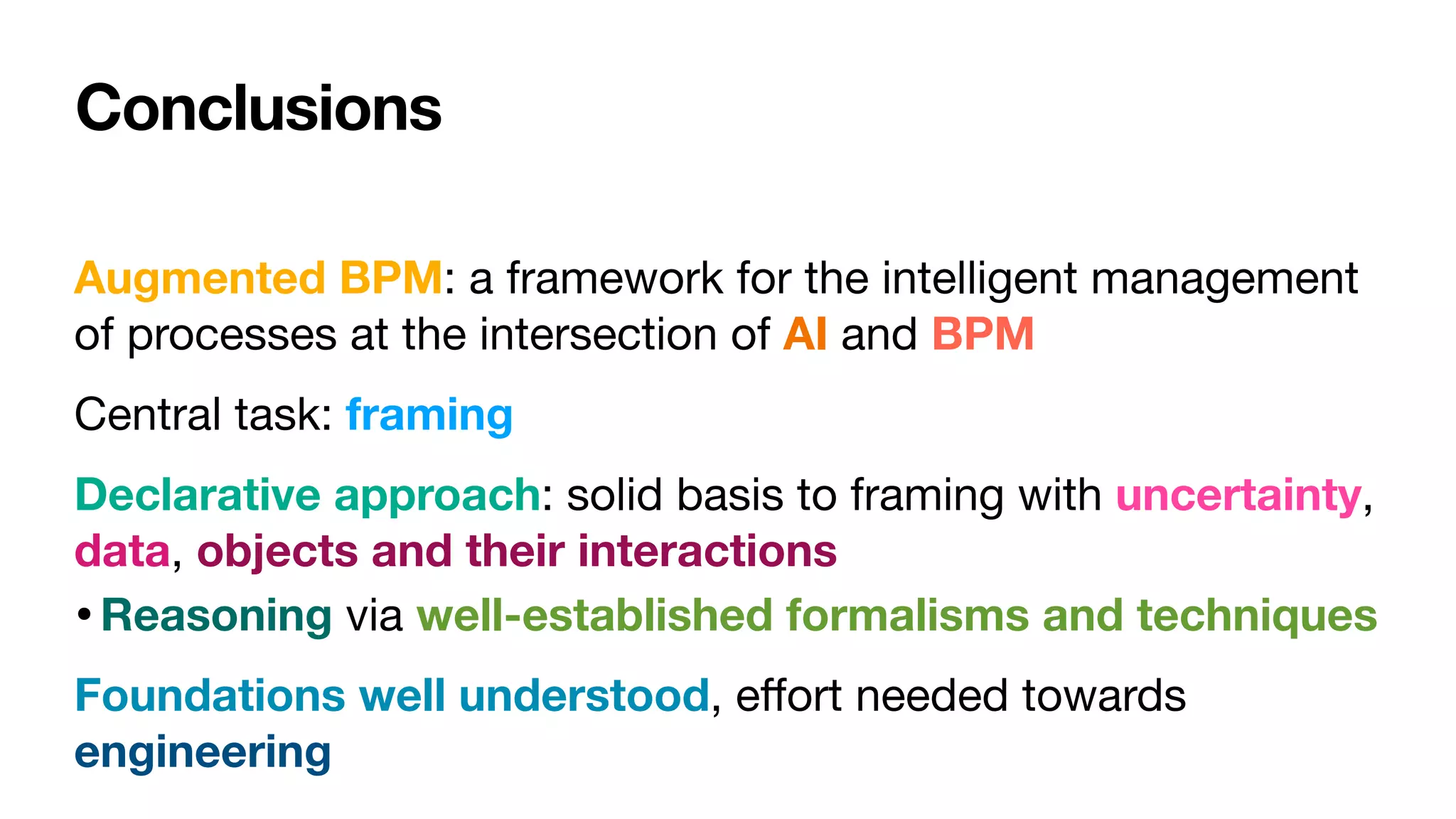The document discusses the concept of Augmented Business Process Management (ABPM), which leverages artificial intelligence (AI) and information systems to create dynamic, adaptable business processes. It emphasizes the importance of constraints and foundational techniques in managing process execution data to enhance decision-making and process performance. Key features of ABPM systems include autonomous operation, constant interaction with human stakeholders, and the ability to adapt through predictive capabilities.

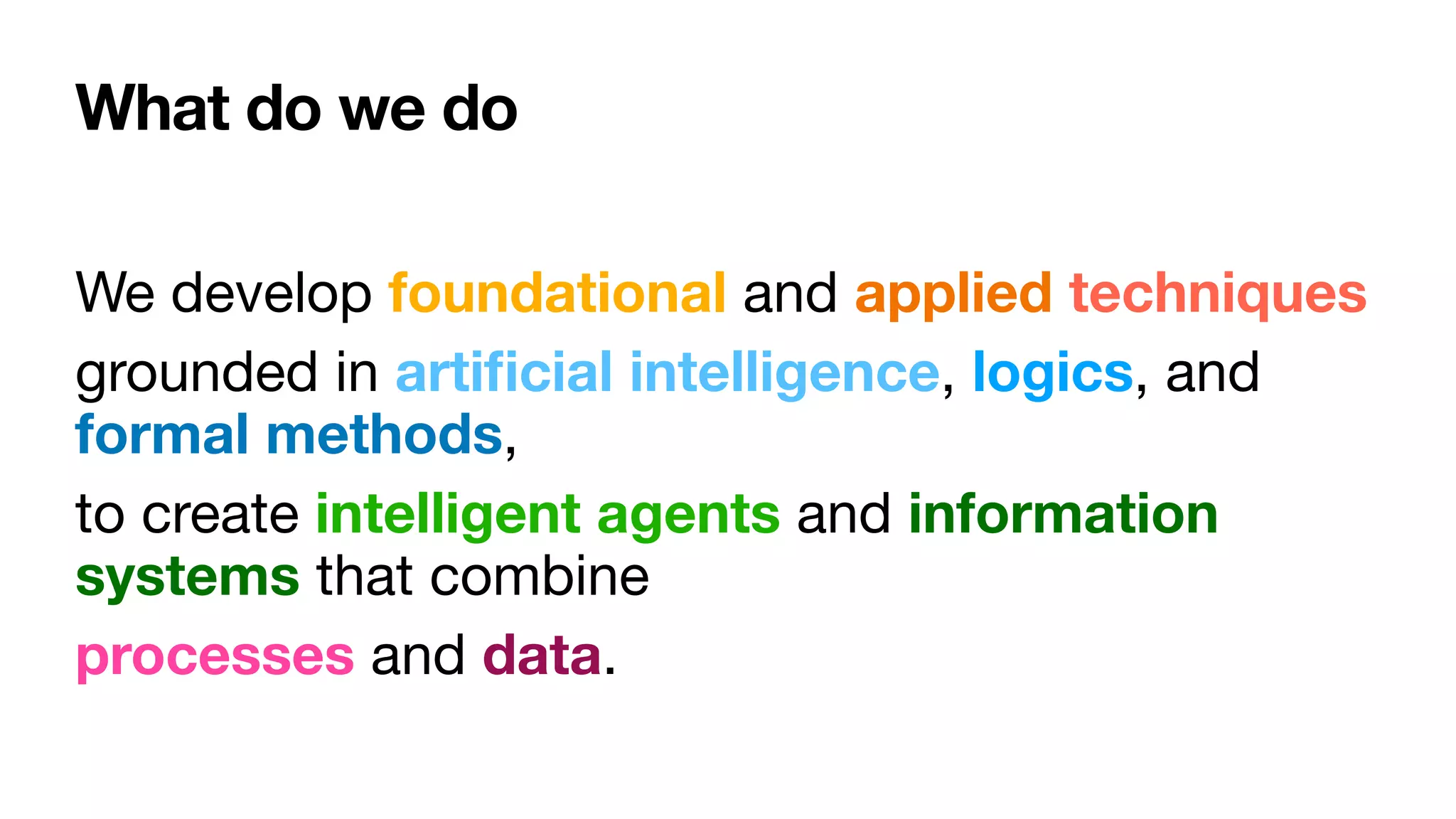
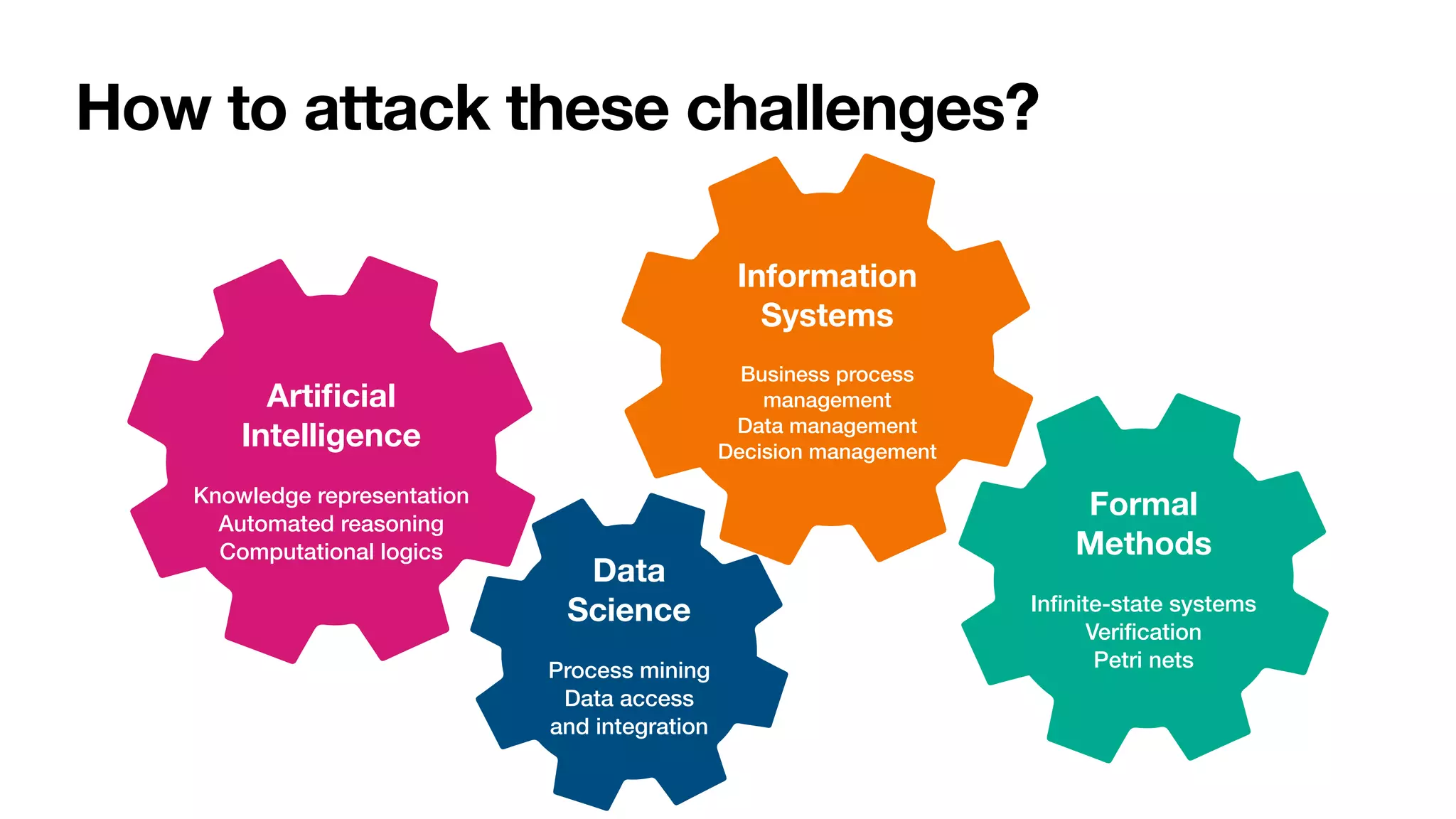

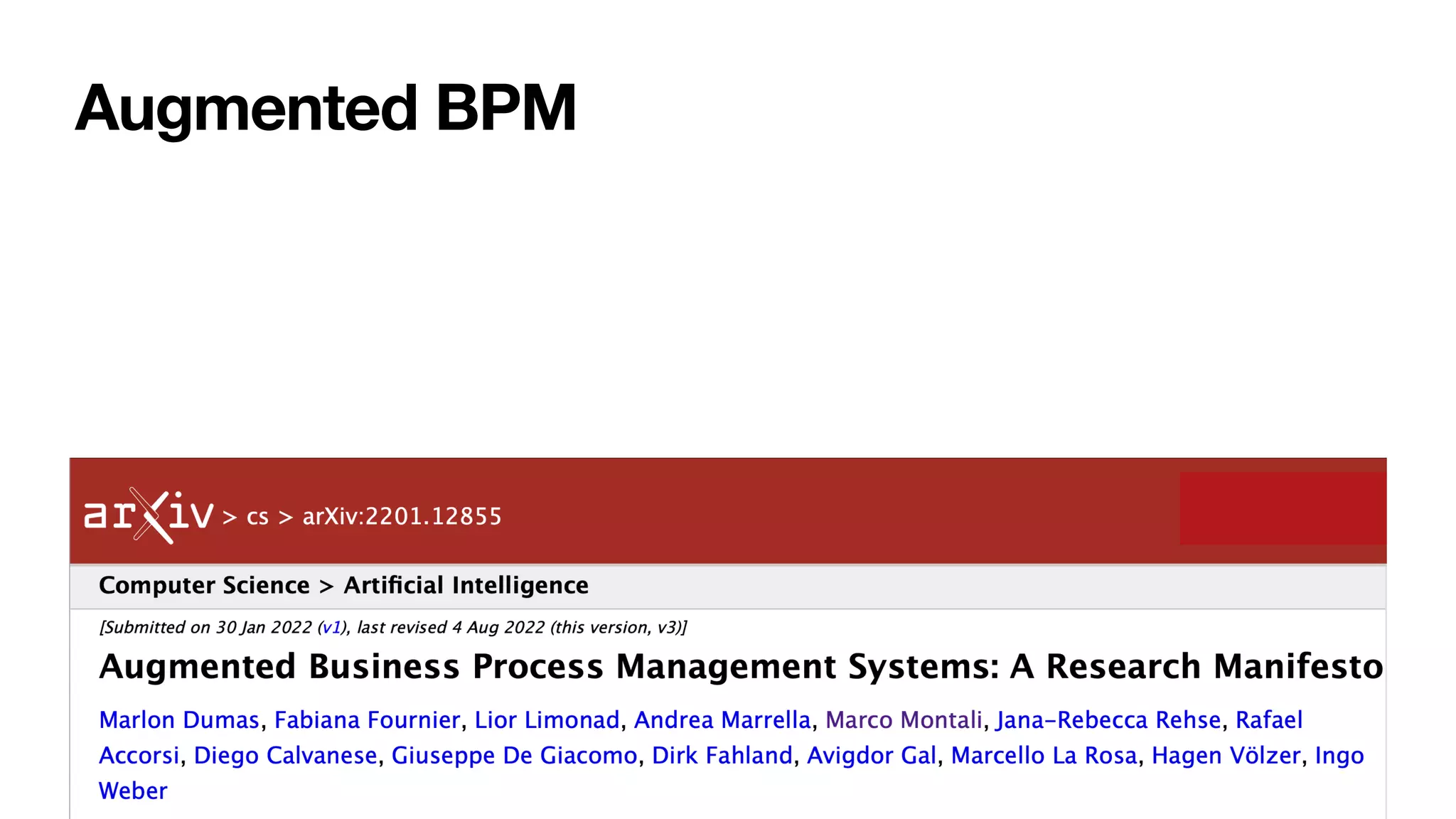
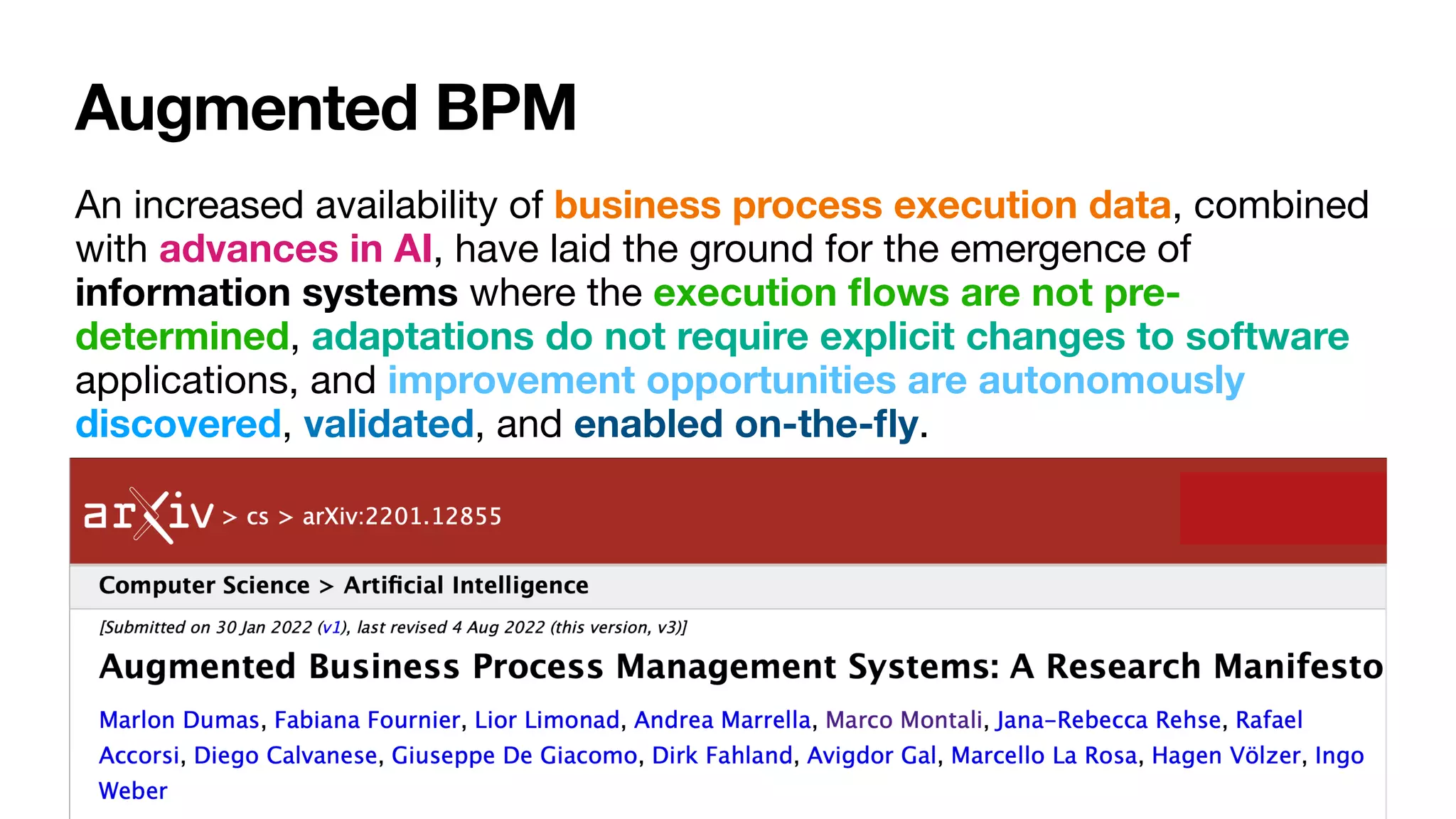

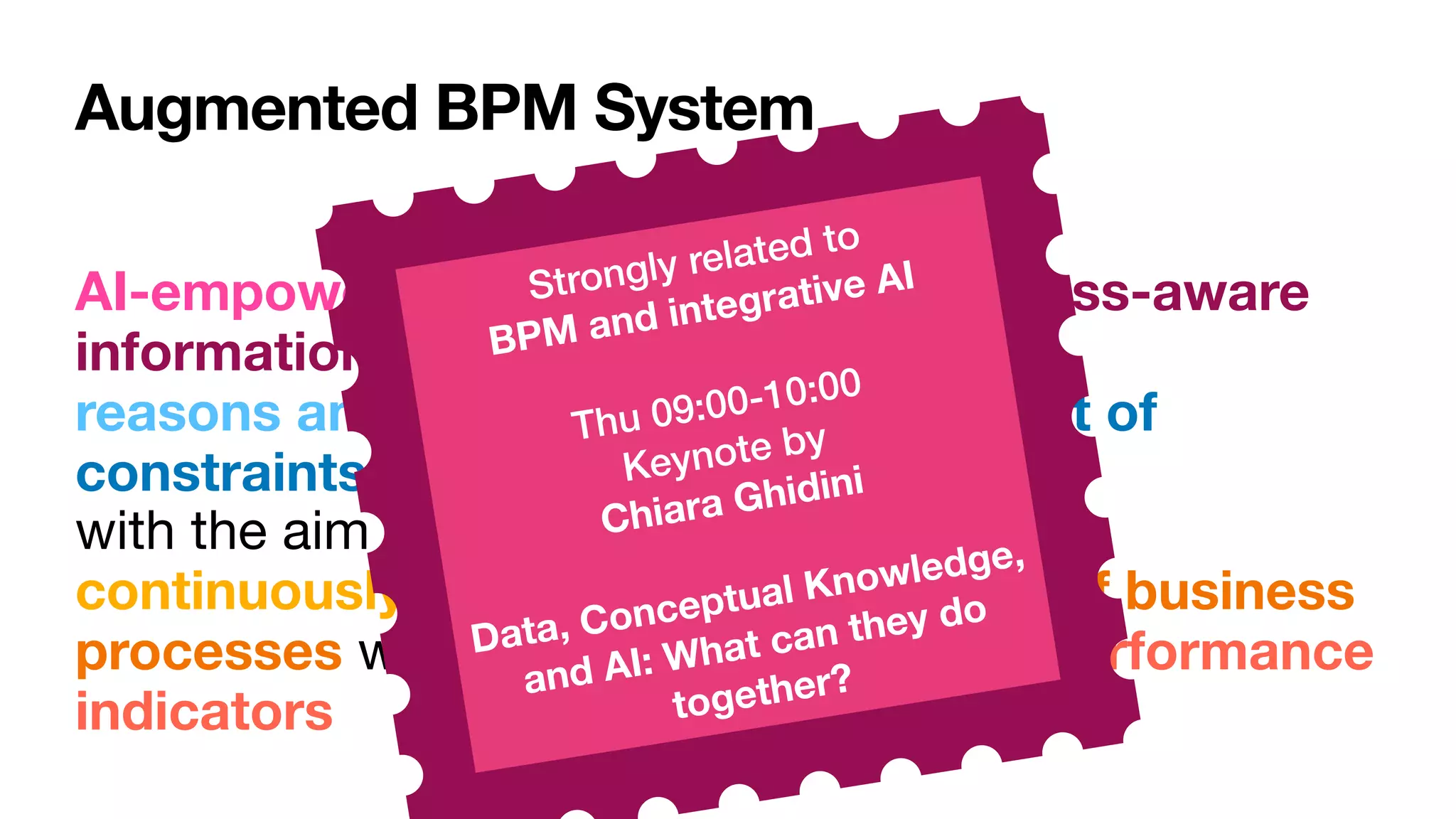
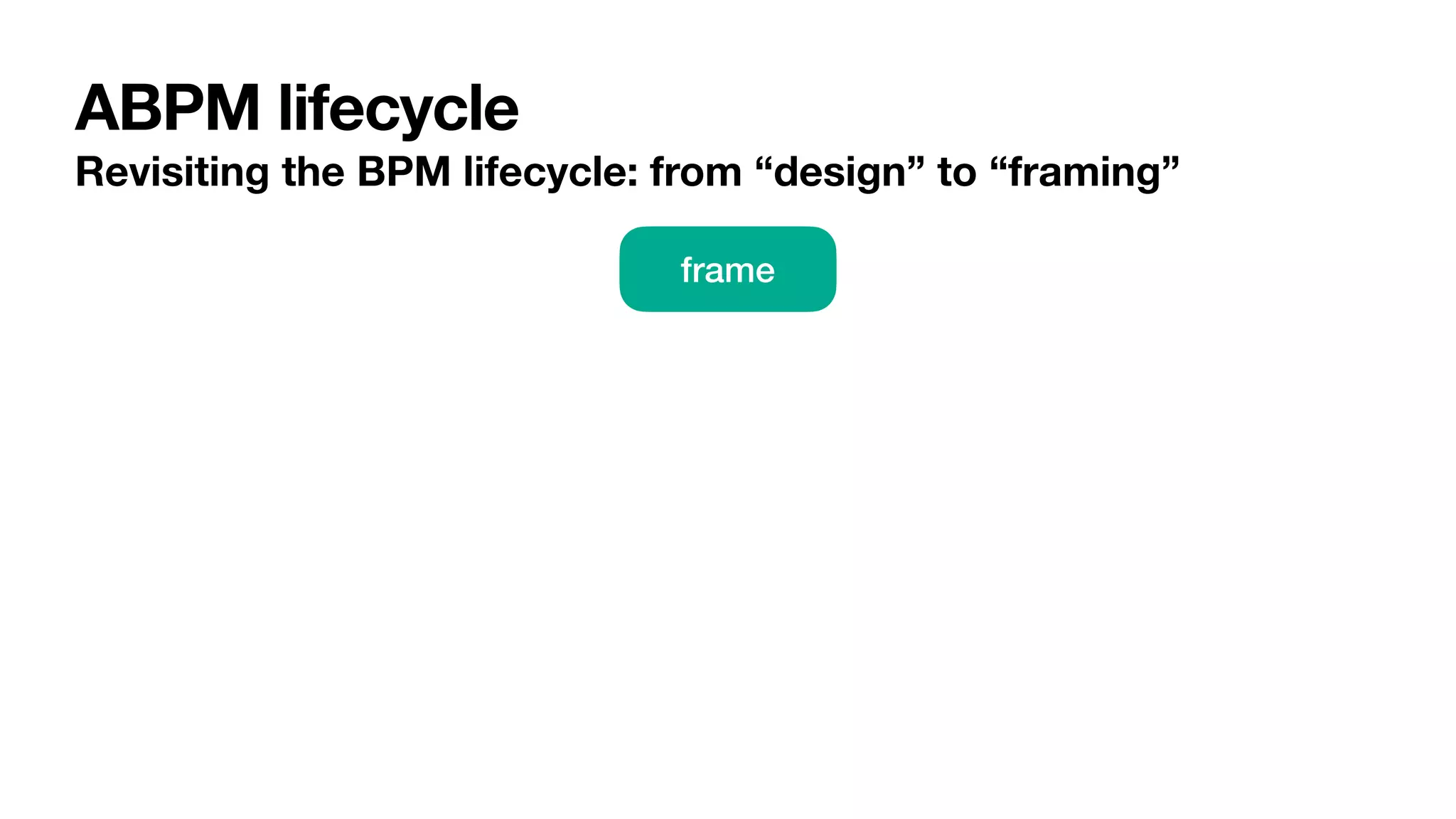
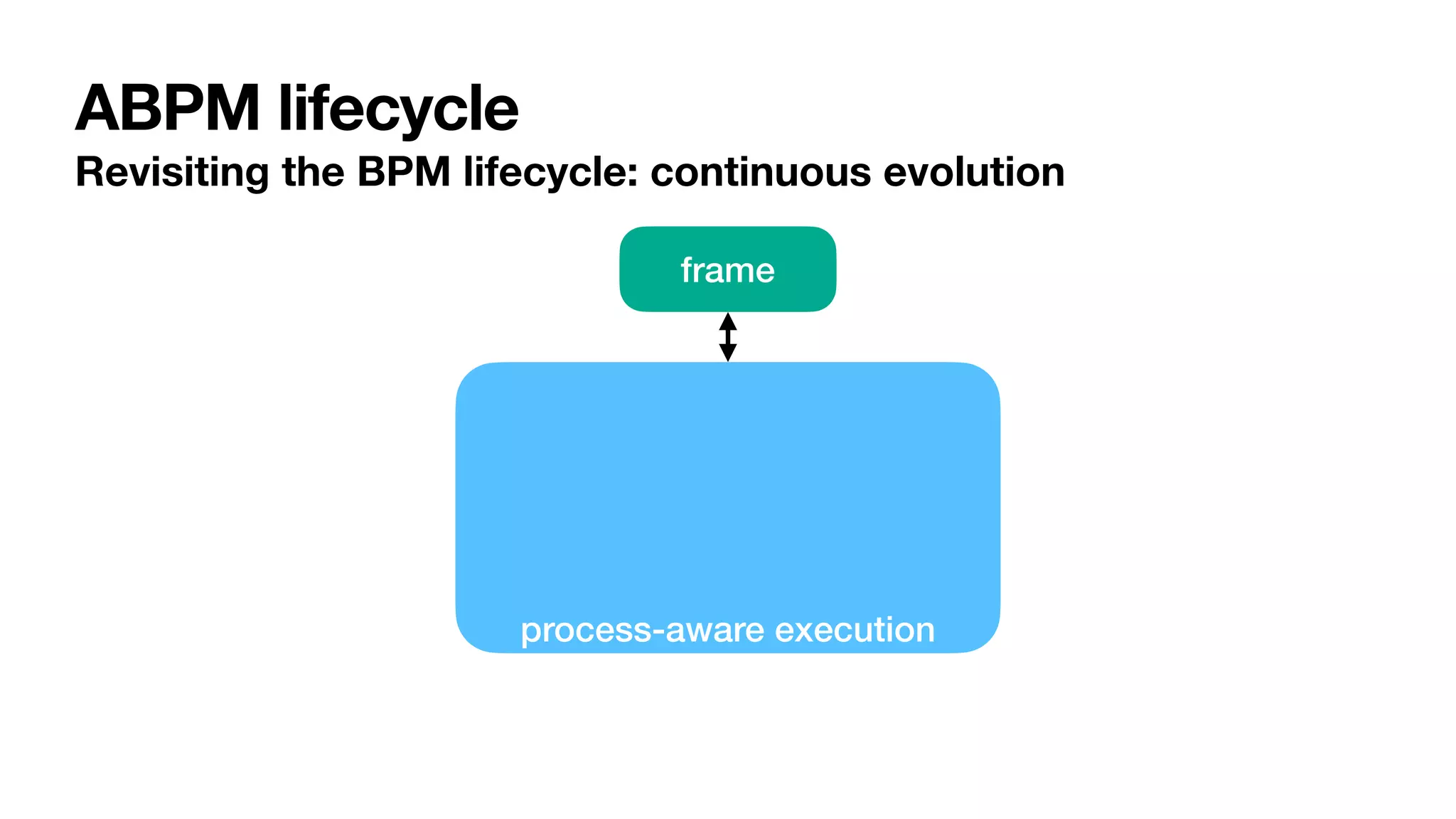
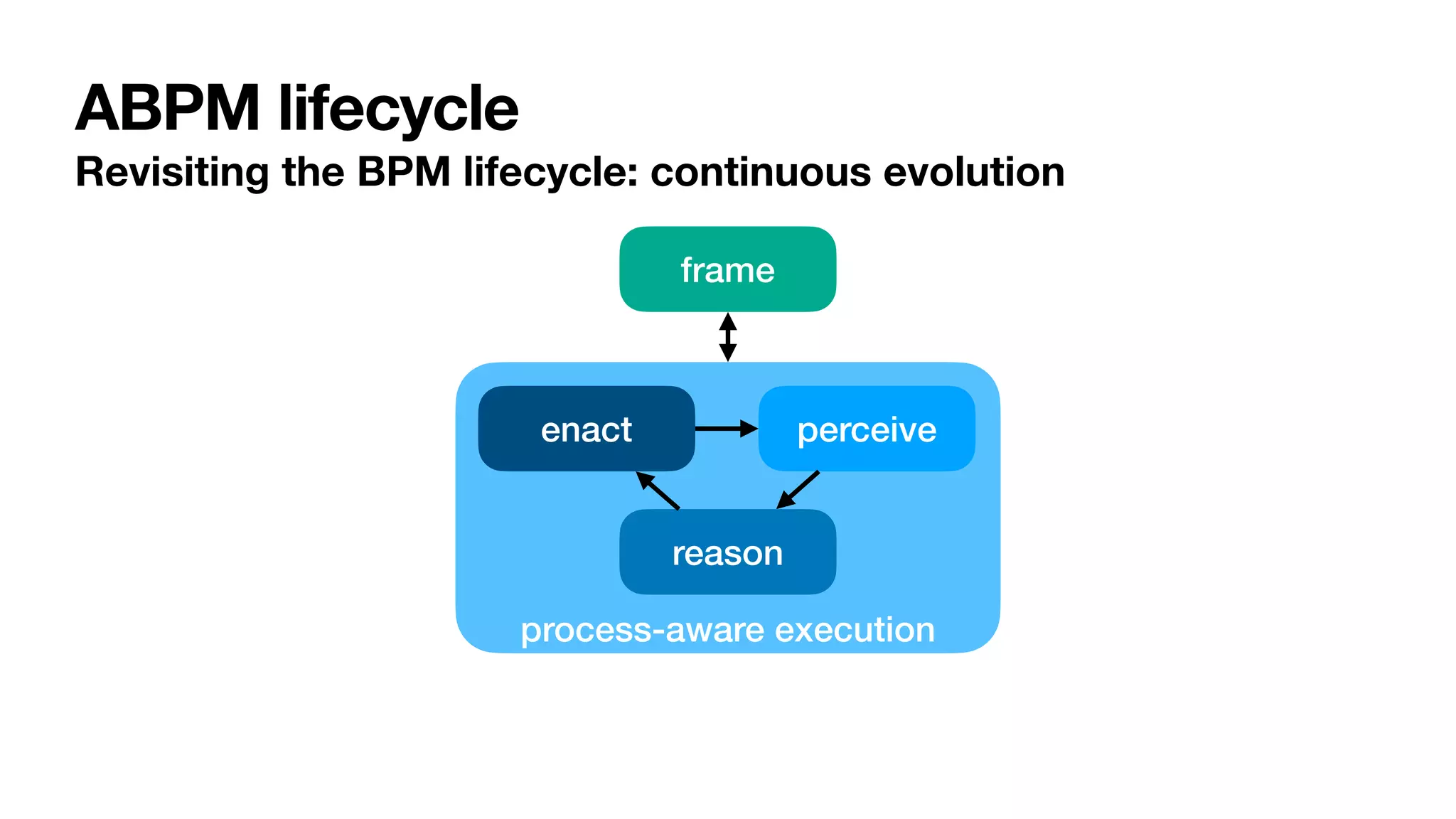
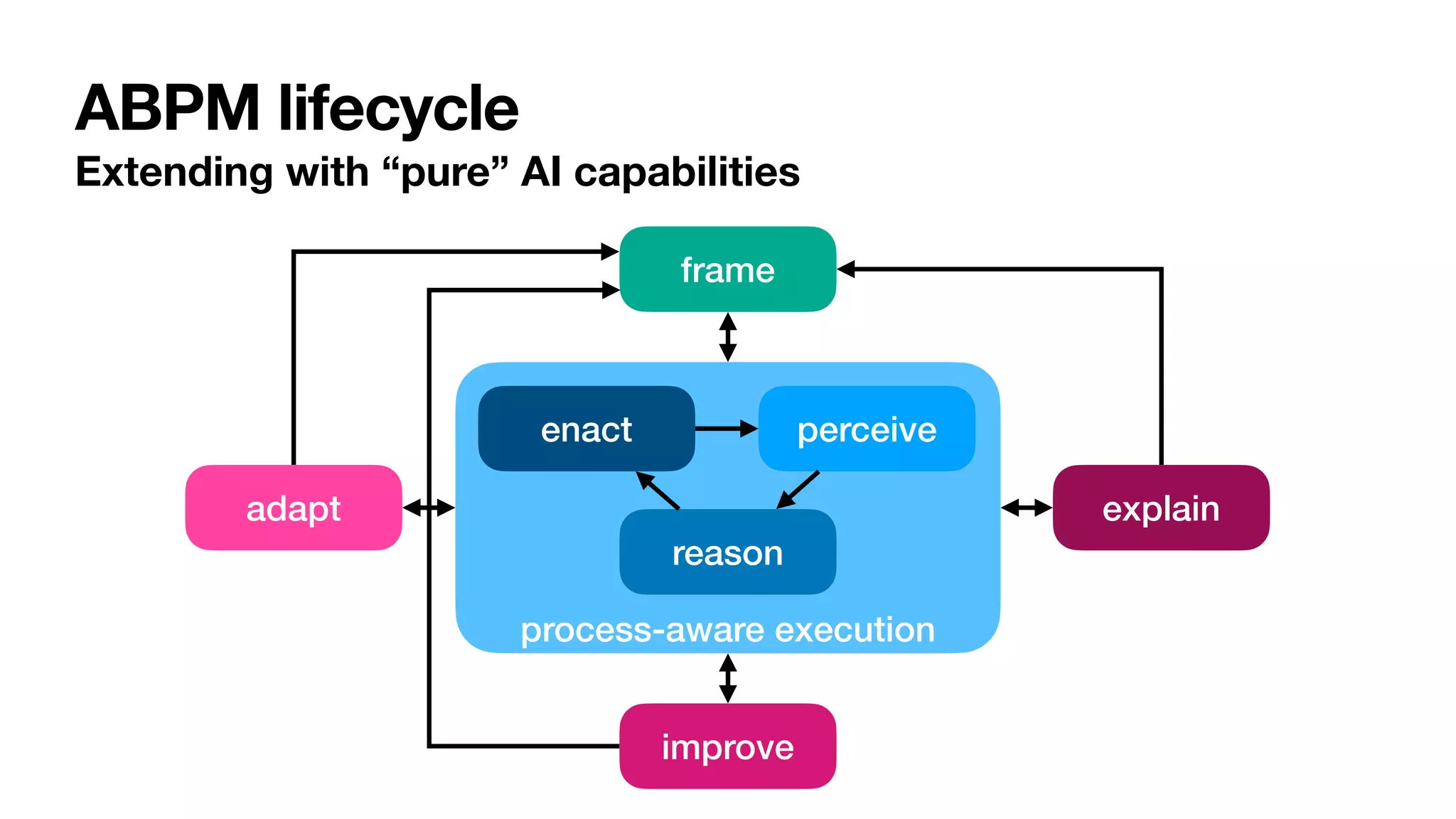
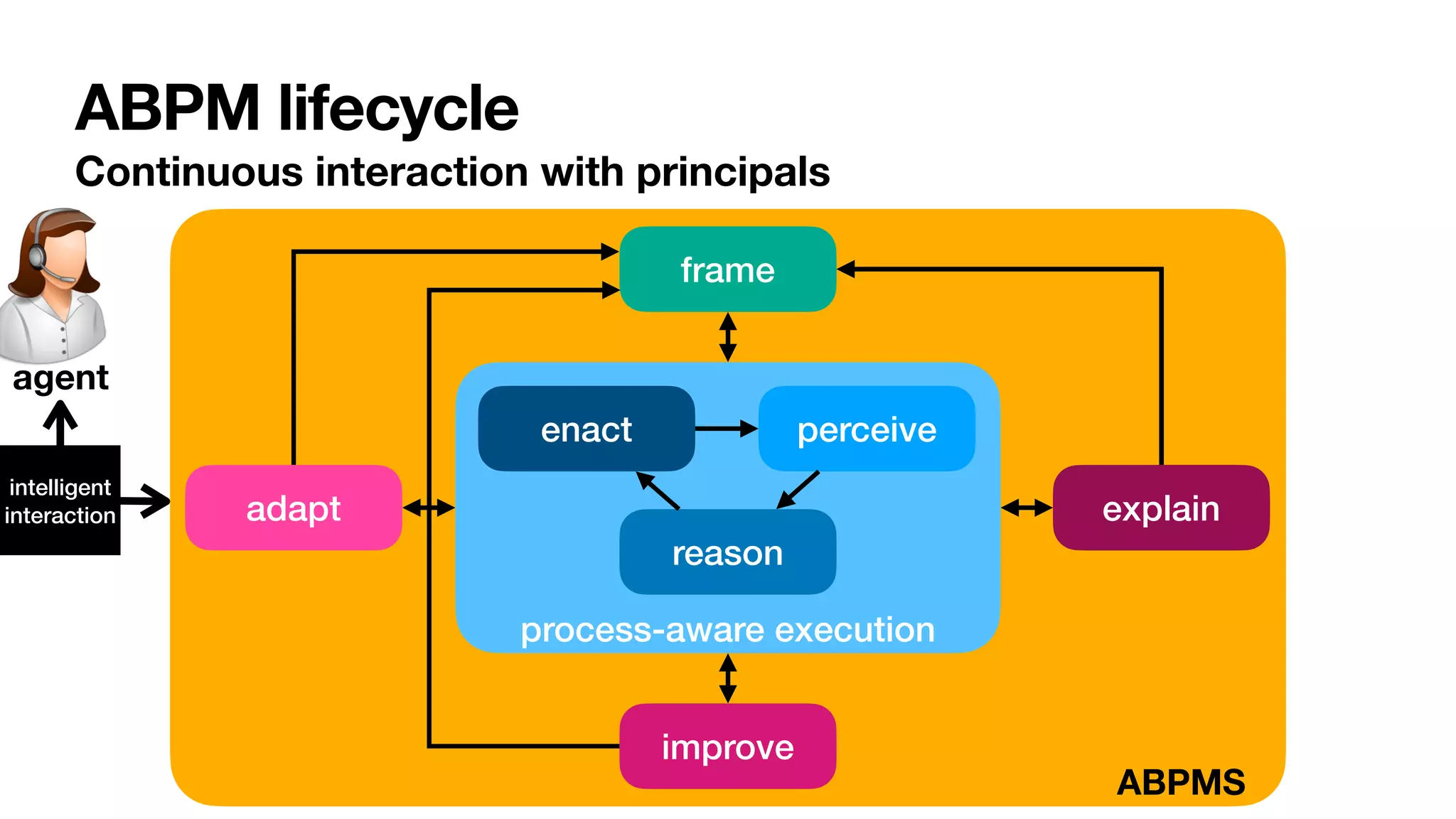
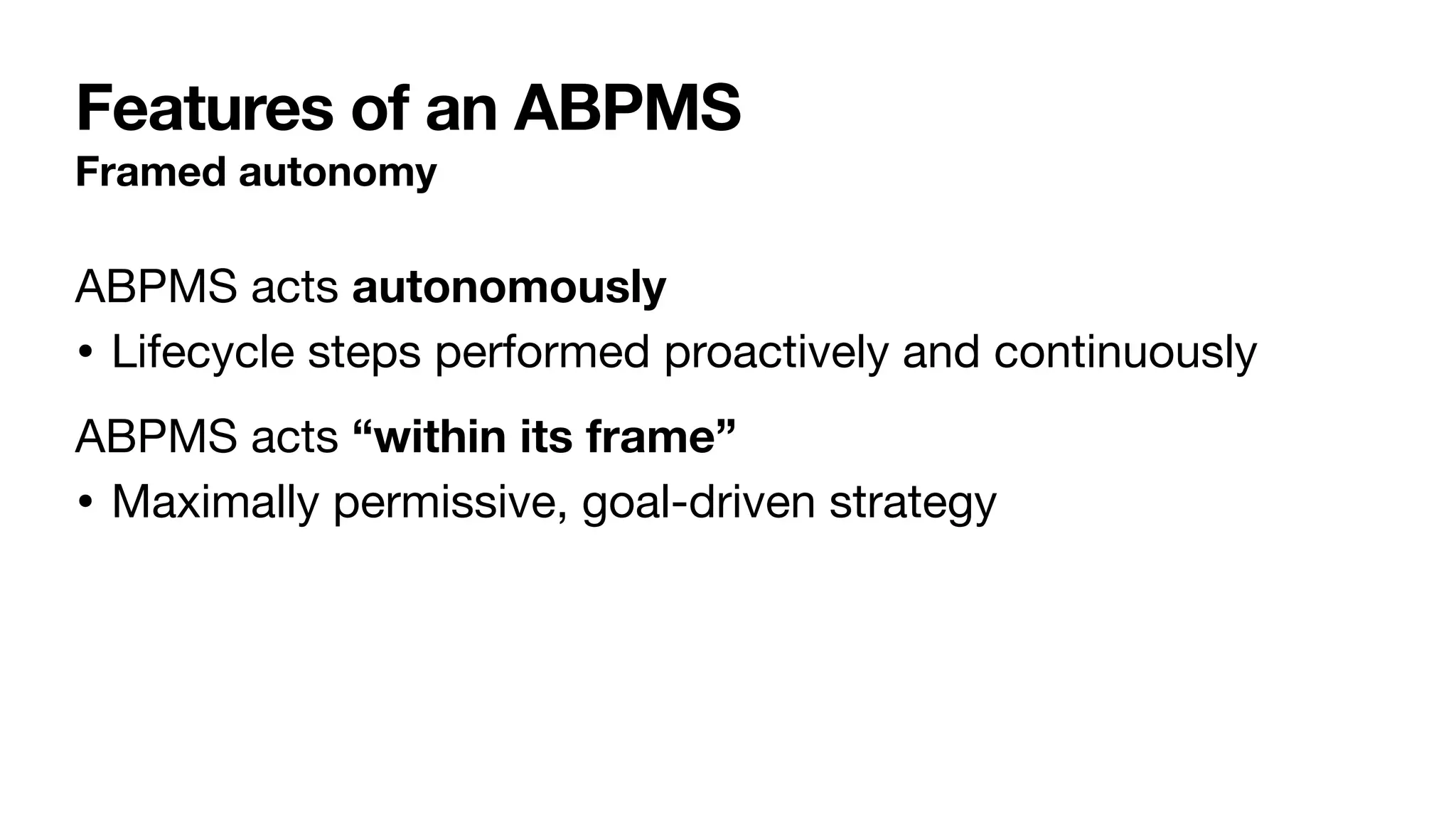
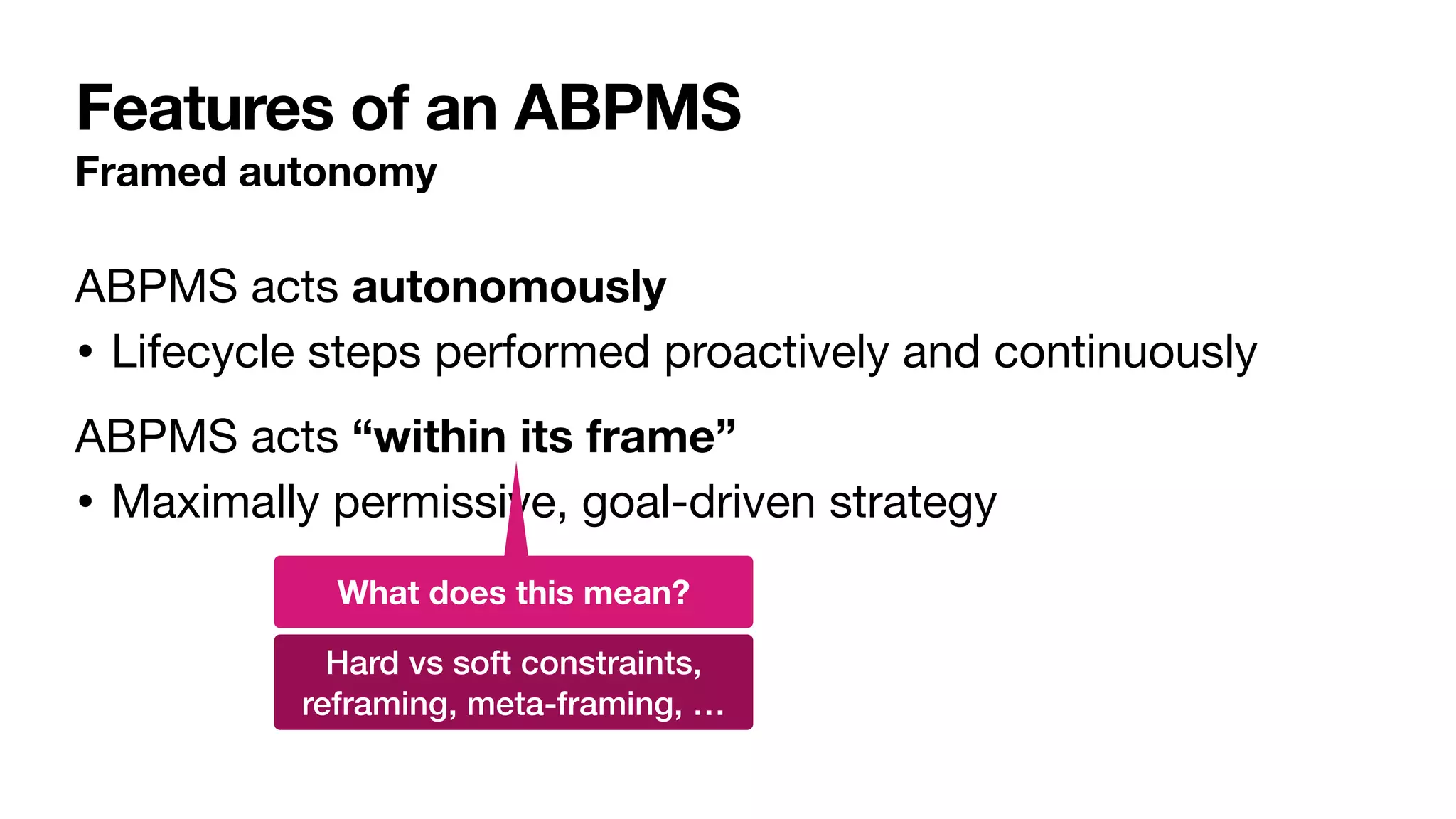
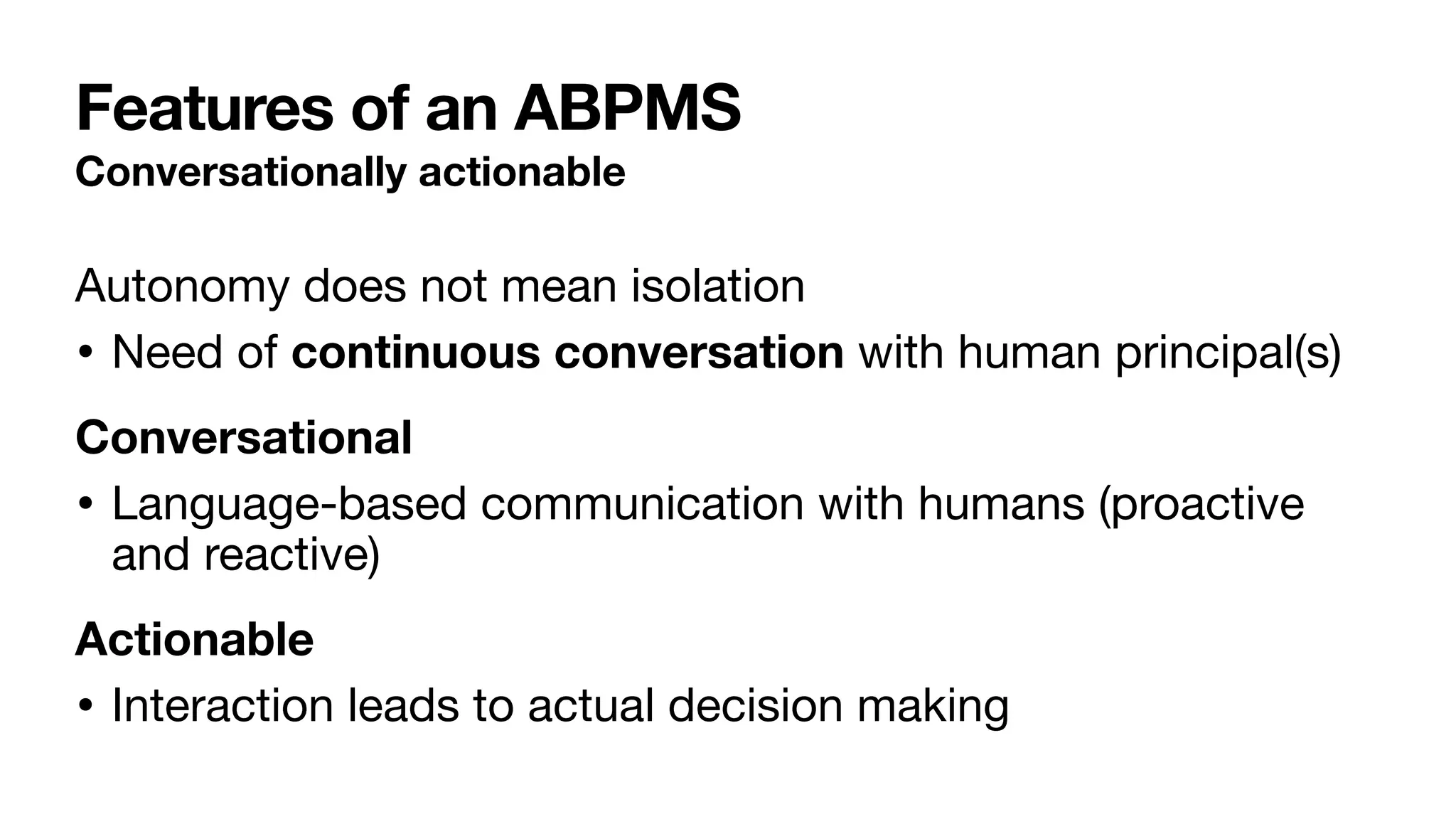

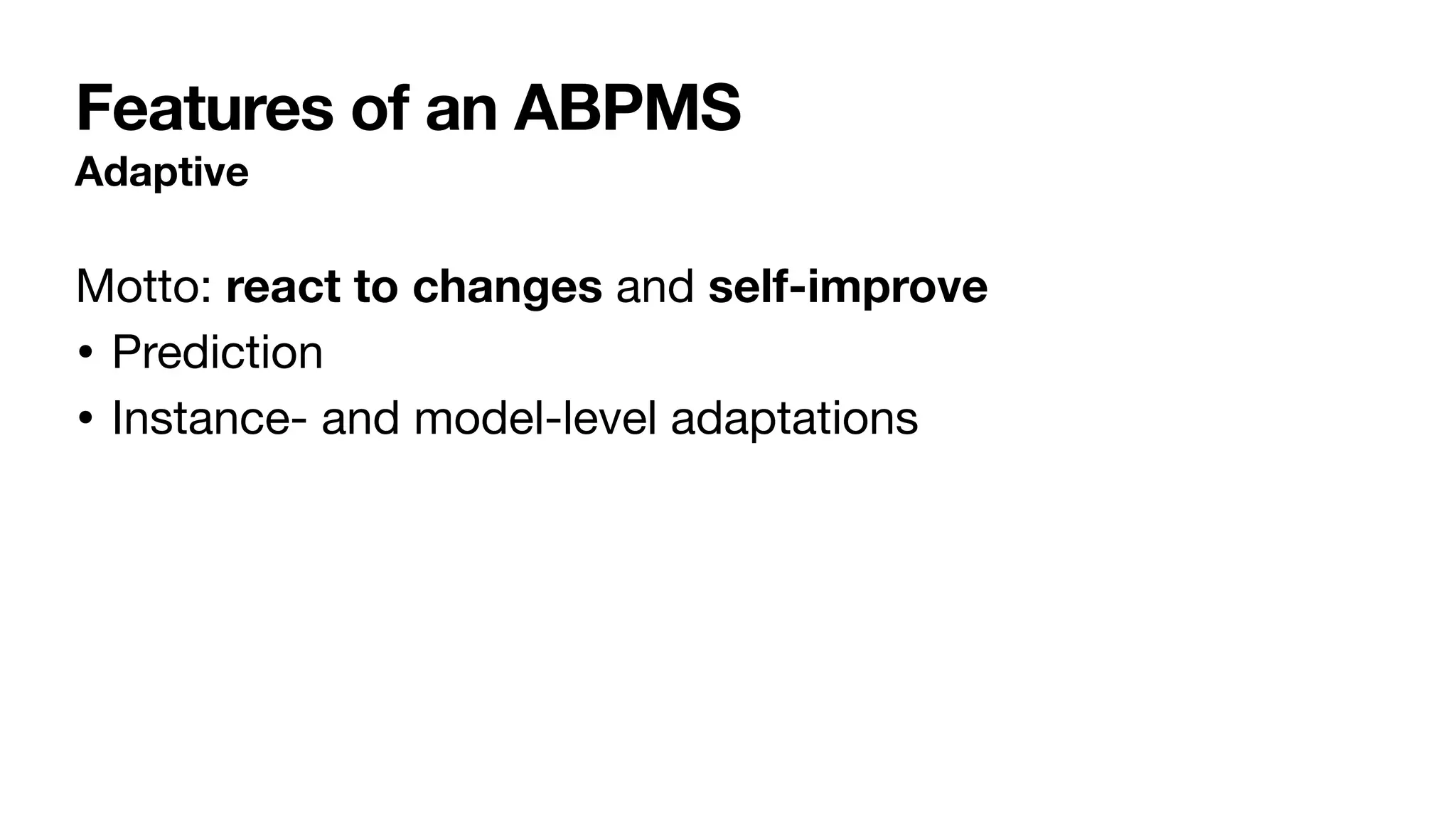
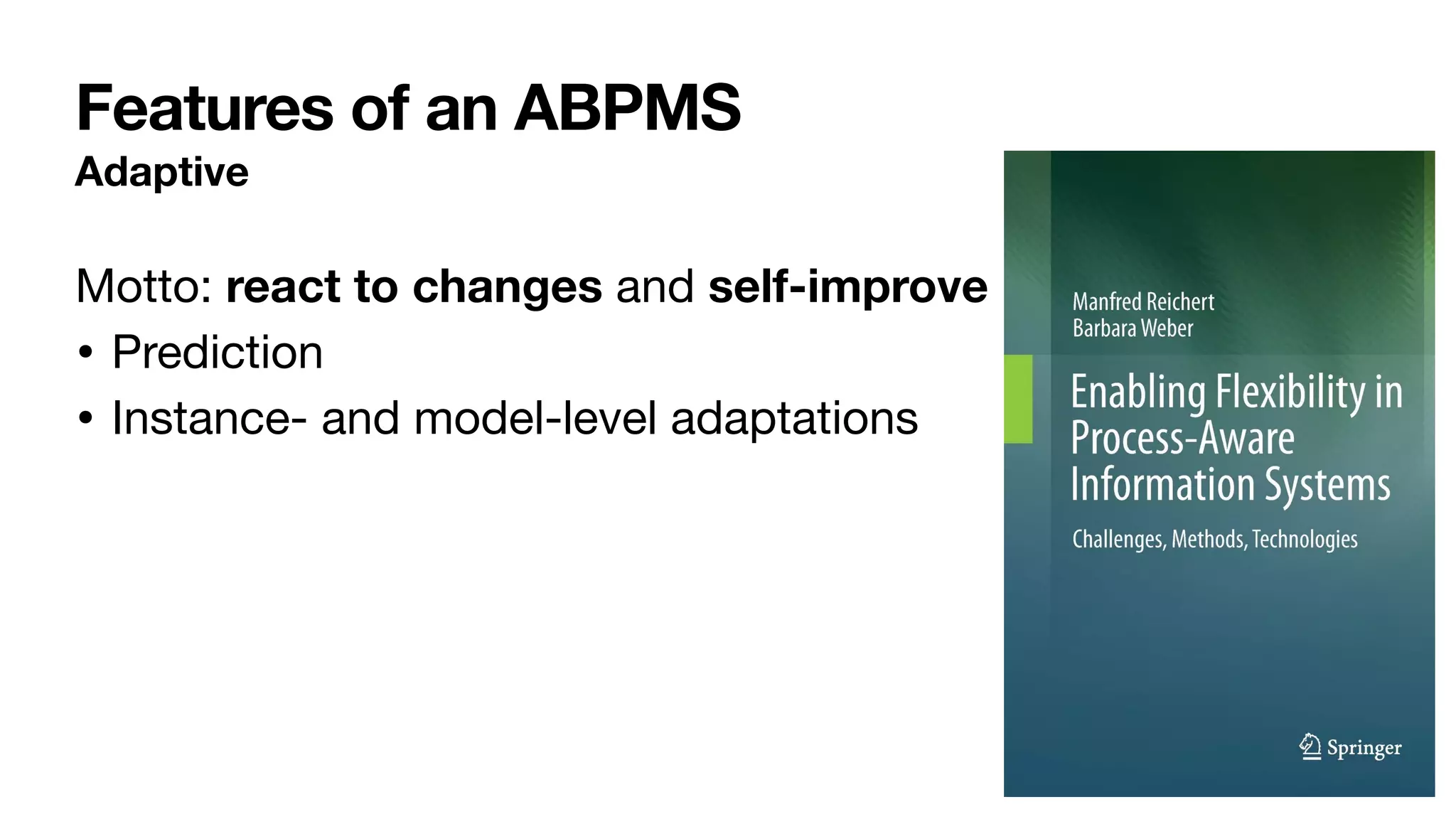
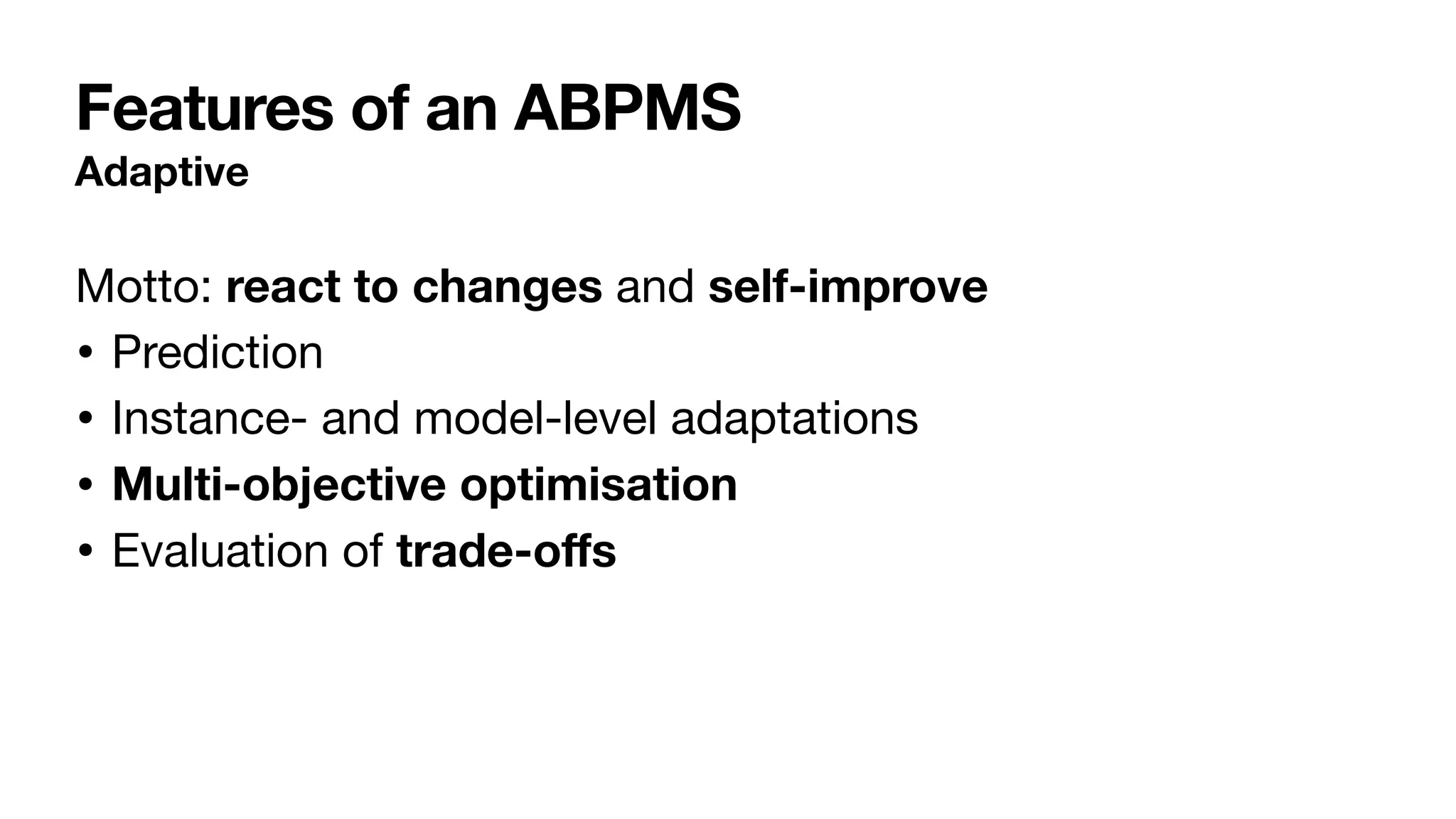
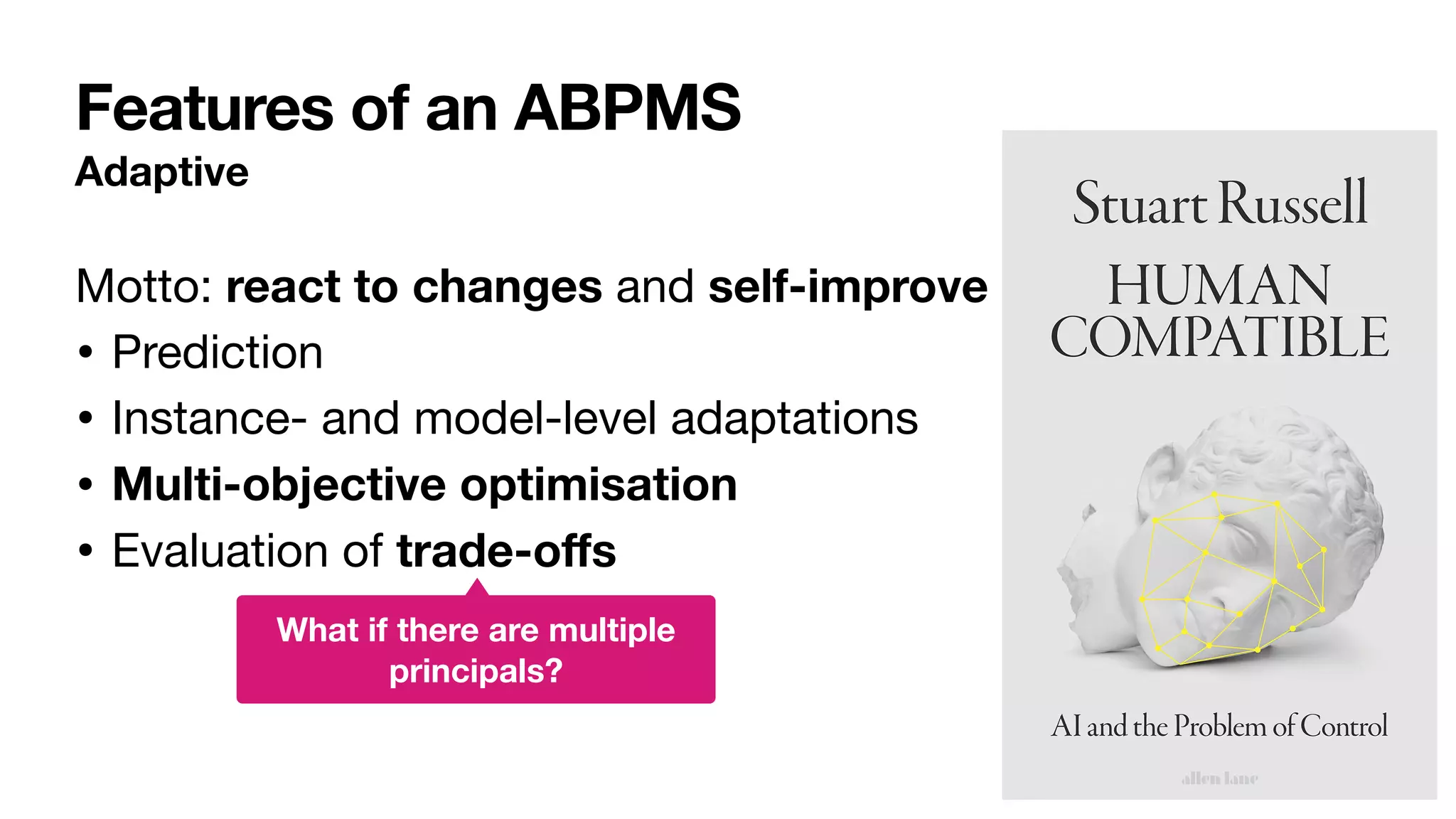
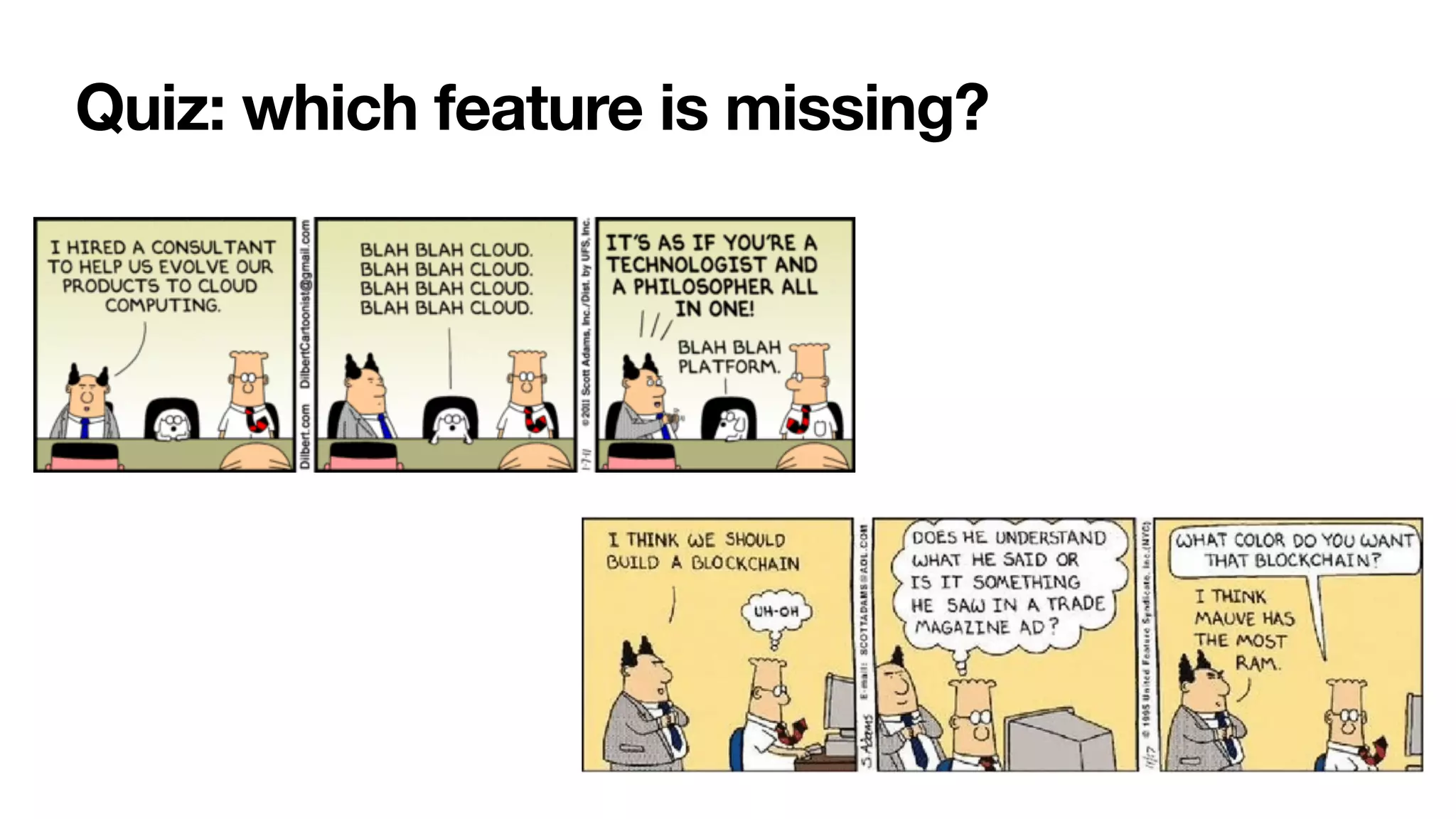
![Features of an ABPMS
Explainable
An ABPMS should be trustworthy
• “trust is the willingness of a party to be vulnerable to the actions of another
party based on the expectation that the other will perform a particular action
important to the trustor, irrespective of the ability to monitor or control that
other party” [MayerEtAl,TAMR95]
How to be trustworthy?
• Fair
• Explainable
• Auditable
• Safe
Need of speci
fi
c focus on
“process-aware” systems](https://image.slidesharecdn.com/ai4bpm-framing-montali-220914143006-e7edf68e/75/Constraints-for-Process-Framing-in-Augmented-BPM-23-2048.jpg)


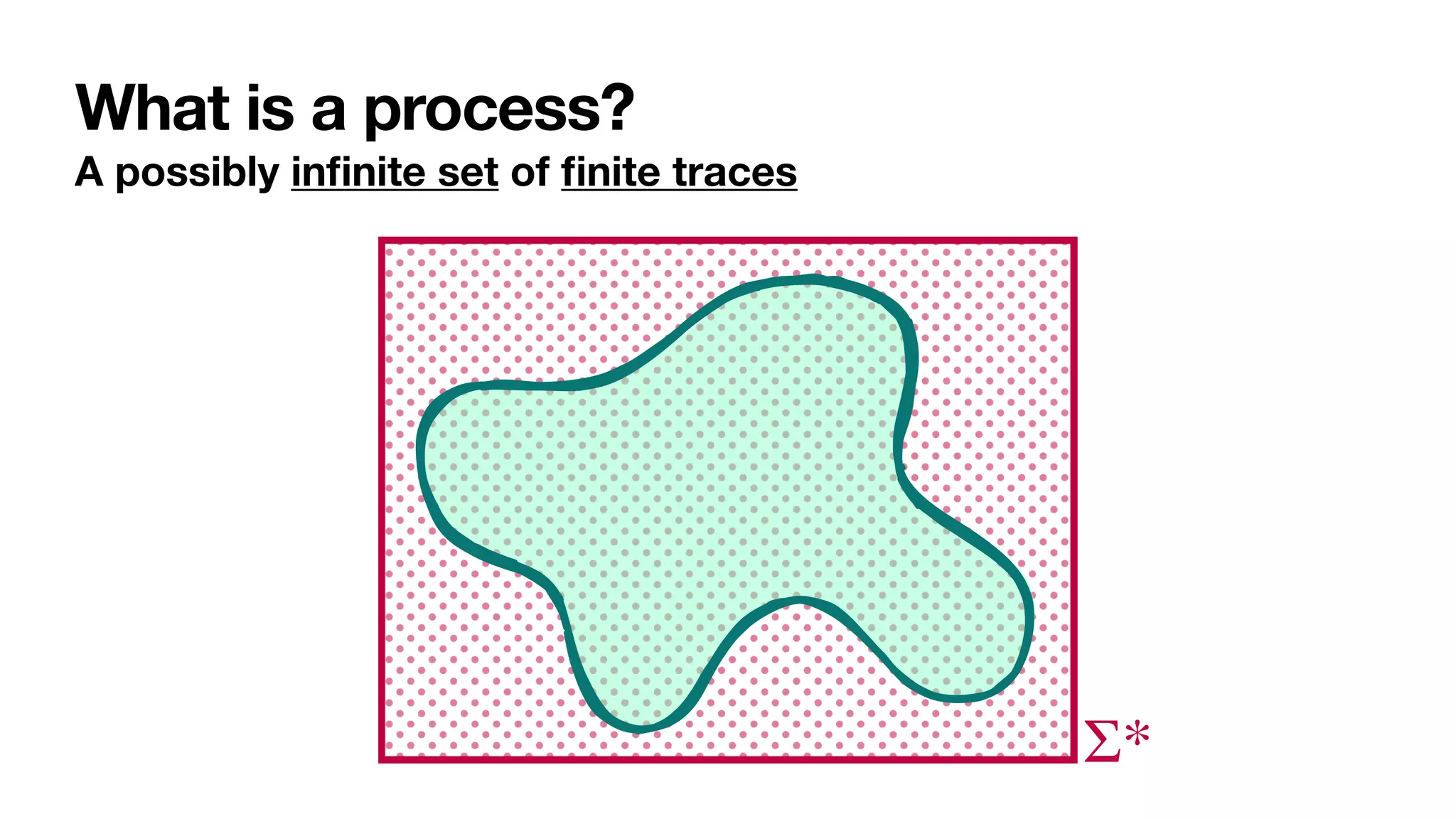
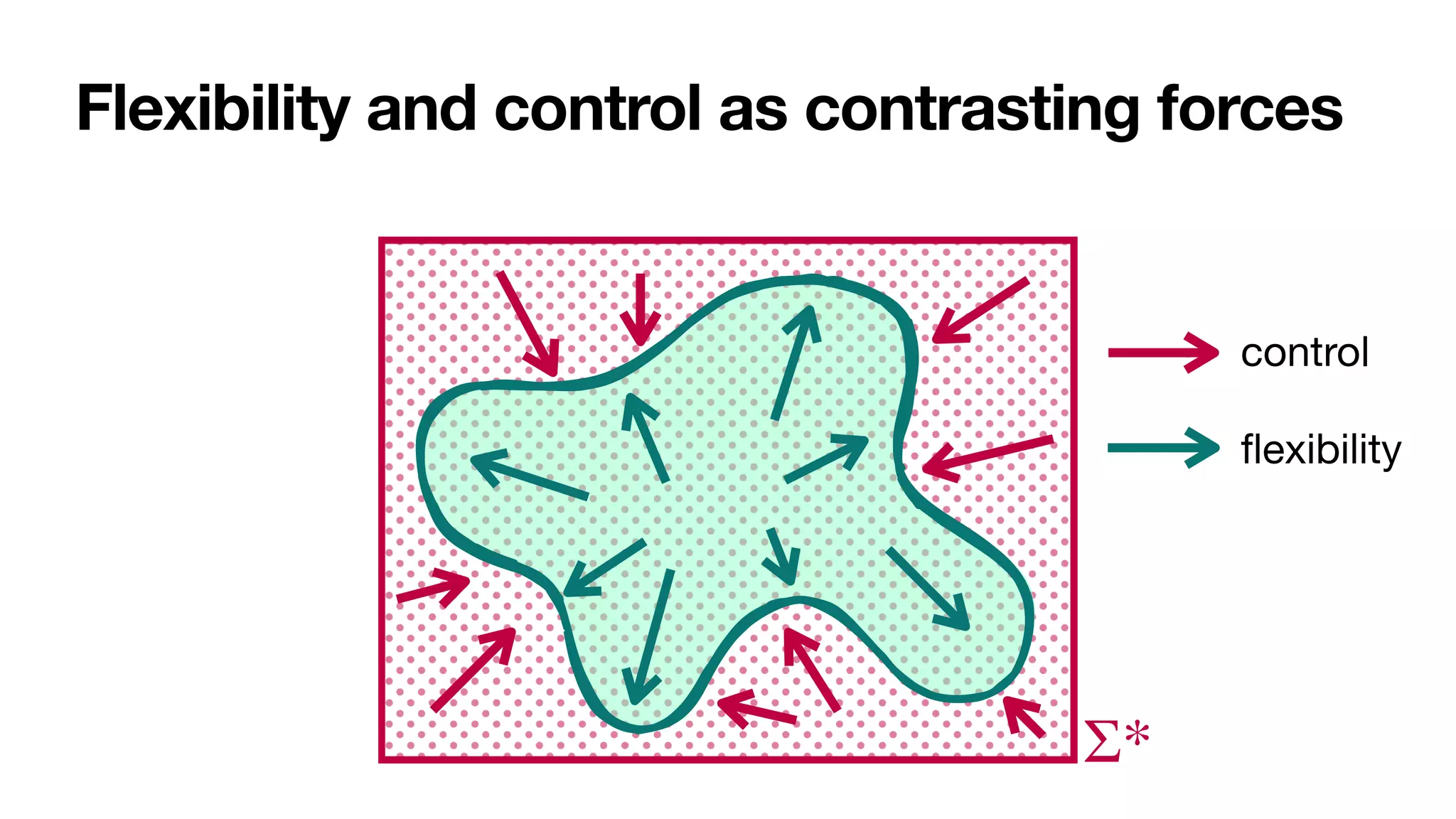
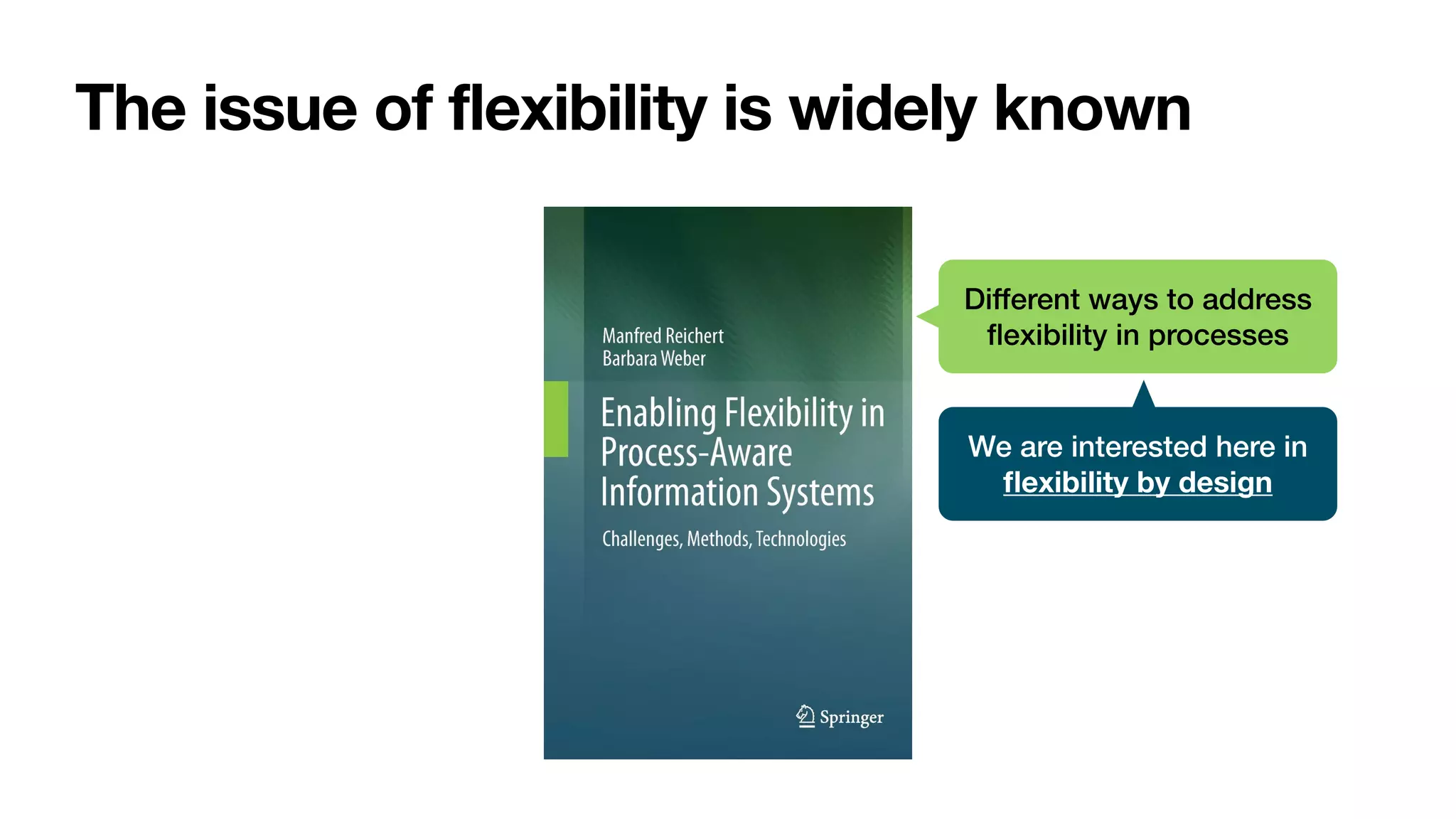

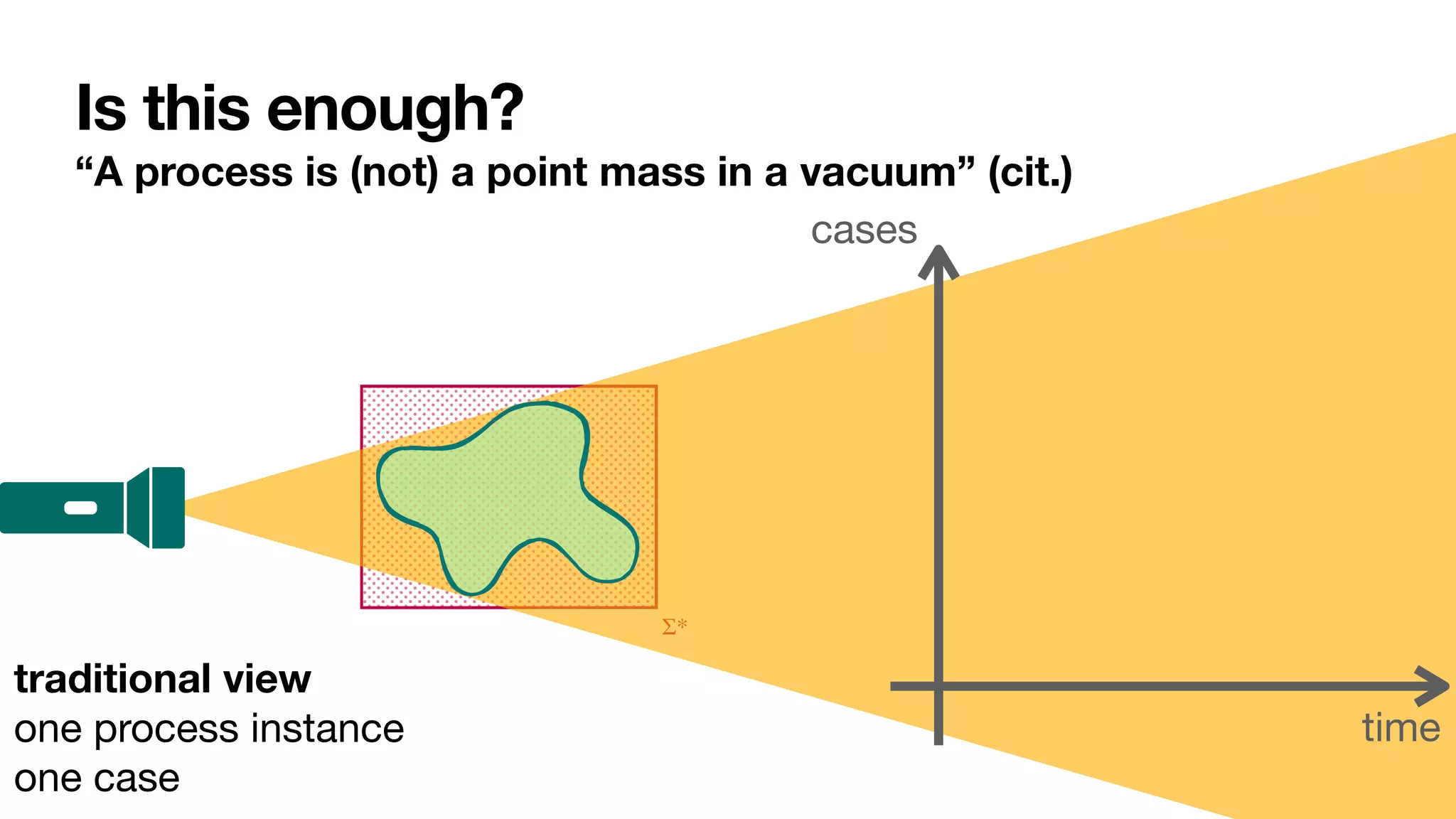

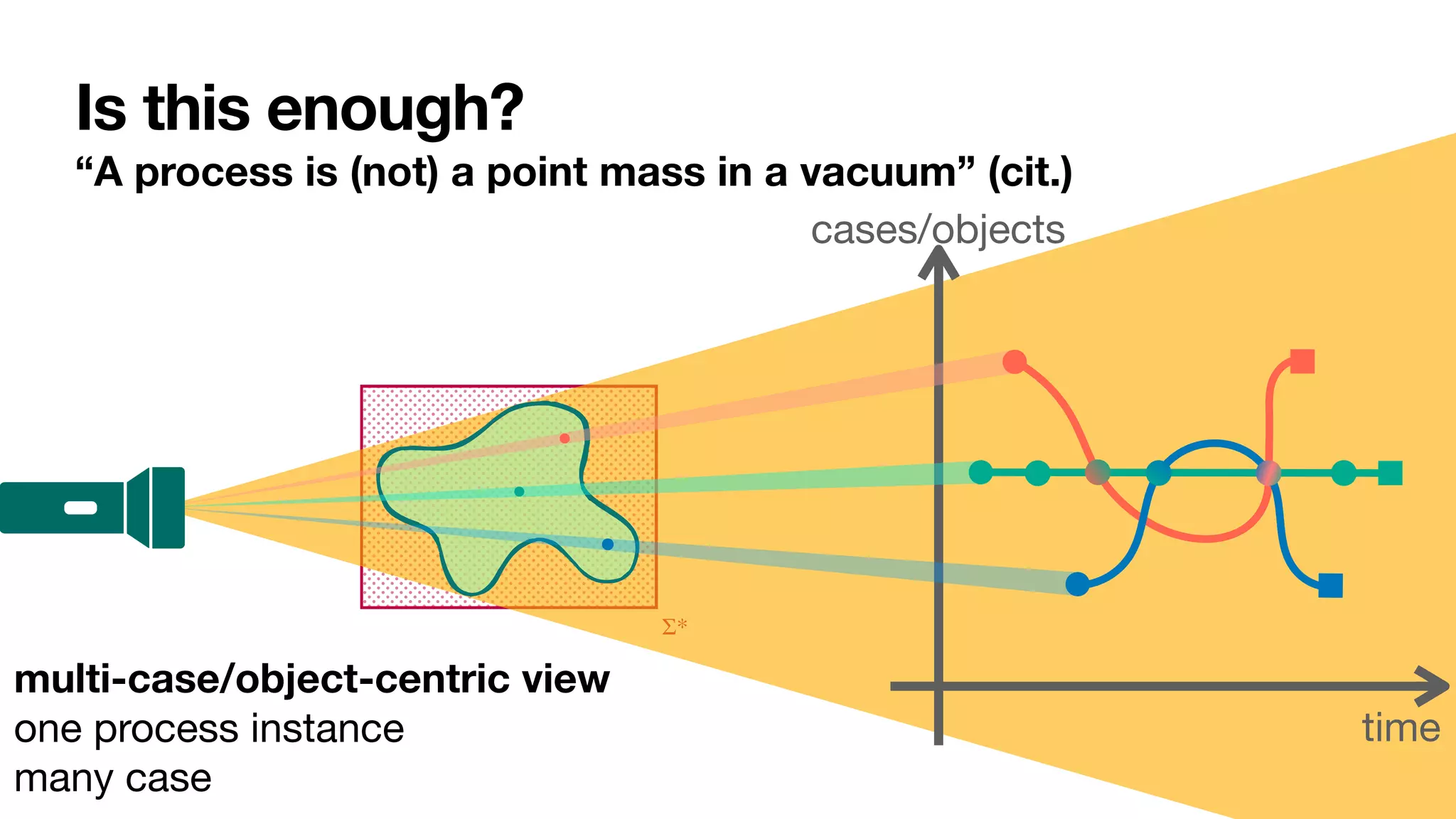
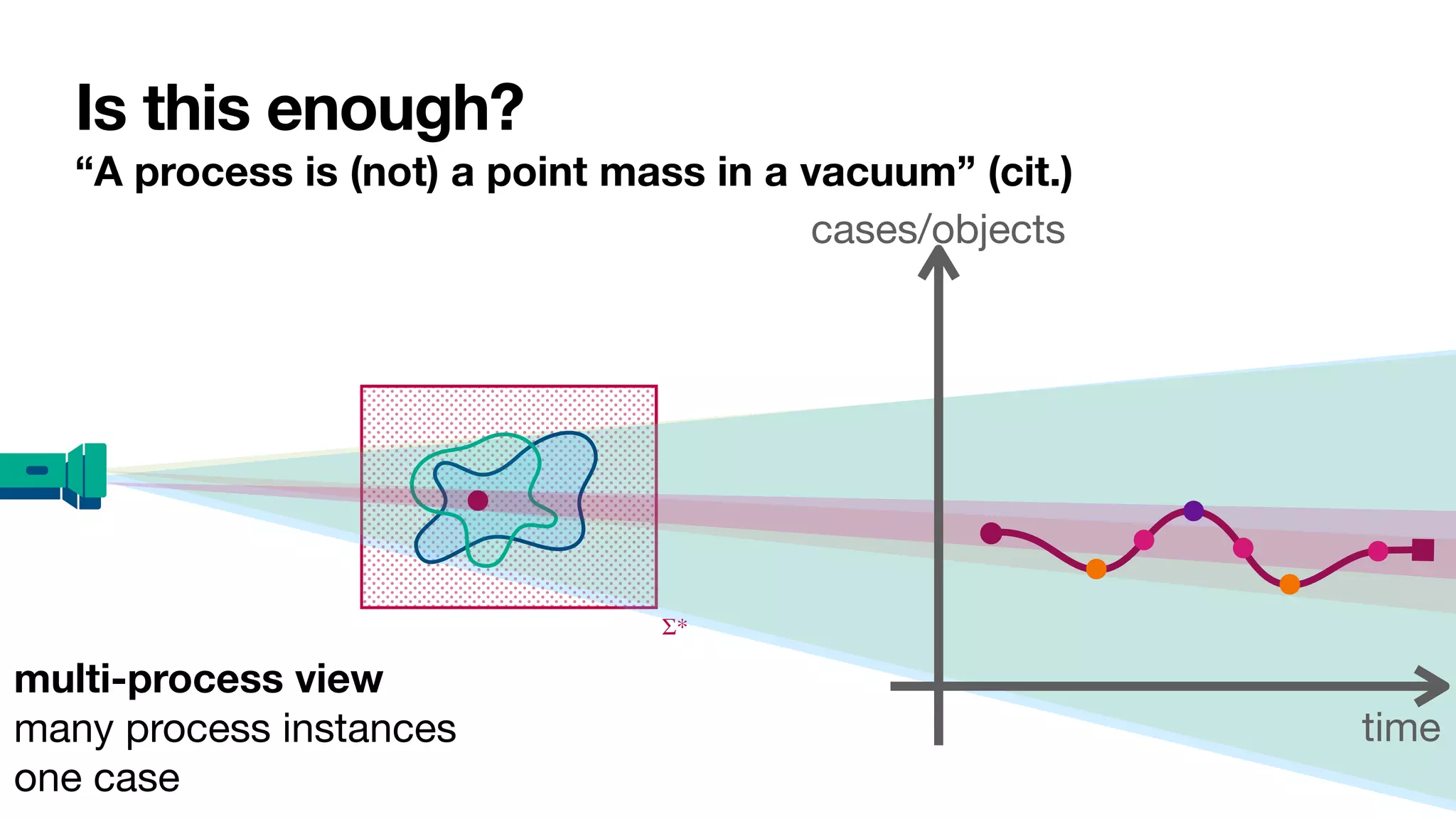
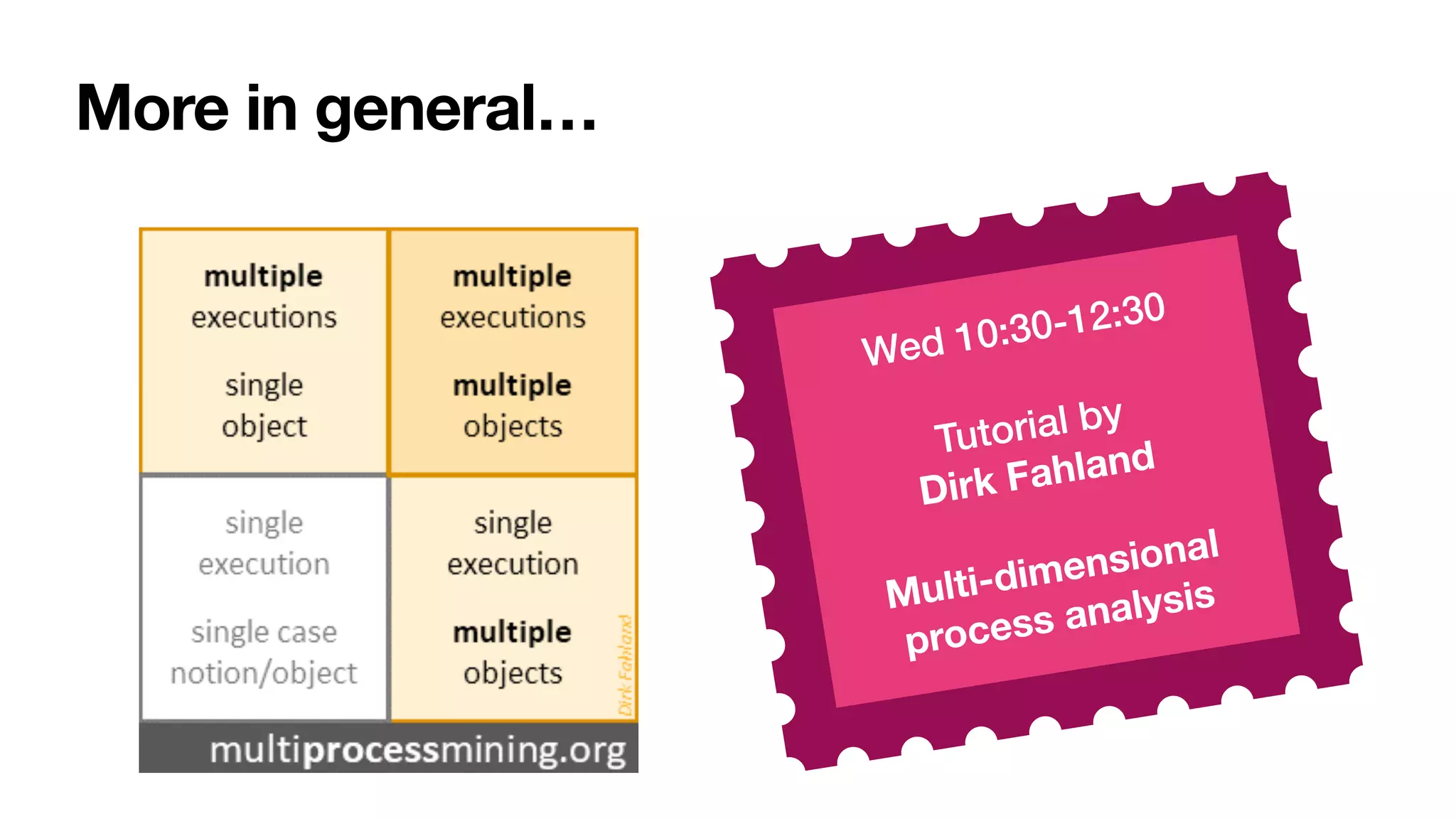


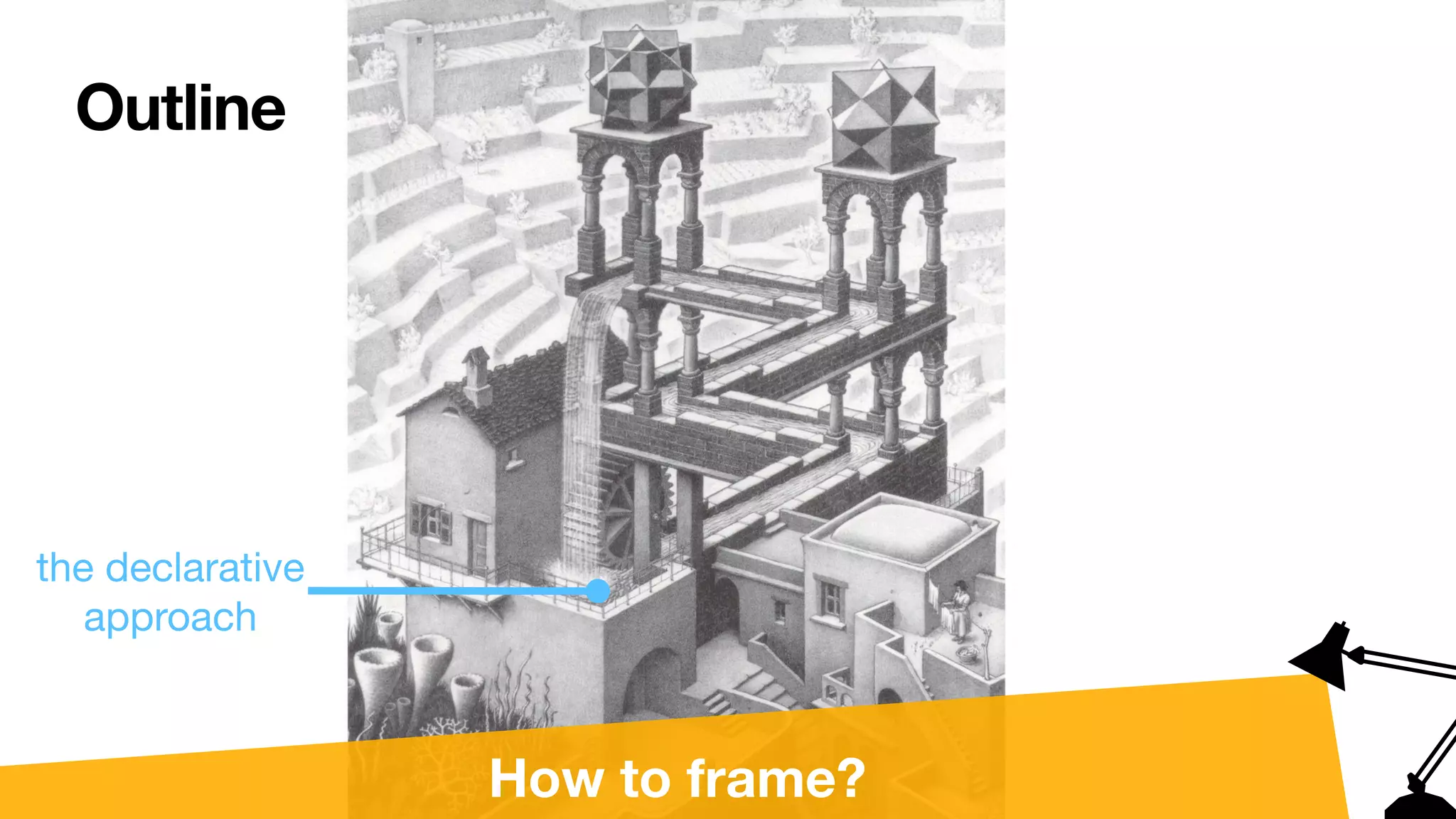
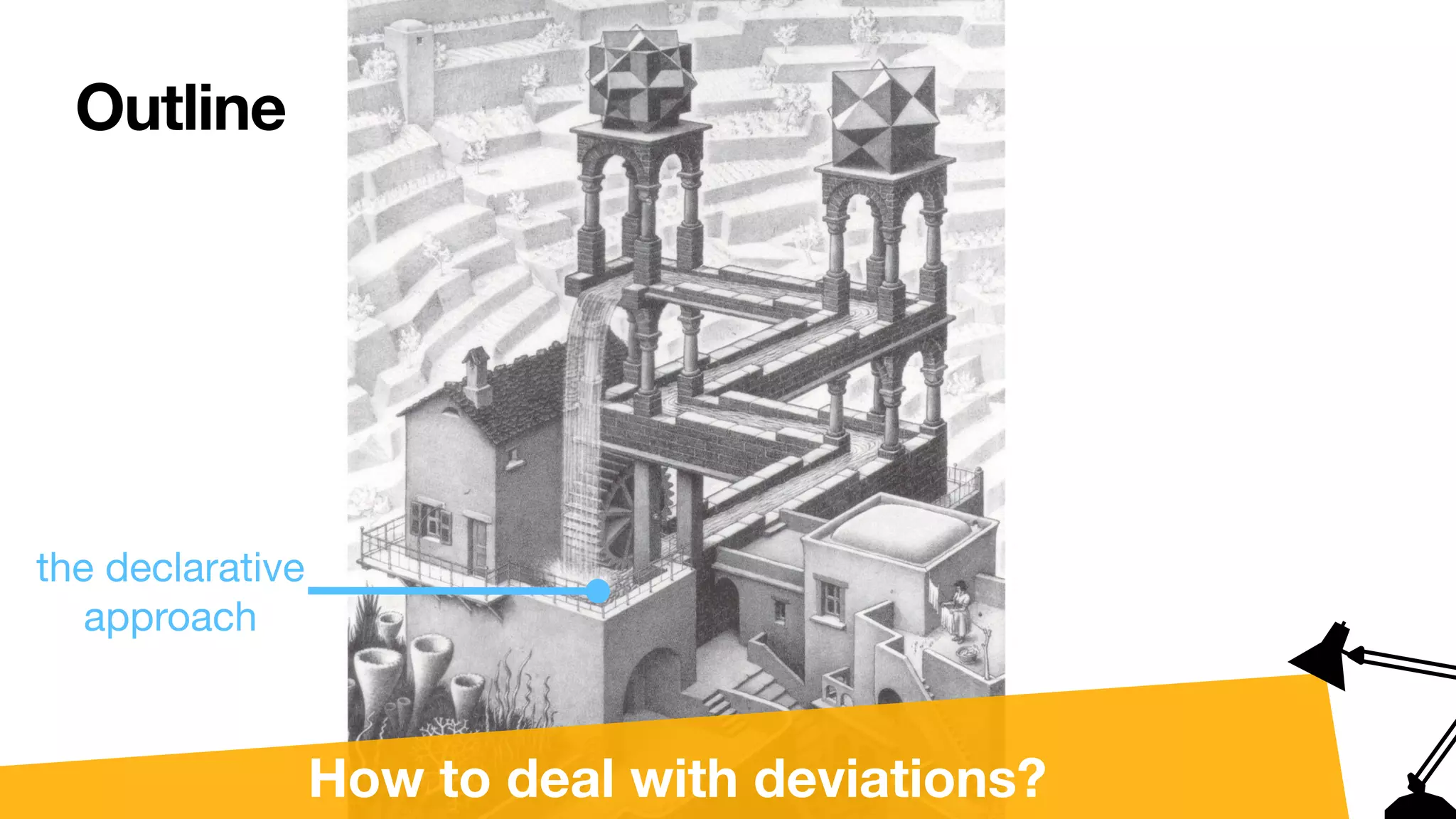
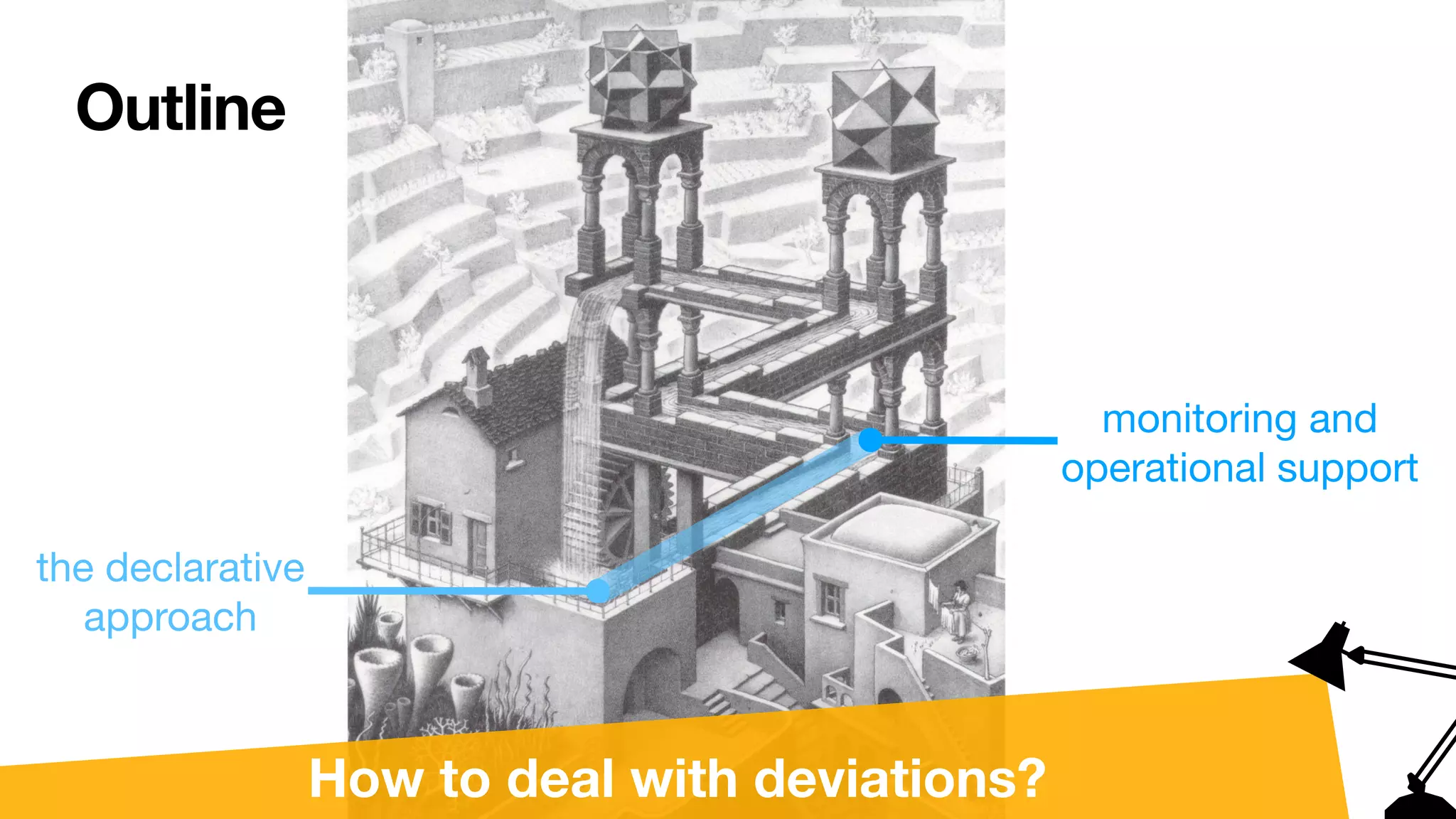
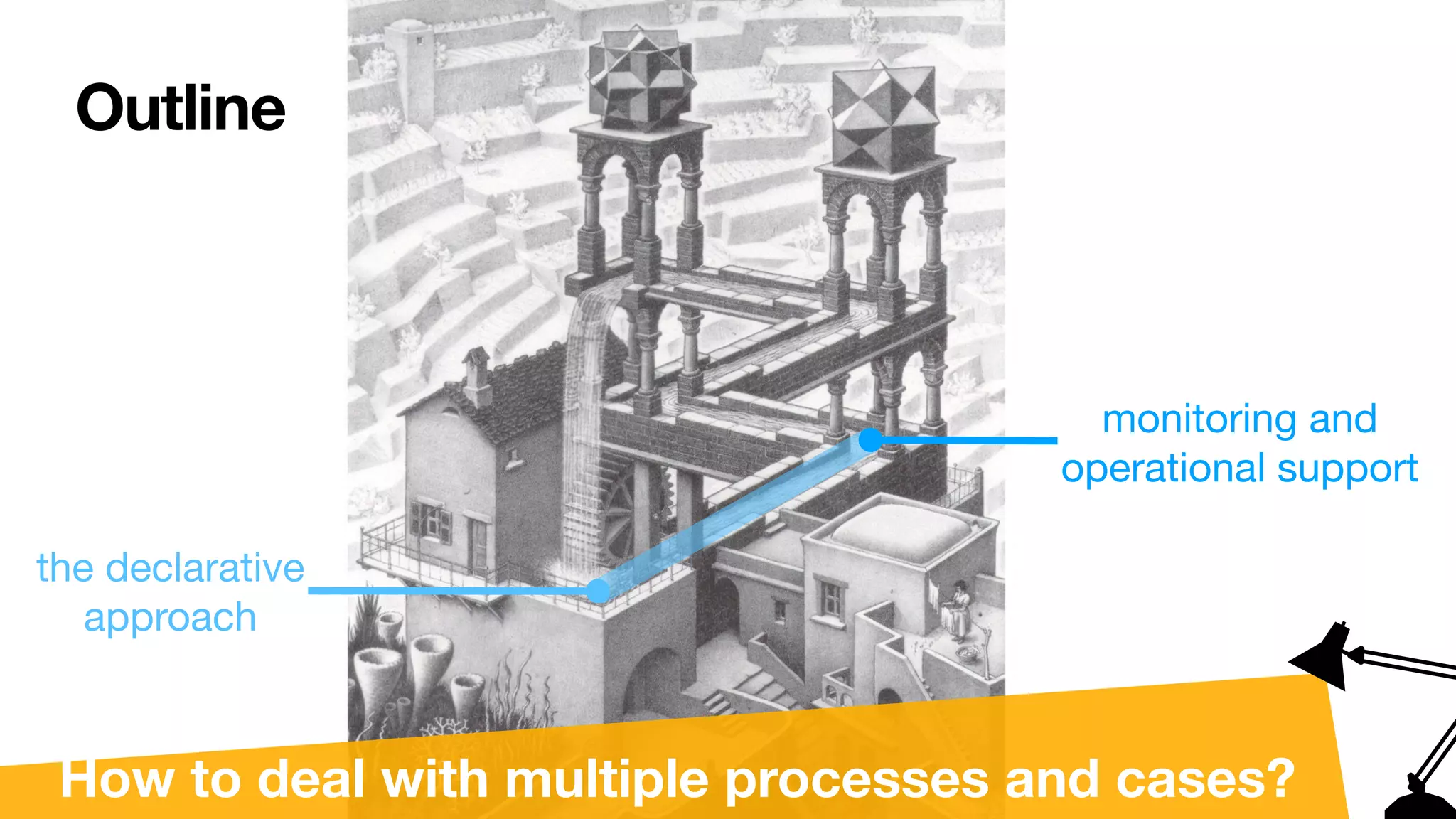
![Outline
the declarative
approach
monitoring and
operational support
dealing with
uncertainty
dealing with
multiple processes dealing with multiple
objects
How to deal with multiple processes and cases?
[____,CAiSE22]](https://image.slidesharecdn.com/ai4bpm-framing-montali-220914143006-e7edf68e/75/Constraints-for-Process-Framing-in-Augmented-BPM-41-2048.jpg)
![Outline
the declarative
approach
monitoring and
operational support
dealing with
uncertainty
dealing with
multiple processes dealing with multiple
objects
How to deal with multiple processes and cases?
[____,CAiSE22]
Interested in uncertainty for
procedural processes?
See our papers
at the main track
(presentations Tue and
Wed afternoon)](https://image.slidesharecdn.com/ai4bpm-framing-montali-220914143006-e7edf68e/75/Constraints-for-Process-Framing-in-Augmented-BPM-42-2048.jpg)

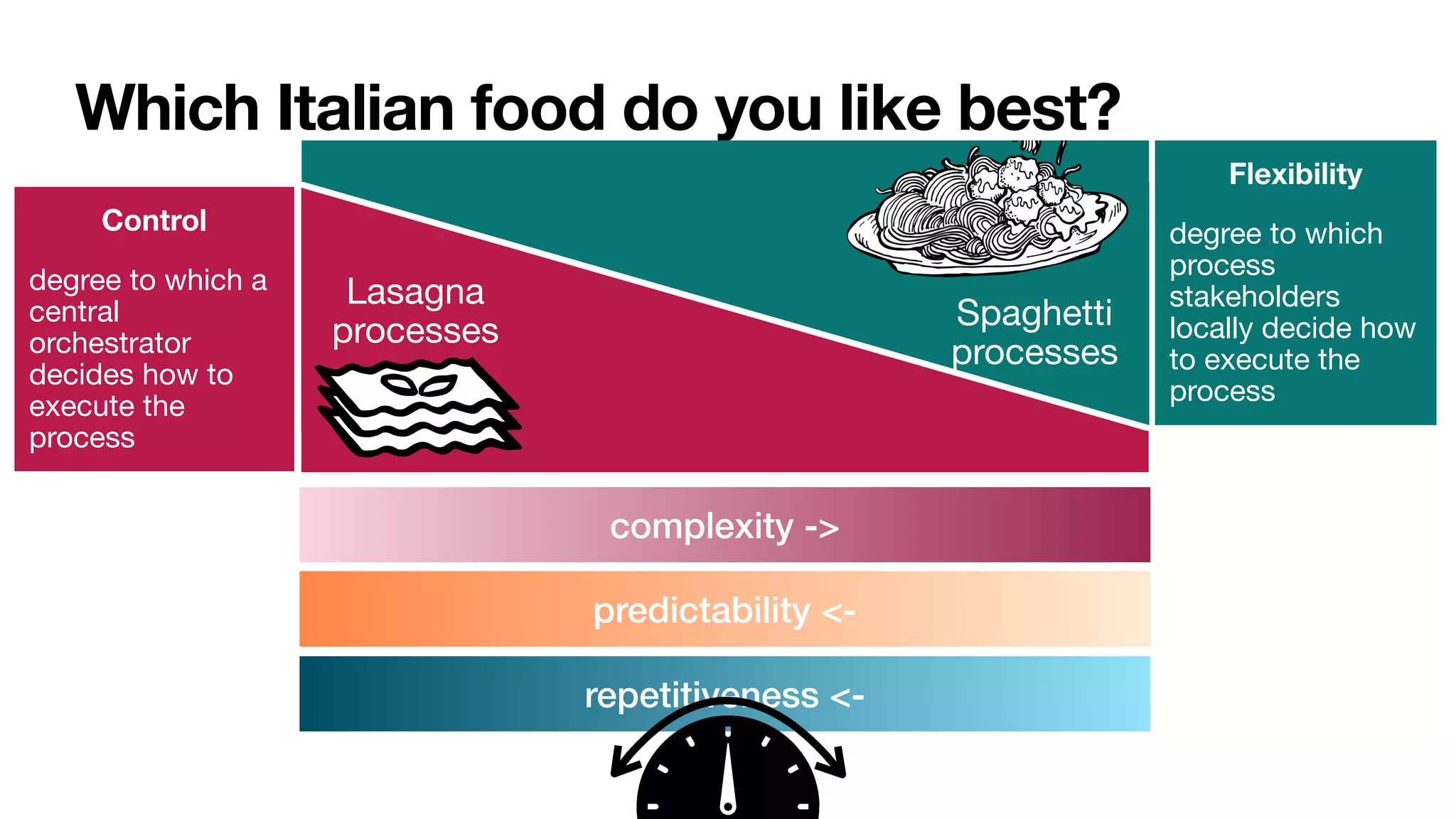
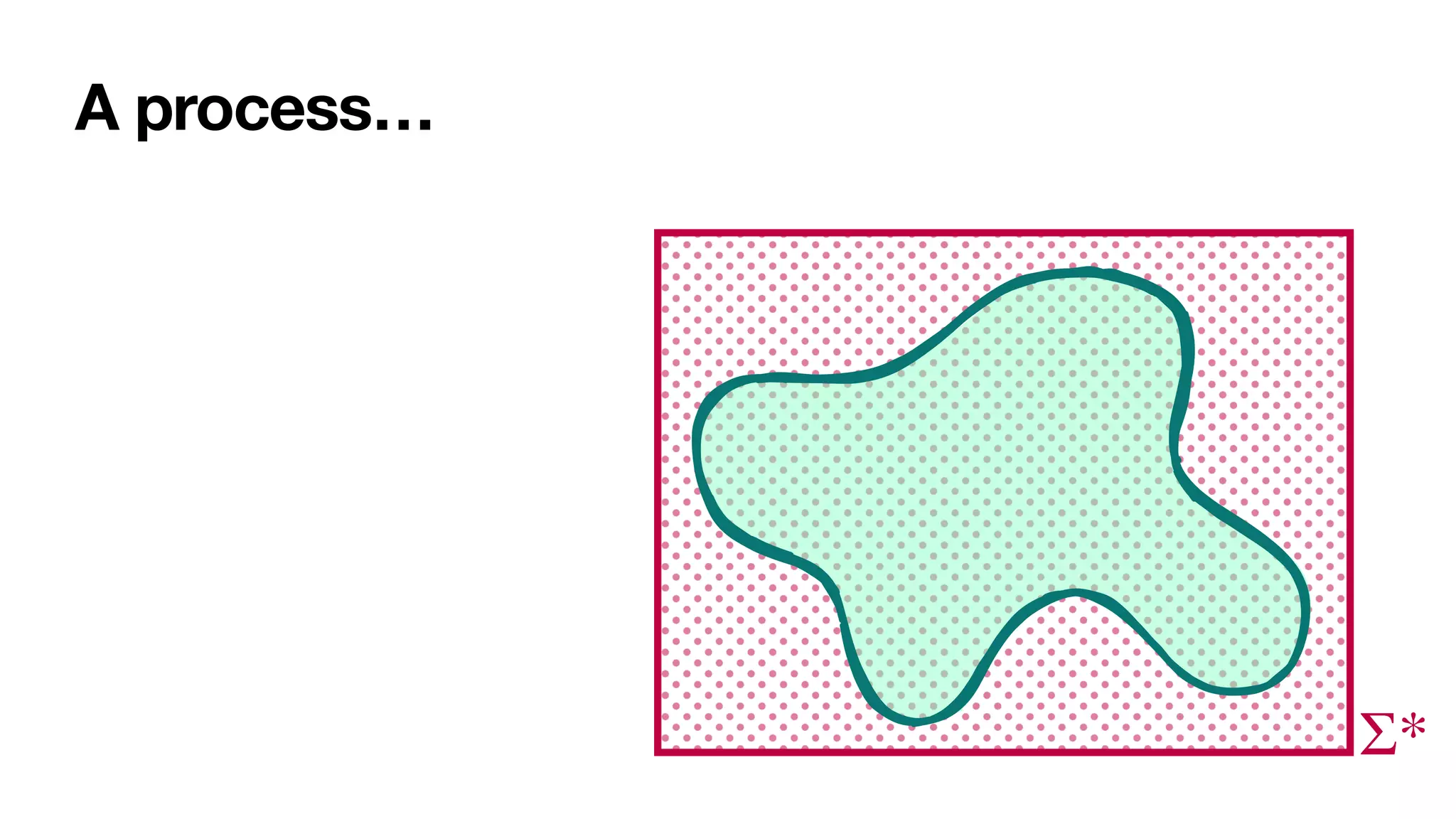
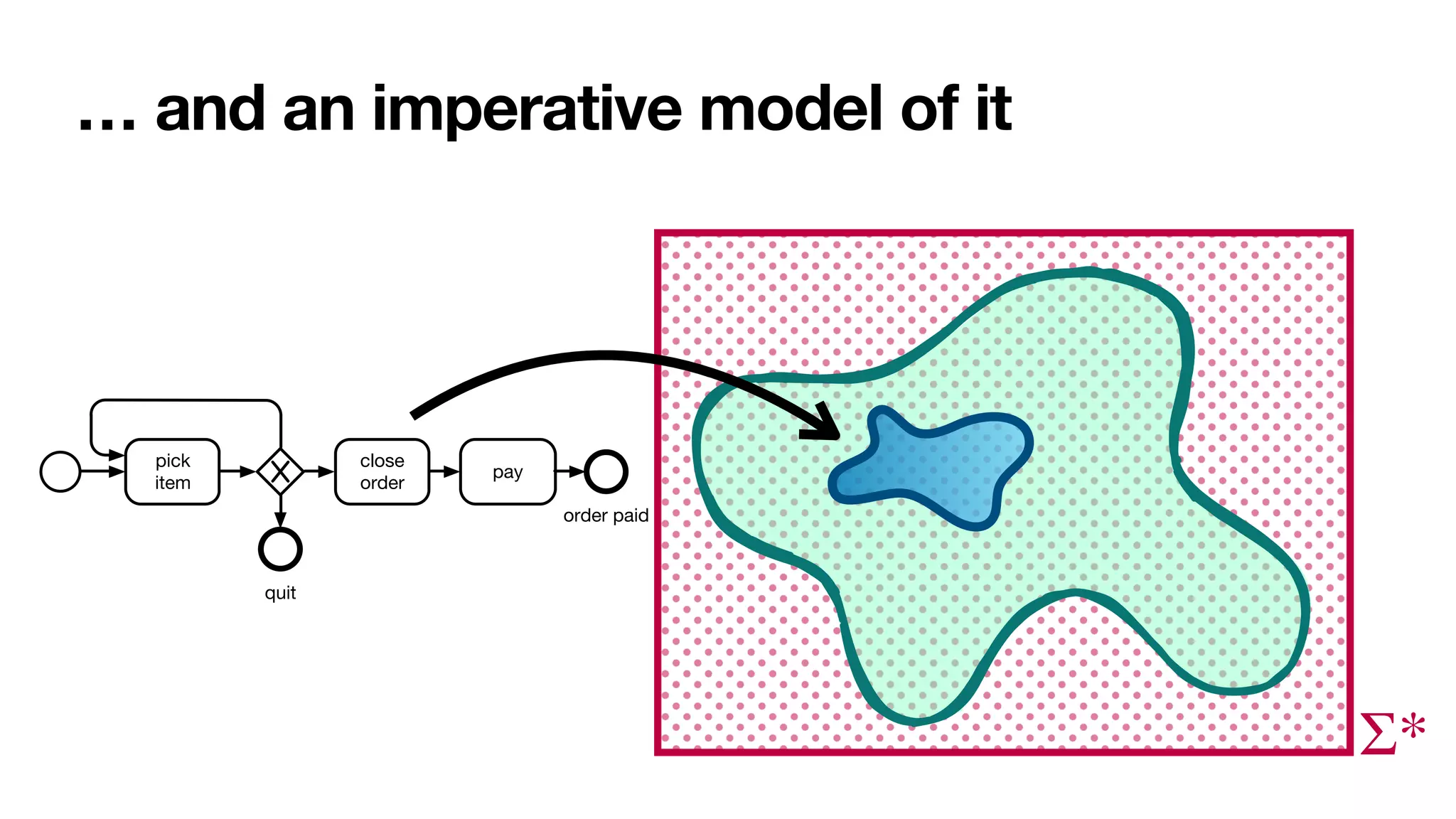
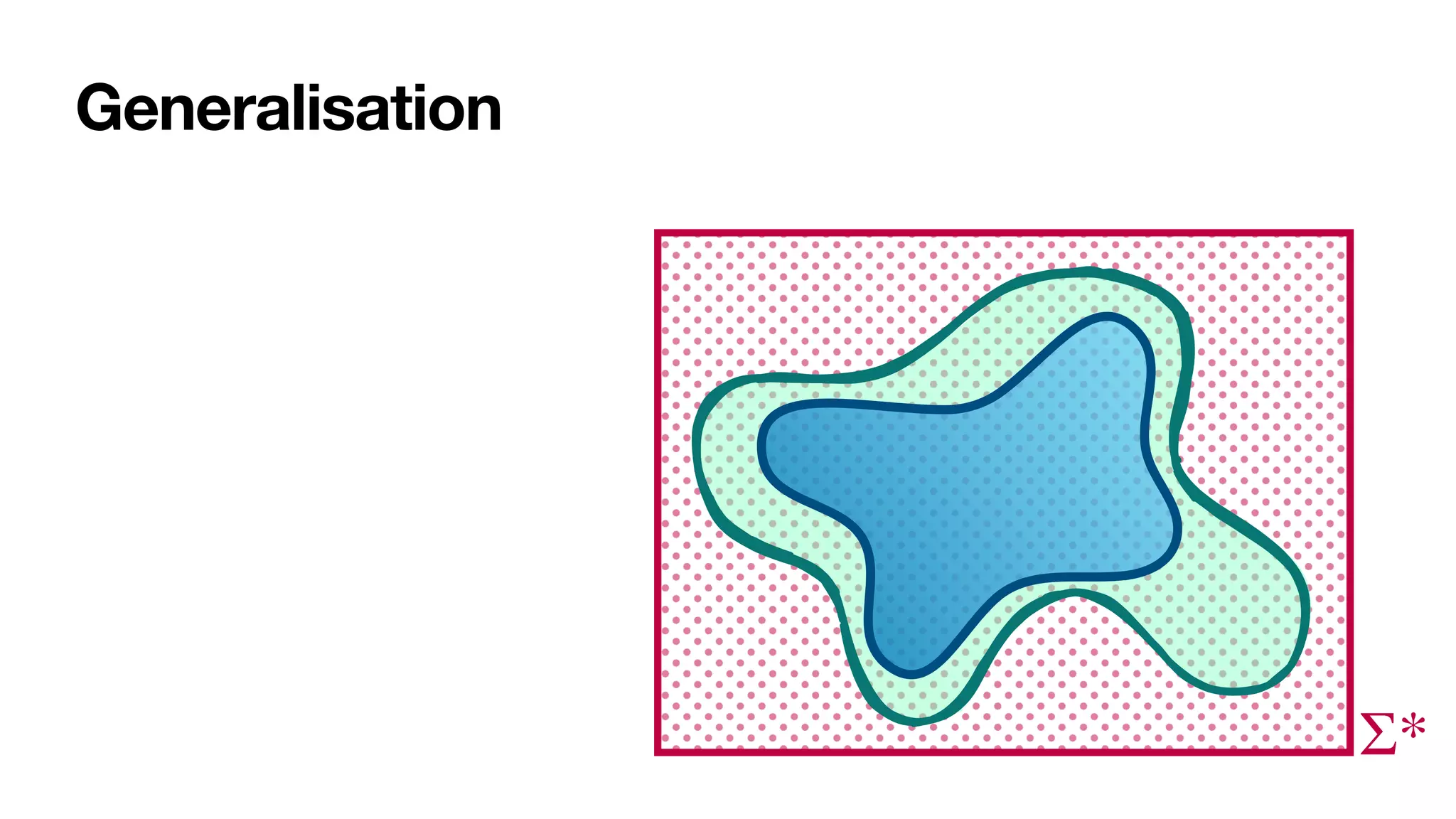
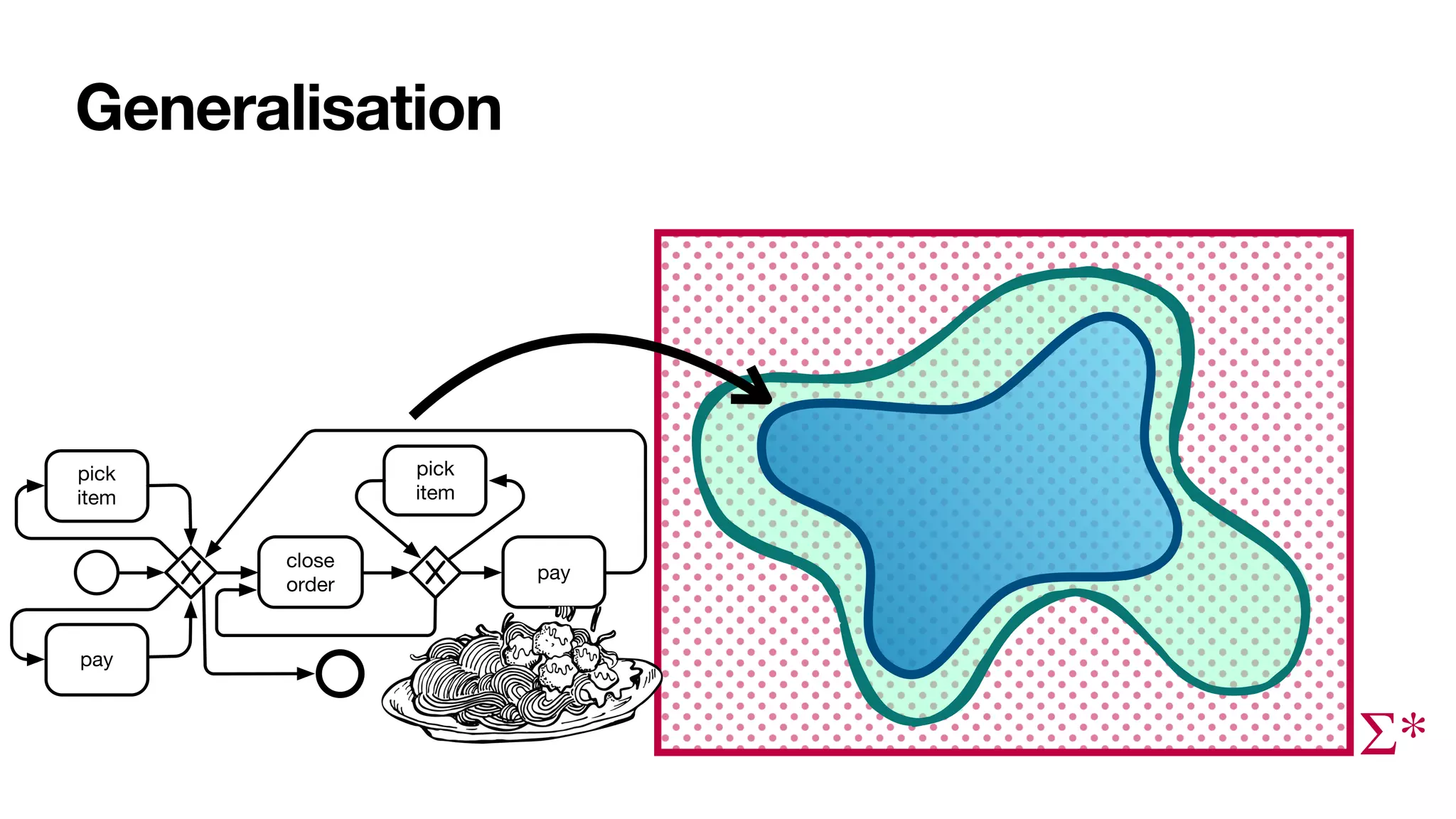

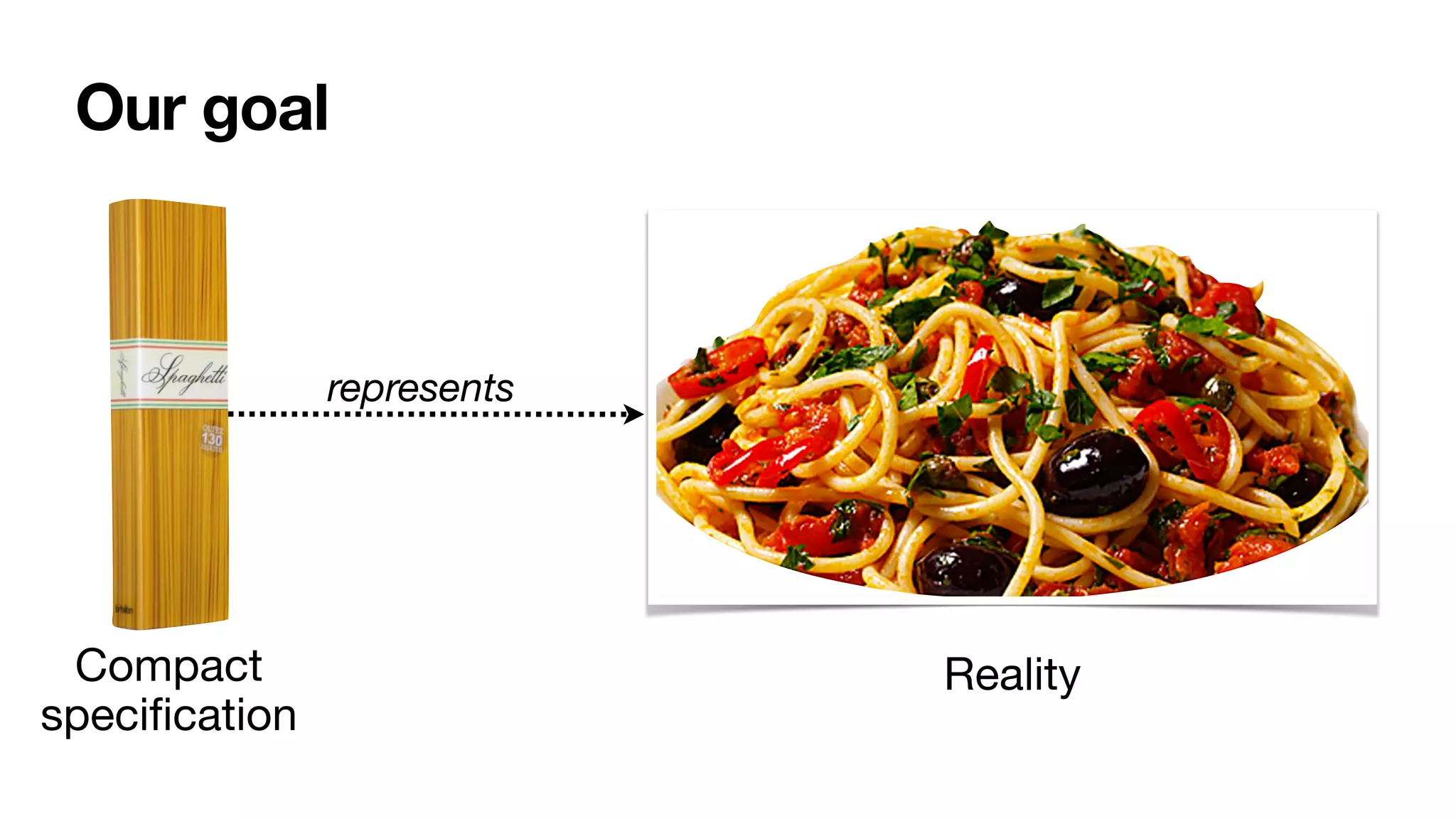
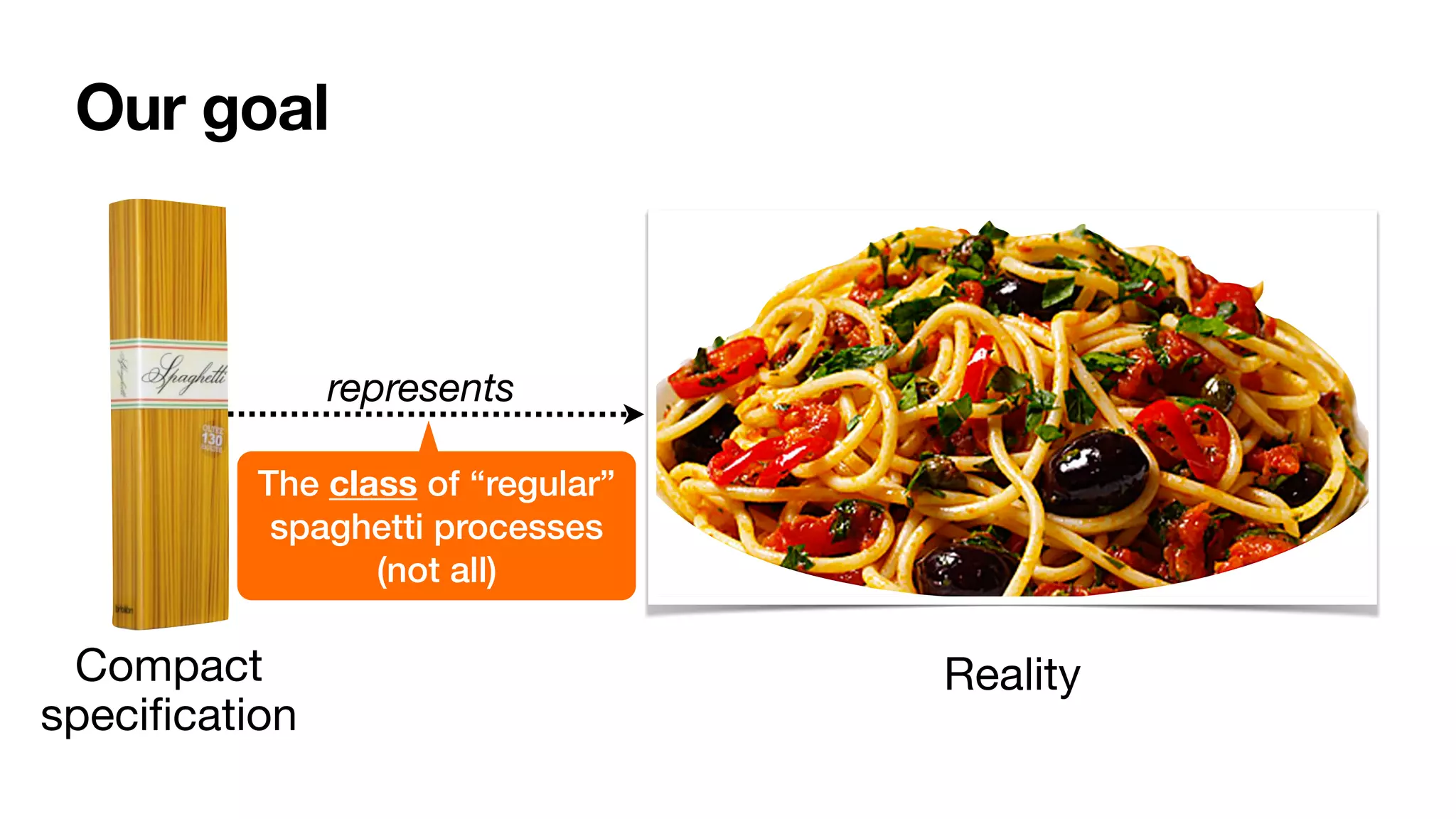
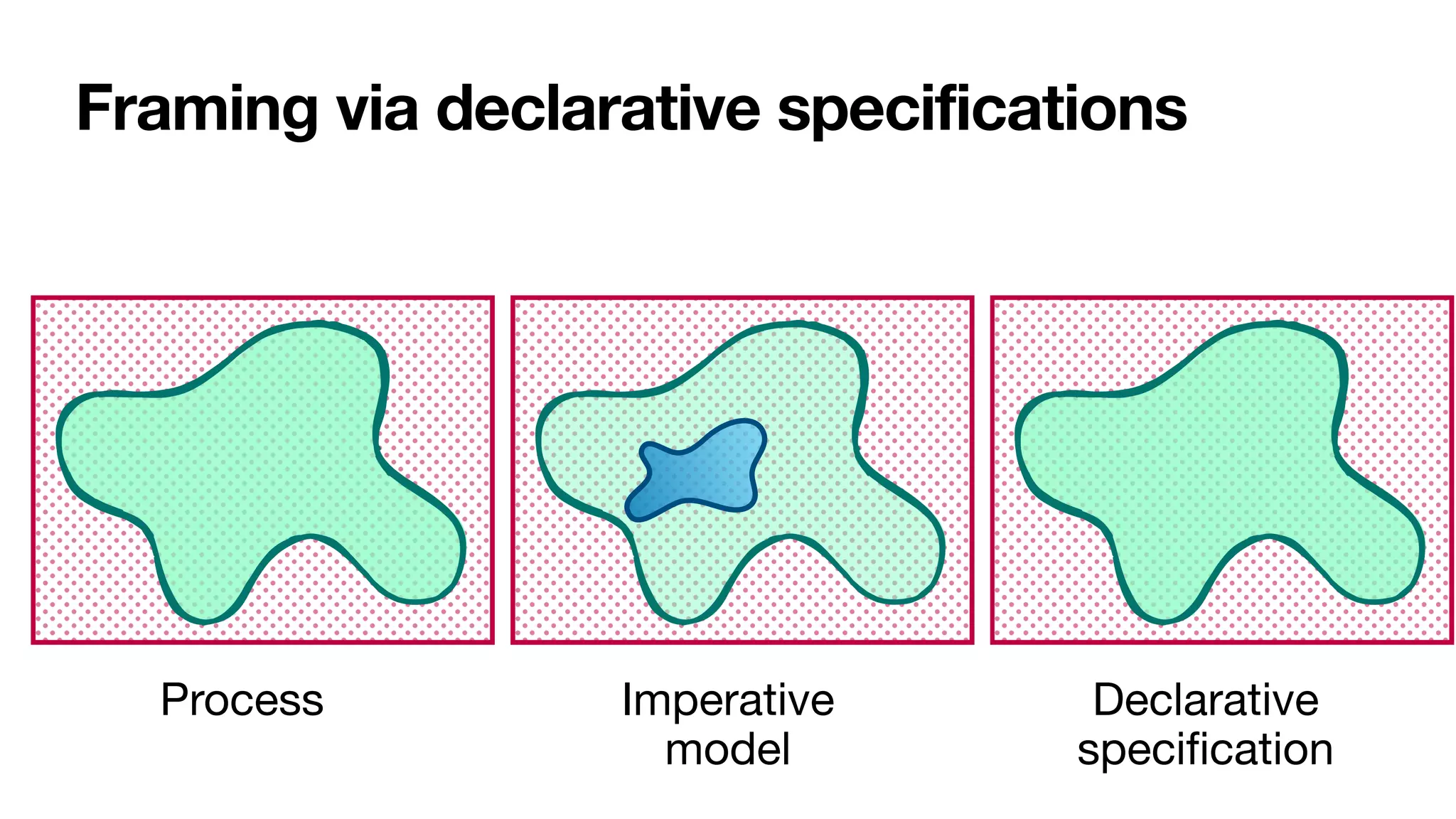
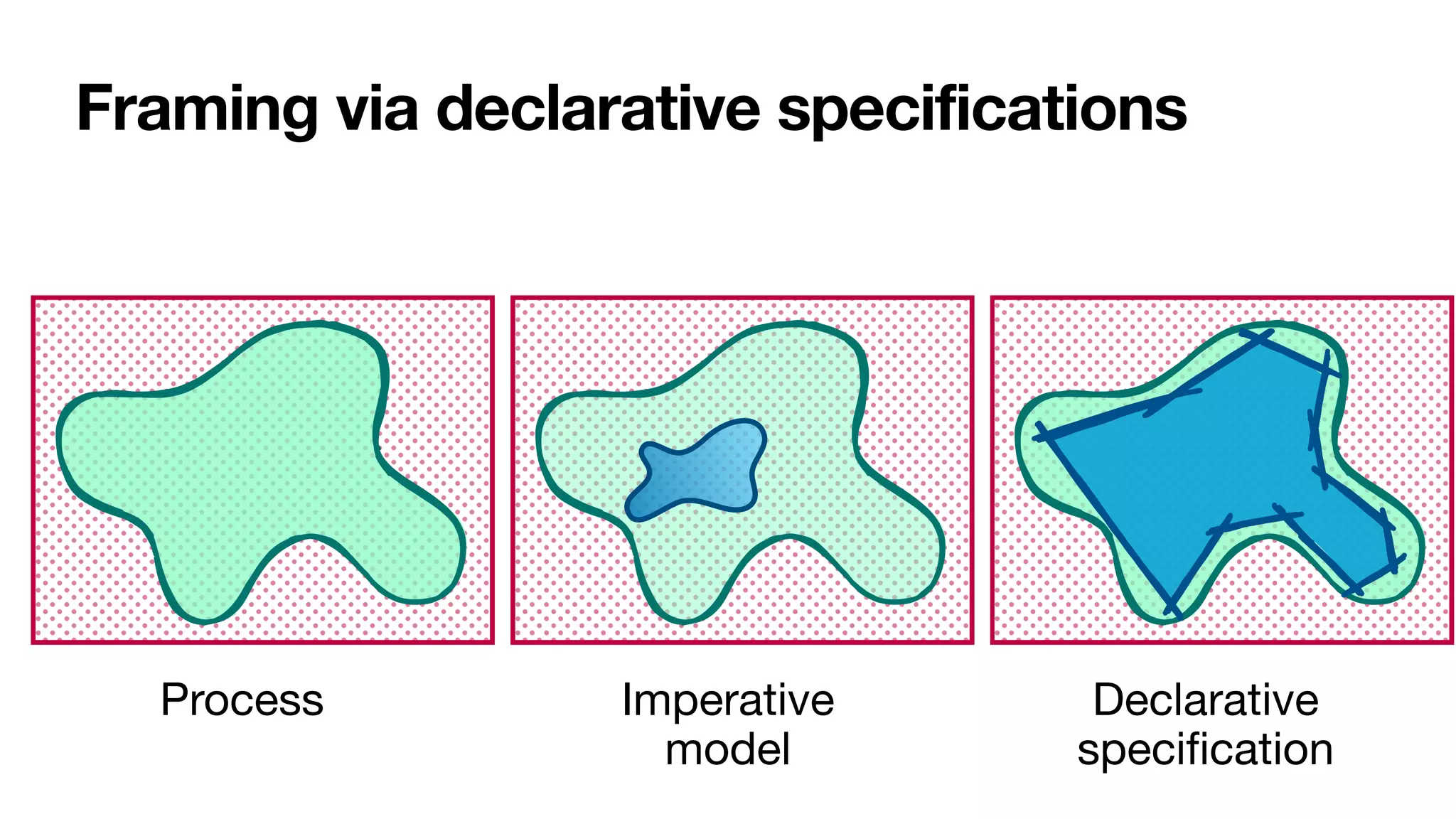
![Constraint-based specifications of behaviour
• Multiagent systems: declarative agent programs [Fisher,JSC1996]
and interaction protocols [Singh,AAMAS2003]
• Data management: cascaded transactional updates
[DavulcuEtAl,PODS1998]
• BPM (1st wave): loosely-coupled subprocesses [SadiqEtAl,ER2001]
• BPM (2nd wave): process constraints
• DECLARE [PesicEtAl,EDOC2007]
• Dynamic Condition-Response (DCR) Graphs
[HildebrandtEtAl,PLACES2010]](https://image.slidesharecdn.com/ai4bpm-framing-montali-220914143006-e7edf68e/75/Constraints-for-Process-Framing-in-Augmented-BPM-54-2048.jpg)
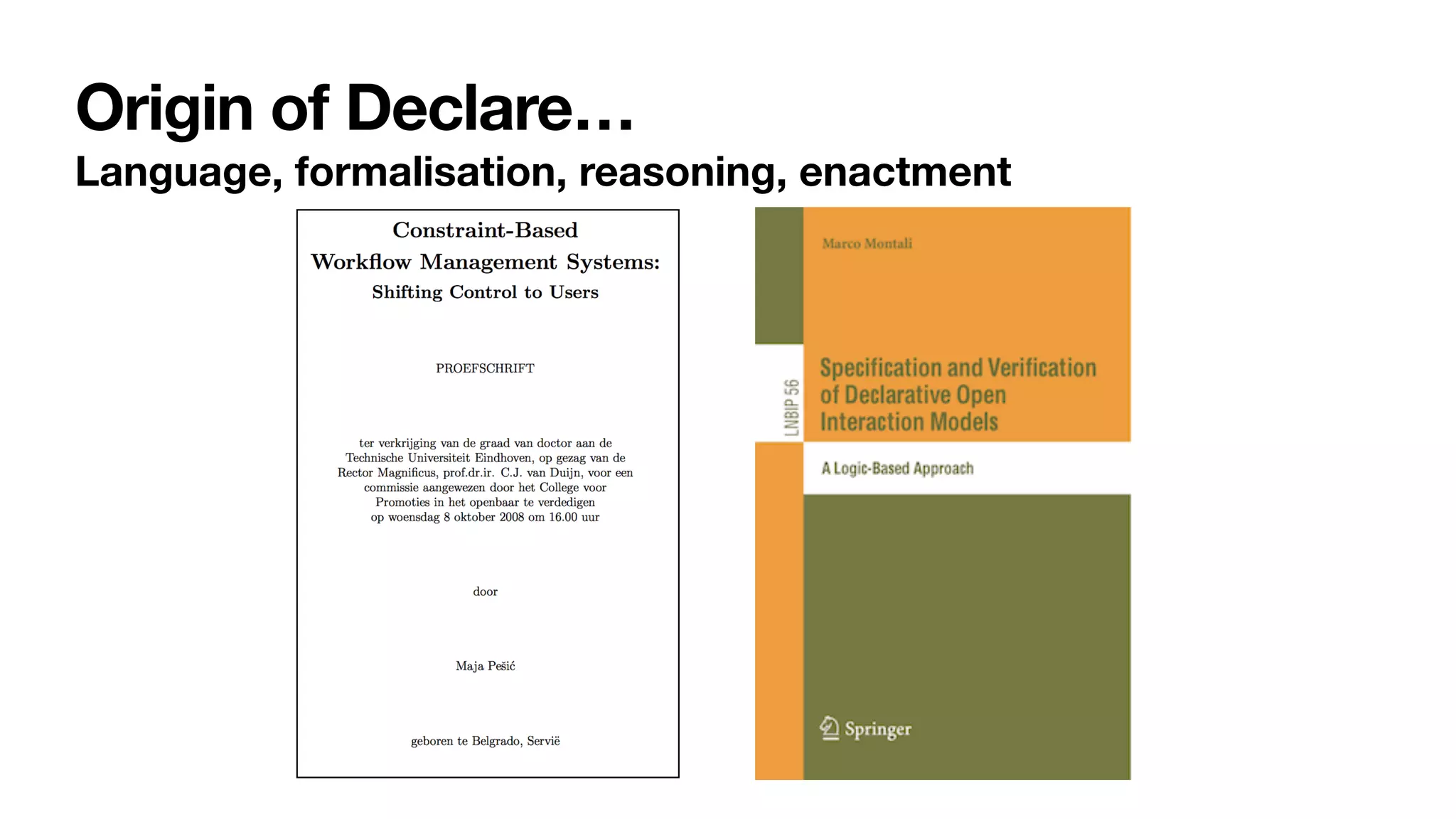
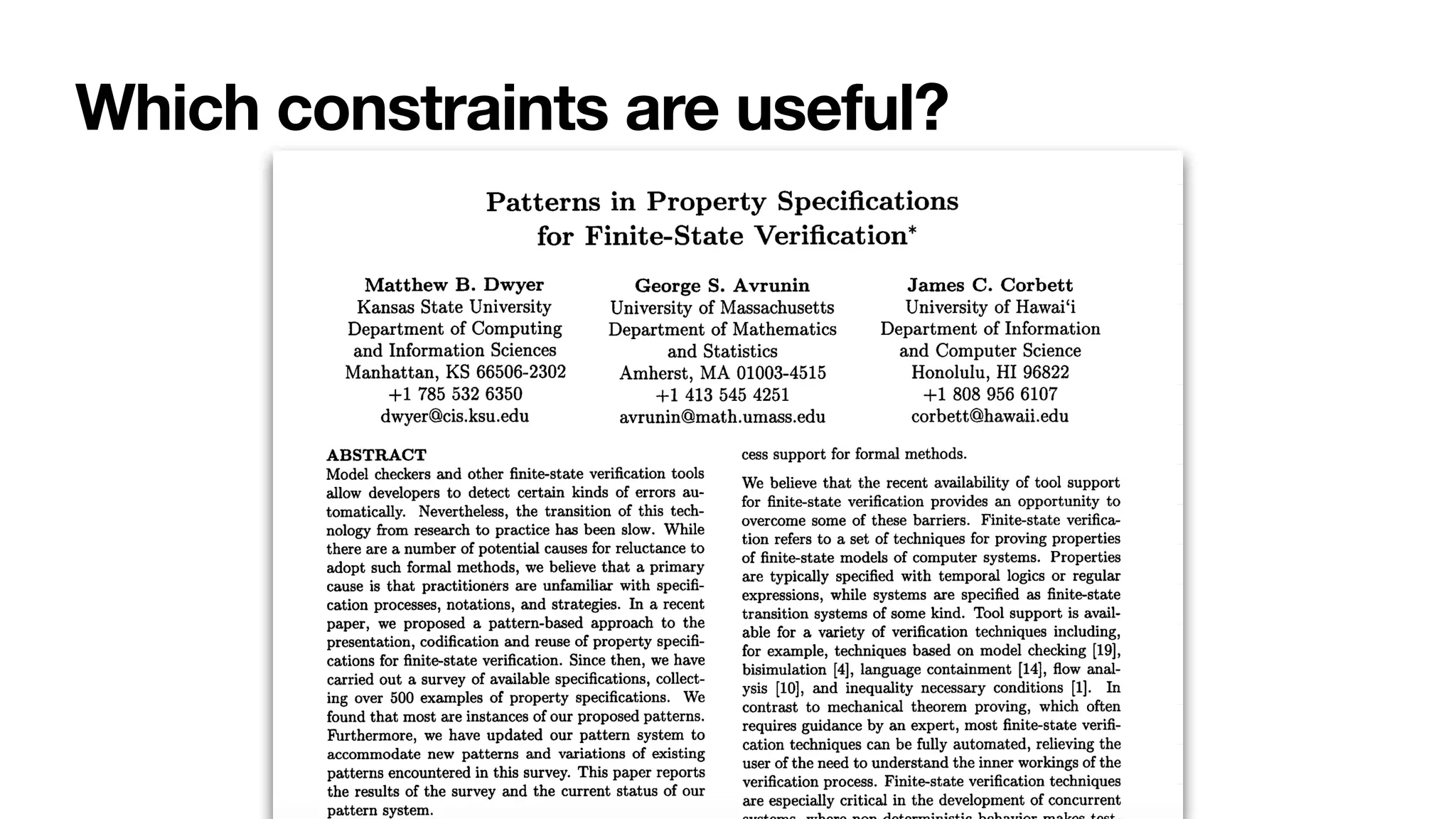

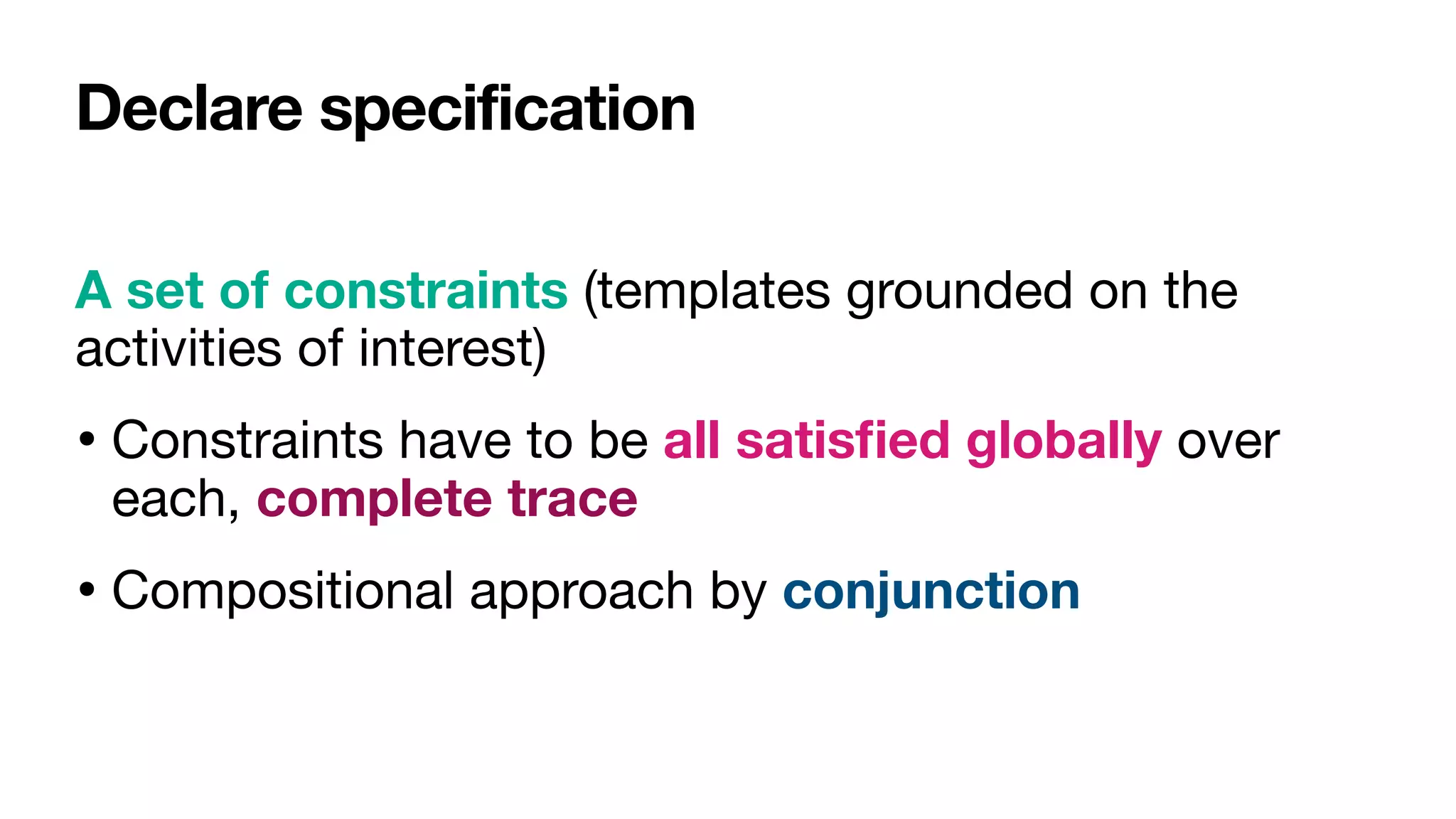
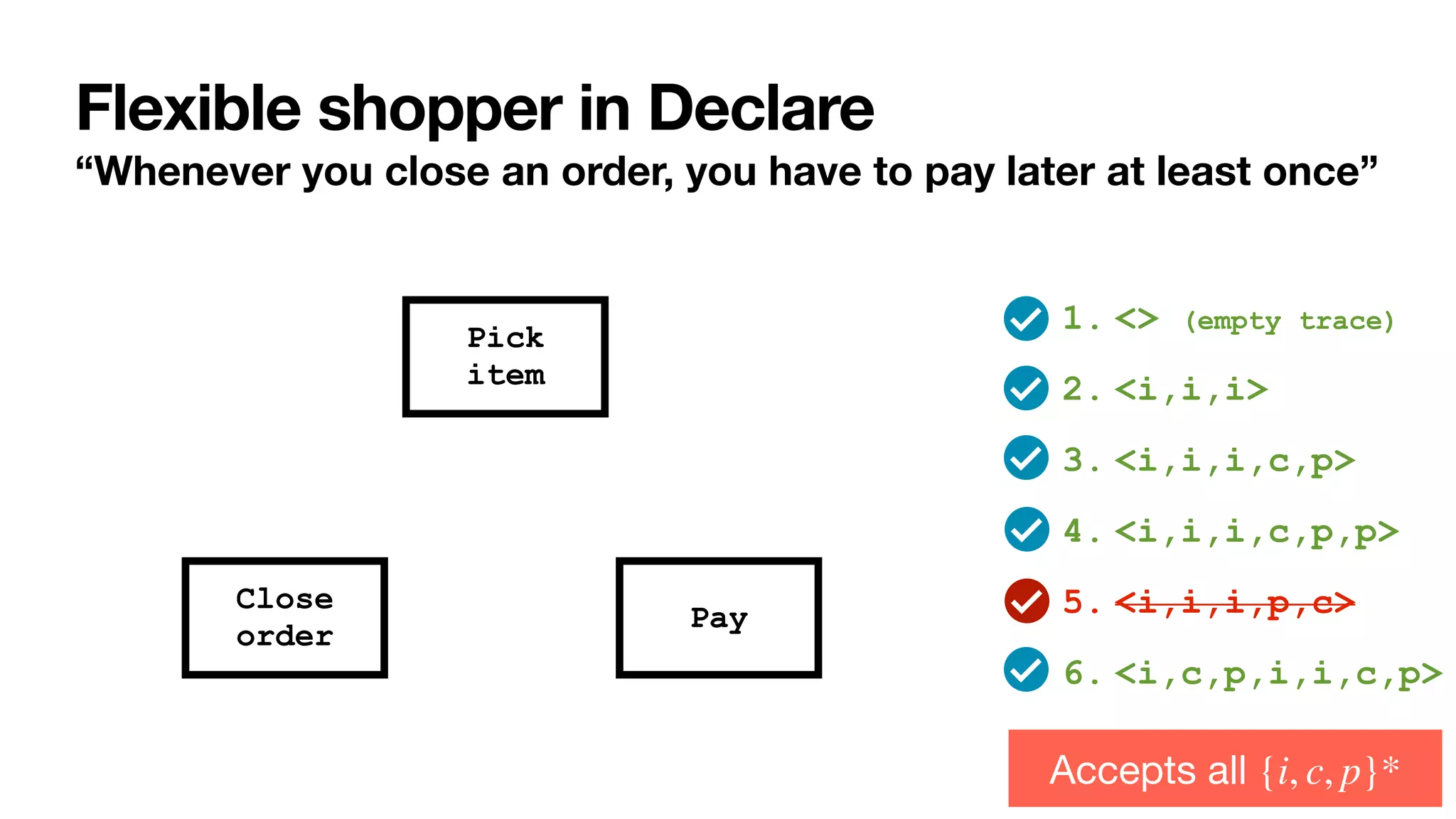

![Interaction among constraints
Aka hidden dependencies [____,TWEB2010]
Cancel
order
Close
order
Pay
If you cancel the order,
you cannot pay for it
If you close the order,
you must pay for it
Pick
item
To close an order, you
must
fi
rst pick an item](https://image.slidesharecdn.com/ai4bpm-framing-montali-220914143006-e7edf68e/75/Constraints-for-Process-Framing-in-Augmented-BPM-61-2048.jpg)
![Interaction among constraints
Aka hidden dependencies [____,TWEB2010]
Cancel
order
Close
order
Pay
If you cancel the order,
you cannot pay for it
If you close the order,
you must pay for it
Pick
item
To close an order, you
must
fi
rst pick an item
Implied: cannot
cancel and
con
fi
rm!](https://image.slidesharecdn.com/ai4bpm-framing-montali-220914143006-e7edf68e/75/Constraints-for-Process-Framing-in-Augmented-BPM-62-2048.jpg)
![Interaction among constraints
Aka hidden dependencies [____,TWEB2010]
Cancel
order
Close
order
Pay
If you cancel the order,
you cannot pay for it
If you close the order,
you must pay for it
Pick
item
To close an order, you
must
fi
rst pick an item
Implied: cannot
cancel and
con
fi
rm!
Key questions
1. How to
characterise the
language of a
Declare
speci
fi
cation?
2. How to
understand
whether a
speci
fi
cation is
correct?](https://image.slidesharecdn.com/ai4bpm-framing-montali-220914143006-e7edf68e/75/Constraints-for-Process-Framing-in-Augmented-BPM-63-2048.jpg)
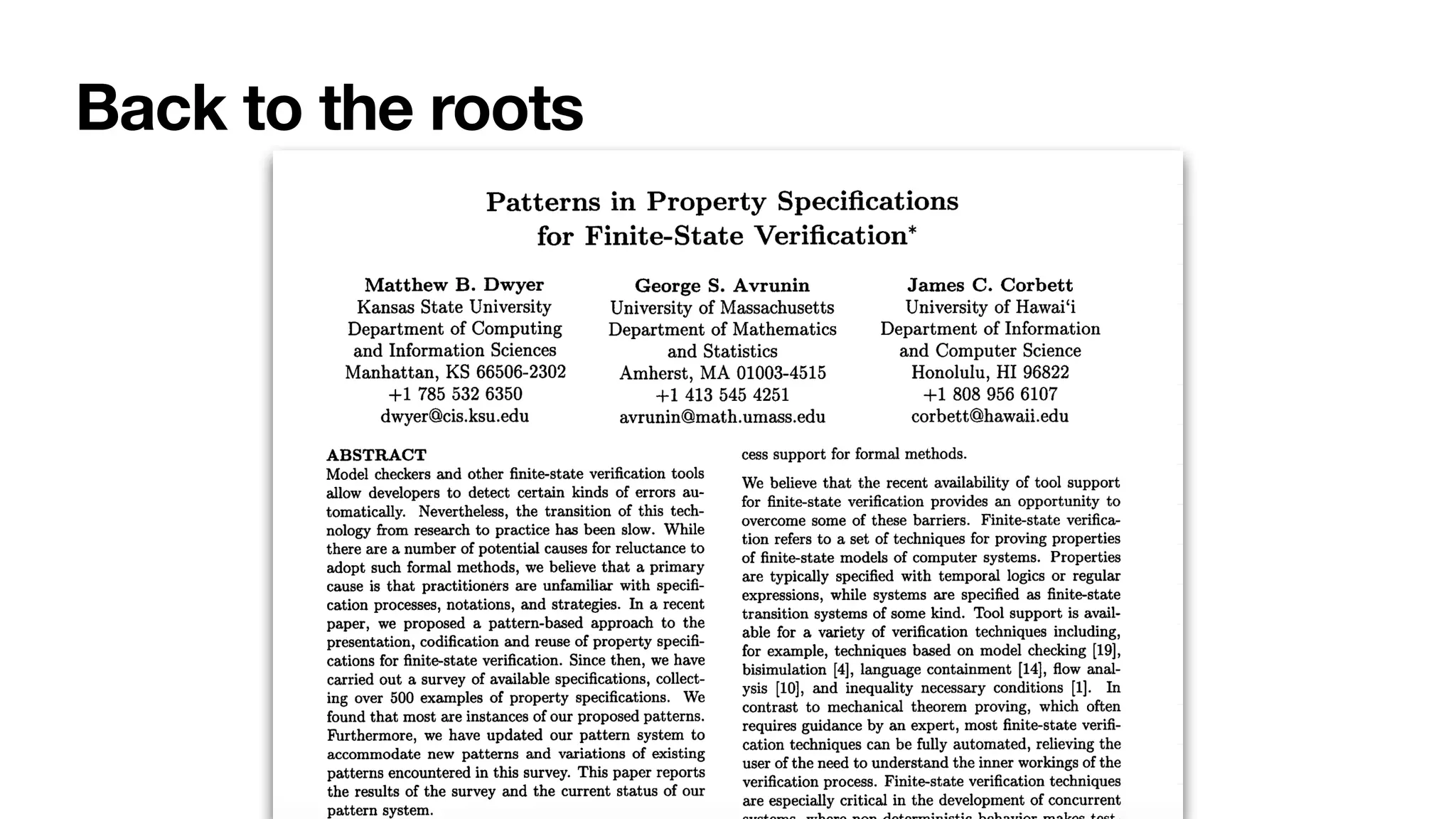
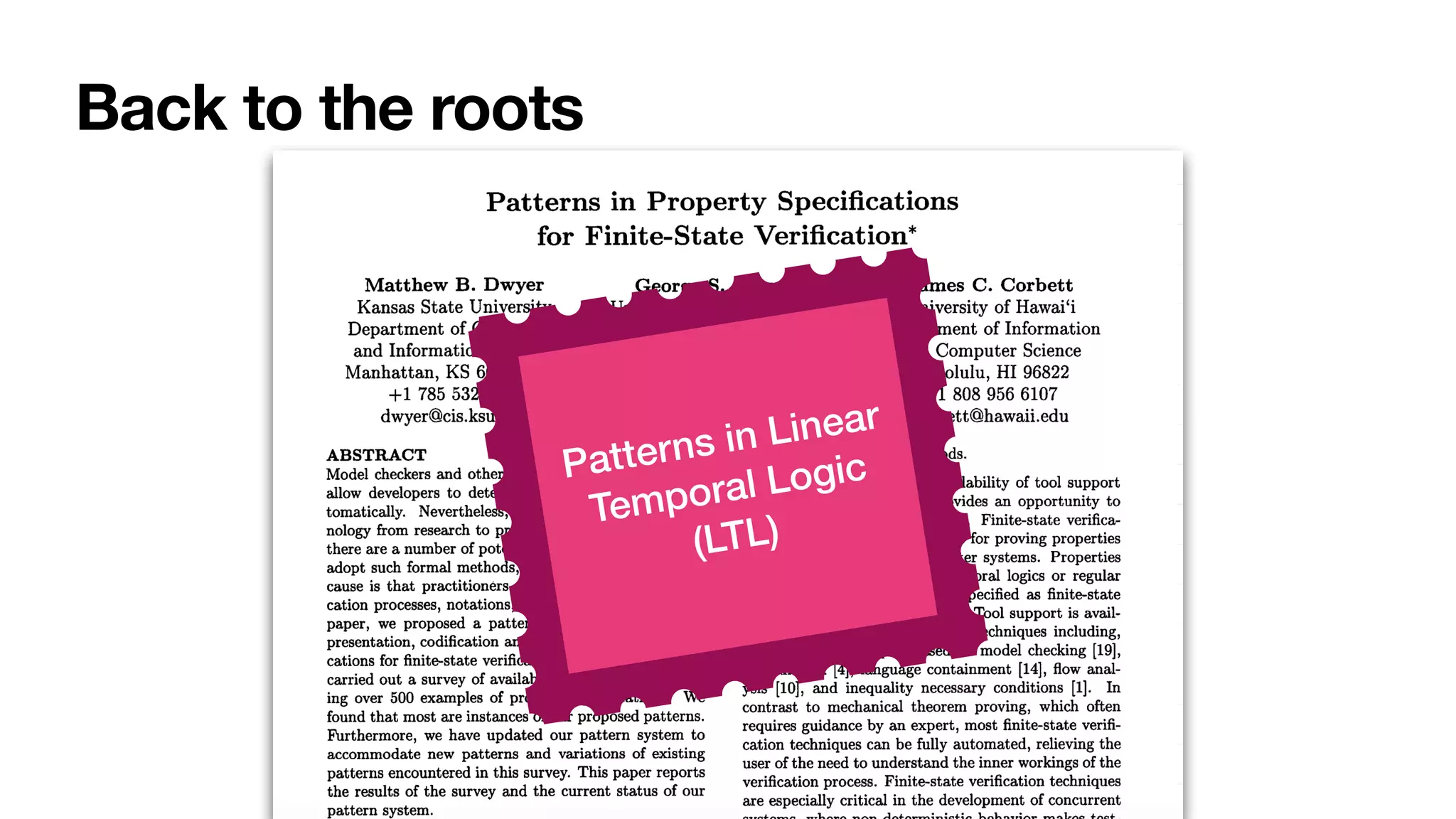

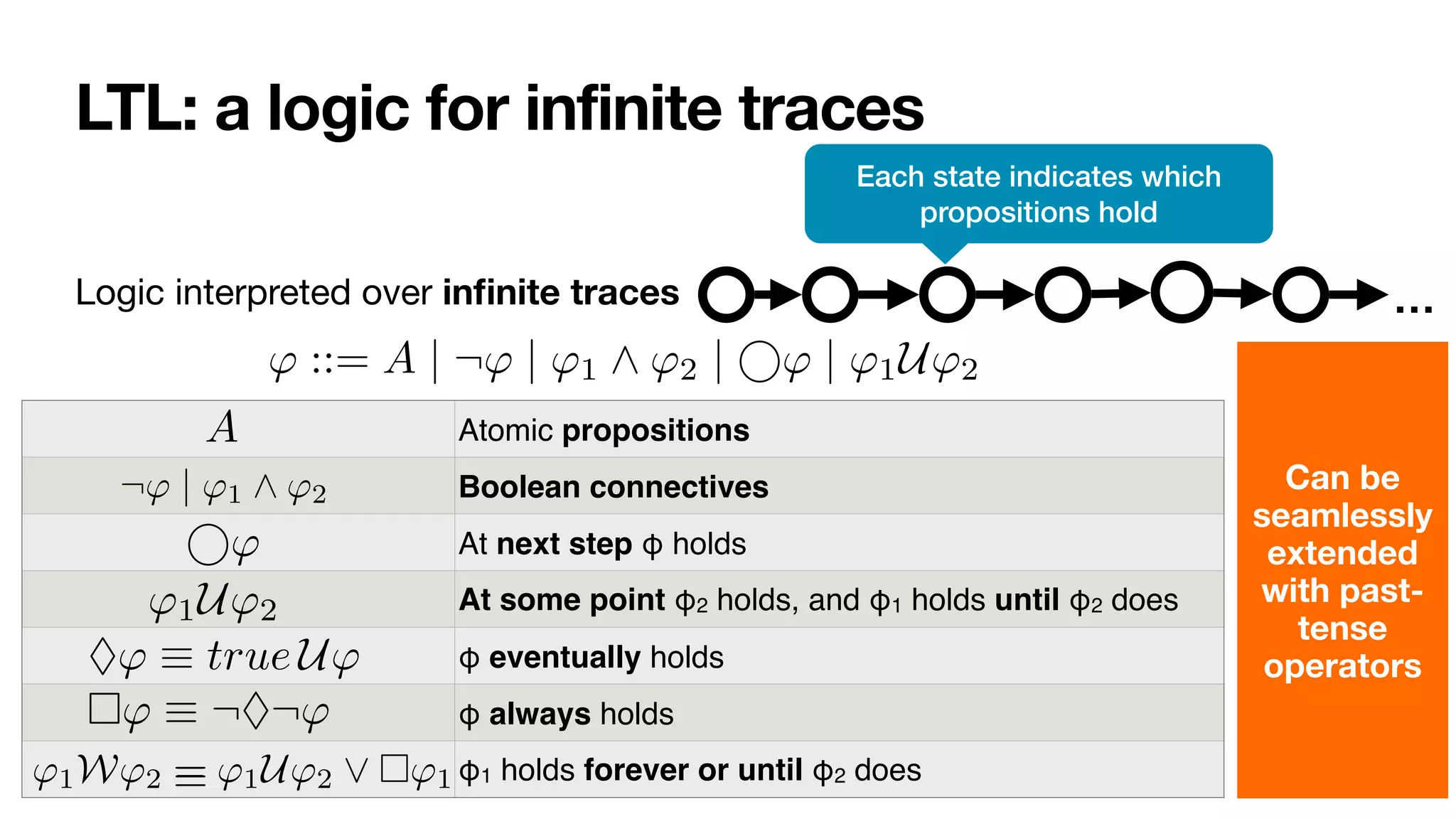
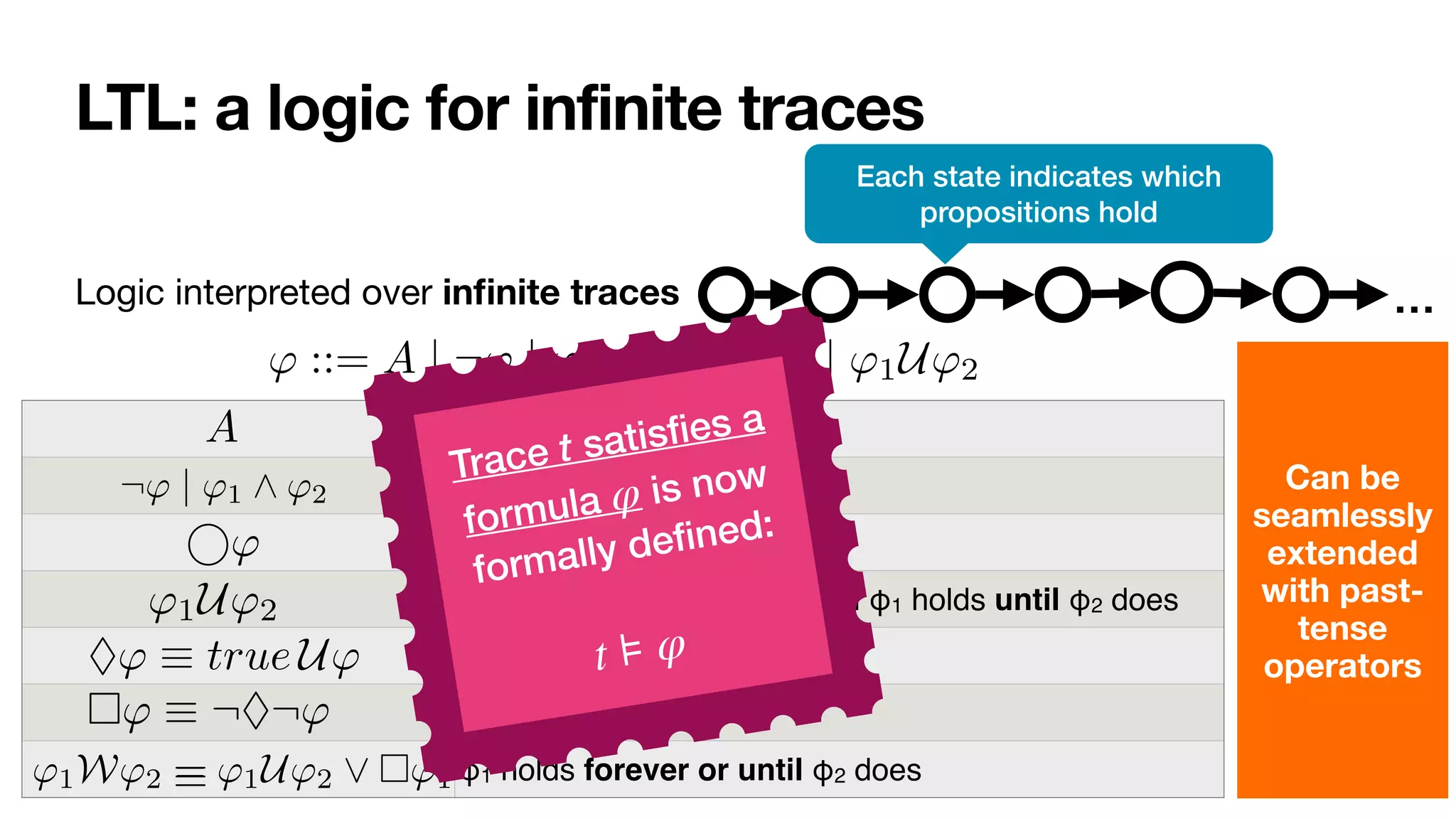
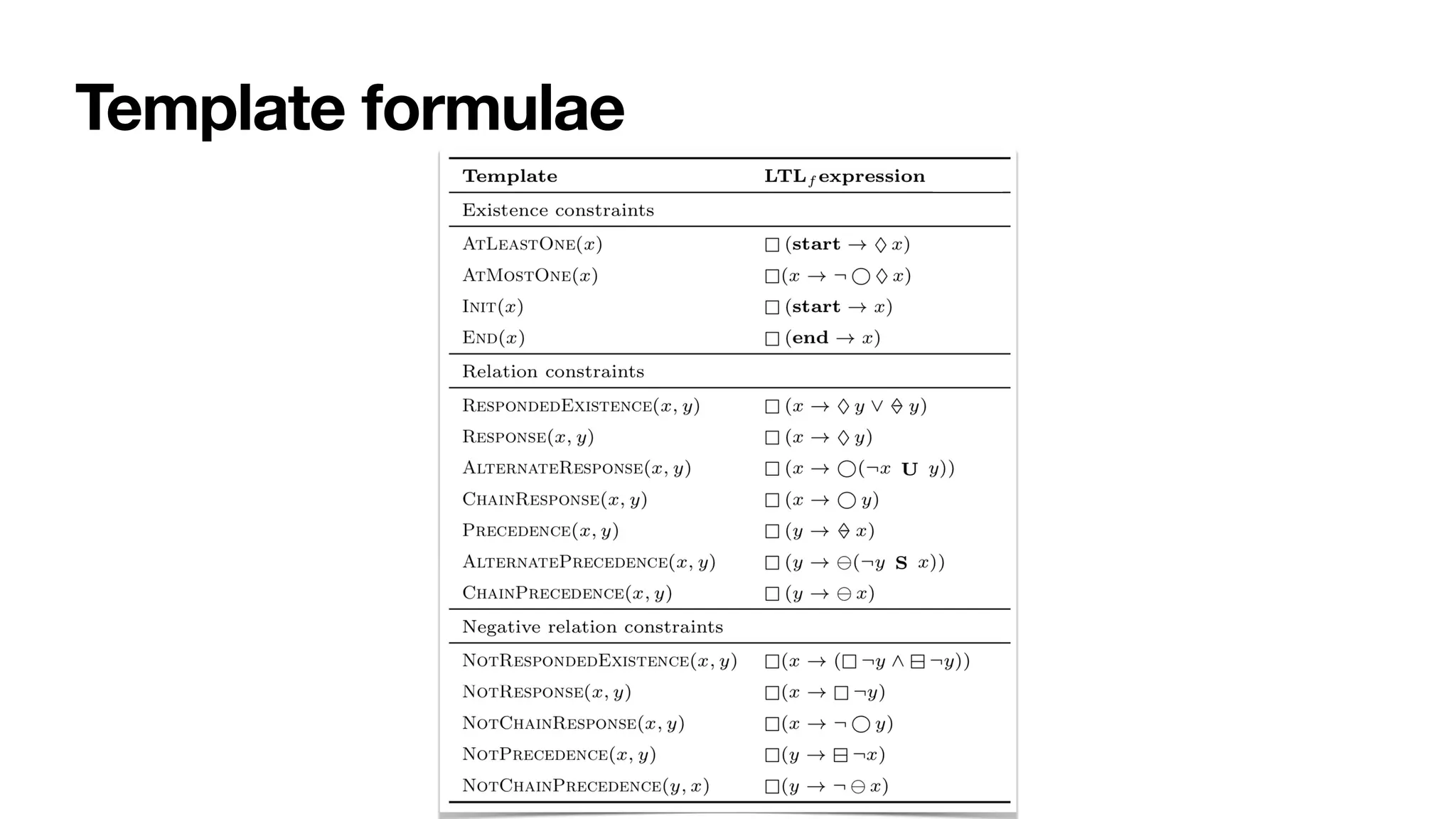
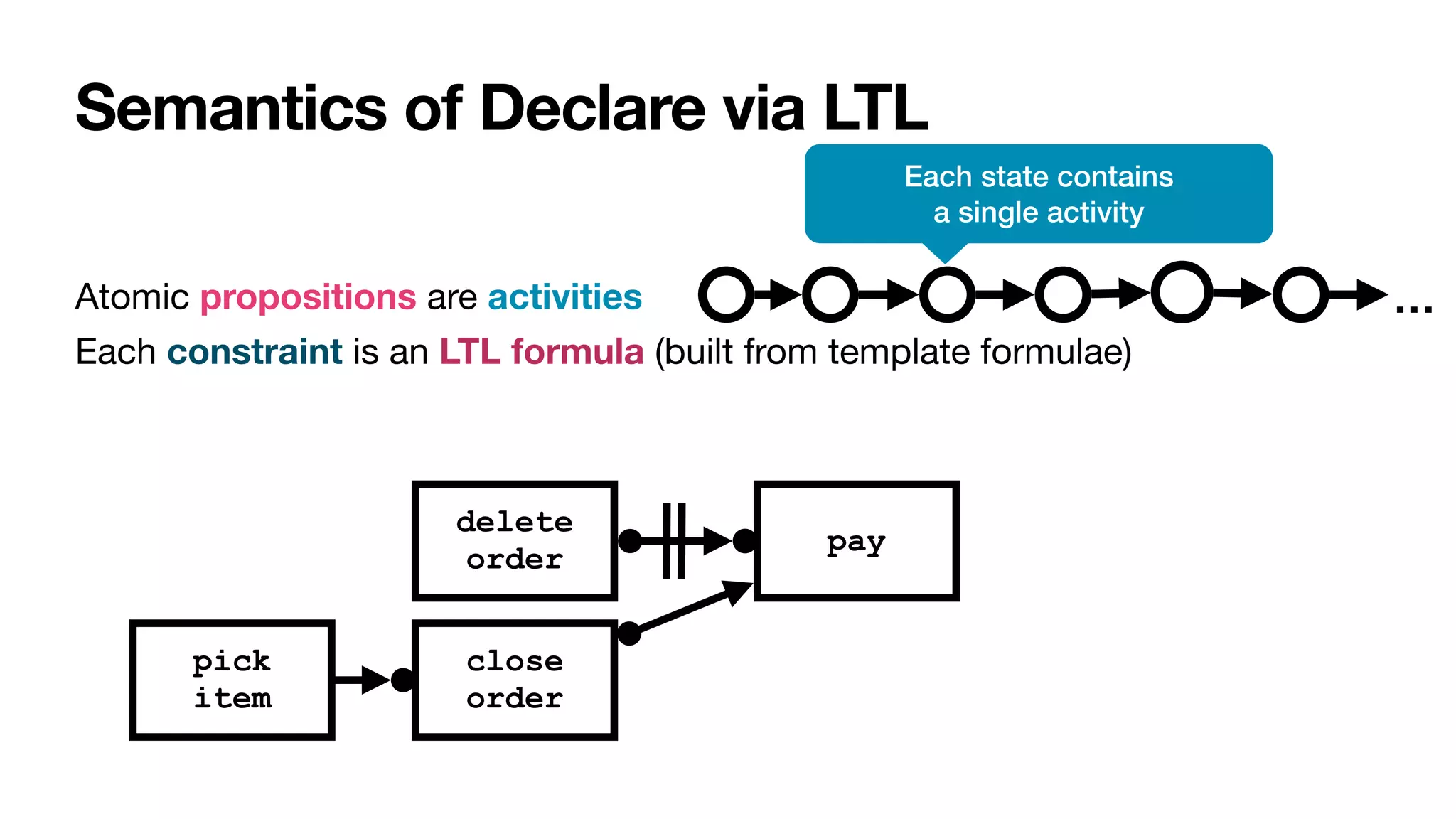
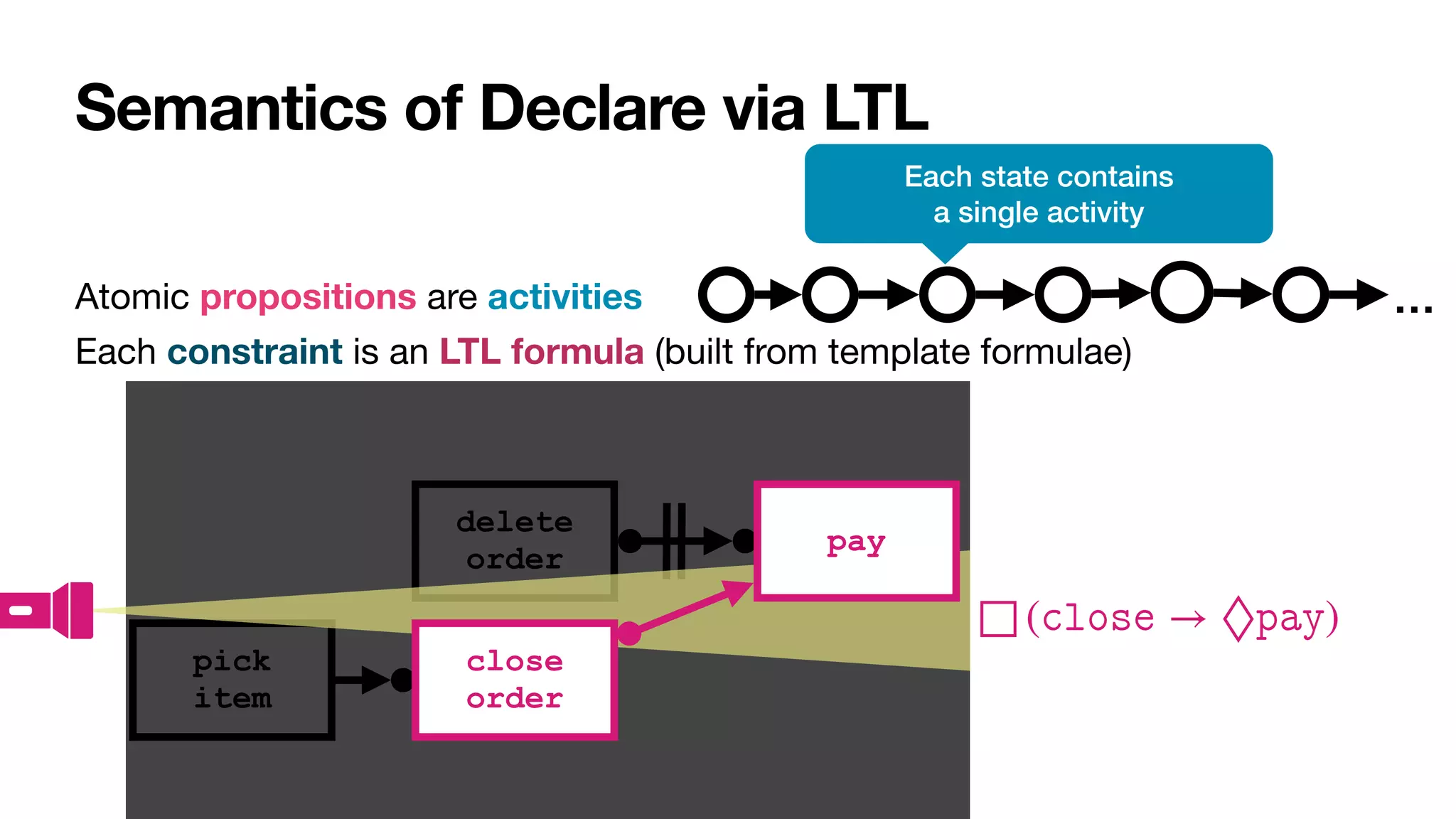
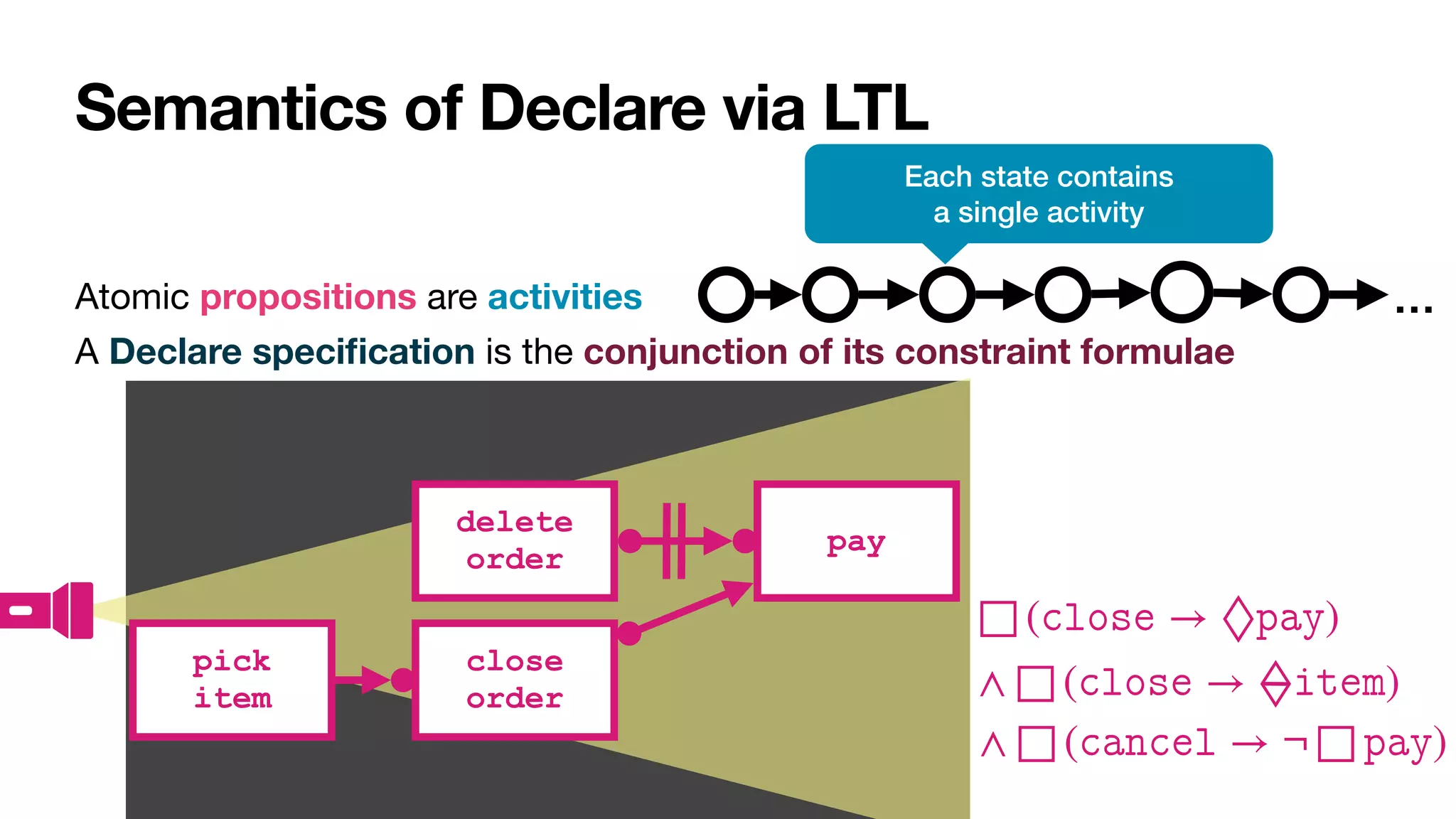
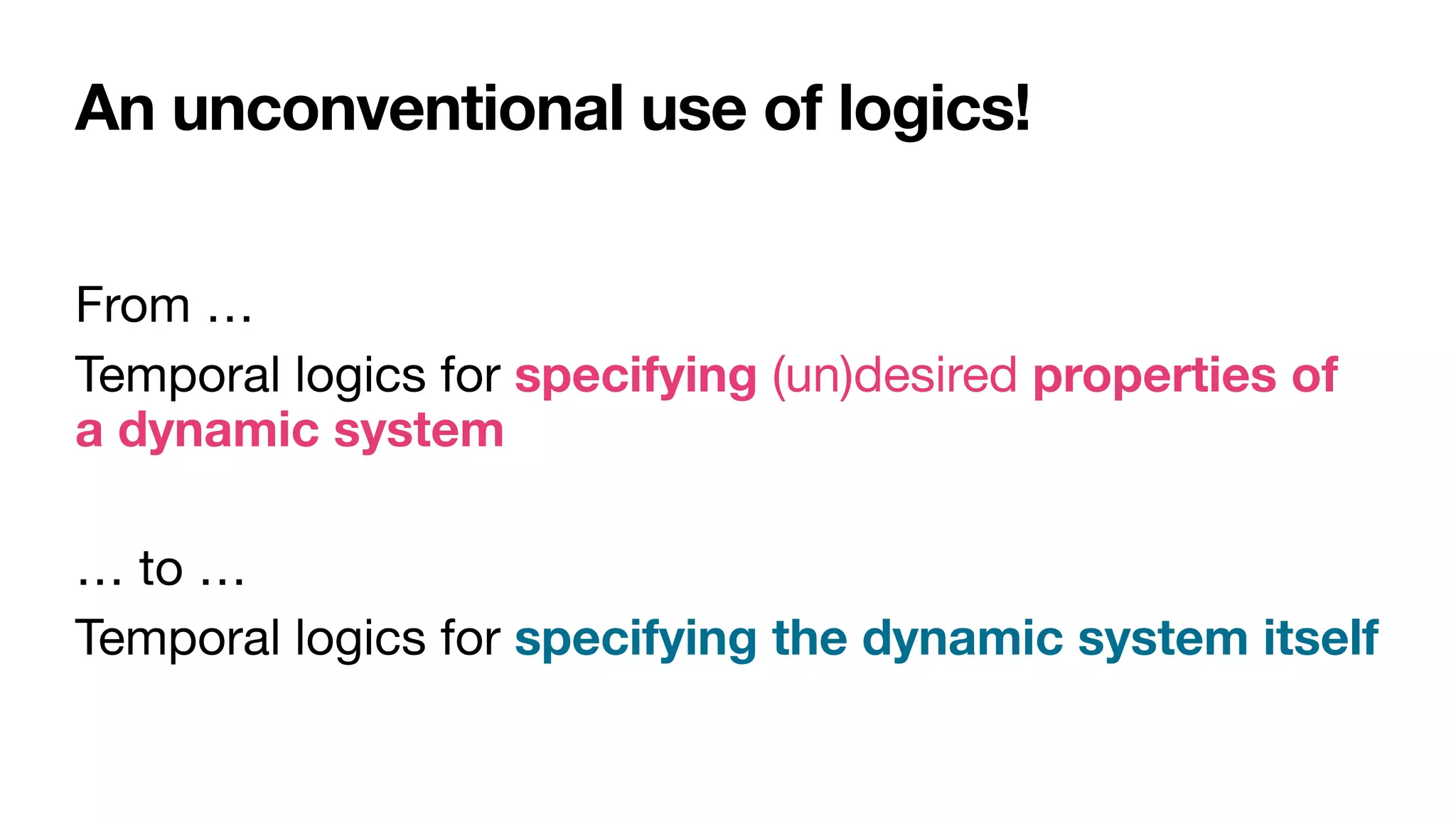


![LTLf: LTL over finite traces
[DeGiacomoVardi,IJCAI2013]
LTL interpreted over
fi
nite traces
' ::= A | ¬' | '1 ^ '2 | ' | '1U'2
No successor!
Same syntax of LTL
In LTL, there is always a next moment… in LTLf, the contrary!
φ always holds from current to the last instant
The next step exists and at next step φ holds
(weak next) If the next step exists, then at next step φ holds
last instant in the trace
' | '1 ^ '2 | ' | '1U'2
⇤'
Last ⌘ ¬ true
' ⌘ ¬ ¬'](https://image.slidesharecdn.com/ai4bpm-framing-montali-220914143006-e7edf68e/75/Constraints-for-Process-Framing-in-Augmented-BPM-76-2048.jpg)
![Look the same, but they are not the same
Many researchers: misled by moving from in
fi
nite to
fi
nite traces
In [____,AAAI14], we studied why!
• People typically focus on “patterns”, not on the entire logic
• Many of such patterns in BPM, reasoning about actions, planning, etc. are
“insensitive to in
fi
nity”](https://image.slidesharecdn.com/ai4bpm-framing-montali-220914143006-e7edf68e/75/Constraints-for-Process-Framing-in-Augmented-BPM-77-2048.jpg)
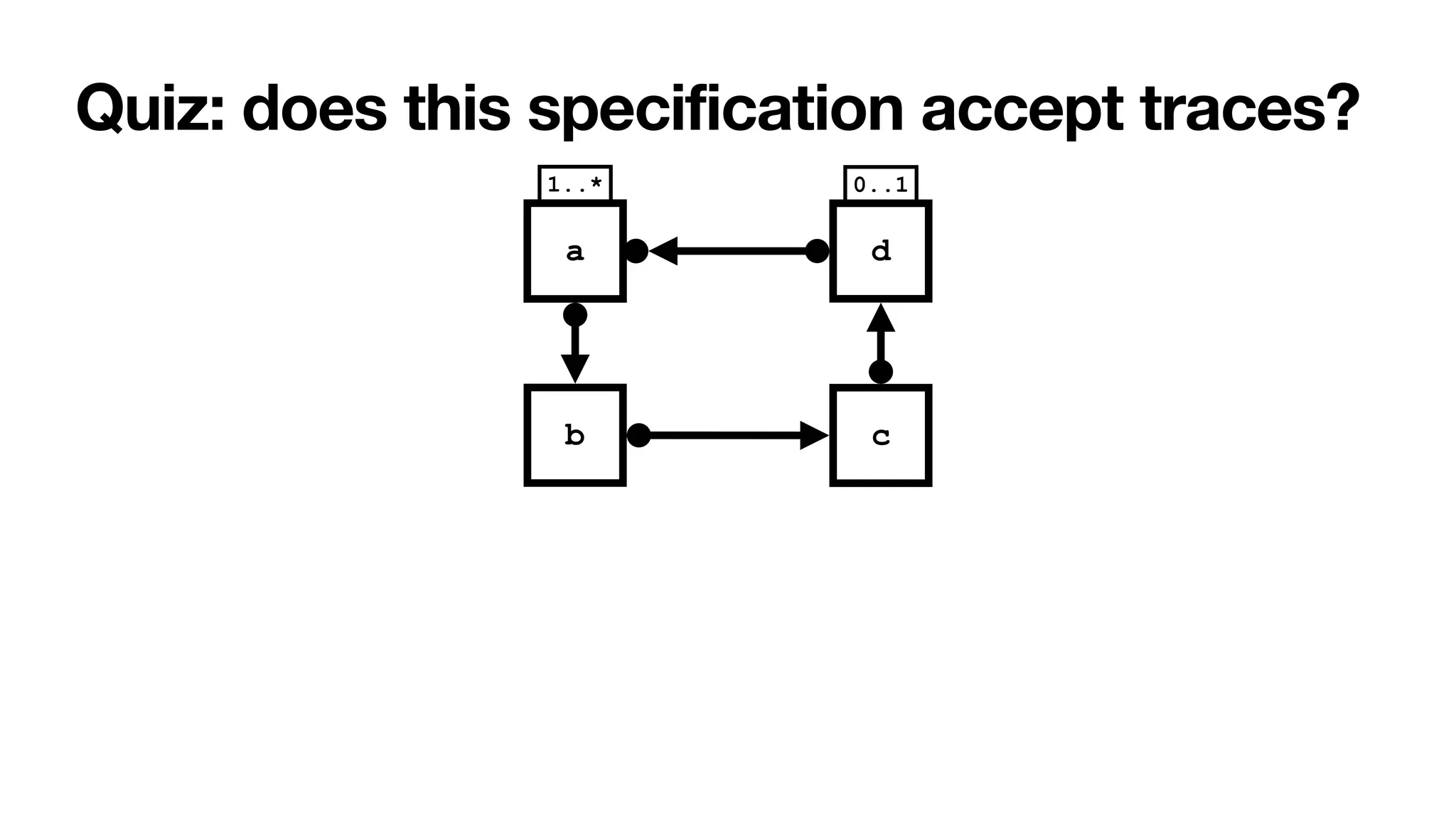
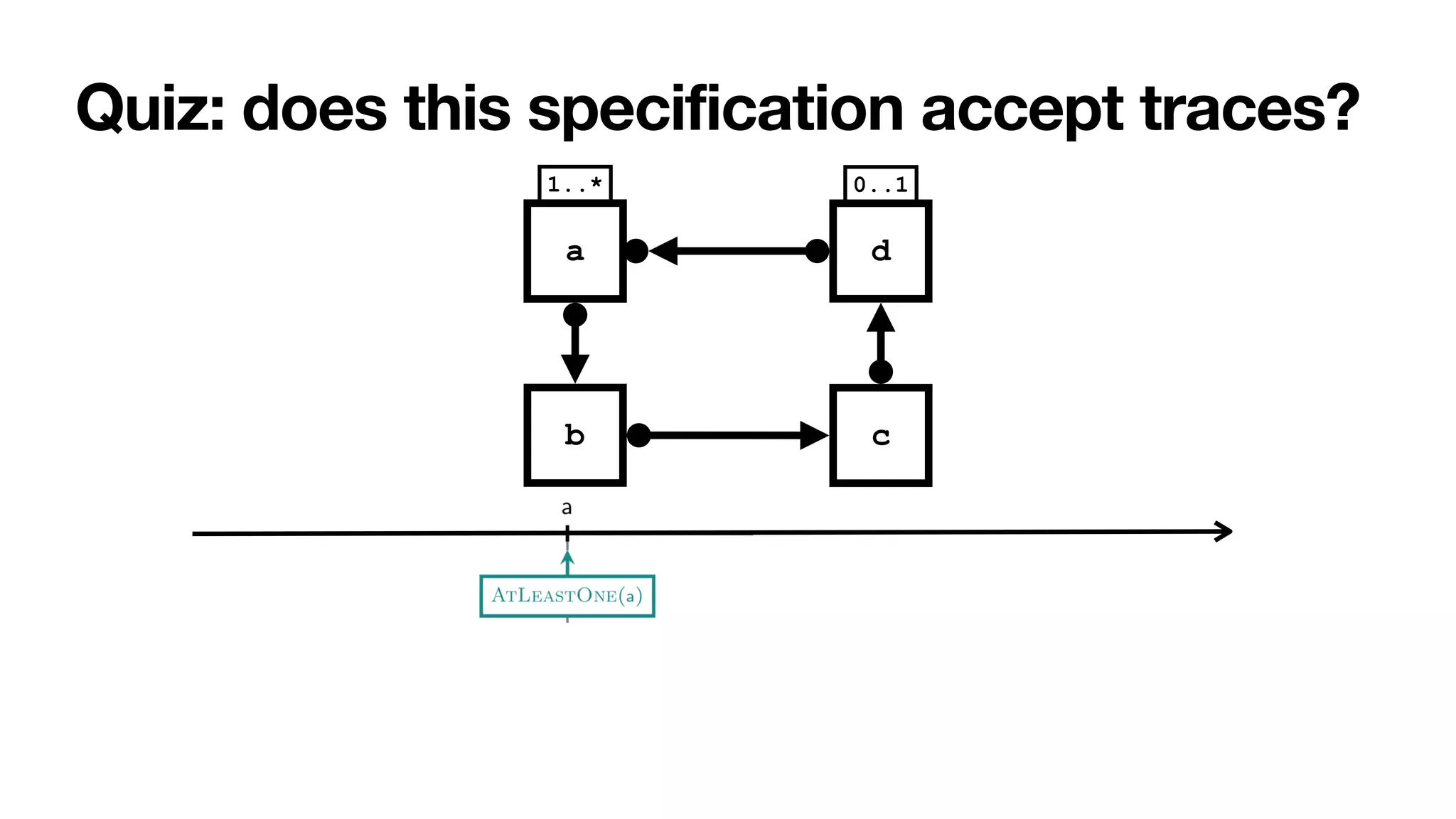


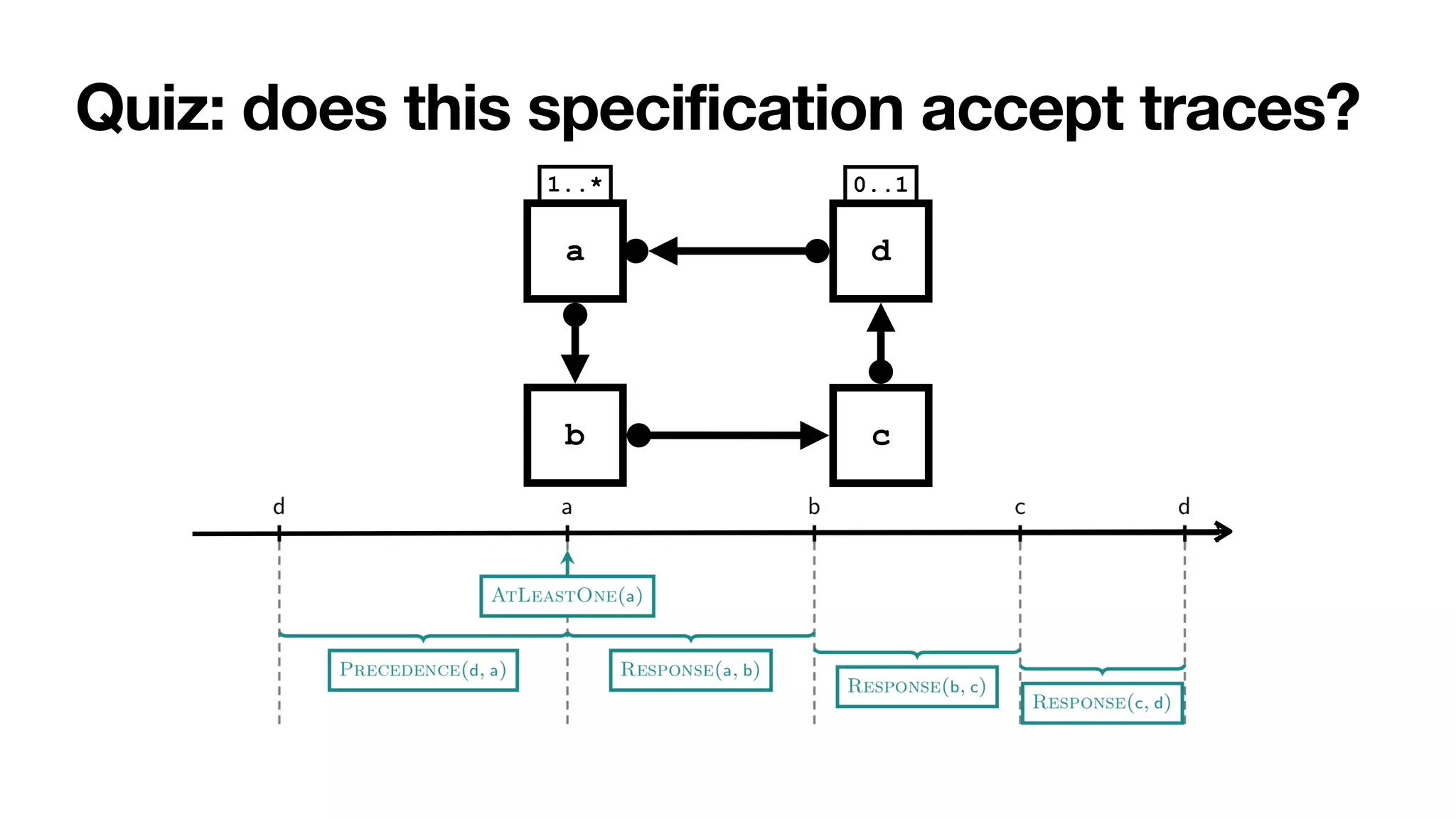
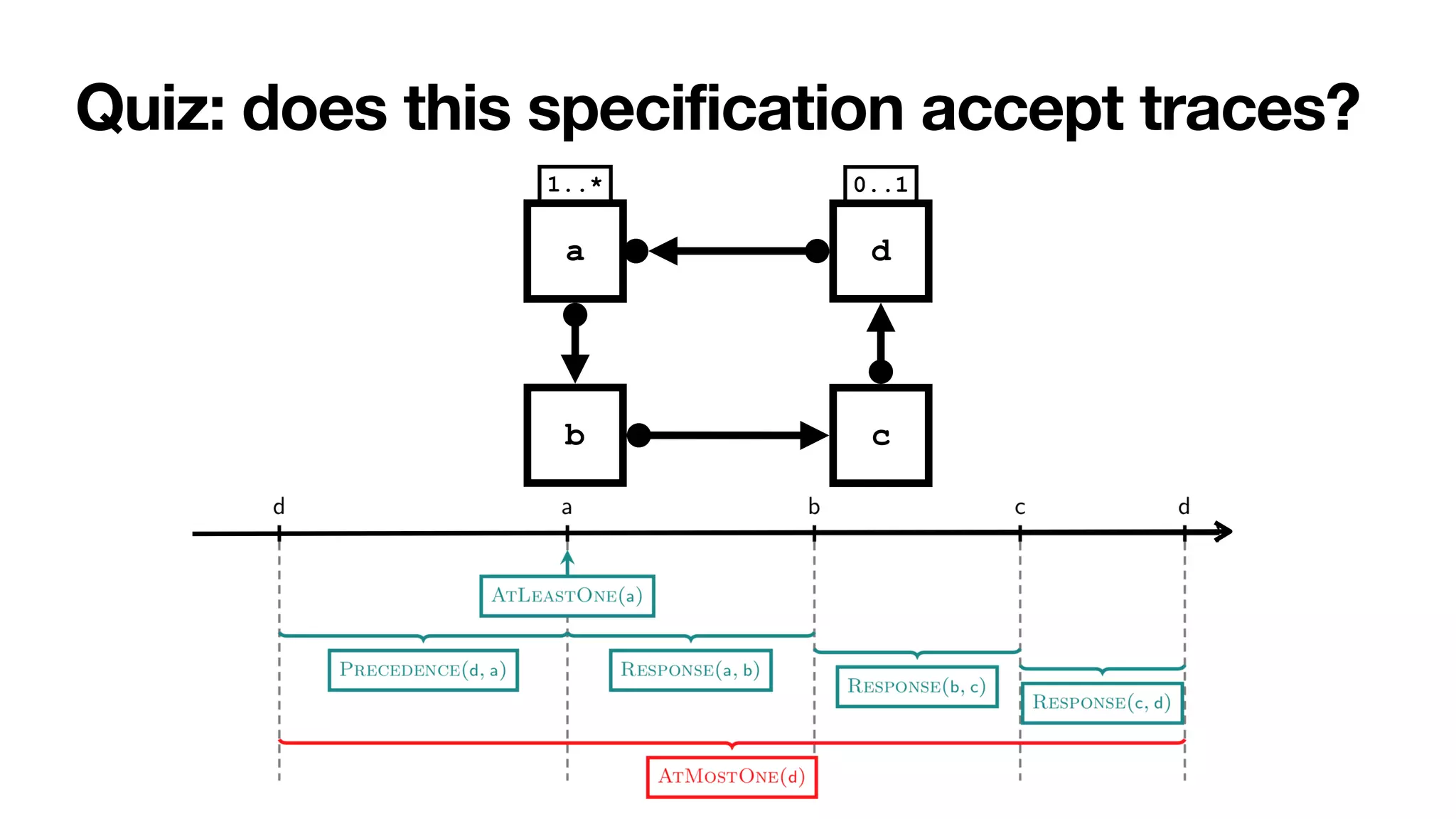
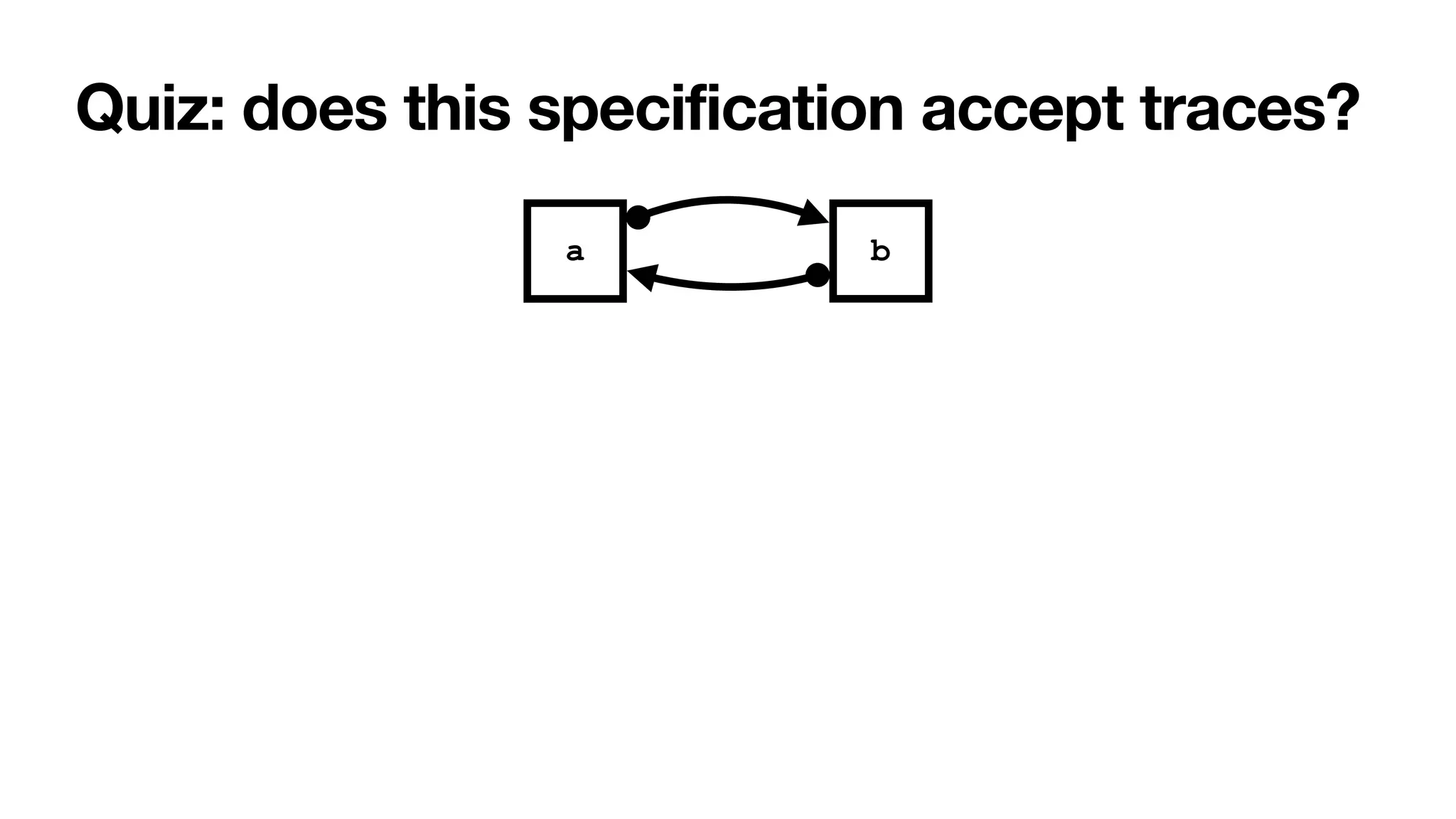
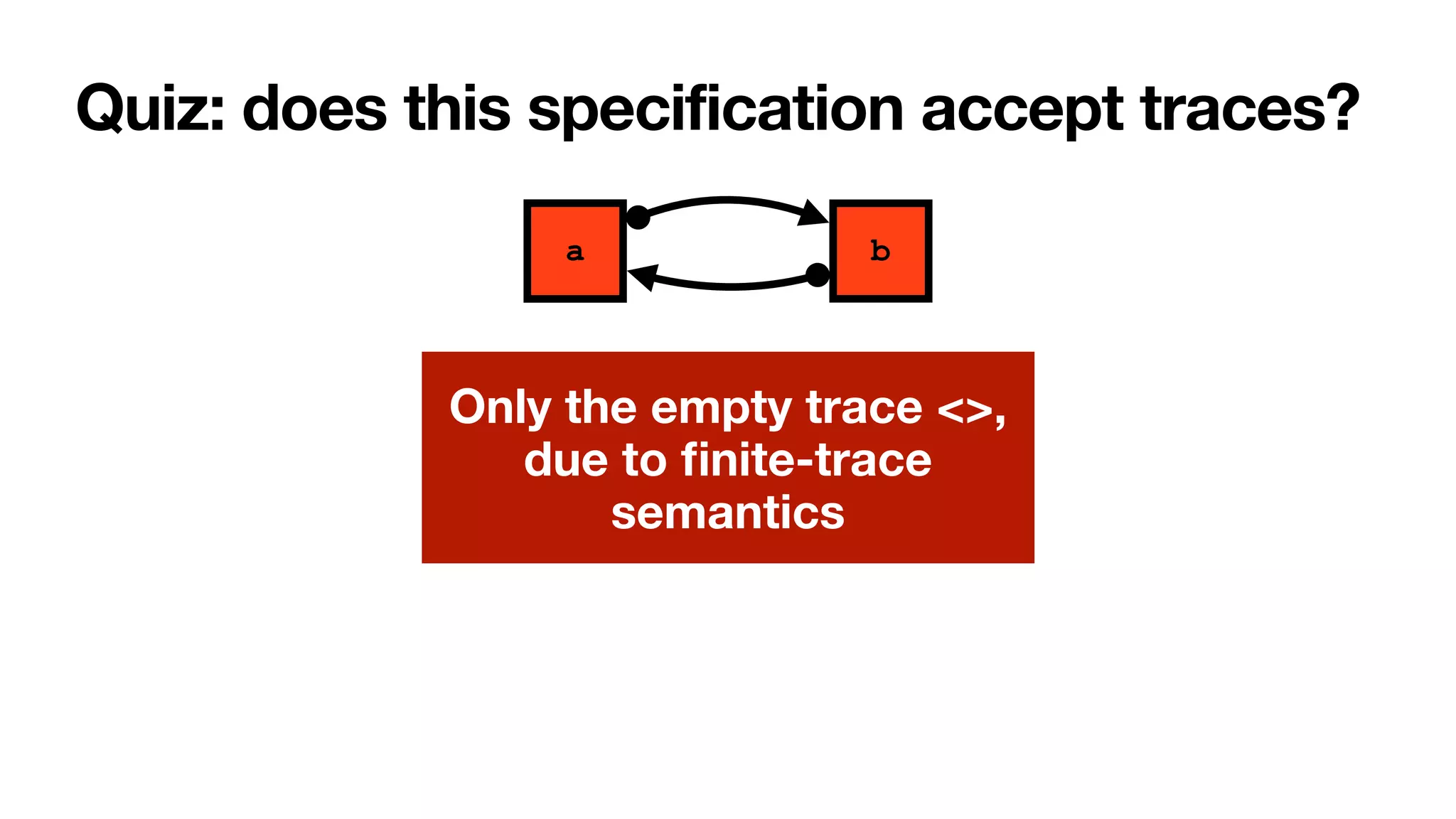
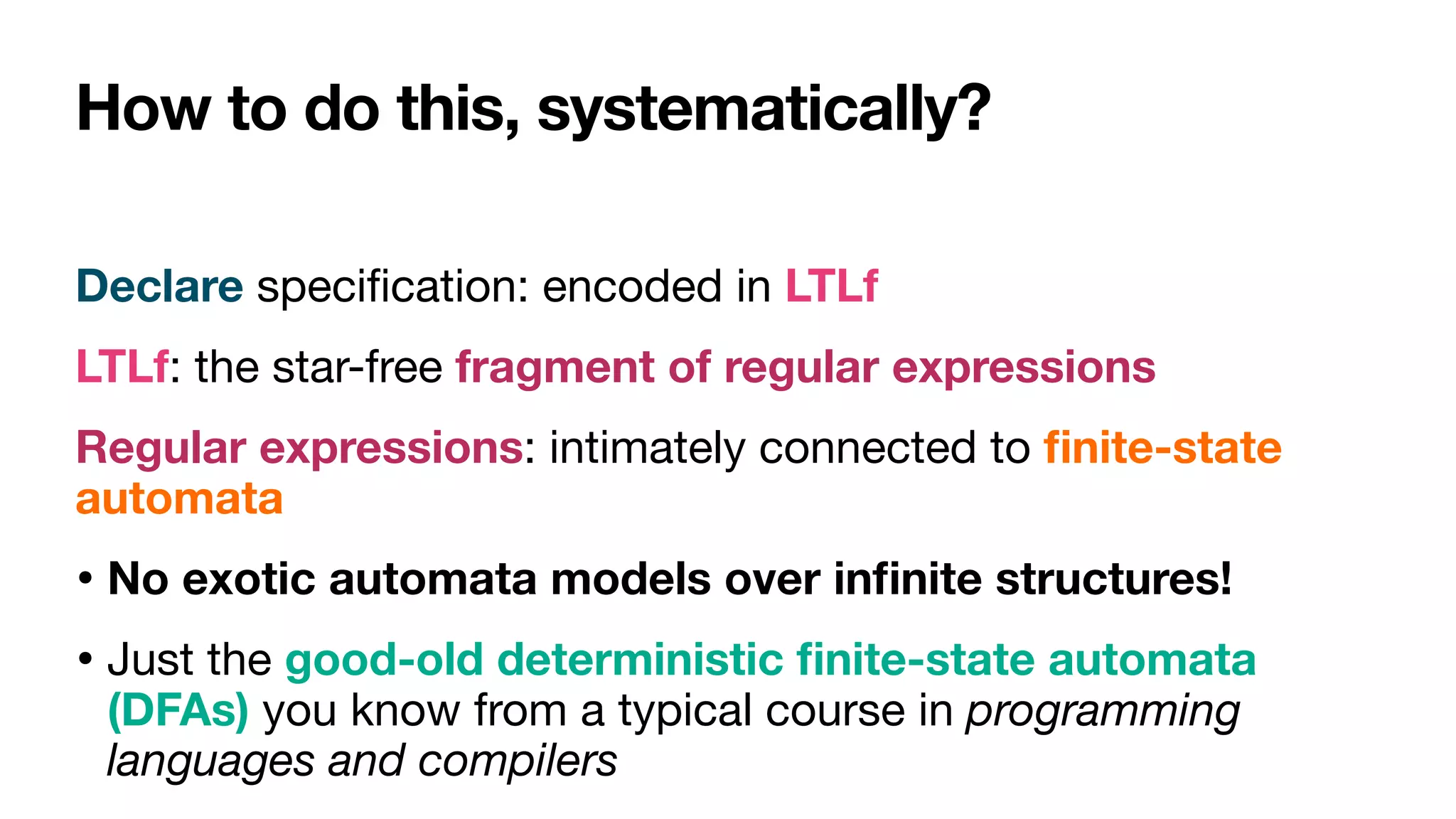
![From Declare to automata
LTLf NFA
nondeterministic
DFA
deterministic
LTLf2aut determin.
'
nt
lf formulas can be translated into equivalent nfa:
t |= Ï iff t œ L(AÏ)
/ldlf to nfa (exponential)
to dfa (exponential)
often nfa/dfa corresponding to ltlf /ldlf are in fact small!
ompile reasoning into automata based procedures!
Process engine!
[DeGiacomoVardi,IJCAI2013]
[____,TOSEM2022]](https://image.slidesharecdn.com/ai4bpm-framing-montali-220914143006-e7edf68e/75/Constraints-for-Process-Framing-in-Augmented-BPM-87-2048.jpg)
![Vision realised!
LTLf NFA
nondeterministic
DFA
deterministic
LTLf2aut determin.
'
nt
lf formulas can be translated into equivalent nfa:
t |= Ï iff t œ L(AÏ)
/ldlf to nfa (exponential)
to dfa (exponential)
often nfa/dfa corresponding to ltlf /ldlf are in fact small!
ompile reasoning into automata based procedures!
Process engine!
[DeGiacomoVardi,IJCAI2013]
[____,TOSEM2022]](https://image.slidesharecdn.com/ai4bpm-framing-montali-220914143006-e7edf68e/75/Constraints-for-Process-Framing-in-Augmented-BPM-88-2048.jpg)
![A full Declare model
[____,PMHandbook2022]](https://image.slidesharecdn.com/ai4bpm-framing-montali-220914143006-e7edf68e/75/Constraints-for-Process-Framing-in-Augmented-BPM-89-2048.jpg)
![A full Declare model
[____,PMHandbook2022]](https://image.slidesharecdn.com/ai4bpm-framing-montali-220914143006-e7edf68e/75/Constraints-for-Process-Framing-in-Augmented-BPM-90-2048.jpg)
![Few lines of code
[____,TOSEM2022] 0:8 G. De Giacomo et al.
(tt, ⇧) = true
(↵ , ⇧) = false
( , ⇧) = (h itt, ⇧) ( prop.)
('1 ^ '2, ⇧) = ('1, ⇧) ^ ('2, ⇧)
('1 _ '2, ⇧) = ('1, ⇧) _ ('2, ⇧)
(h i', ⇧) =
⇢
E (') if ⇧ |= ( prop.)
false if ⇧ 6|=
(h ?i', ⇧) = ( , ⇧) ^ (', ⇧)
(h⇢1 + ⇢2i', ⇧) = (h⇢1i', ⇧) _ (h⇢2i', ⇧)
(h⇢1; ⇢2i', ⇧) = (h⇢1ih⇢2i', ⇧)
(h⇢⇤
i', ⇧) = (', ⇧) _ (h⇢iF h⇢⇤i', ⇧)
([ ]', ⇧) =
⇢
E (') if ⇧ |= ( prop.)
true if ⇧ 6|=
([ ?]', ⇧) = (nnf (¬ ), ⇧) _ (', ⇧)
([⇢1 + ⇢2]', ⇧) = ([⇢1]', ⇧) ^ ([⇢2]', ⇧)
([⇢1; ⇢2]', ⇧) = ([⇢1][⇢2]', ⇧)
([⇢⇤
]', ⇧) = (', ⇧) ^ ([⇢]T [⇢⇤]', ⇧)
(F , ⇧) = false
(T , ⇧) = true
Fig. 1: Definition of , where E (') recursively replaces in ' all occurrences of atoms of
the form T and F by .
1: algorithm LDLf 2NFA
2: input LDLf formula '
3: output NFA A(') = (2P
, S, s0, %, Sf )
4: s0 {'} . set the initial state
5: Sf {;} . set final states
6: if ( (', ✏) = true) then . check if initial state is also final
7: Sf Sf [ {s0}
8: S {s0, ;}, % ;
9: while (S or % change) do
10: for (s 2 S) do
11: if (s0
|=
V
( 2s) ( , ⇧) then . add new state and transition
12: S S [ {s0
}
13: % % [ {(s, ⇧, s0
)}
14: if (
V
( 2s0) ( , ✏) = true) then . check if new state is also final
15: Sf Sf [ {s0
}
Fig. 2: NFA construction.
' NFA](https://image.slidesharecdn.com/ai4bpm-framing-montali-220914143006-e7edf68e/75/Constraints-for-Process-Framing-in-Augmented-BPM-91-2048.jpg)
![Few lines of code
[____,TOSEM2022] 0:8 G. De Giacomo et al.
(tt, ⇧) = true
(↵ , ⇧) = false
( , ⇧) = (h itt, ⇧) ( prop.)
('1 ^ '2, ⇧) = ('1, ⇧) ^ ('2, ⇧)
('1 _ '2, ⇧) = ('1, ⇧) _ ('2, ⇧)
(h i', ⇧) =
⇢
E (') if ⇧ |= ( prop.)
false if ⇧ 6|=
(h ?i', ⇧) = ( , ⇧) ^ (', ⇧)
(h⇢1 + ⇢2i', ⇧) = (h⇢1i', ⇧) _ (h⇢2i', ⇧)
(h⇢1; ⇢2i', ⇧) = (h⇢1ih⇢2i', ⇧)
(h⇢⇤
i', ⇧) = (', ⇧) _ (h⇢iF h⇢⇤i', ⇧)
([ ]', ⇧) =
⇢
E (') if ⇧ |= ( prop.)
true if ⇧ 6|=
([ ?]', ⇧) = (nnf (¬ ), ⇧) _ (', ⇧)
([⇢1 + ⇢2]', ⇧) = ([⇢1]', ⇧) ^ ([⇢2]', ⇧)
([⇢1; ⇢2]', ⇧) = ([⇢1][⇢2]', ⇧)
([⇢⇤
]', ⇧) = (', ⇧) ^ ([⇢]T [⇢⇤]', ⇧)
(F , ⇧) = false
(T , ⇧) = true
Fig. 1: Definition of , where E (') recursively replaces in ' all occurrences of atoms of
the form T and F by .
1: algorithm LDLf 2NFA
2: input LDLf formula '
3: output NFA A(') = (2P
, S, s0, %, Sf )
4: s0 {'} . set the initial state
5: Sf {;} . set final states
6: if ( (', ✏) = true) then . check if initial state is also final
7: Sf Sf [ {s0}
8: S {s0, ;}, % ;
9: while (S or % change) do
10: for (s 2 S) do
11: if (s0
|=
V
( 2s) ( , ⇧) then . add new state and transition
12: S S [ {s0
}
13: % % [ {(s, ⇧, s0
)}
14: if (
V
( 2s0) ( , ✏) = true) then . check if new state is also final
15: Sf Sf [ {s0
}
Fig. 2: NFA construction.
' NFA
Automata manipulations
much easier to handle
than in the in
fi
nite case,
with huge performance
improvements
[ZhuEtAl,IJCAI17]
[Westergaard,BPM11]](https://image.slidesharecdn.com/ai4bpm-framing-montali-220914143006-e7edf68e/75/Constraints-for-Process-Framing-in-Augmented-BPM-92-2048.jpg)
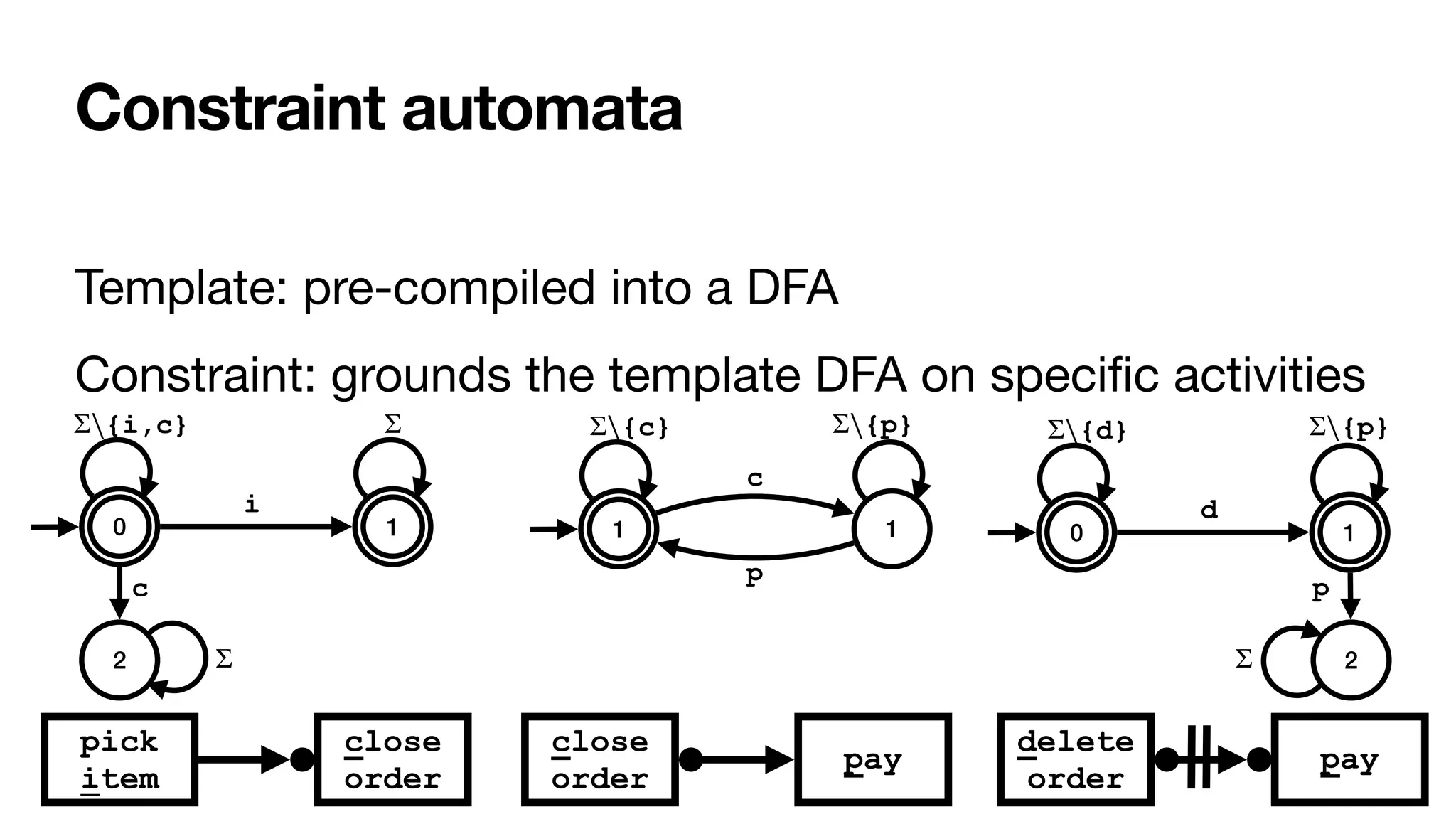
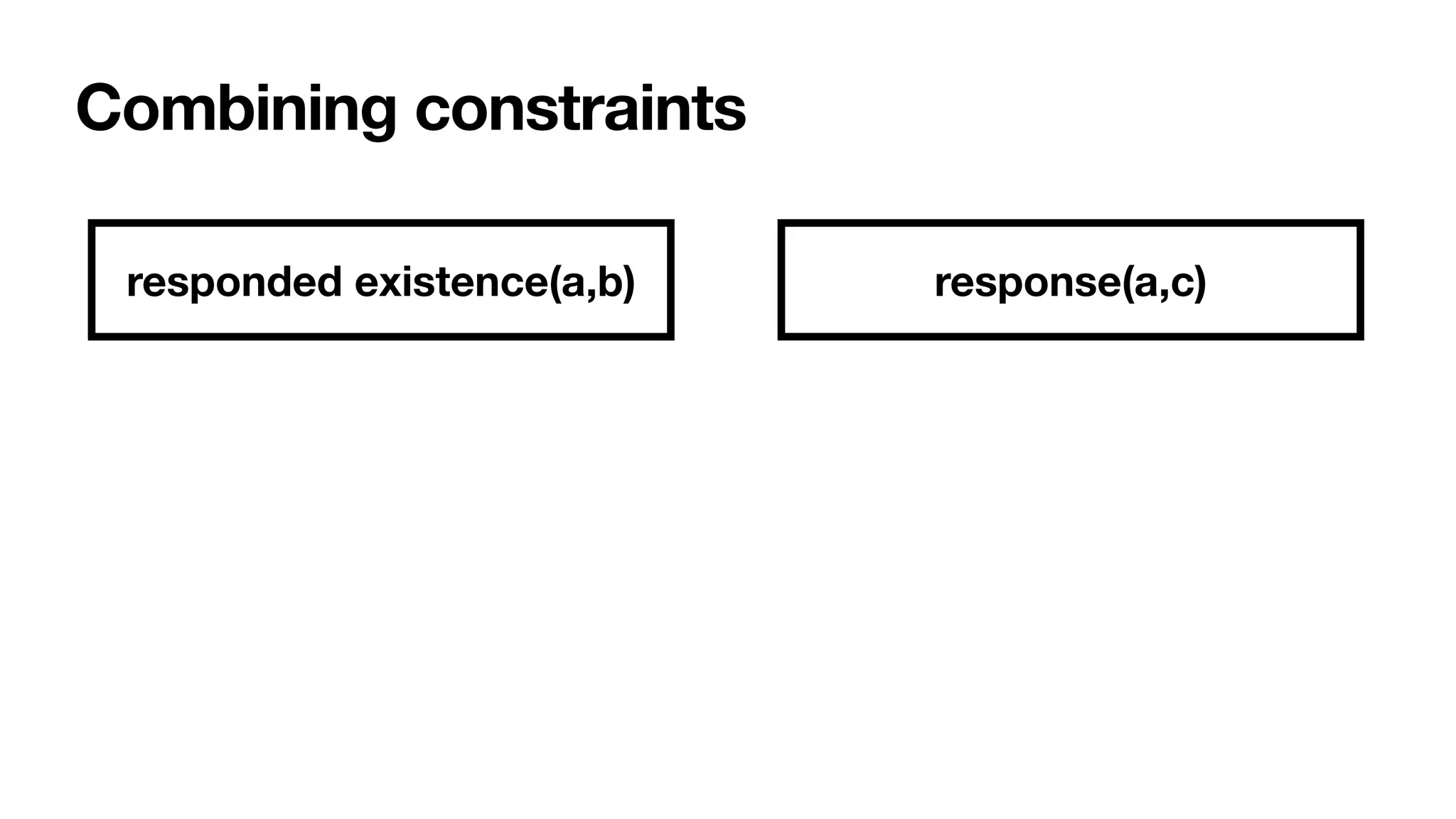
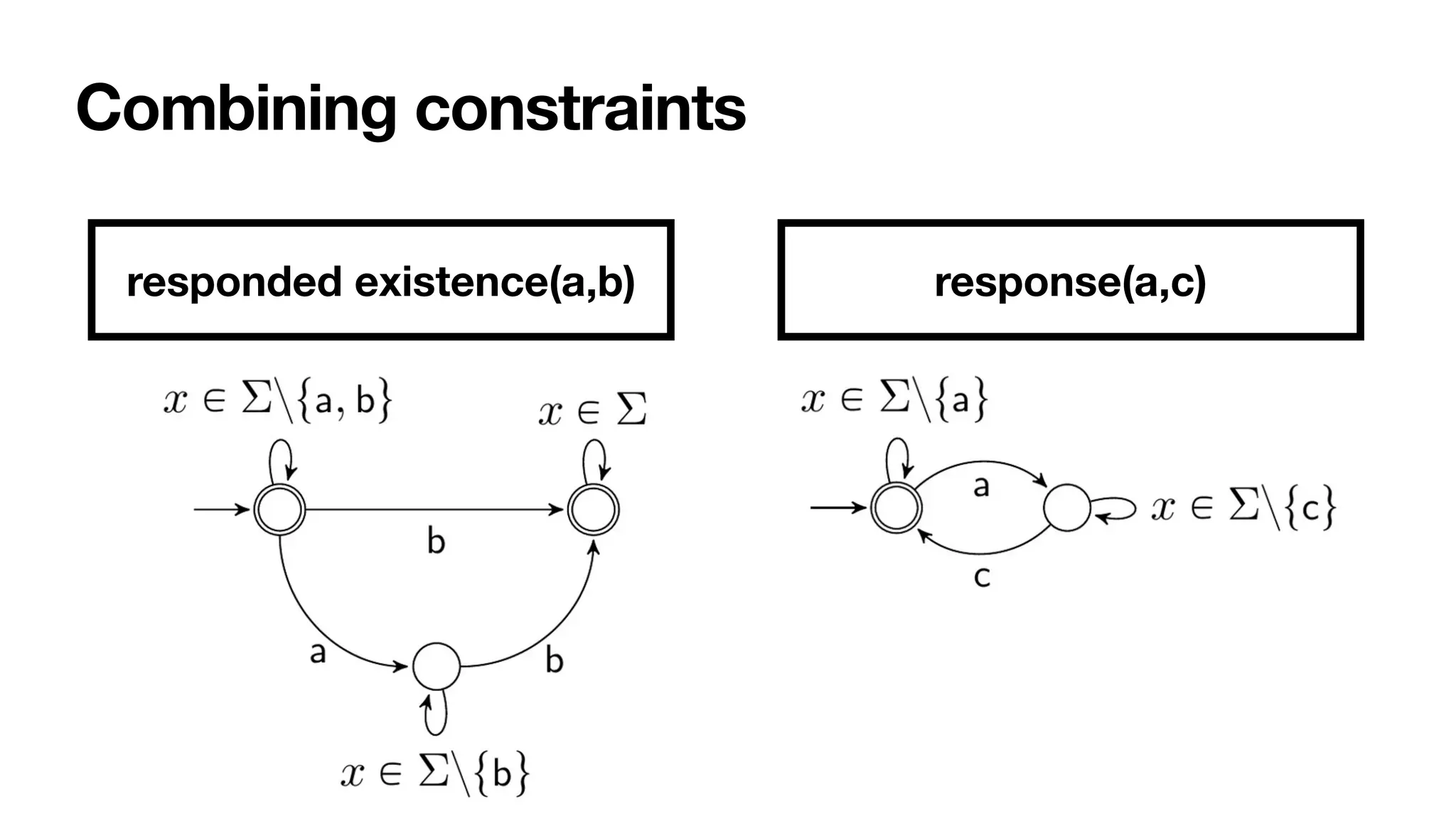
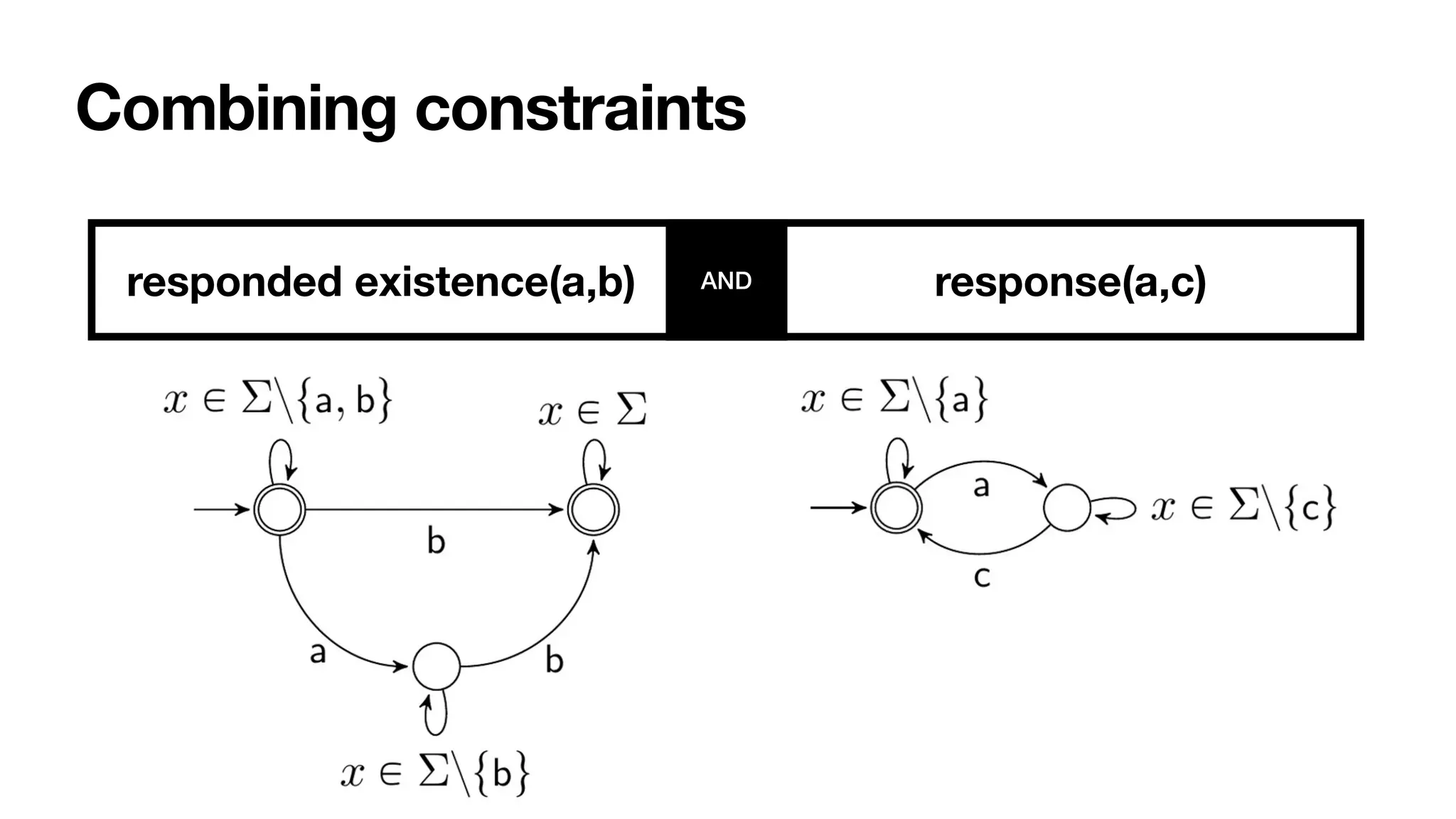
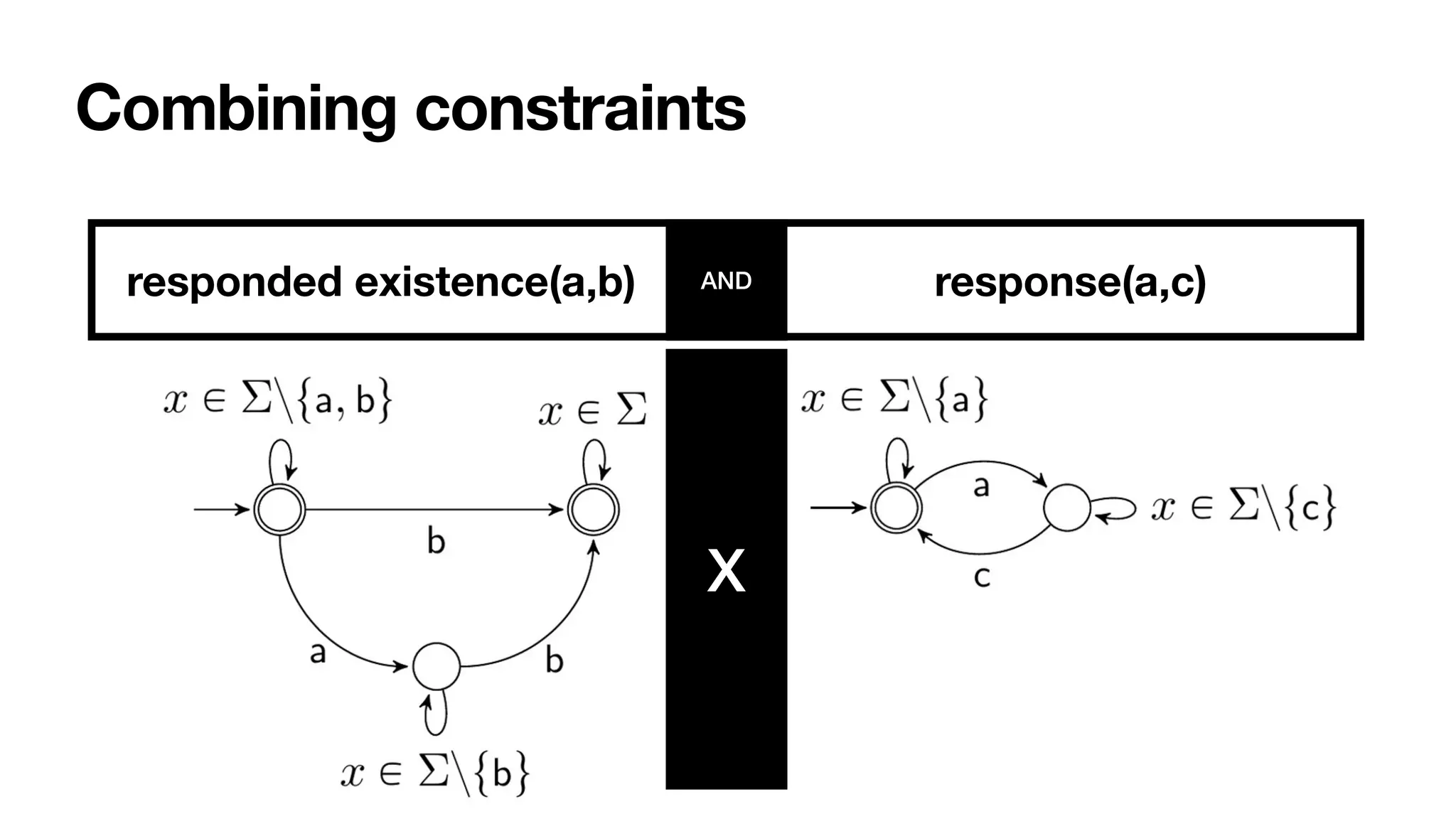
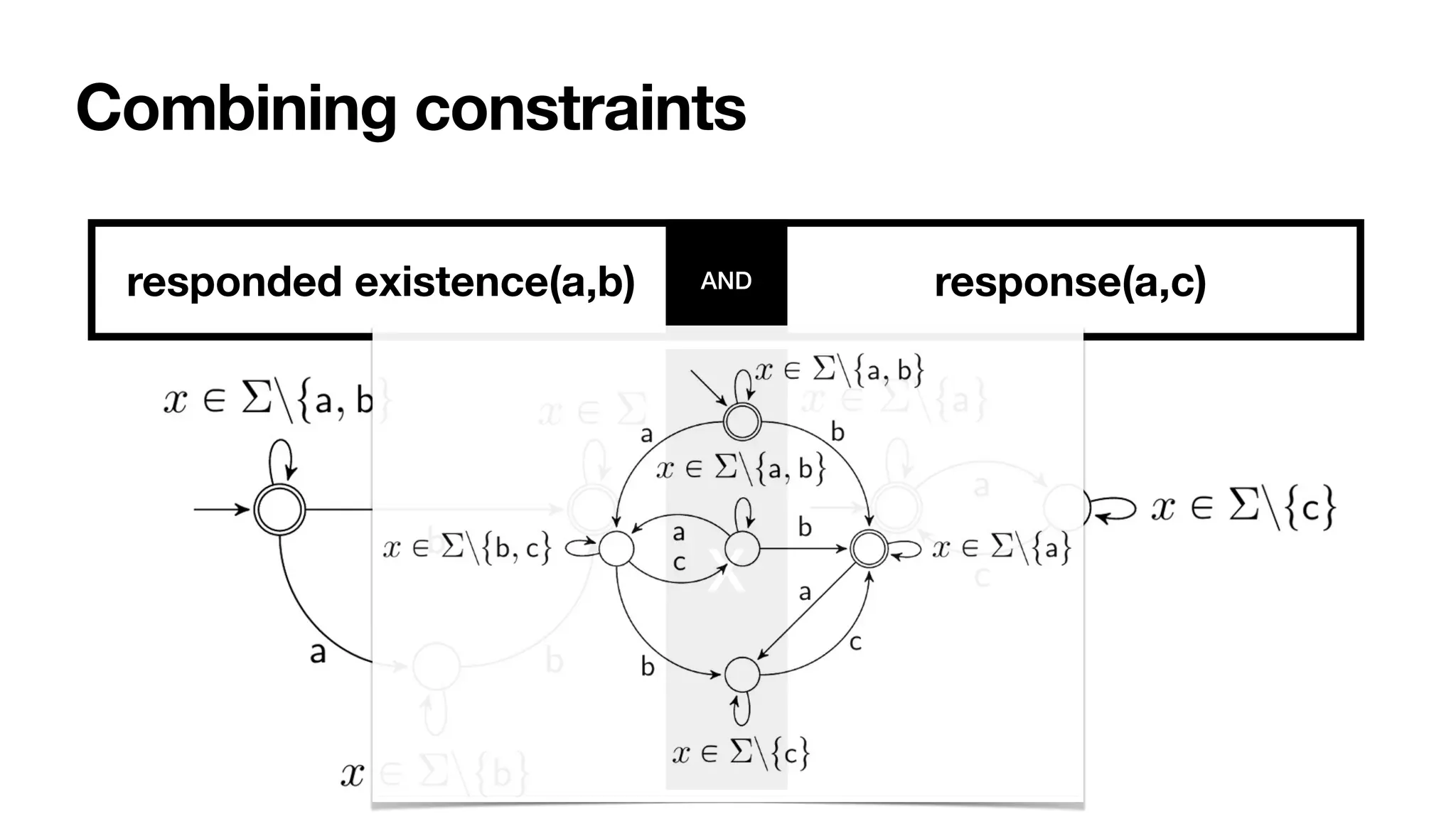
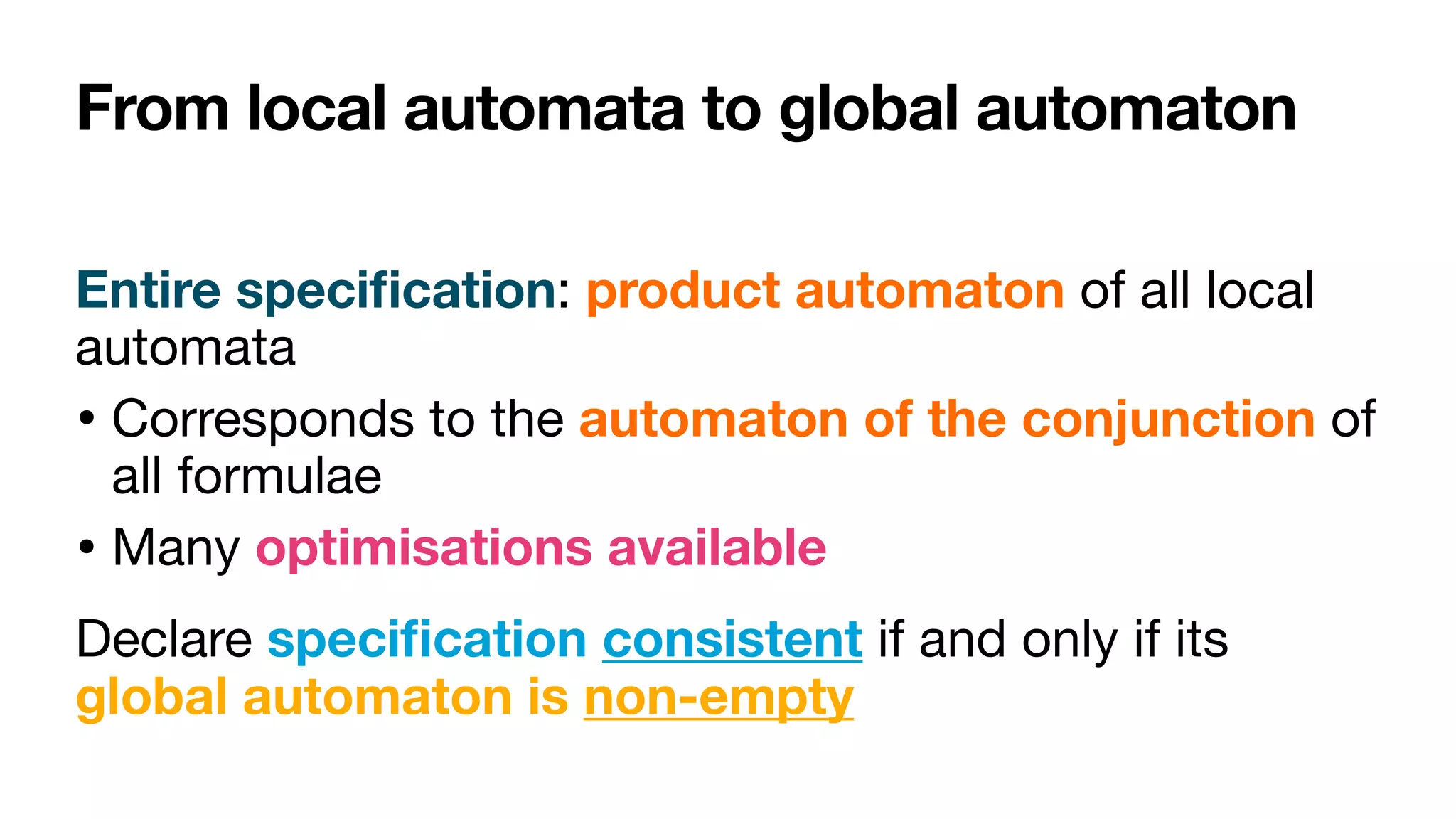
![Constraints: hard or soft?
Logically: hard
Conceptually: not so clear
• Model level: mix of constraints of di
ff
erent nature
• Physical, best practices, policies, legal, … [AdamoEtAl,InfSys2021]
• Hard at the IS level <-> hard or soft in reality
• Manual task vs user-interaction task
• Ontological reversal [BaskervilleEtAl,MISQ2020]](https://image.slidesharecdn.com/ai4bpm-framing-montali-220914143006-e7edf68e/75/Constraints-for-Process-Framing-in-Augmented-BPM-100-2048.jpg)
![Constraints: hard or soft?
Logically: hard
Conceptually: not so clear
• Model level: mix of constraints of di
ff
erent nature
• Physical, best practices, policies, legal, … [AdamoEtAl,InfSys2021]
• Hard at the IS level <-> hard or soft in reality
• Manual task vs user-interaction task
• Ontological reversal [BaskervilleEtAl,MISQ2020]
ABPMS needs to to account for deviations, at runtime](https://image.slidesharecdn.com/ai4bpm-framing-montali-220914143006-e7edf68e/75/Constraints-for-Process-Framing-in-Augmented-BPM-101-2048.jpg)
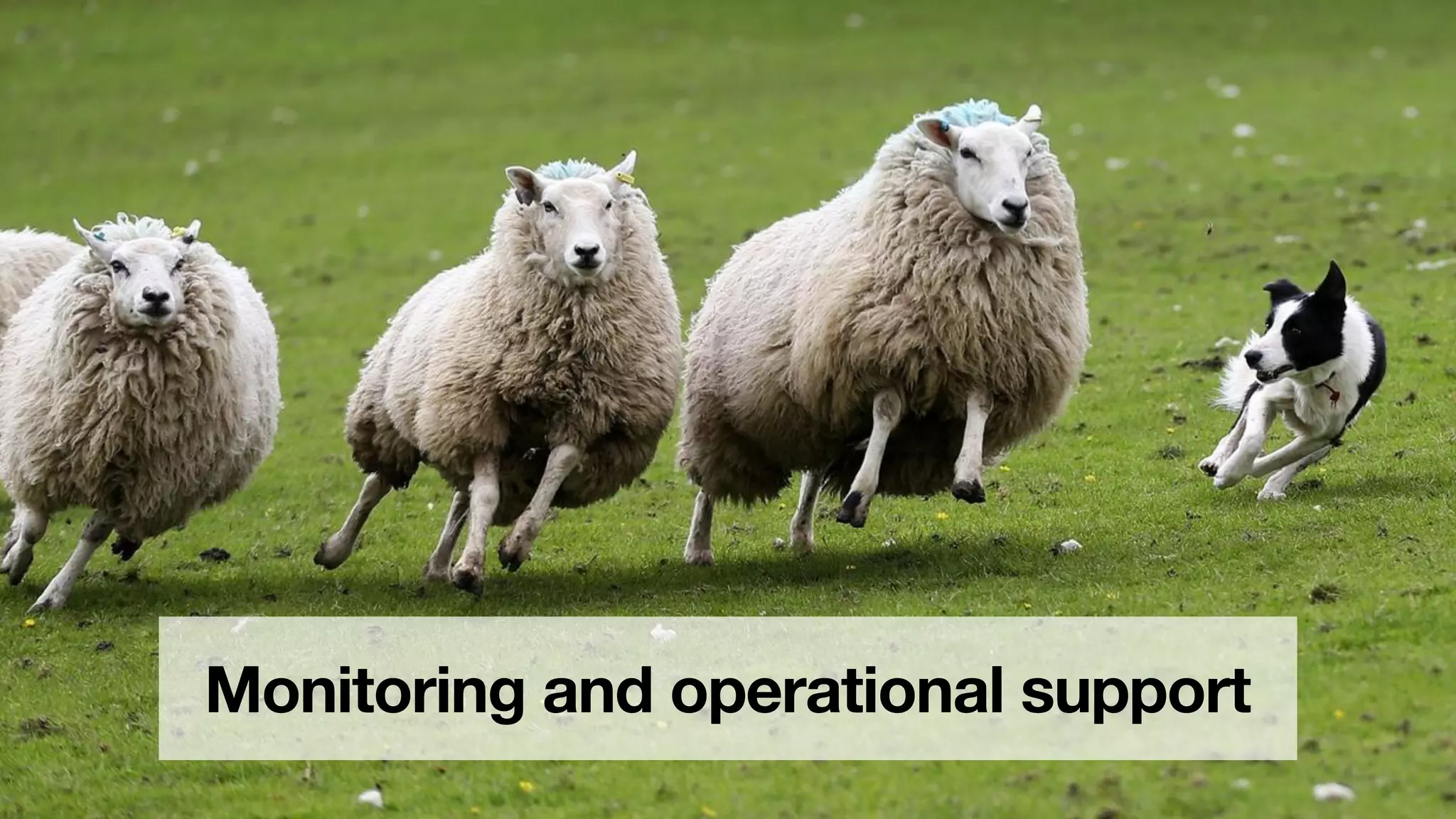
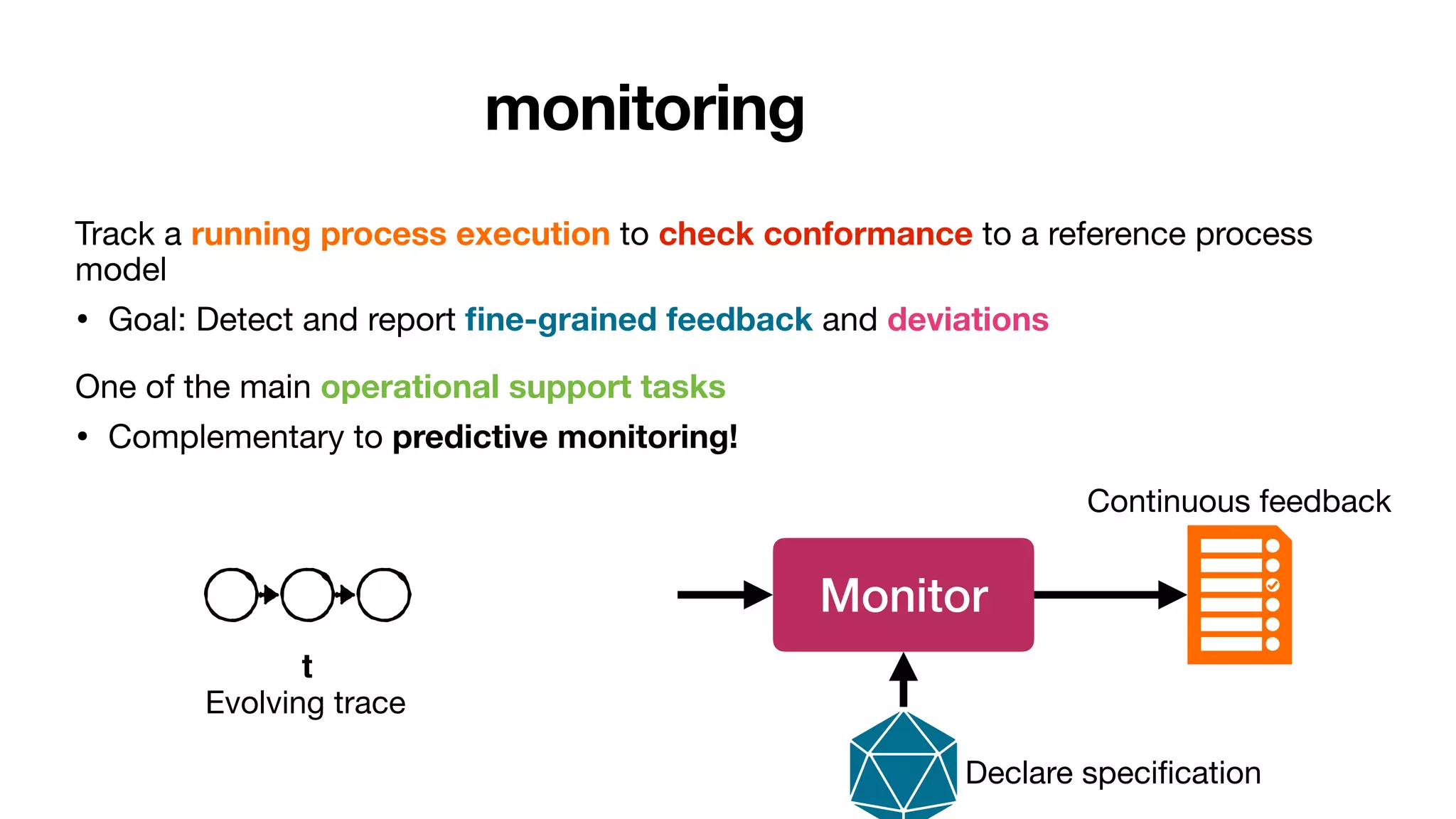
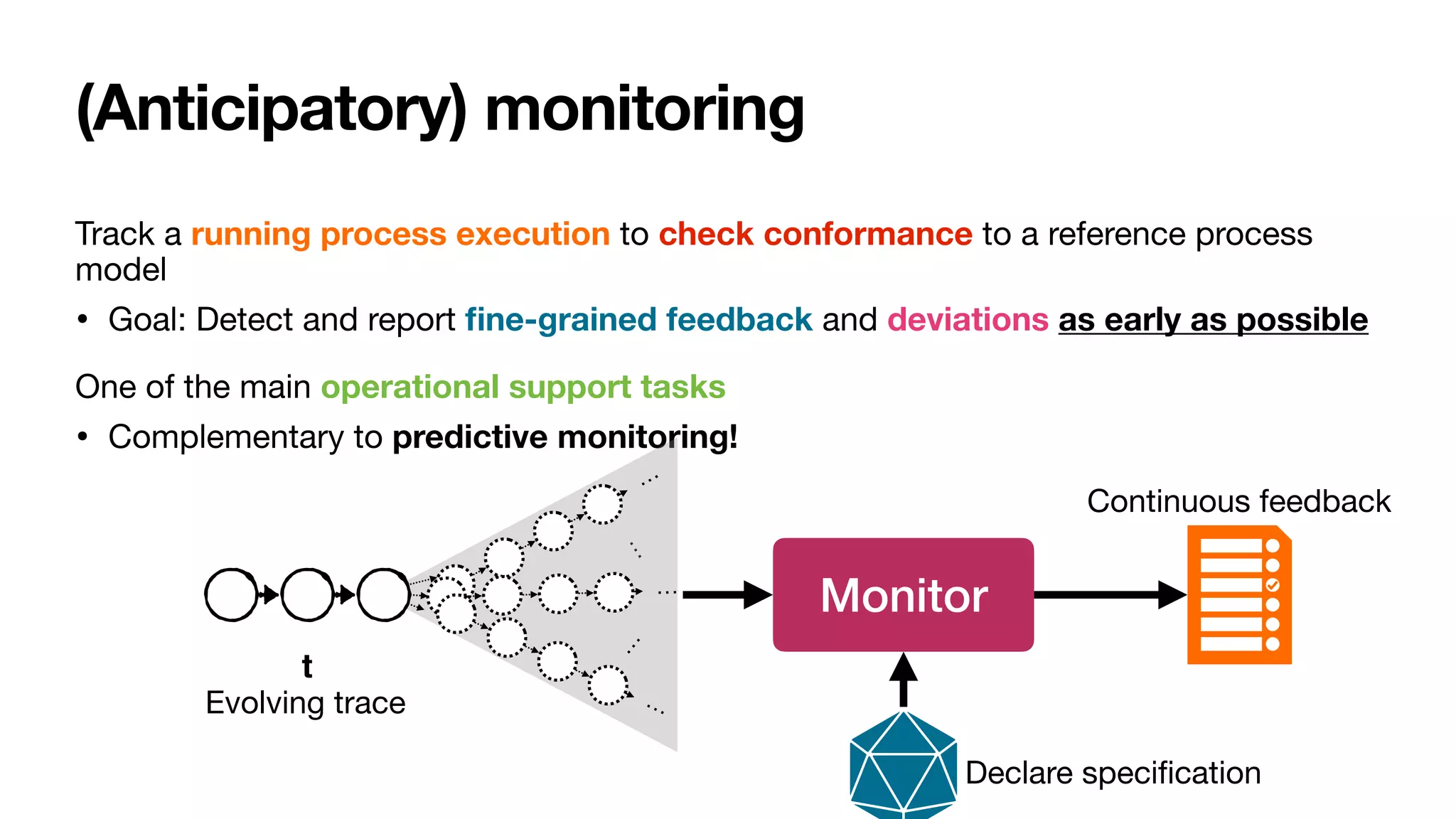
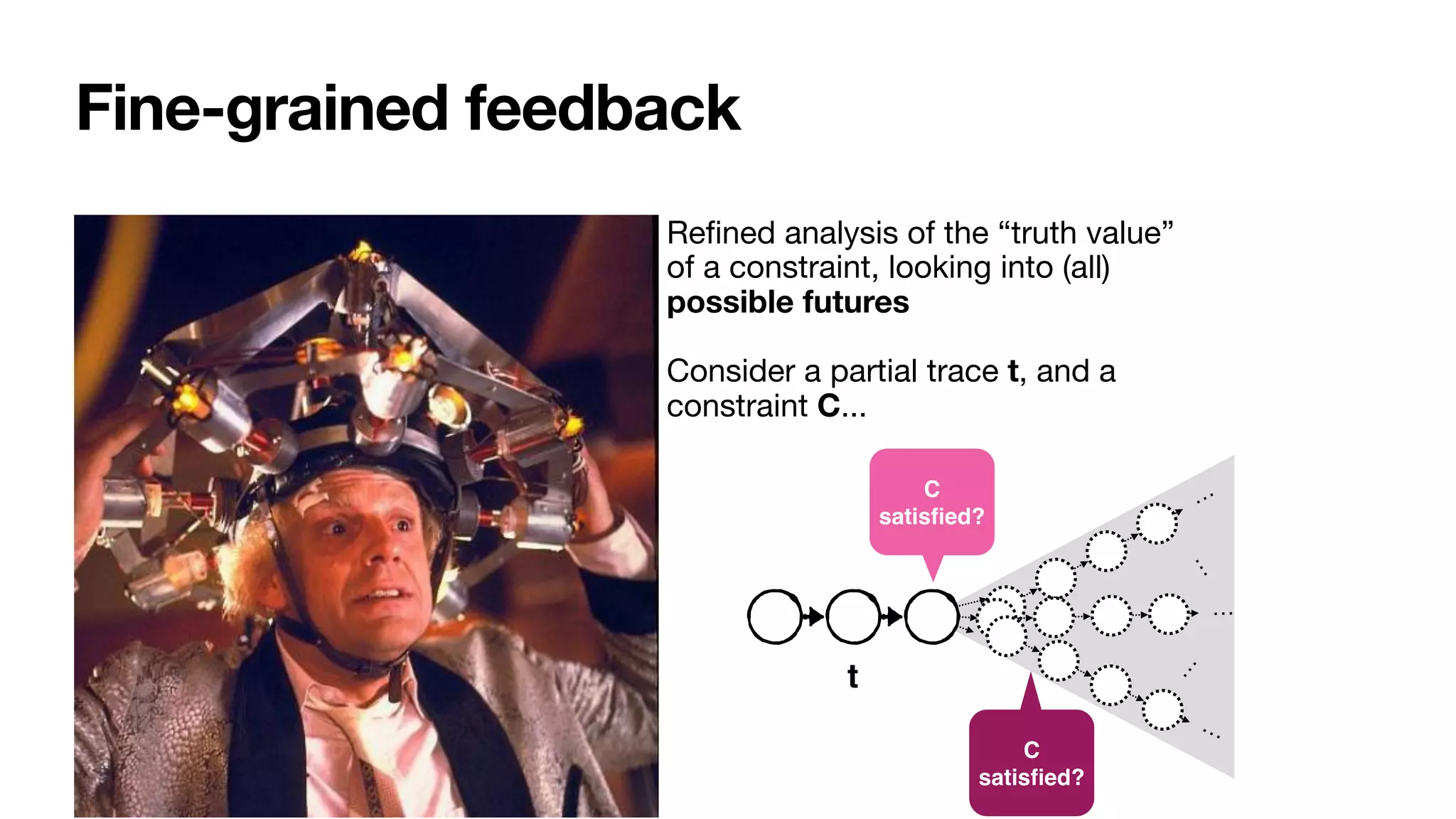
![RV-LTL truth values
[BauerEtAl,InfCom2010]
C is permanently satis
fi
ed if t
satis
fi
es C and no matter how t is
extended, C will stay satis
fi
ed
C is currently satis
fi
ed if t satis
fi
es C
but there is a continuation of t that
violates C
…
…
t
…
…
…
t](https://image.slidesharecdn.com/ai4bpm-framing-montali-220914143006-e7edf68e/75/Constraints-for-Process-Framing-in-Augmented-BPM-106-2048.jpg)
![RV-LTL truth values
C is currently violated if t violates C
but there is a continuation that leads
to satisfy C
C is permanently violated if t violates
C and no matter how t is extended, C
will stay violated
t
…
…
…
…
…
[BauerEtAl,InfCom2010]](https://image.slidesharecdn.com/ai4bpm-framing-montali-220914143006-e7edf68e/75/Constraints-for-Process-Framing-in-Augmented-BPM-107-2048.jpg)
![RV-LTL on finite traces
[____,BPM2011] [____,BPM2014] [____,TOSEM2022]
close
order
delete
order
pay
pick
item
close
order
pay
0 1
2
i
Σ
{i,c}
Σ∖ Σ
c
1
1
{c}
Σ∖
c
{p}
Σ∖
p
0 1
2
p
Σ
{d}
Σ∖
d
{p}
Σ∖
Su
ffi
xes of the current trace: each with unbounded,
fi
nite length
• Again standard DFAs -> all formulae of LTLf are monitorable
Each state of the DFA: colored with an RV-LTL value via simple reachability checks](https://image.slidesharecdn.com/ai4bpm-framing-montali-220914143006-e7edf68e/75/Constraints-for-Process-Framing-in-Augmented-BPM-108-2048.jpg)
![RV-LTL on finite traces
[____,BPM2011] [____,BPM2014] [____,TOSEM2022]
Su
ffi
xes of the current trace: each with unbounded,
fi
nite length
• Again standard DFAs -> all formulae of LTLf are monitorable
Each state of the DFA: colored with an RV-LTL value via simple reachability checks
Σ
Σ
Σ
0
[cs]
1
[ps]
2
[pv]
1
[cv]
0
[cs]
0
[cs]
1
[cs]
2
[pv]
c
{i,c}
Σ∖
i
{c}
Σ∖
c
{p}
Σ∖
p
p
{d}
Σ∖
d
{p}
Σ∖
close
order
delete
order
pay
pick
item
close
order
pay](https://image.slidesharecdn.com/ai4bpm-framing-montali-220914143006-e7edf68e/75/Constraints-for-Process-Framing-in-Augmented-BPM-109-2048.jpg)
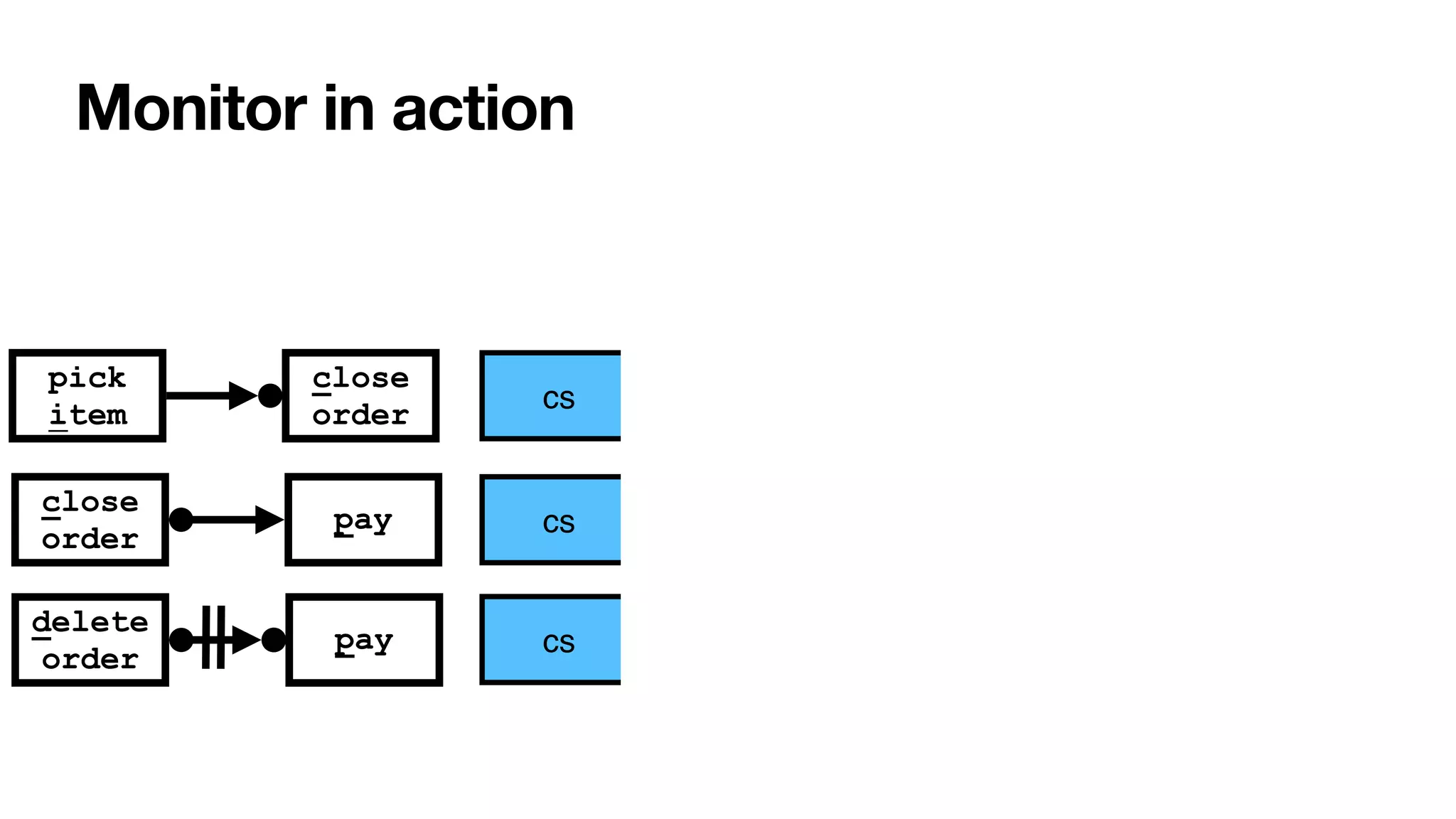
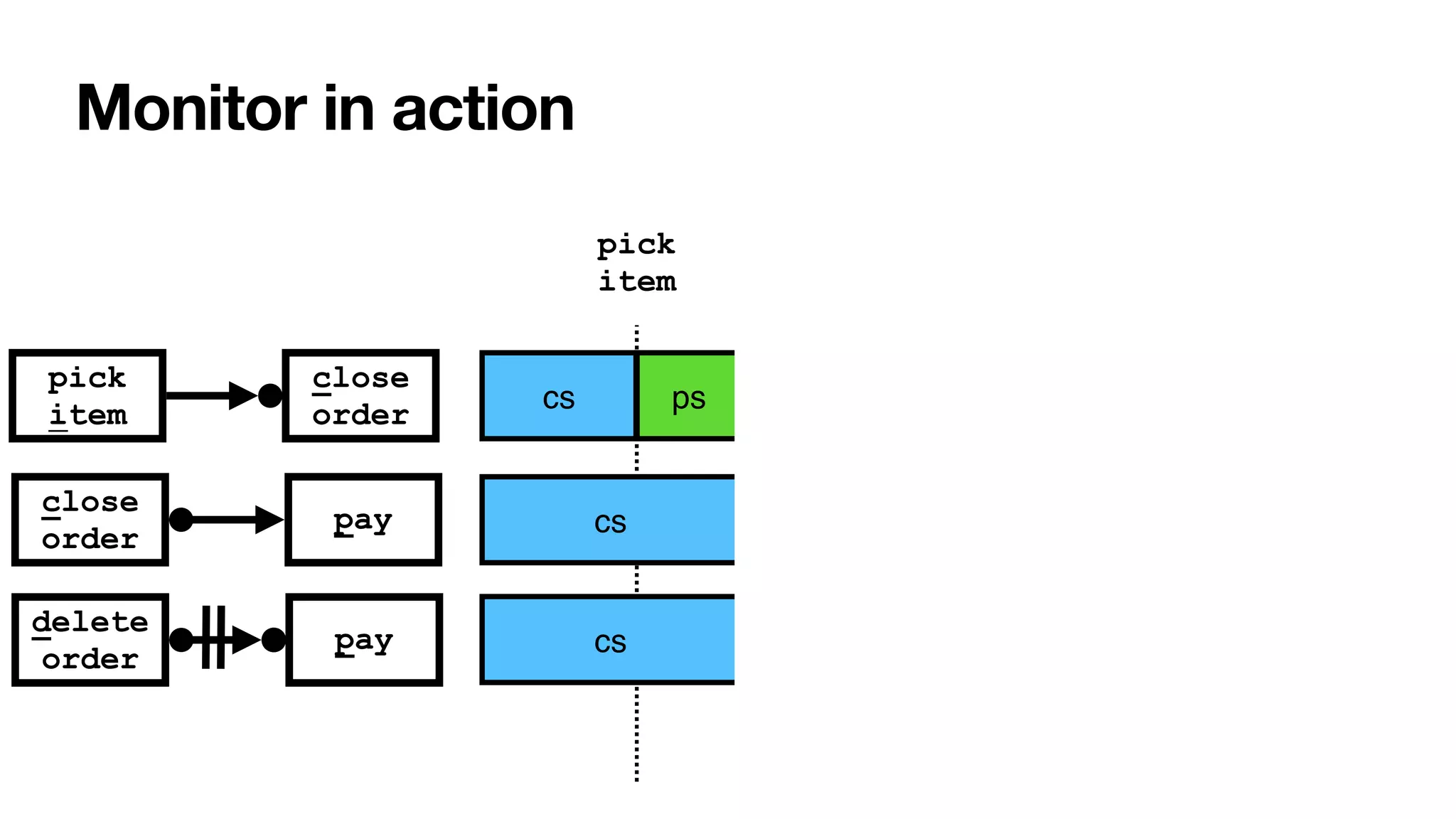
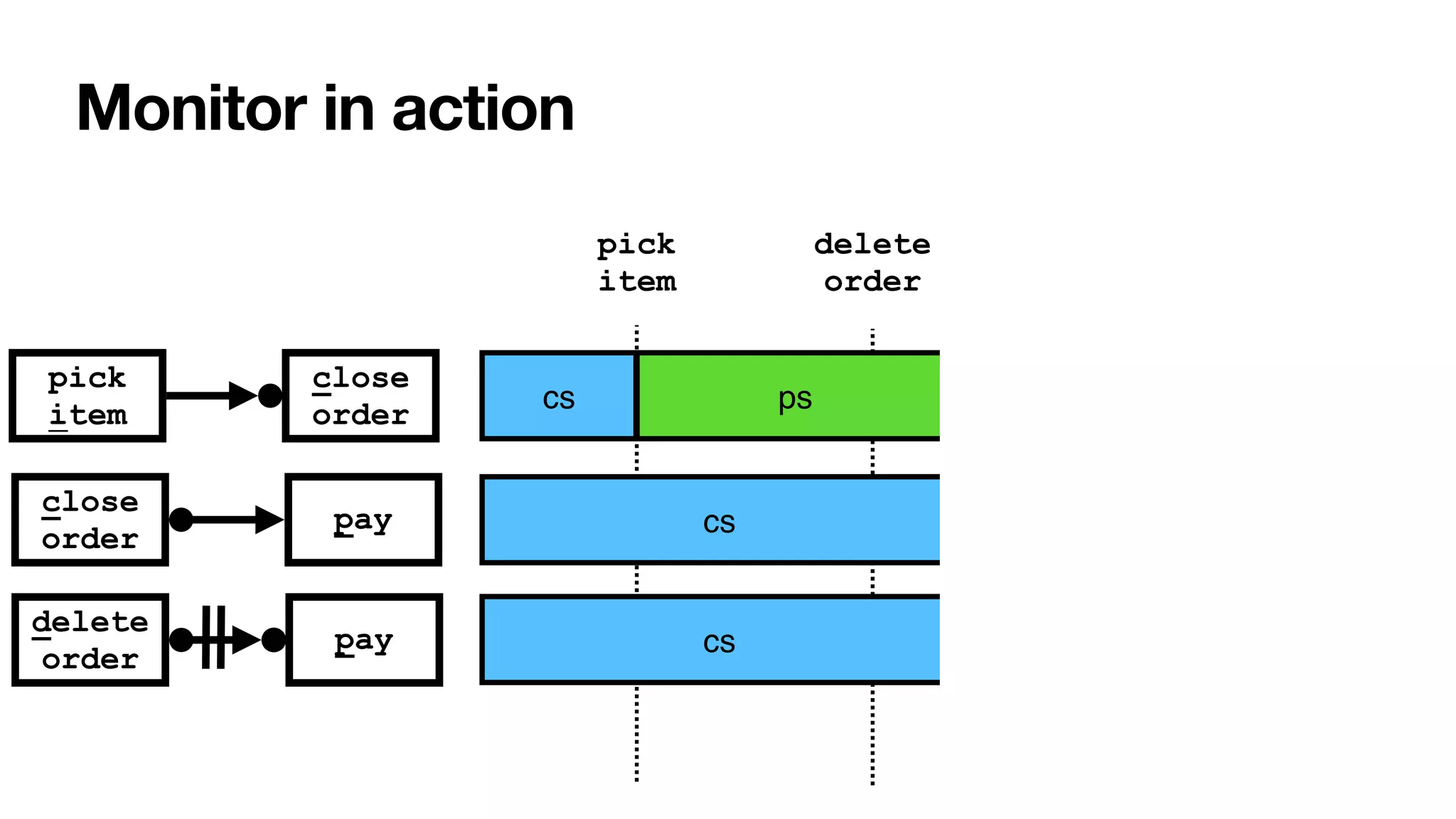
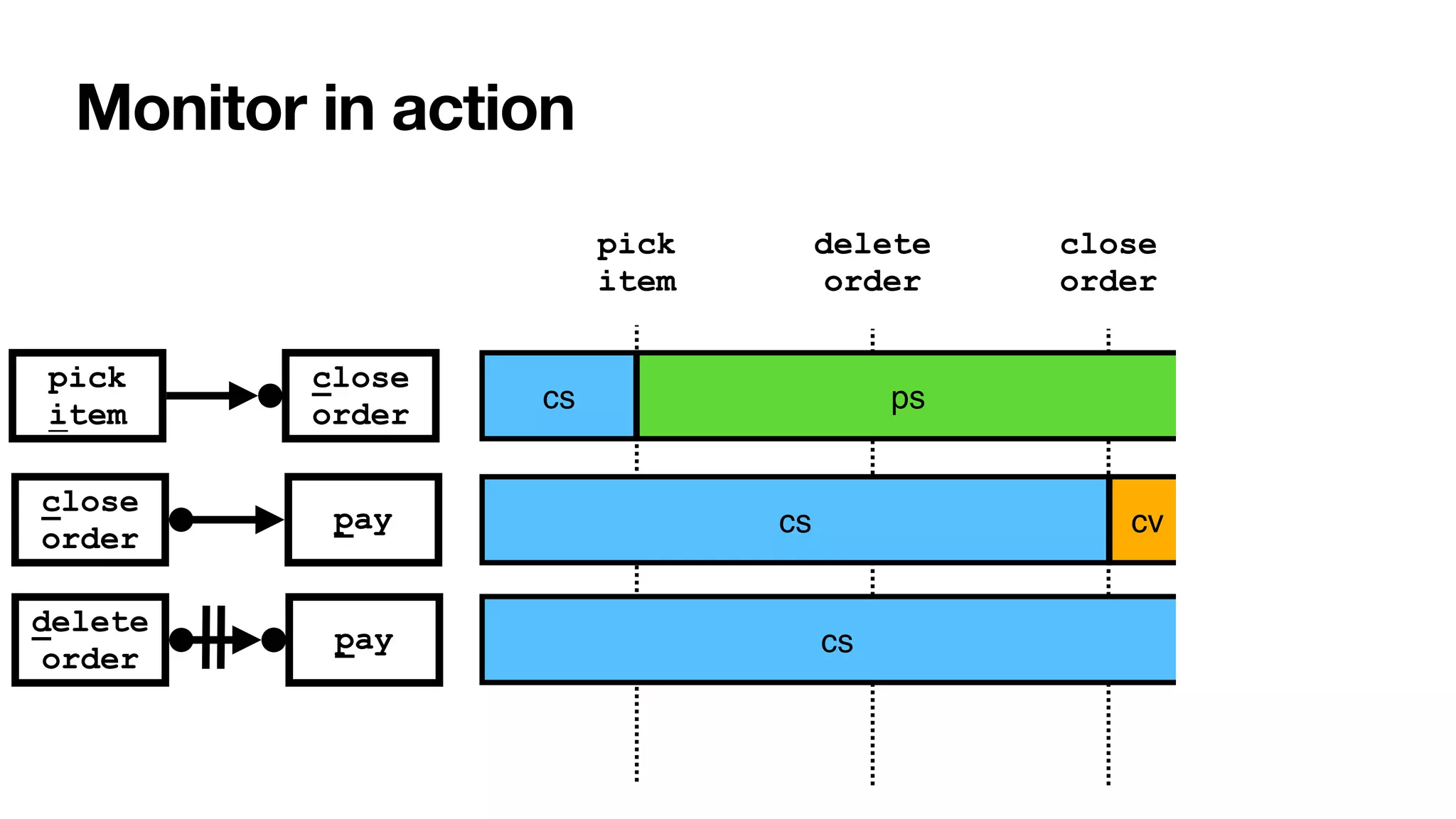
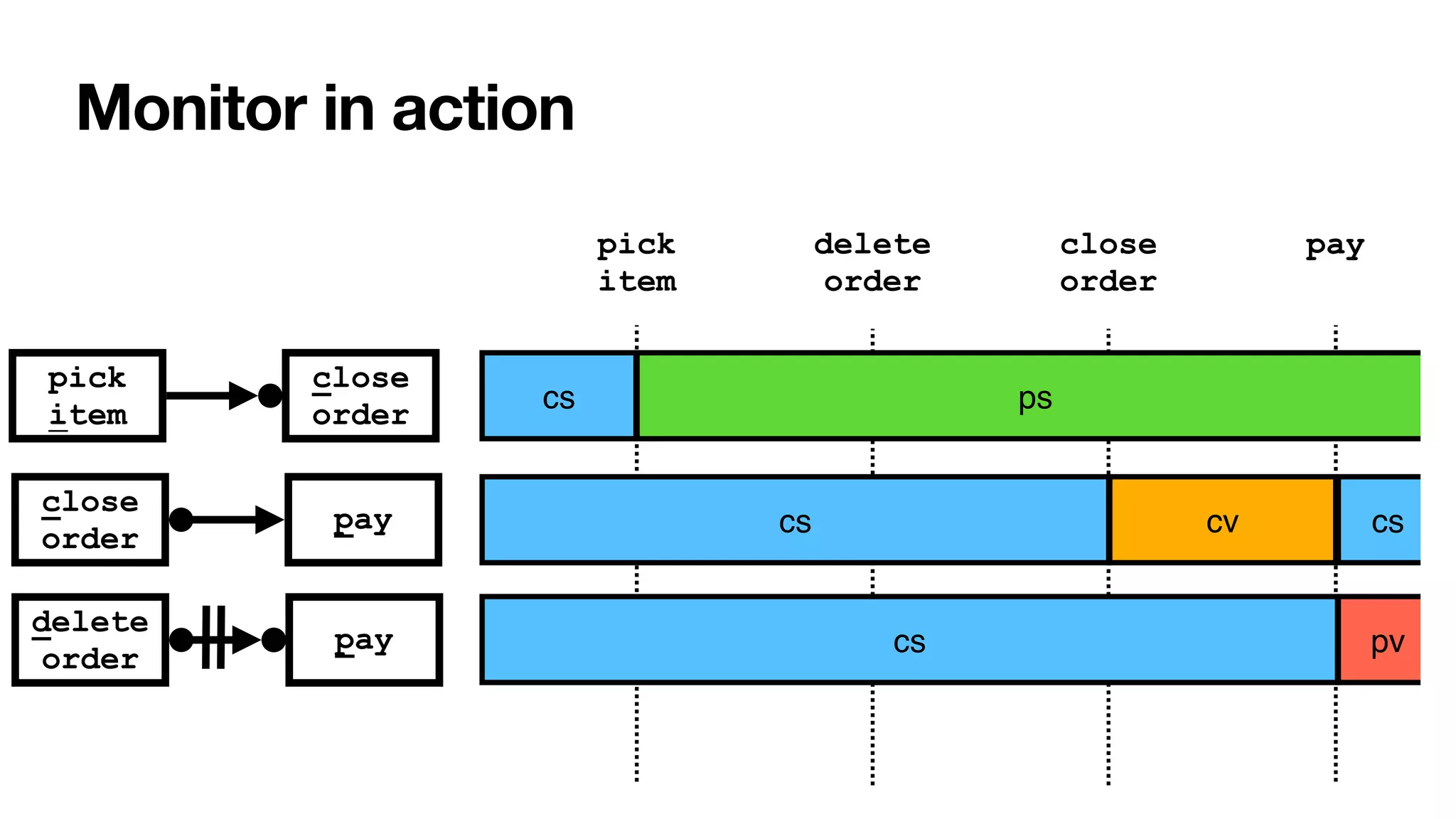


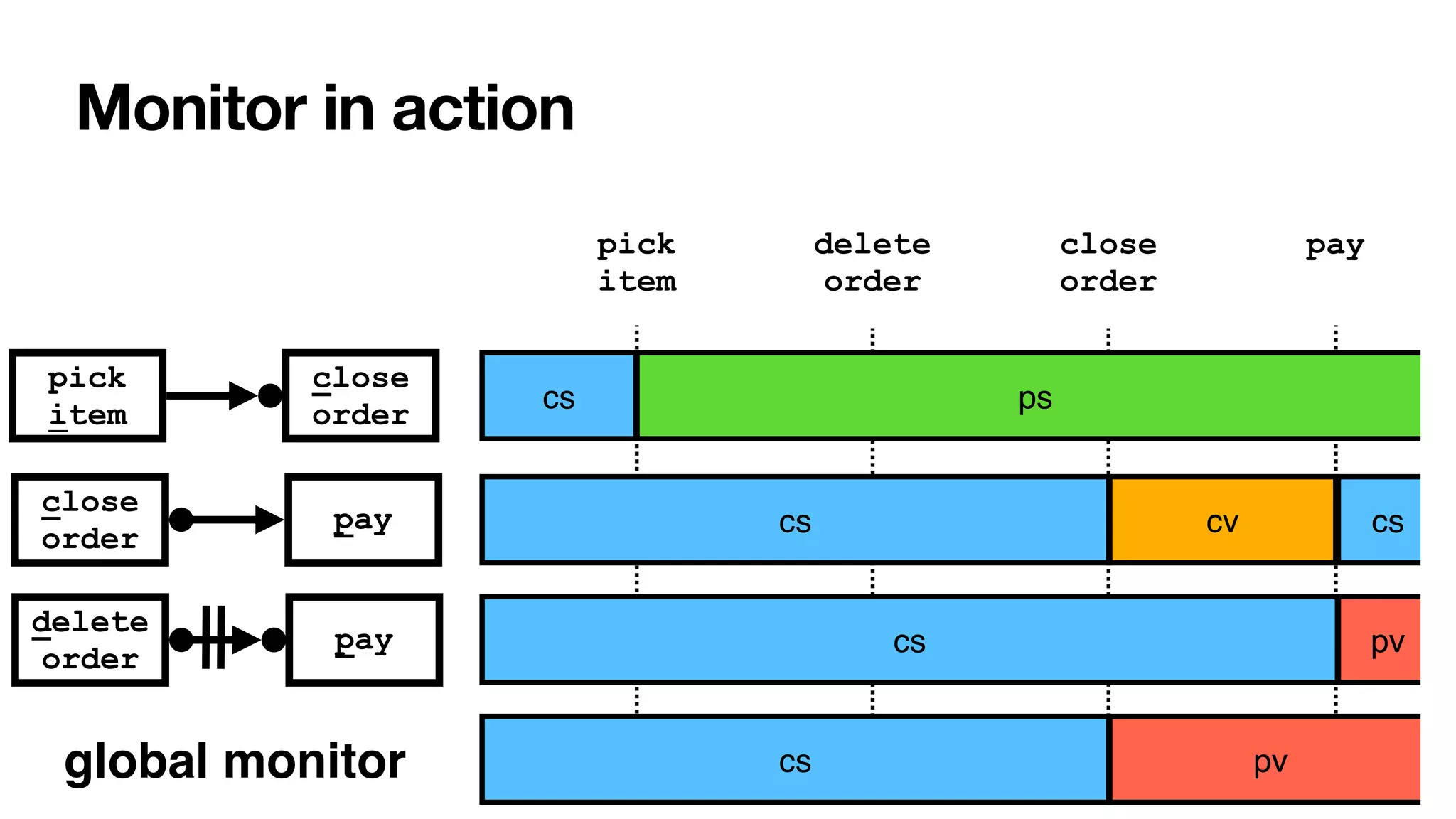
![002
[cs,cs,pv]
111
[ps,cv,cs]
112
[ps,cv,pv]
200
[pv,cs,cs]
102
[pv,cs,cs]
211
[pv,cv,cs]
202
[pv,cs,pv]
{i,c,d}
Σ∖
{i,c,p}
Σ∖
{i,c}
Σ∖
{c,d}
Σ∖
{c,p}
Σ∖
{d,p}
Σ∖
{p}
Σ∖
100
[ps,cs,cs]
101
[ps,cs,cs]
000
[cs,cs,cs]
001
[cs,cs,cs]
{c}
Σ∖
{c,d}
Σ∖
d
c c
i
p
c
i d
110
[ps,cv,cs]
c
p p
d
p
210
[pv,cv,cs]
c
{p,d}
Σ∖
p
d
{p}
Σ∖ p
{c}
Σ∖
i
c
p
{p}
Σ∖
c
212
[pv,cv,pv]
{p}
Σ∖
p
c
[____,BPM2011]
Global monitor
Cross-product
with two proviso:
• recall RV-LTL
labels of local
constraints
• no
minimisation
(distinction of
violation states)](https://image.slidesharecdn.com/ai4bpm-framing-montali-220914143006-e7edf68e/75/Constraints-for-Process-Framing-in-Augmented-BPM-118-2048.jpg)
![002
[cs,cs,pv]
111
[ps,cv,cs]
112
[ps,cv,pv]
200
[pv,cs,cs]
102
[pv,cs,cs]
211
[pv,cv,cs]
202
[pv,cs,pv]
{i,c,d}
Σ∖
{i,c,p}
Σ∖
{i,c}
Σ∖
{c,d}
Σ∖
{c,p}
Σ∖
{d,p}
Σ∖
{p}
Σ∖
100
[ps,cs,cs]
101
[ps,cs,cs]
000
[cs,cs,cs]
001
[cs,cs,cs]
{c}
Σ∖
{c,d}
Σ∖
d
c c
i
p
c
i d
110
[ps,cv,cs]
c
p p
d
p
210
[pv,cv,cs]
c
{p,d}
Σ∖
p
d
{p}
Σ∖ p
{c}
Σ∖
i
c
p
{p}
Σ∖
c
212
[pv,cv,pv]
{p}
Σ∖
p
c
[____,BPM2011]
Global monitor Anticipatory
violation
detection
Cross-product
with two proviso:
• recall RV-LTL
labels of local
constraints
• no
minimisation
(distinction of
violation states)](https://image.slidesharecdn.com/ai4bpm-framing-montali-220914143006-e7edf68e/75/Constraints-for-Process-Framing-in-Augmented-BPM-119-2048.jpg)
![002
[cs,cs,pv]
111
[ps,cv,cs]
112
[ps,cv,pv]
200
[pv,cs,cs]
102
[pv,cs,cs]
211
[pv,cv,cs]
202
[pv,cs,pv]
{i,c,d}
Σ∖
{i,c,p}
Σ∖
{i,c}
Σ∖
{c,d}
Σ∖
{c,p}
Σ∖
{d,p}
Σ∖
{p}
Σ∖
100
[ps,cs,cs]
101
[ps,cs,cs]
000
[cs,cs,cs]
001
[cs,cs,cs]
{c}
Σ∖
{c,d}
Σ∖
d
c c
i
p
c
i d
110
[ps,cv,cs]
c
p p
d
p
210
[pv,cv,cs]
c
{p,d}
Σ∖
p
d
{p}
Σ∖ p
{c}
Σ∖
i
c
p
{p}
Σ∖
c
212
[pv,cv,pv]
{p}
Σ∖
p
c
[____,BPM2011]
Global monitor
Cross-product
with two proviso:
• recall RV-LTL
labels of local
constraints
• no
minimisation
(distinction of
violation states)
Anticipatory
violation
detection
[____,CAiSE2022]
constraint weights and
recommendations](https://image.slidesharecdn.com/ai4bpm-framing-montali-220914143006-e7edf68e/75/Constraints-for-Process-Framing-in-Augmented-BPM-120-2048.jpg)
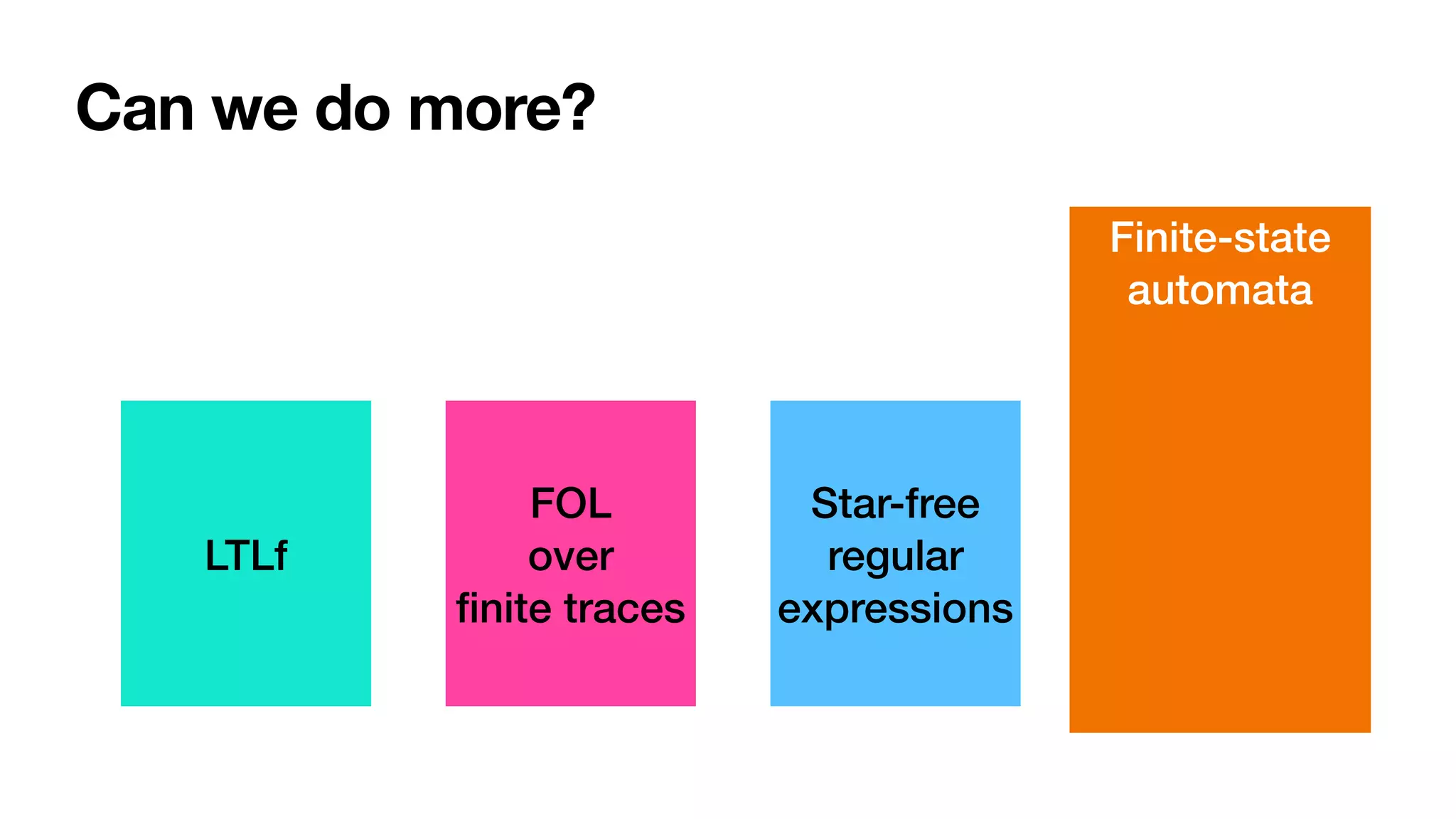
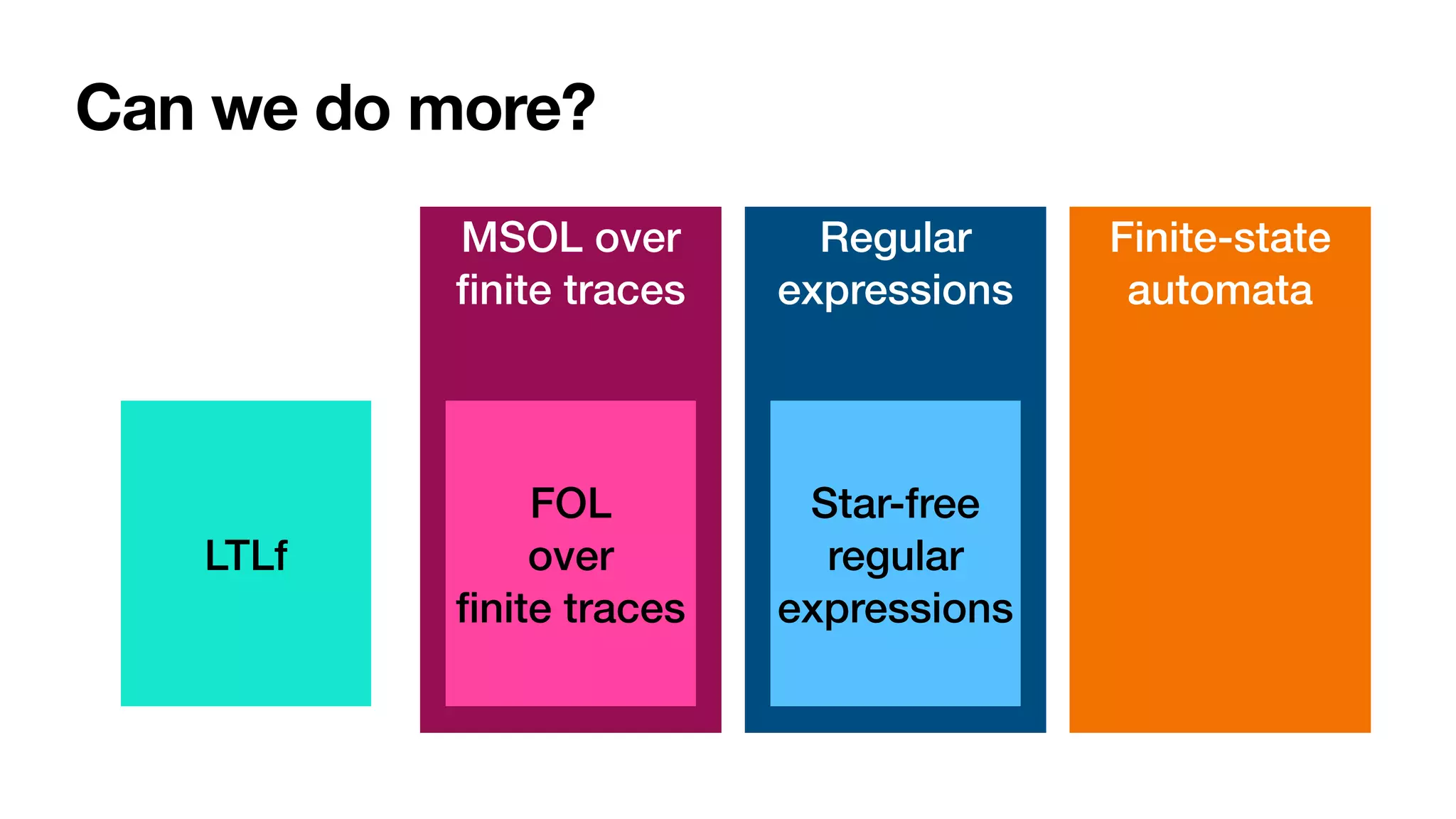
![LDLf
linear dynamic logic
over
fi
nite traces
[DeGiacomoVardi,
IJ
CAI2013]
MSOL over
fi
nite traces
Regular
expressions
Can we do more?
LTLf
FOL
over
fi
nite traces
Star-free
regular
expressions
Finite-state
automata](https://image.slidesharecdn.com/ai4bpm-framing-montali-220914143006-e7edf68e/75/Constraints-for-Process-Framing-in-Augmented-BPM-123-2048.jpg)
![LDLf
linear dynamic logic
over
fi
nite traces
[DeGiacomoVardi,
IJ
CAI2013]
MSOL over
fi
nite traces
Regular
expressions
Can we do more?
[____,BPM2014] [____,TOSEM2022]
LTLf
FOL
over
fi
nite traces
Star-free
regular
expressions
Finite-state
automata](https://image.slidesharecdn.com/ai4bpm-framing-montali-220914143006-e7edf68e/75/Constraints-for-Process-Framing-in-Augmented-BPM-124-2048.jpg)
![LDLf
linear dynamic logic
over
fi
nite traces
[DeGiacomoVardi,
IJ
CAI2013]
MSOL over
fi
nite traces
Regular
expressions
Can we do more?
[____,BPM2014] [____,TOSEM2022]
LTLf
FOL
over
fi
nite traces
Star-free
regular
expressions
Finite-state
automata](https://image.slidesharecdn.com/ai4bpm-framing-montali-220914143006-e7edf68e/75/Constraints-for-Process-Framing-in-Augmented-BPM-125-2048.jpg)
![LDLf
linear dynamic logic
over
fi
nite traces
[DeGiacomoVardi,
IJ
CAI2013]
MSOL over
fi
nite traces
Regular
expressions
Can we do more?
[____,BPM2014] [____,TOSEM2022]
LTLf
FOL
over
fi
nite traces
Star-free
regular
expressions
Finite-state
automata](https://image.slidesharecdn.com/ai4bpm-framing-montali-220914143006-e7edf68e/75/Constraints-for-Process-Framing-in-Augmented-BPM-126-2048.jpg)
![From constraints to metaconstraints
[____,BPM2014] [____,TOSEM2022]
LDLf expresses RV-LTL monitoring states of LDLf constraints
• Support for metaconstraints predicating over the monitoring status of
other constraints
Example: a form of “contrary-to-duty” process constraint
• If constraint C1 gets permanently violated, eventually satisfy a
compensation constraint C2
Interesting open problem: relationship with normative frameworks and
defeasible reasoning
• [Governatori,EDOC2015] -> LTL cannot express normative notions
• [AlechinaEtAl,FLAP2018]-> not true!](https://image.slidesharecdn.com/ai4bpm-framing-montali-220914143006-e7edf68e/75/Constraints-for-Process-Framing-in-Augmented-BPM-127-2048.jpg)
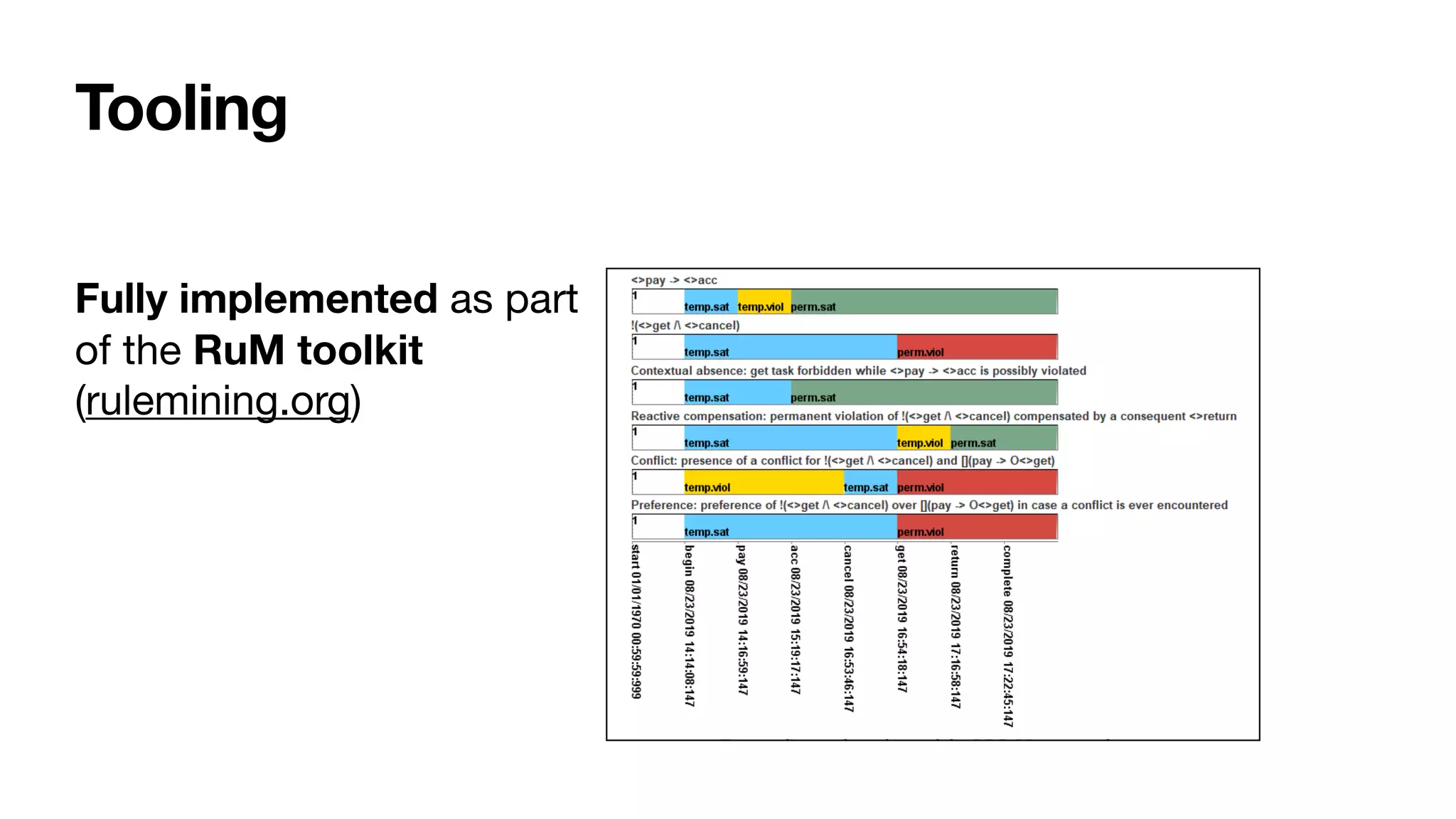
![Adding event attributes and arithmetics
[____,AAAI2022]
Study of LTLf over numerical variables with arithmetic
conditions
• Undecidability around the corner
Identi
fi
cation of decidable fragments tuning condition
language and variable interaction
• Lifting of automata-based techniques
• SMT reasoners to deal with conditions](https://image.slidesharecdn.com/ai4bpm-framing-montali-220914143006-e7edf68e/75/Constraints-for-Process-Framing-in-Augmented-BPM-129-2048.jpg)
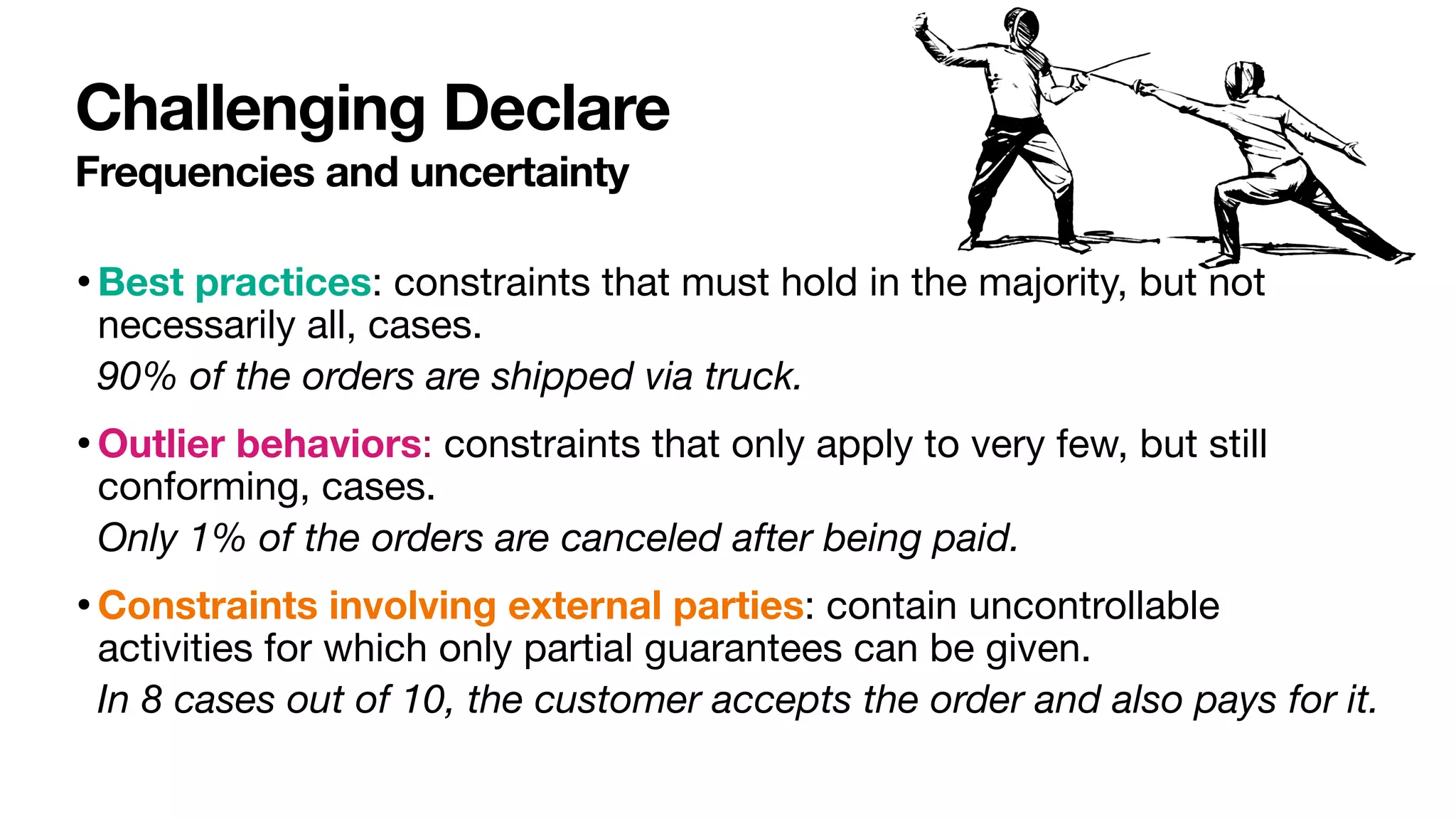

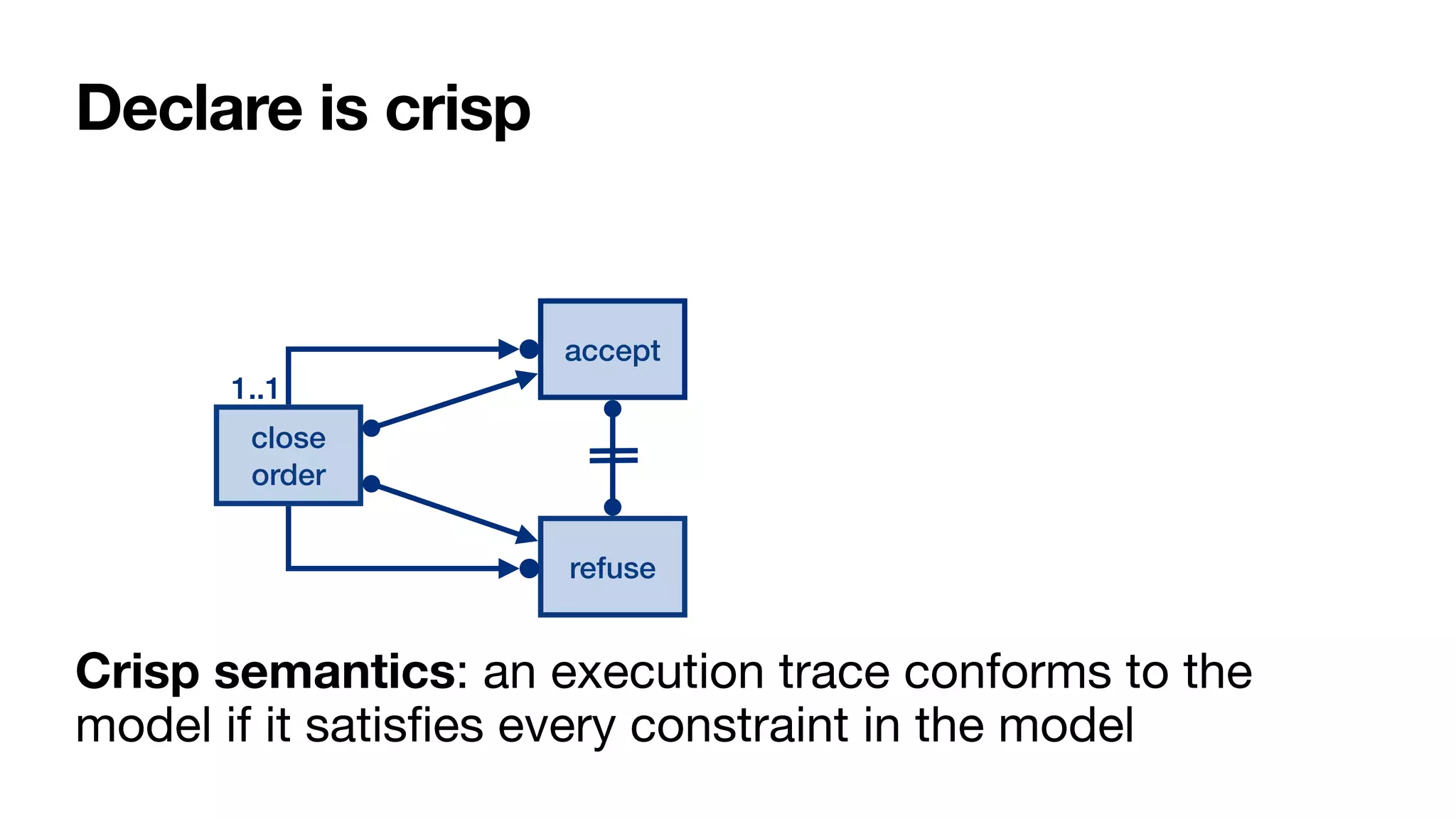
![close
order
1..1
accept
refuse
{0.8}
{0.3}
{0.9}
ProbDeclare
Crisp and uncertain constraints [____,BPM2020] [____,InfSys2022]](https://image.slidesharecdn.com/ai4bpm-framing-montali-220914143006-e7edf68e/75/Constraints-for-Process-Framing-in-Augmented-BPM-133-2048.jpg)
![probability reference value: number in [0,1]
probability operator: { = , ≠ , ≤ , ≥ , < , > }
close
order
1..1
accept
refuse
{0.8}
{0.3}
{0.9}
ProbDeclare
Crisp and uncertain constraints [____,BPM2020] [____,InfSys2022]
ProbDeclare constraint over :
triple
Σ
⟨φ, ⋈, p⟩
process condition: LTLf formula over Σ
Well-behaved fragment of full probabilistic LTLf [____,AAAI2020]](https://image.slidesharecdn.com/ai4bpm-framing-montali-220914143006-e7edf68e/75/Constraints-for-Process-Framing-in-Augmented-BPM-134-2048.jpg)
![close
order
1..1
accept
refuse
{0.8}
{0.3}
{0.9}
ProbDeclare
Crisp and uncertain constraints [____,BPM2020] [____,InfSys2022]](https://image.slidesharecdn.com/ai4bpm-framing-montali-220914143006-e7edf68e/75/Constraints-for-Process-Framing-in-Augmented-BPM-135-2048.jpg)
![close
order
1..1
accept
refuse
Crisp!
Each trace in the log
contains exactly one
close order
{0.8}
{0.3}
{0.9}
ProbDeclare
Crisp and uncertain constraints [____,BPM2020] [____,InfSys2022]](https://image.slidesharecdn.com/ai4bpm-framing-montali-220914143006-e7edf68e/75/Constraints-for-Process-Framing-in-Augmented-BPM-136-2048.jpg)
![close
order
1..1
accept
refuse
{0.8}
{0.3}
{0.9}
Uncertain!
90% traces are so that
an order is not accepted
and refused.
In 10% traces the seller
changes their mind
ProbDeclare
Crisp and uncertain constraints [____,BPM2020] [____,InfSys2022]](https://image.slidesharecdn.com/ai4bpm-framing-montali-220914143006-e7edf68e/75/Constraints-for-Process-Framing-in-Augmented-BPM-137-2048.jpg)
![close
order
1..1
accept
refuse
{0.8}
{0.3}
{0.9}
Uncertain!
90% traces are so that
an order is not accepted
and refused.
In 10% traces the seller
changes their mind
ProbDeclare
Crisp and uncertain constraints [____,BPM2020] [____,InfSys2022]](https://image.slidesharecdn.com/ai4bpm-framing-montali-220914143006-e7edf68e/75/Constraints-for-Process-Framing-in-Augmented-BPM-138-2048.jpg)
![From traces to stochastic languages and logs
A stochastic language over is a function
such that
•
fi
nite if
fi
nitely many traces get a non-zero probability
A log can be seen as a
fi
nite stochastic language
(probabilities from frequencies)
Σ
ρ : Σ* → [0,1]
∑
τ∈Σ*
ρ(τ) = 1](https://image.slidesharecdn.com/ai4bpm-framing-montali-220914143006-e7edf68e/75/Constraints-for-Process-Framing-in-Augmented-BPM-139-2048.jpg)
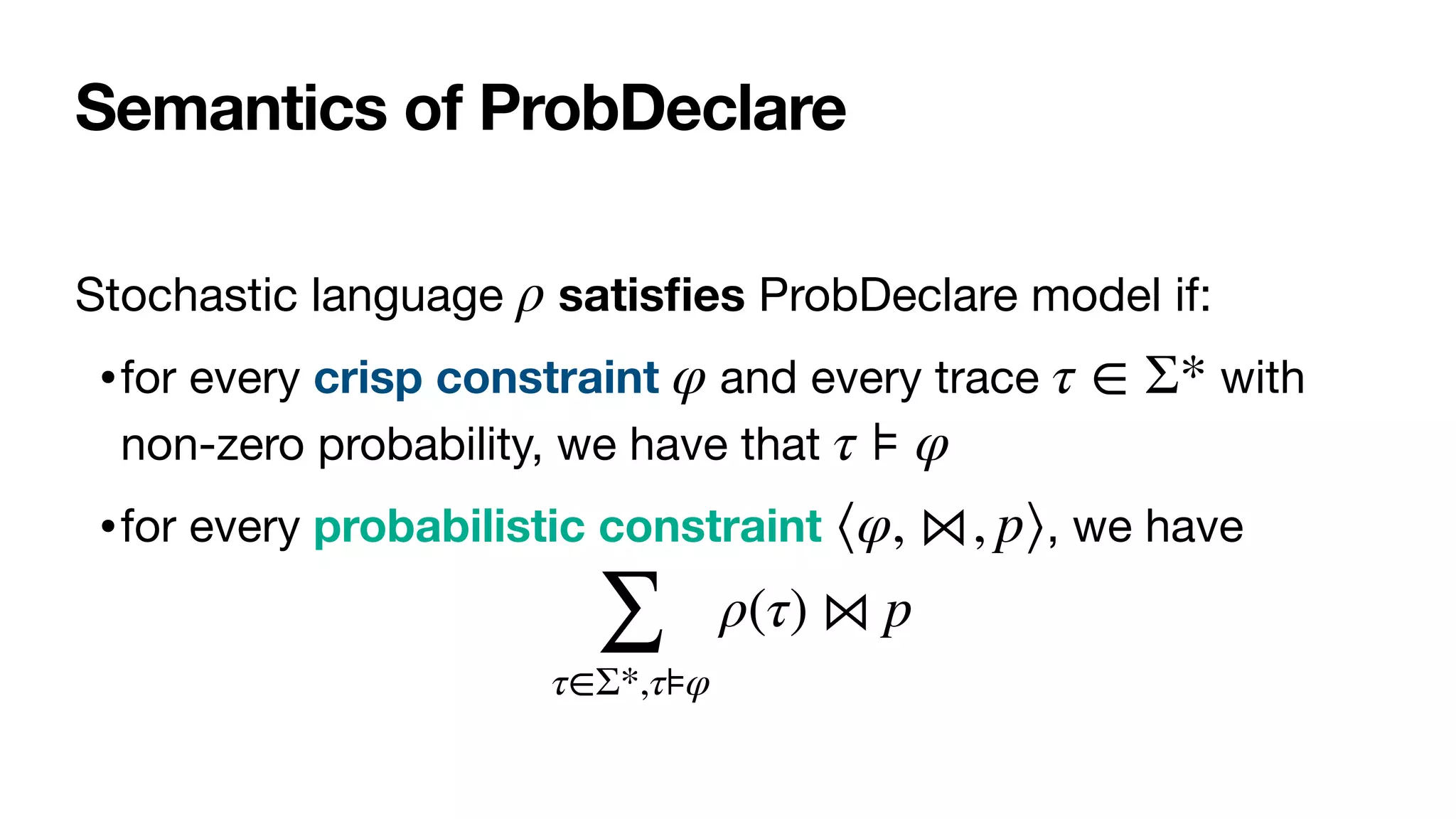
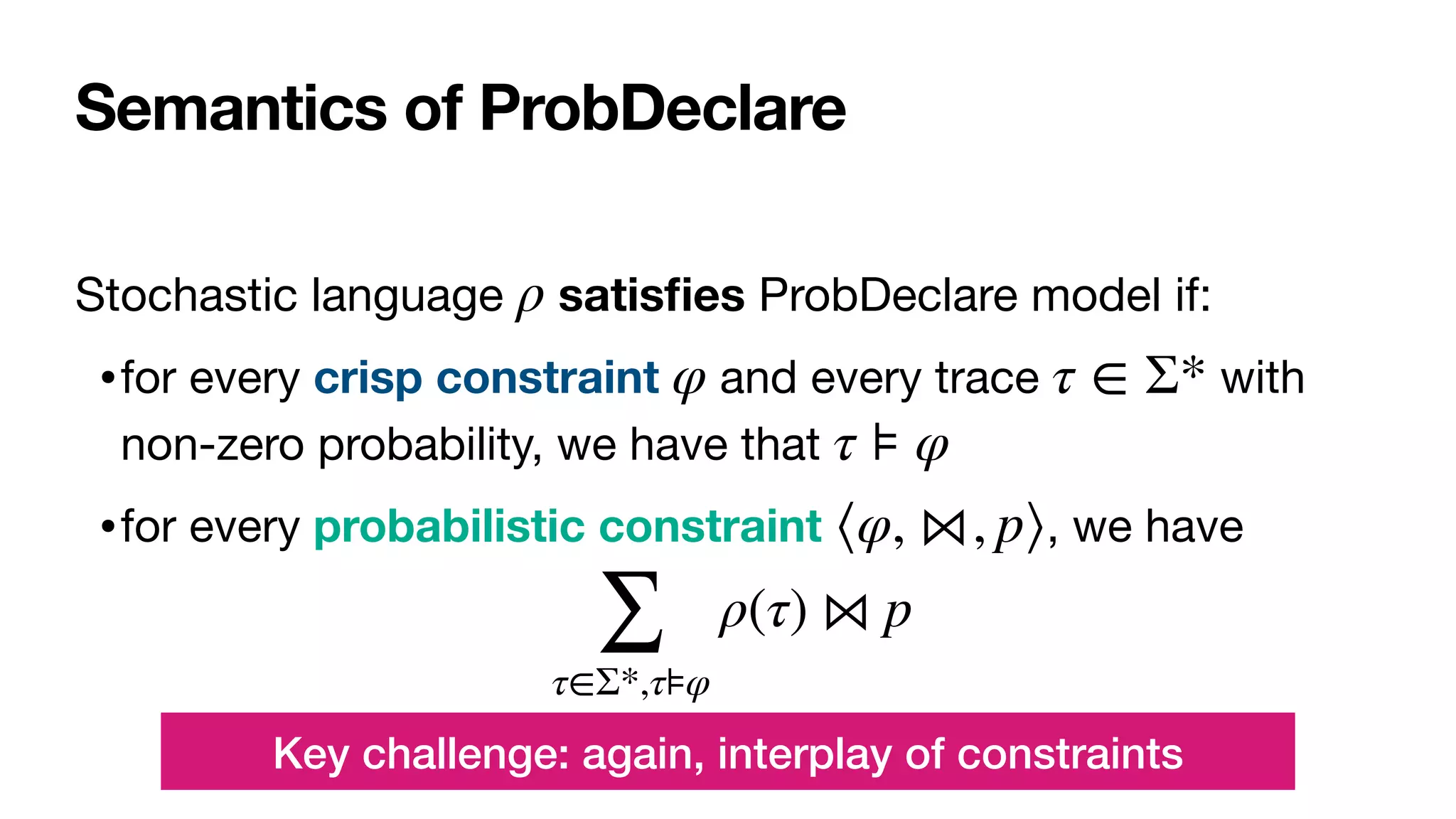
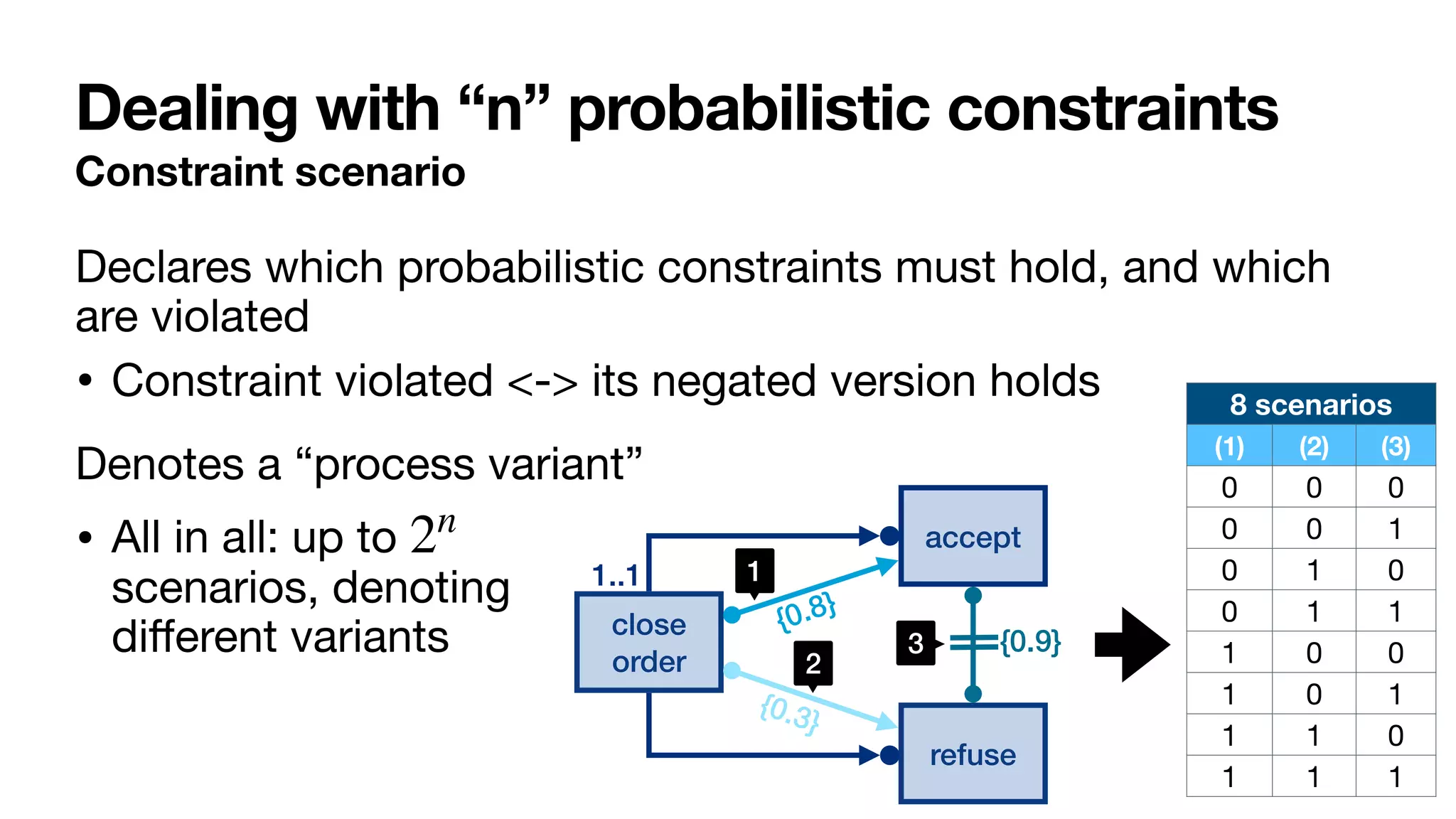

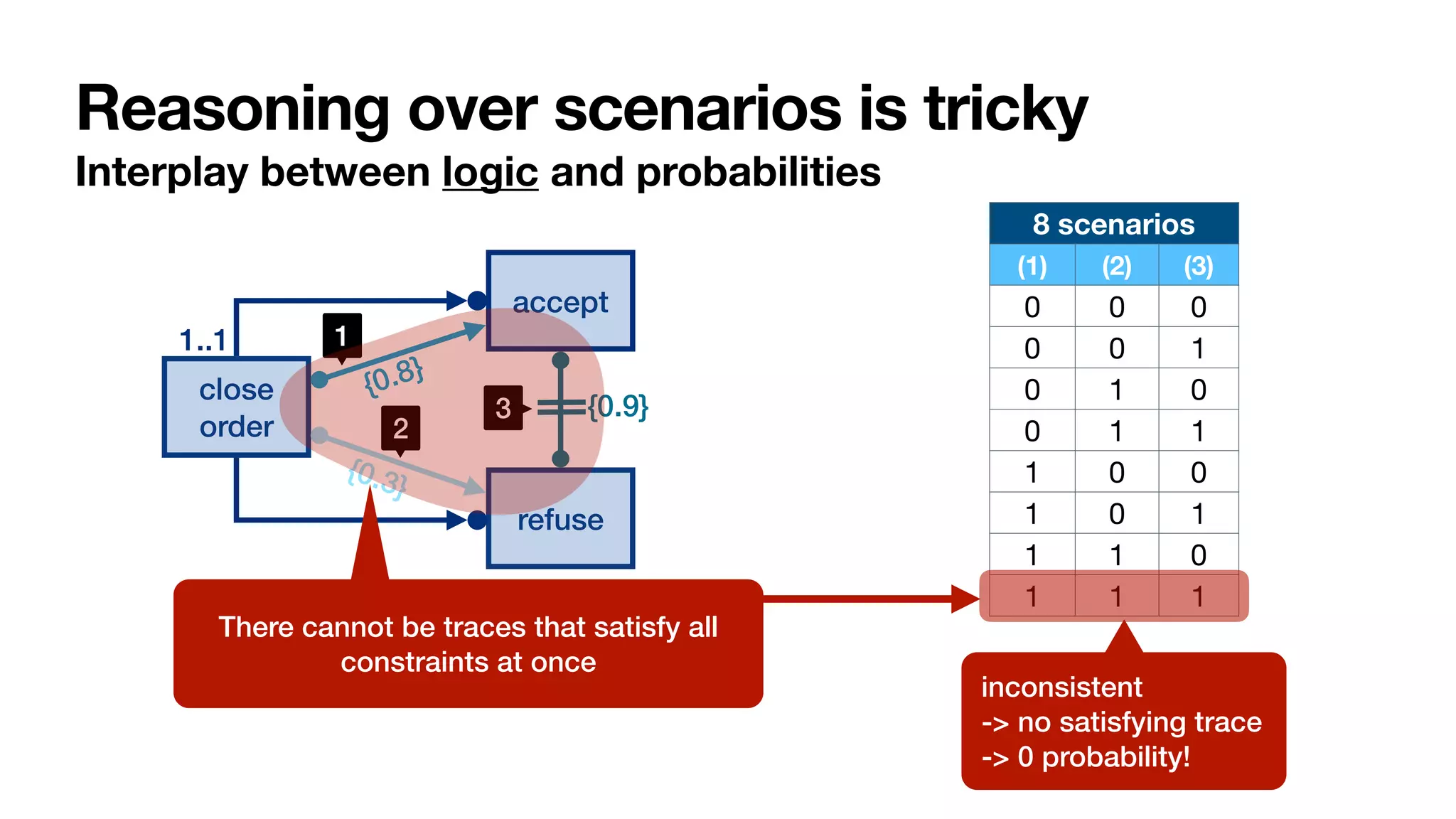
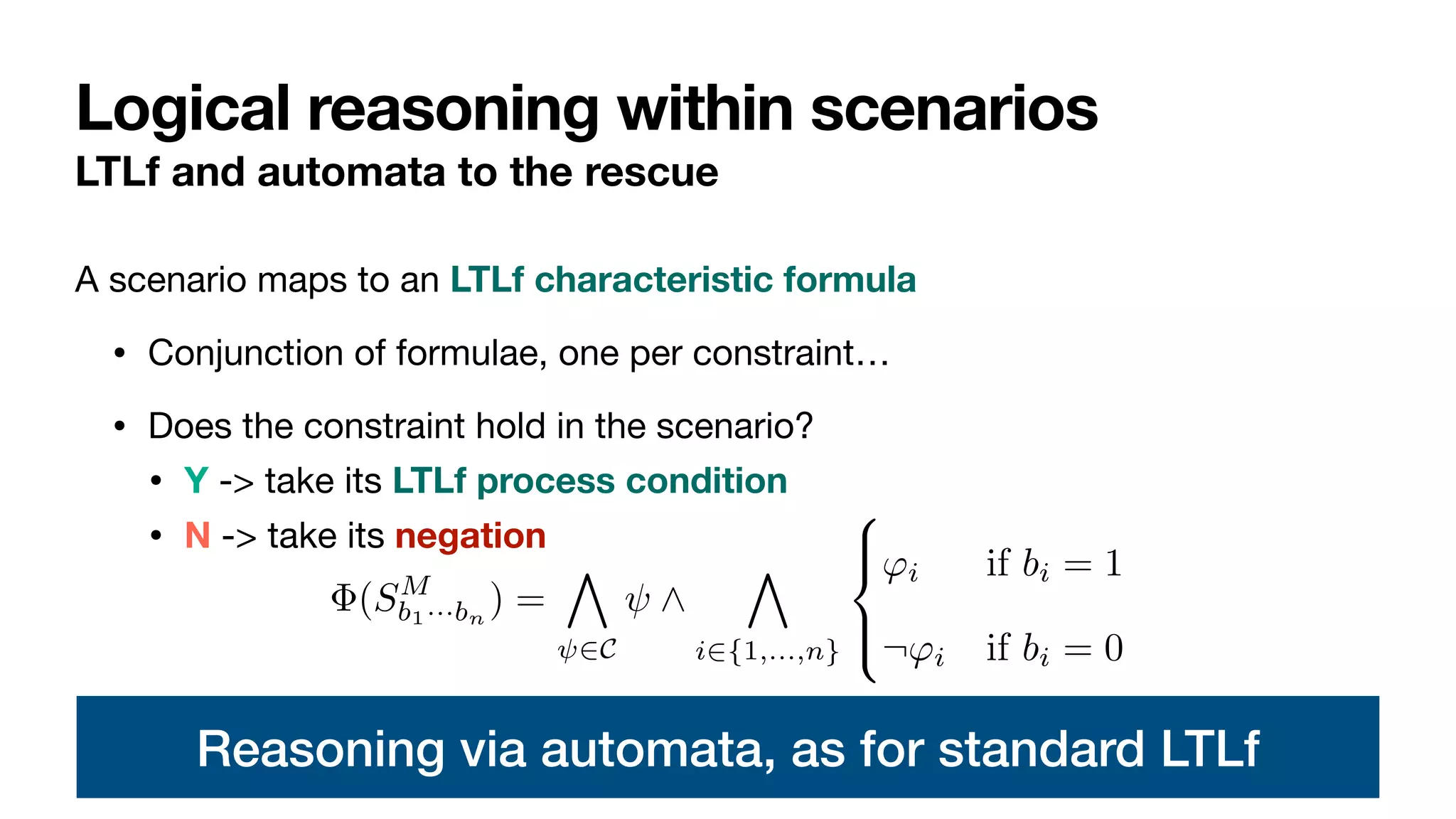
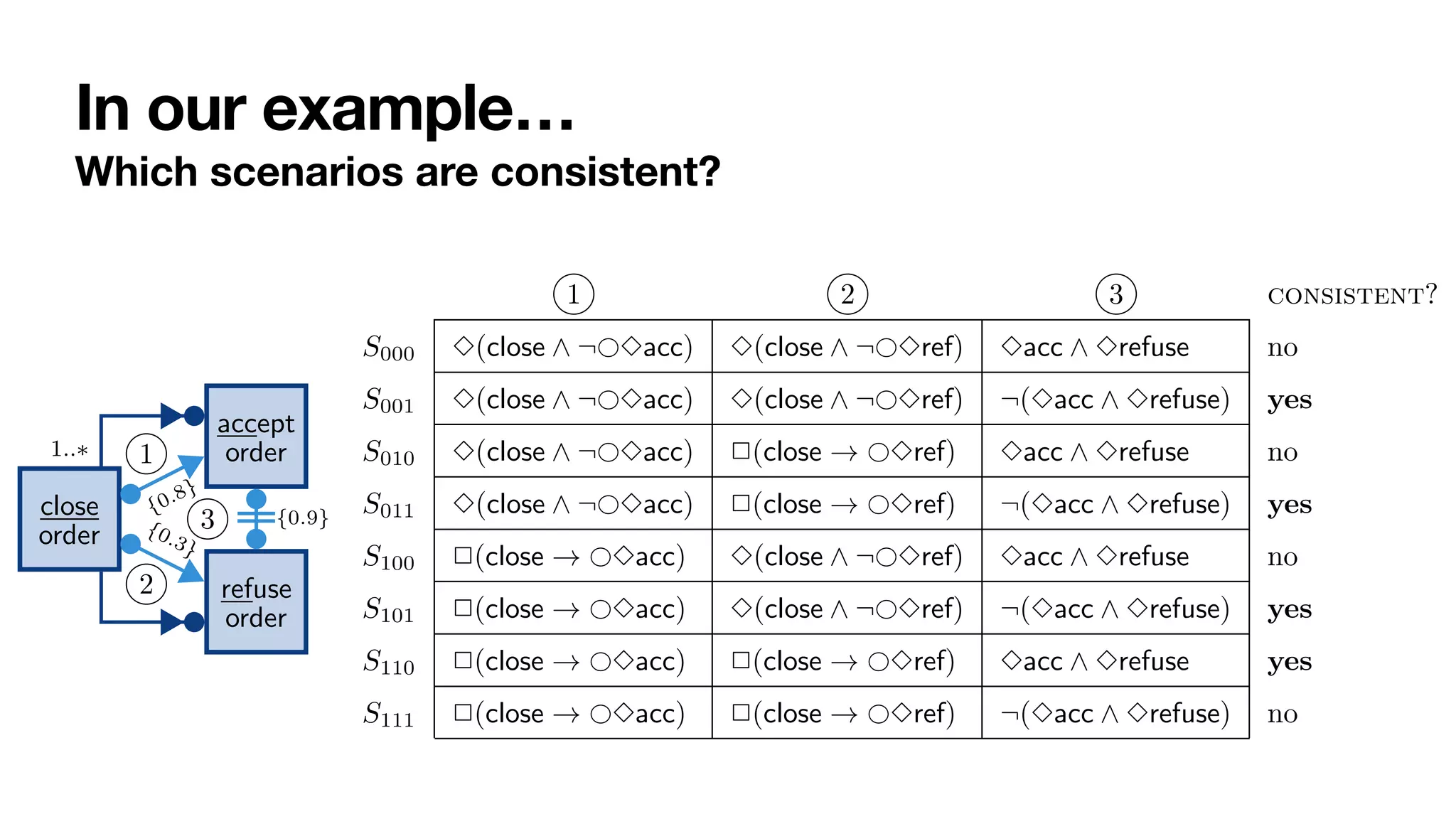
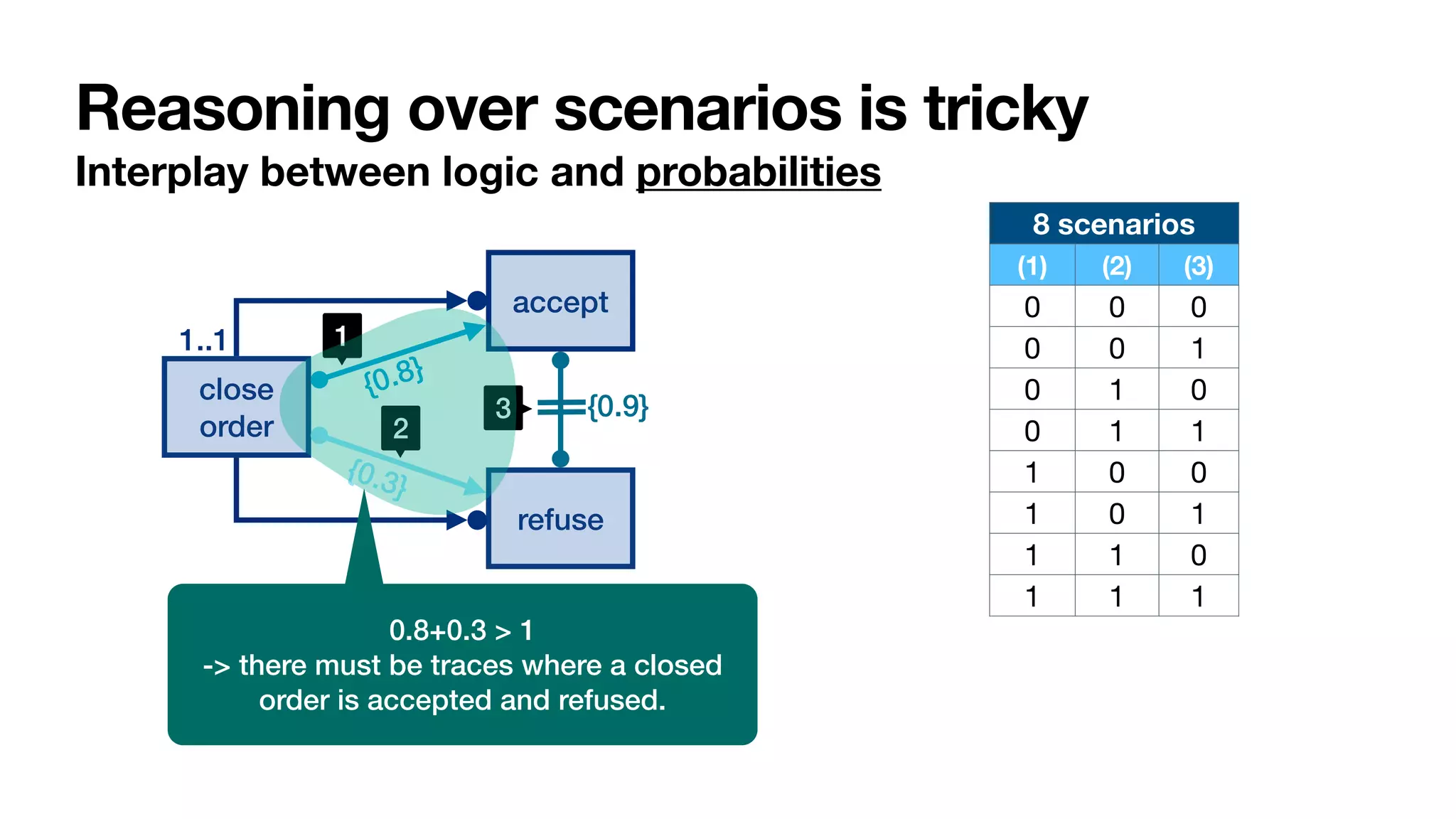
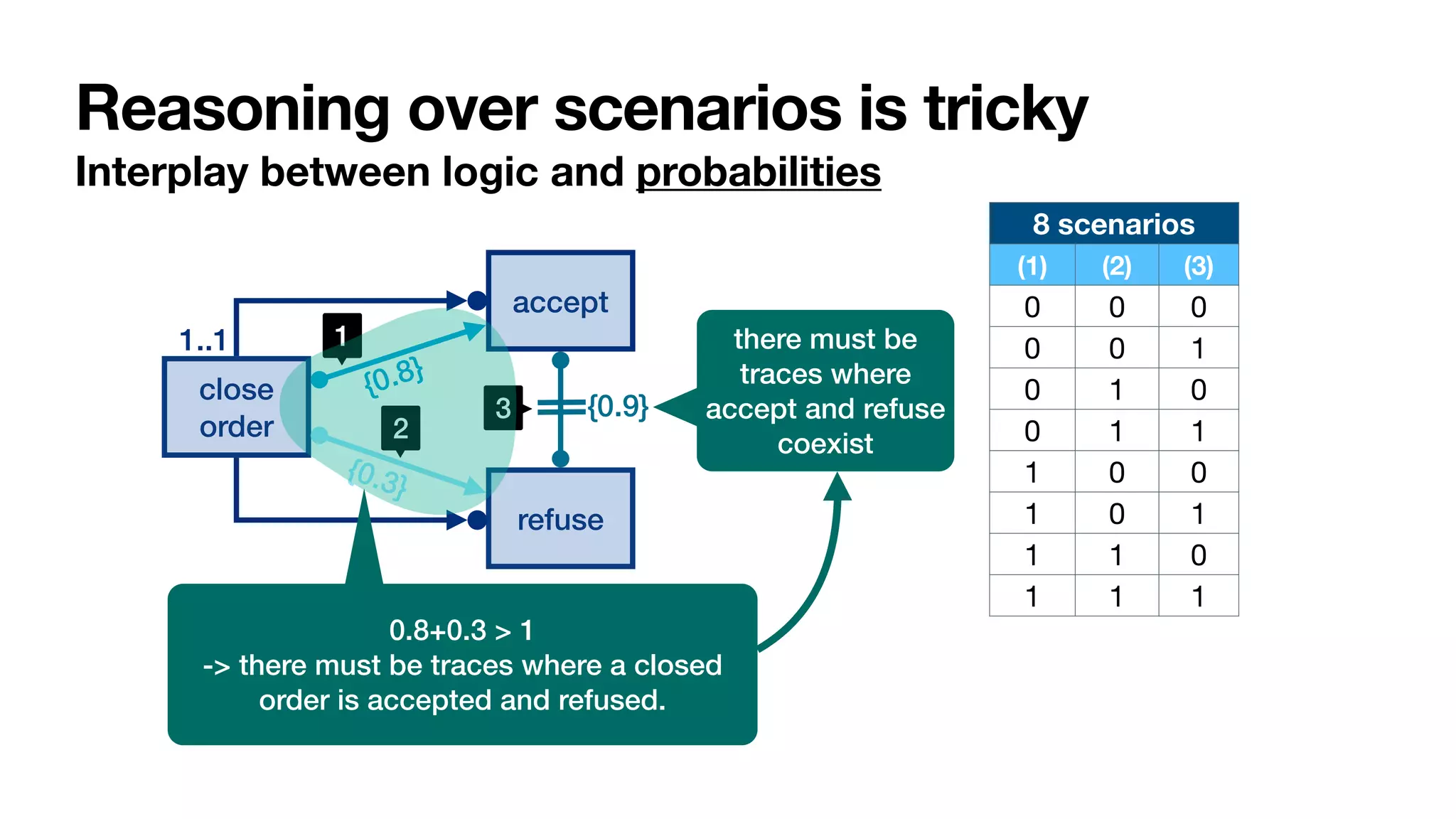
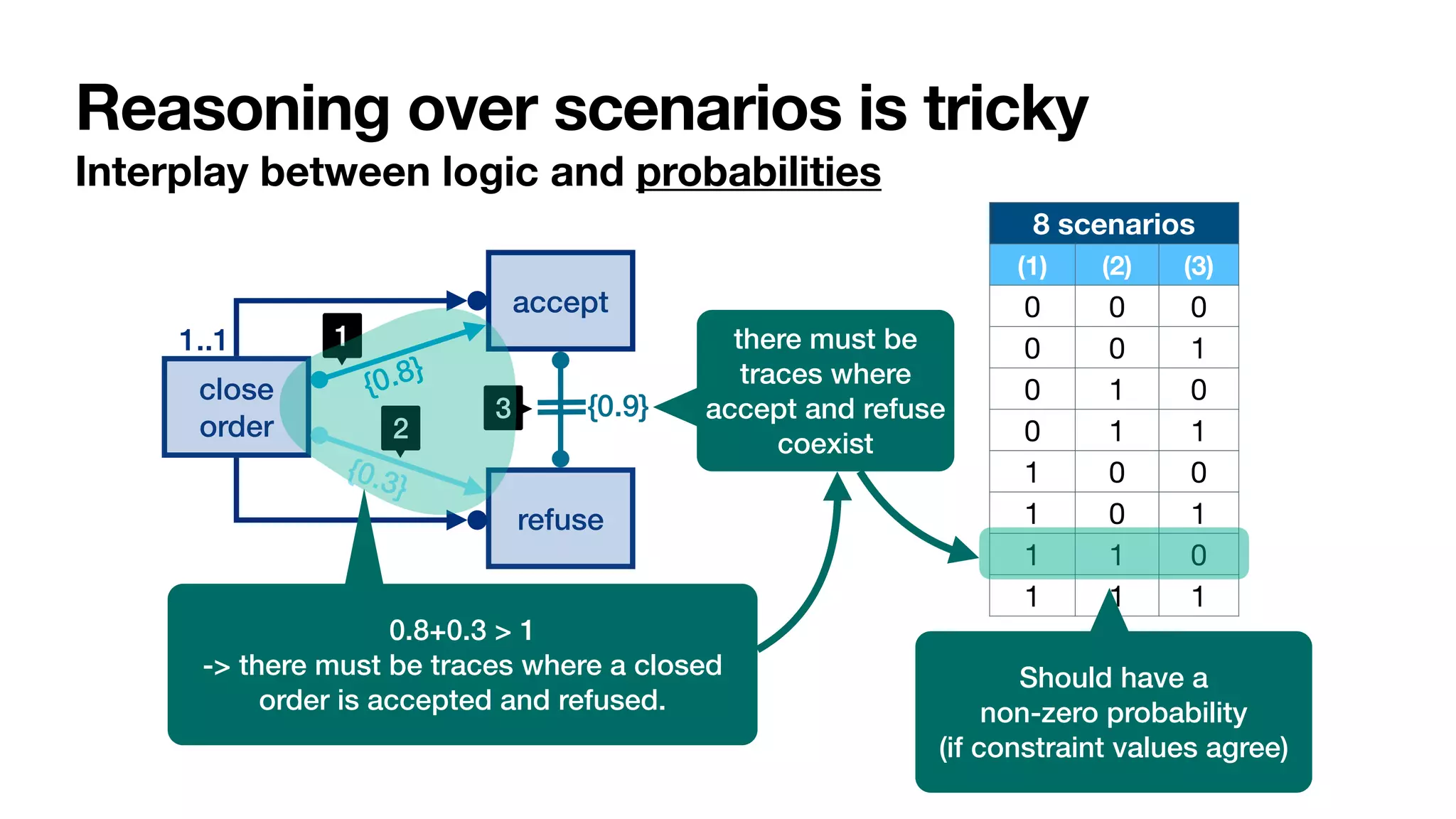
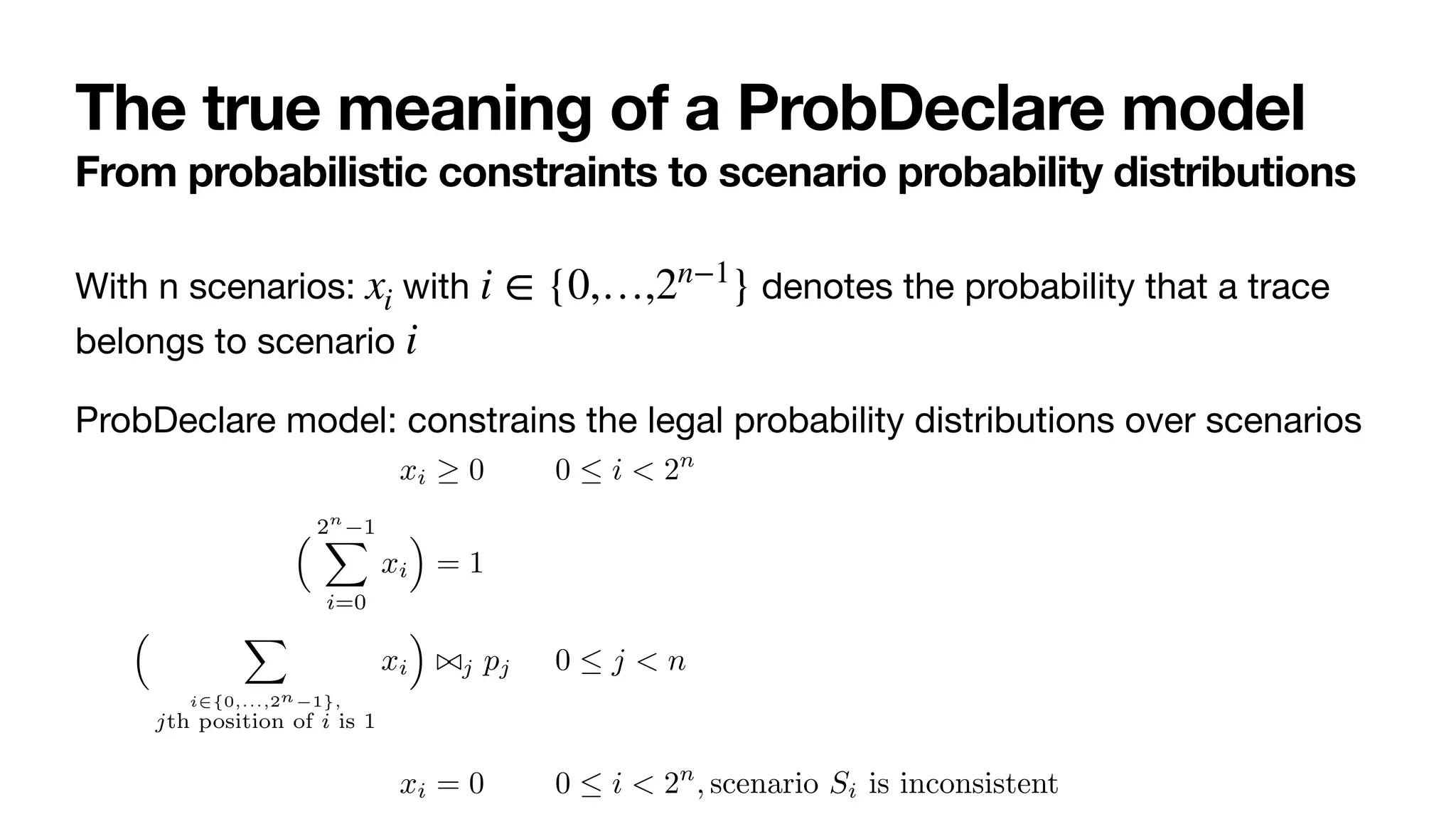


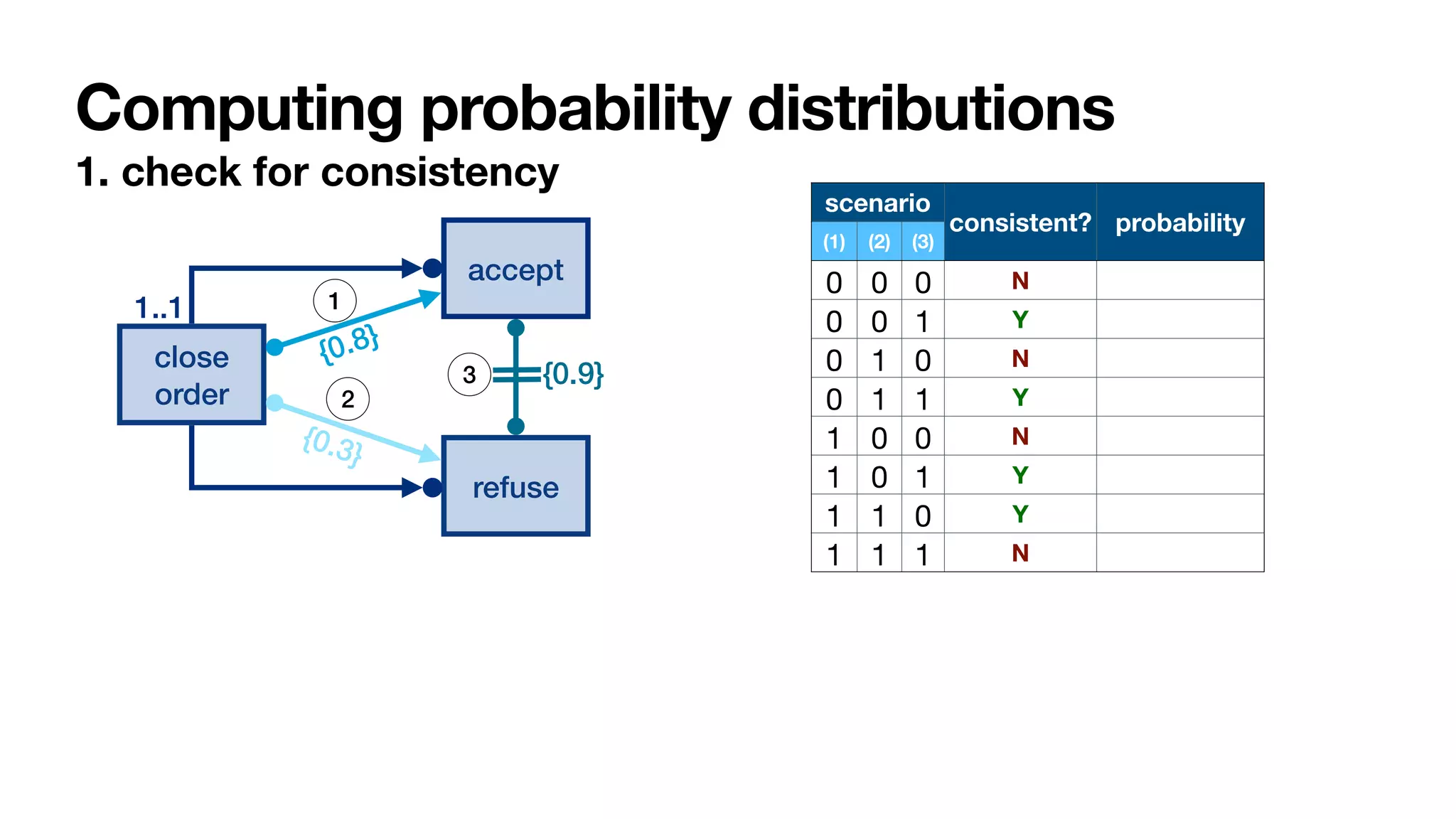
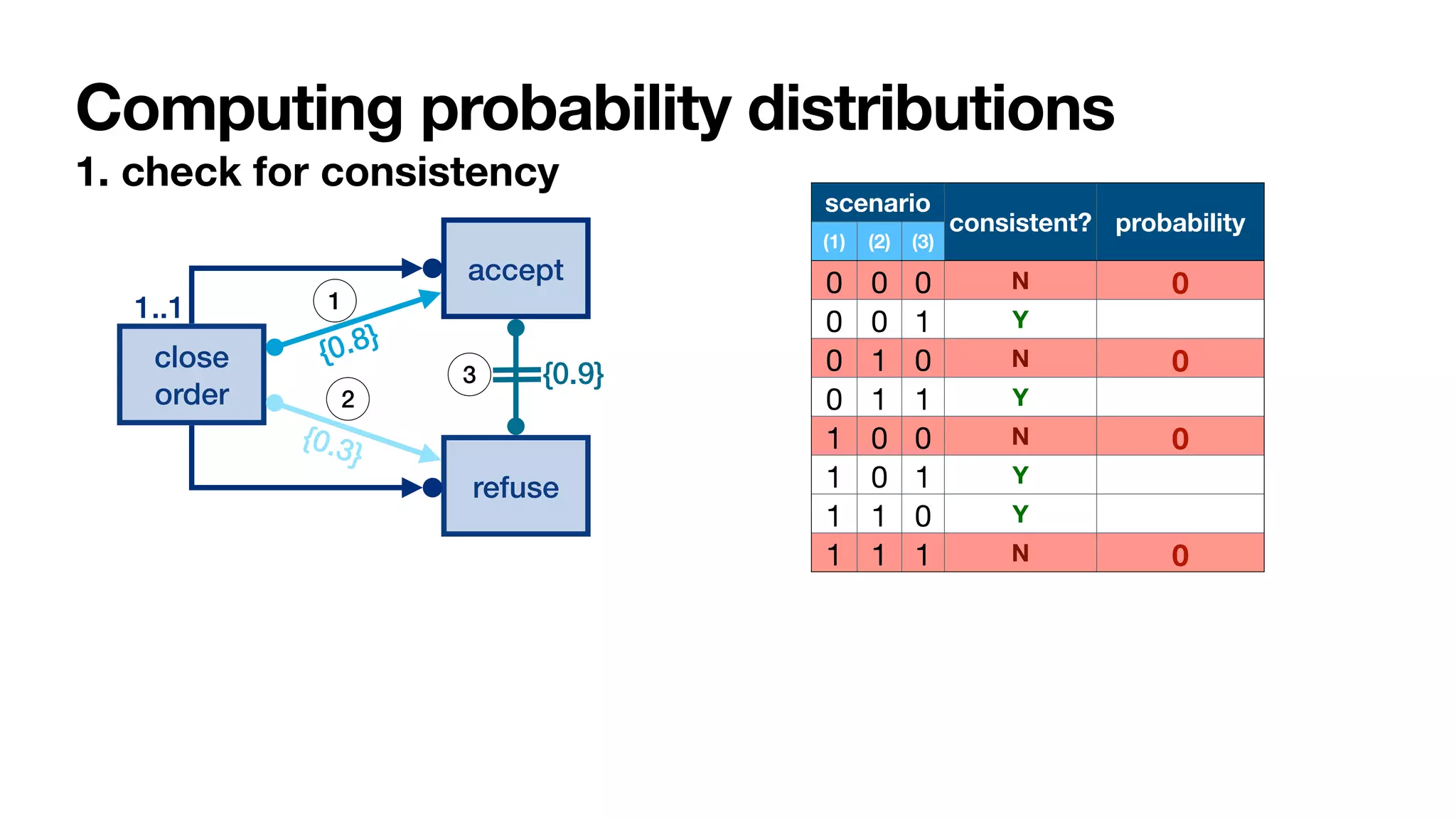
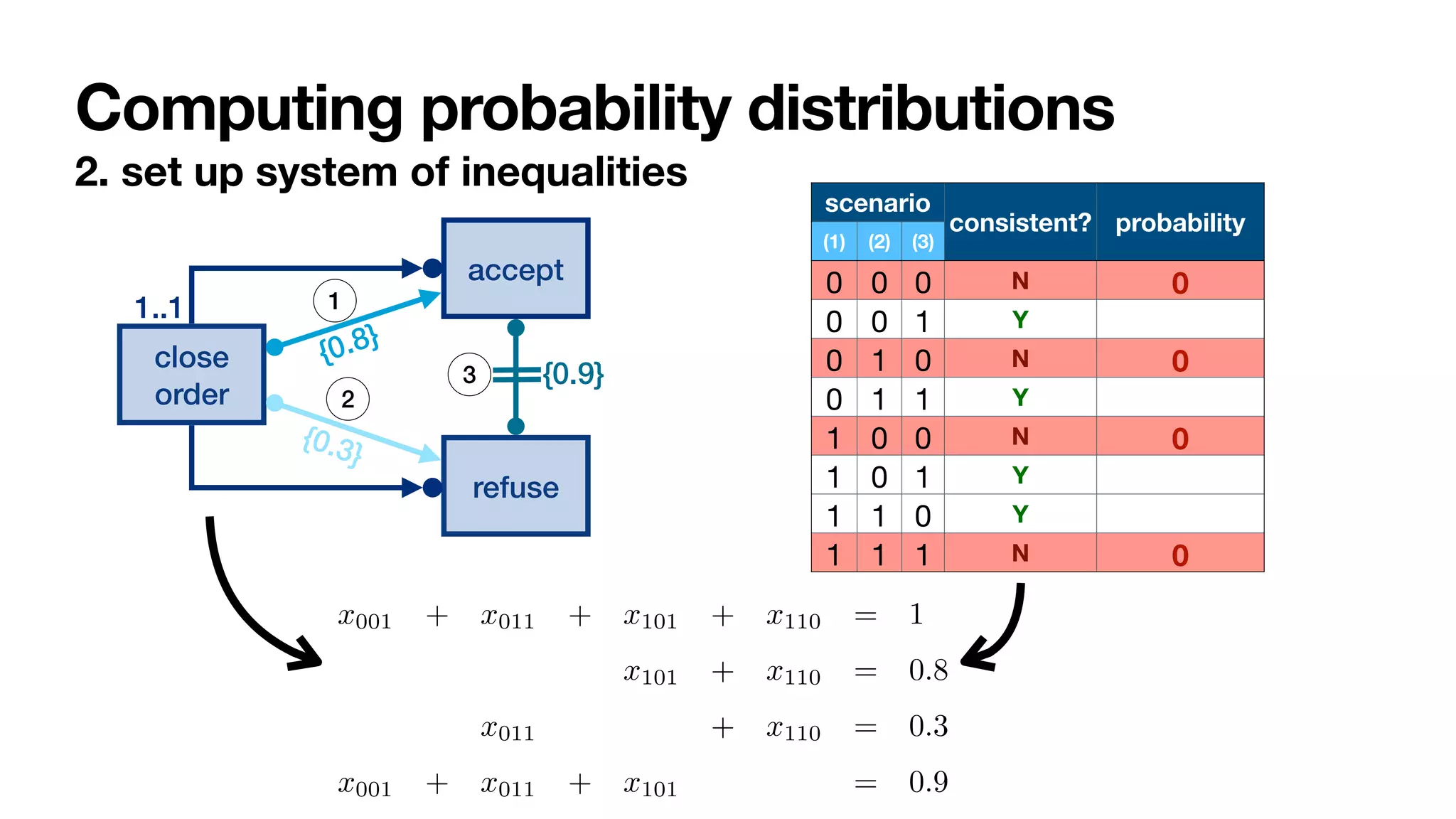
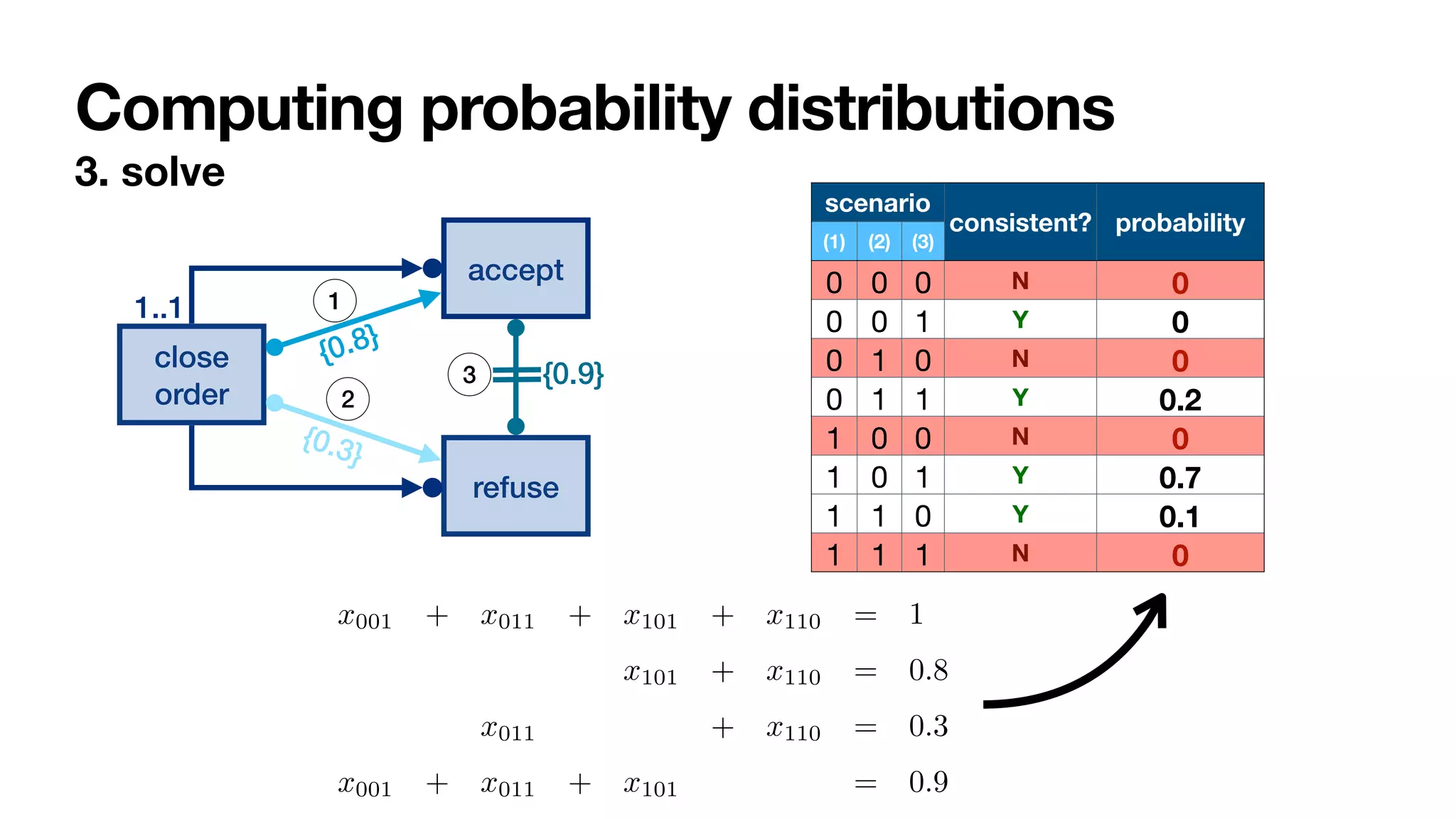


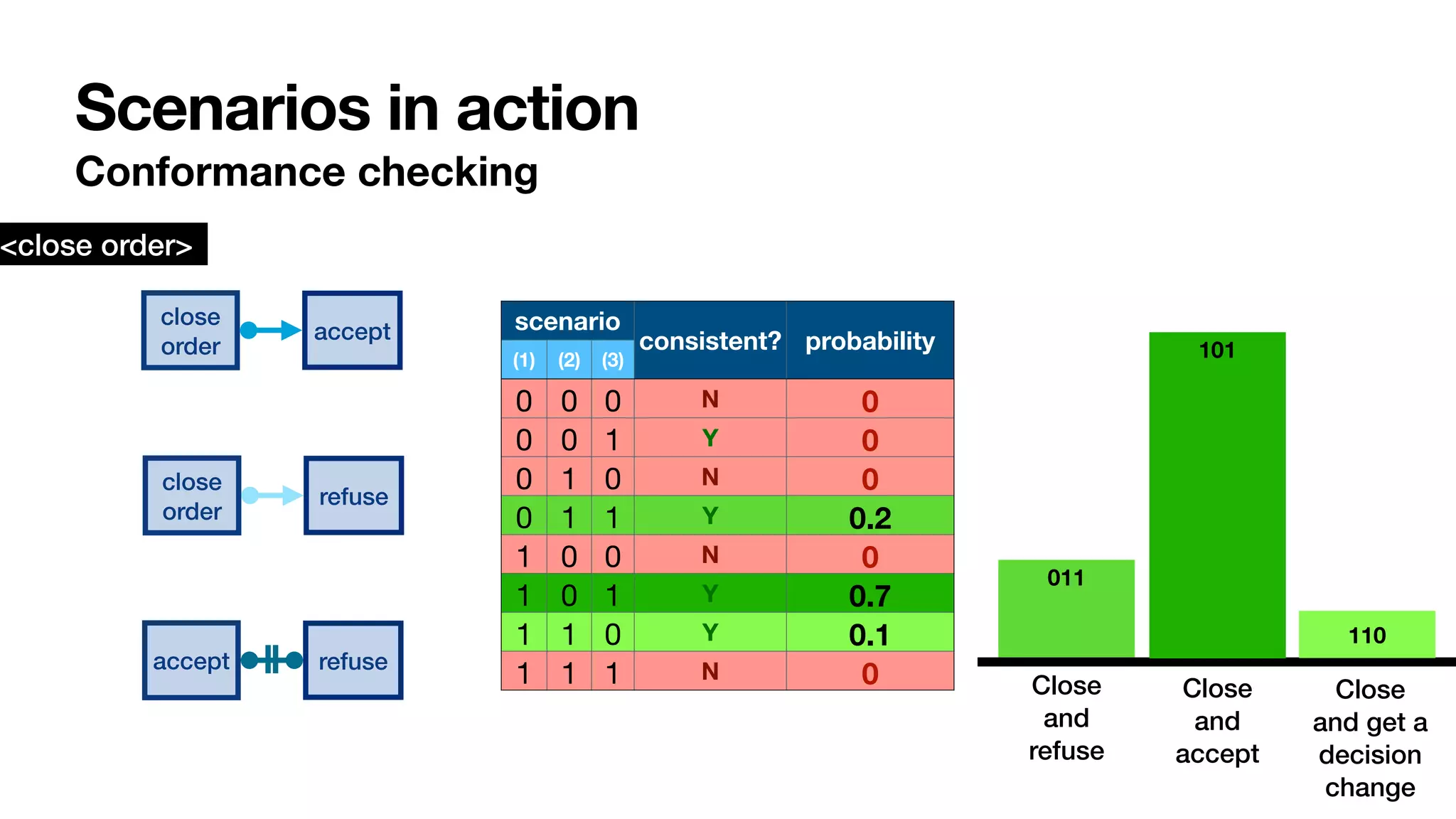
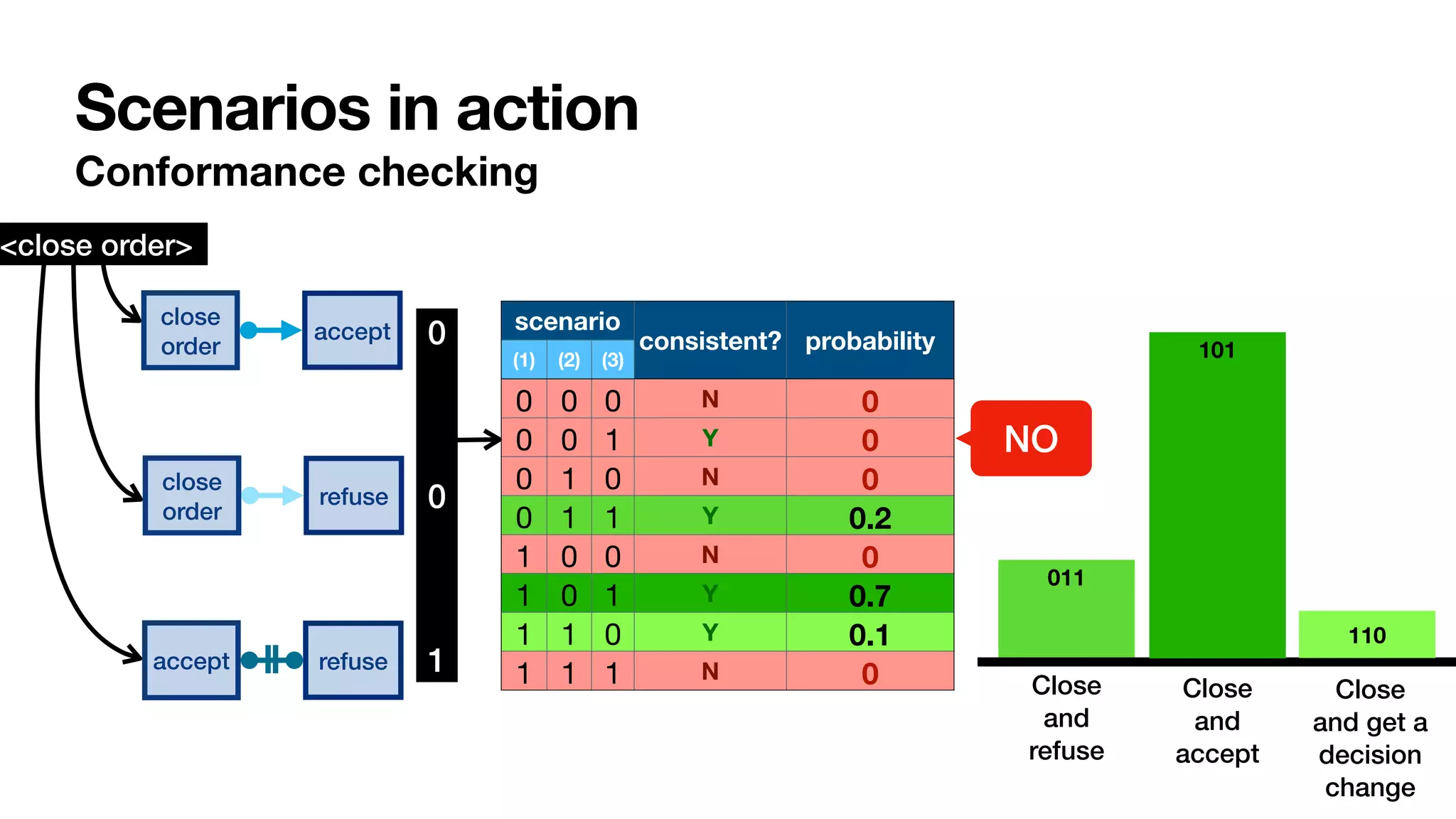
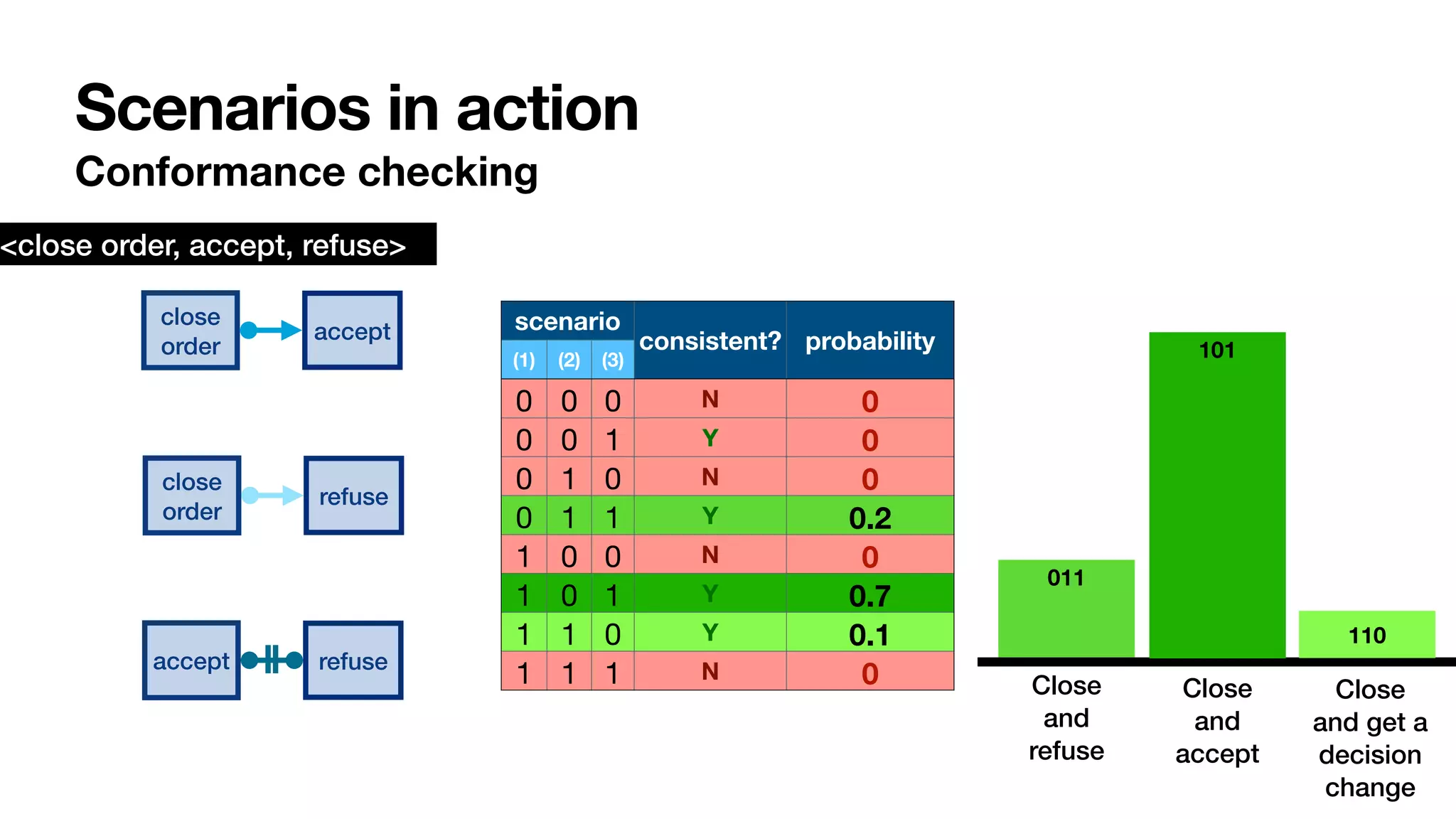
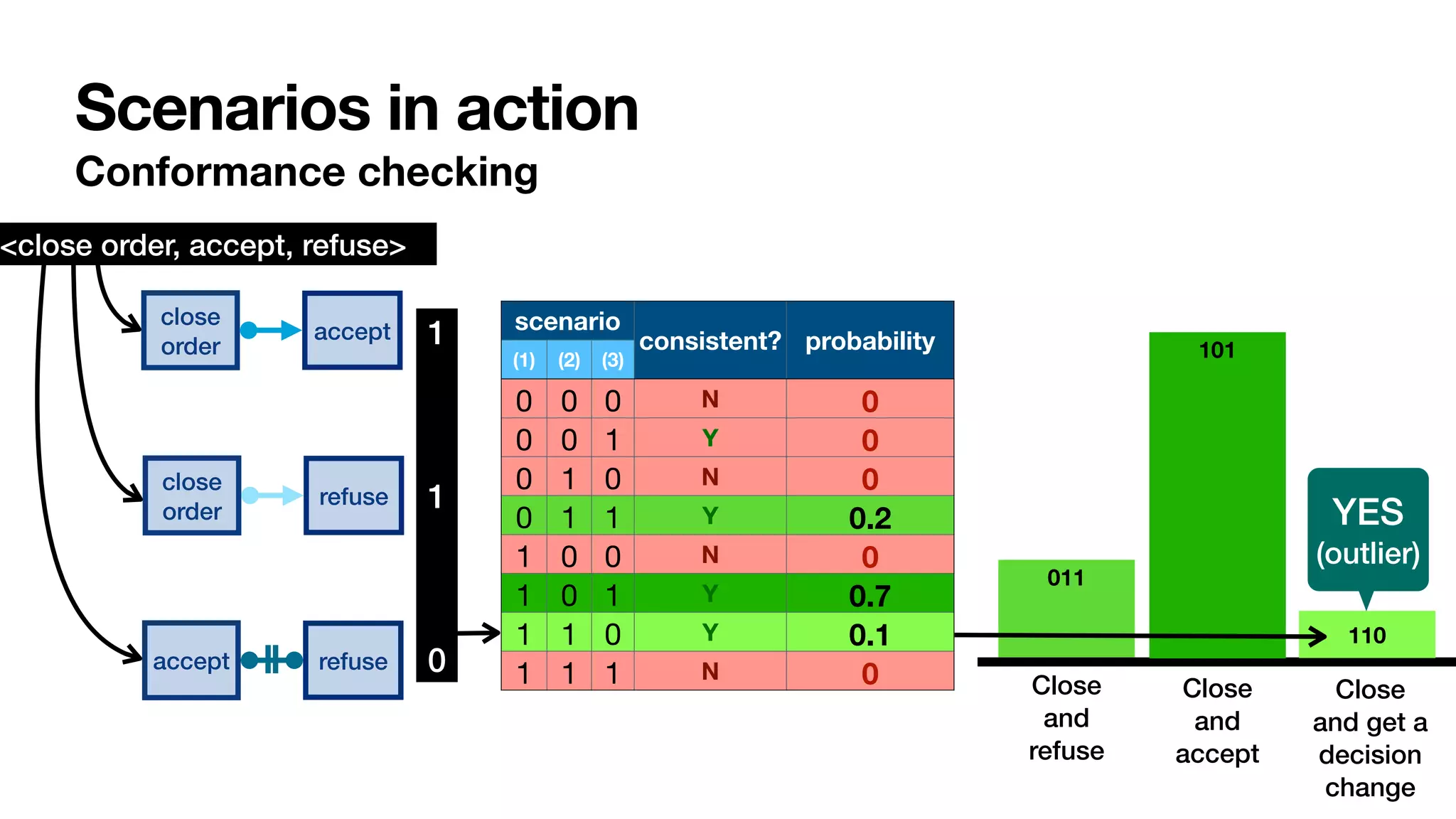
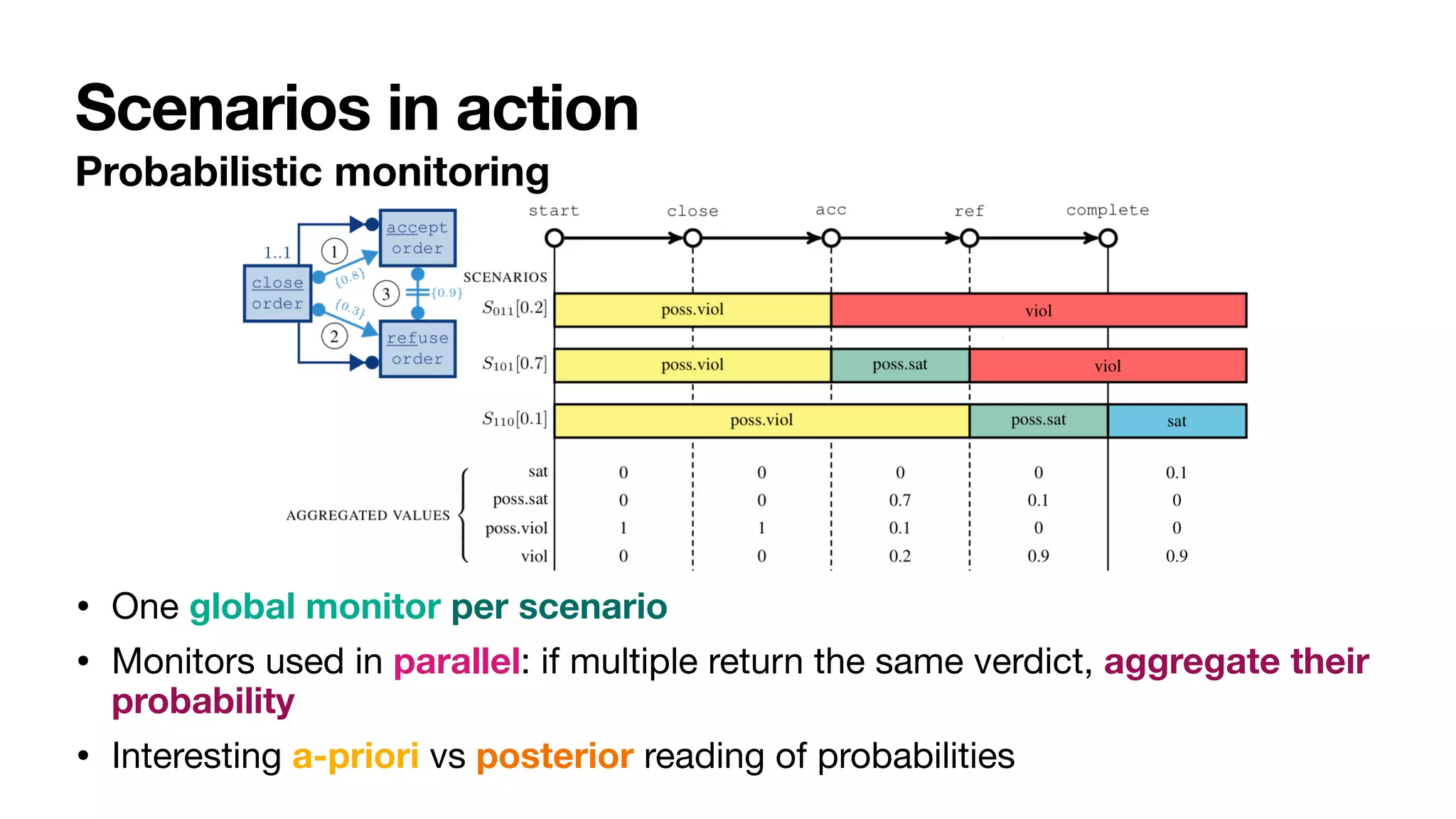
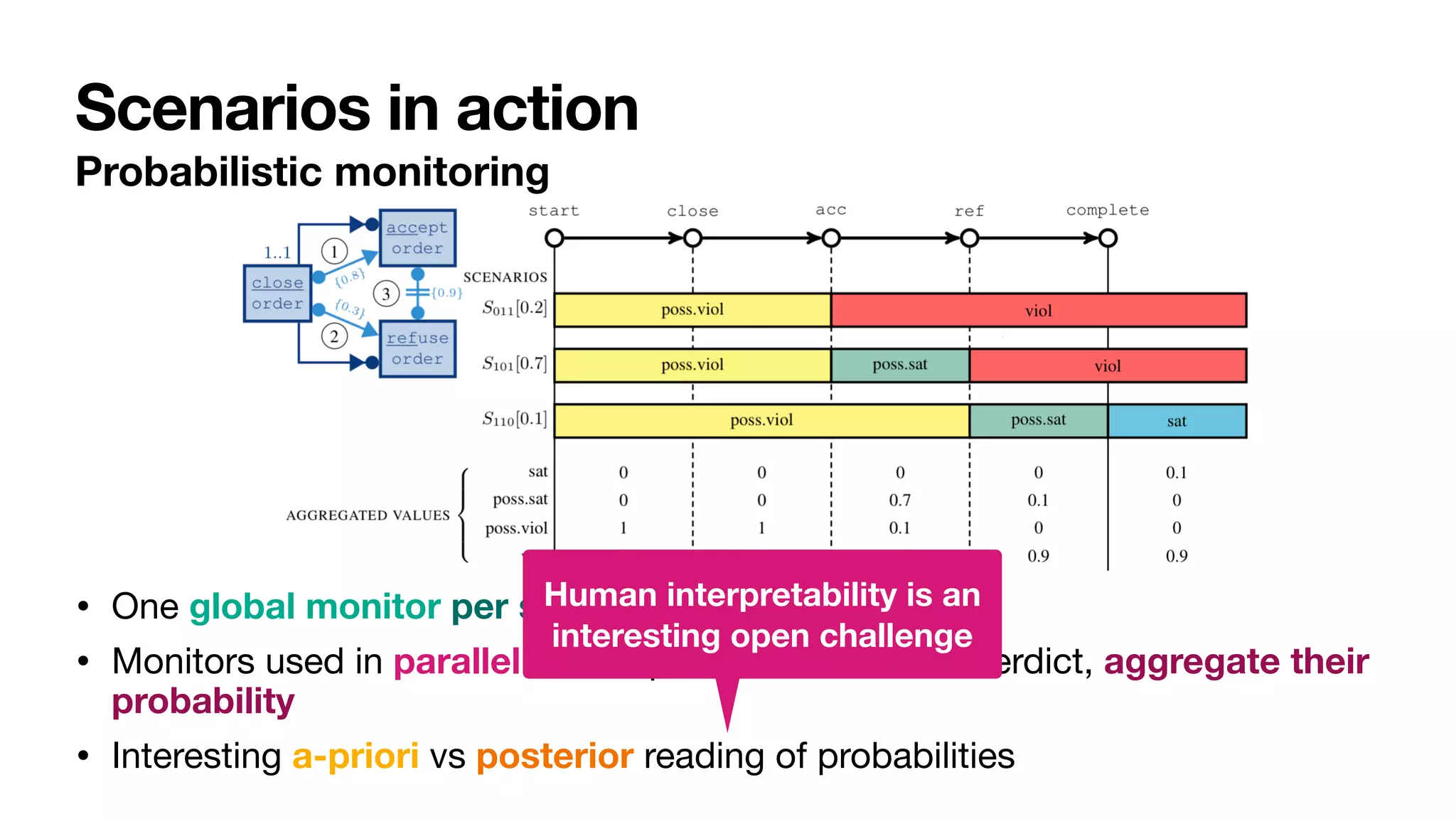
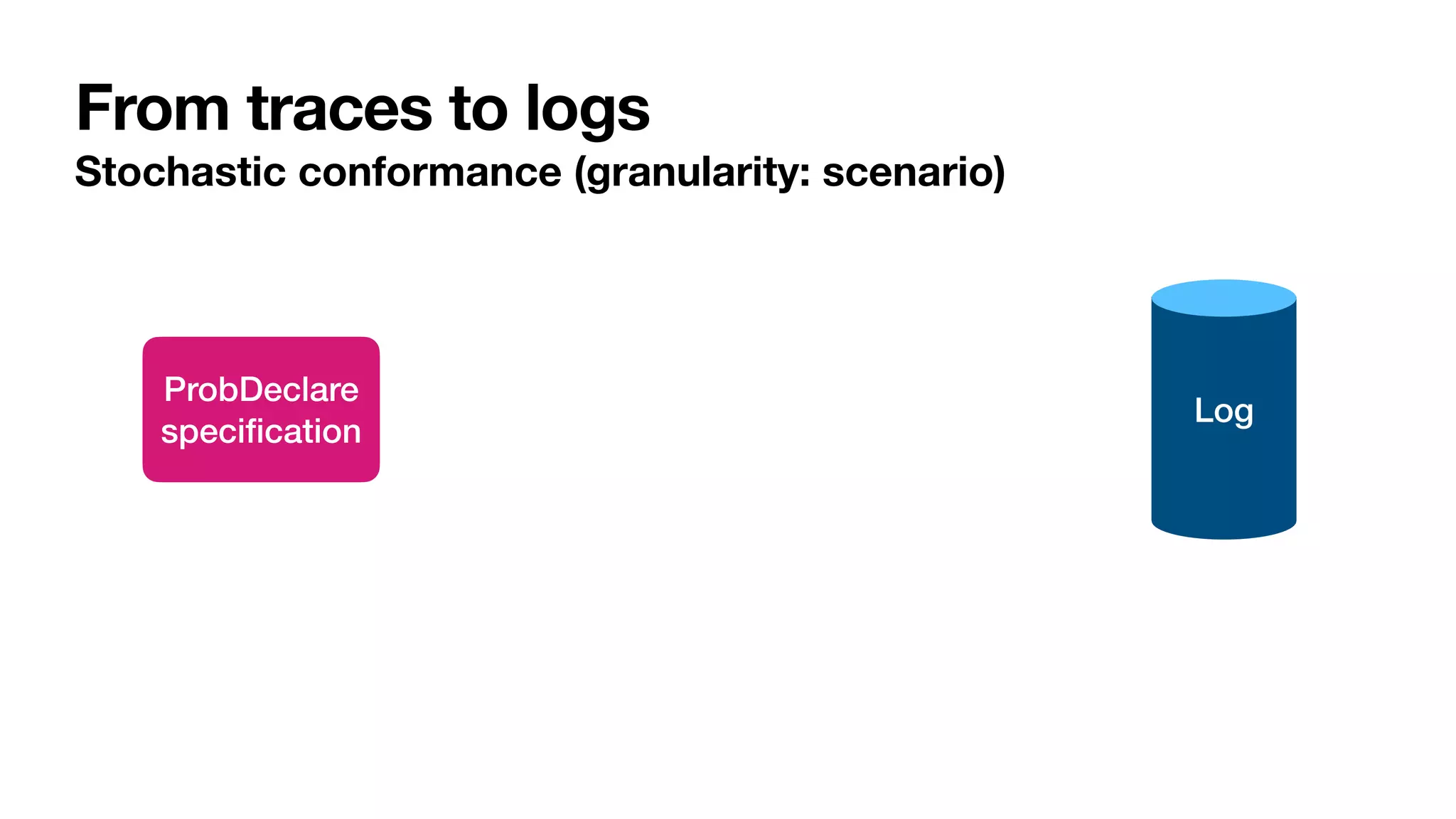
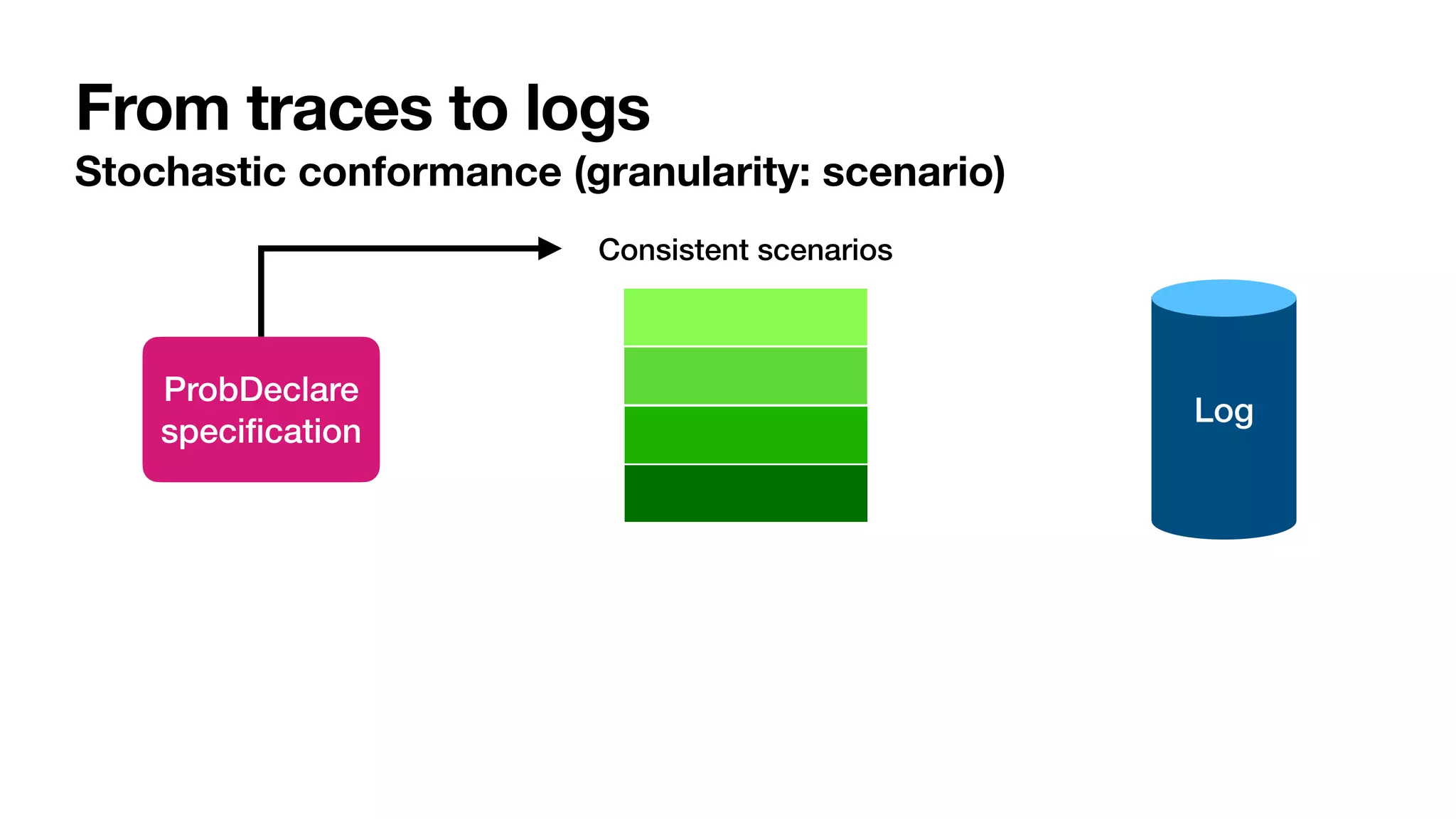
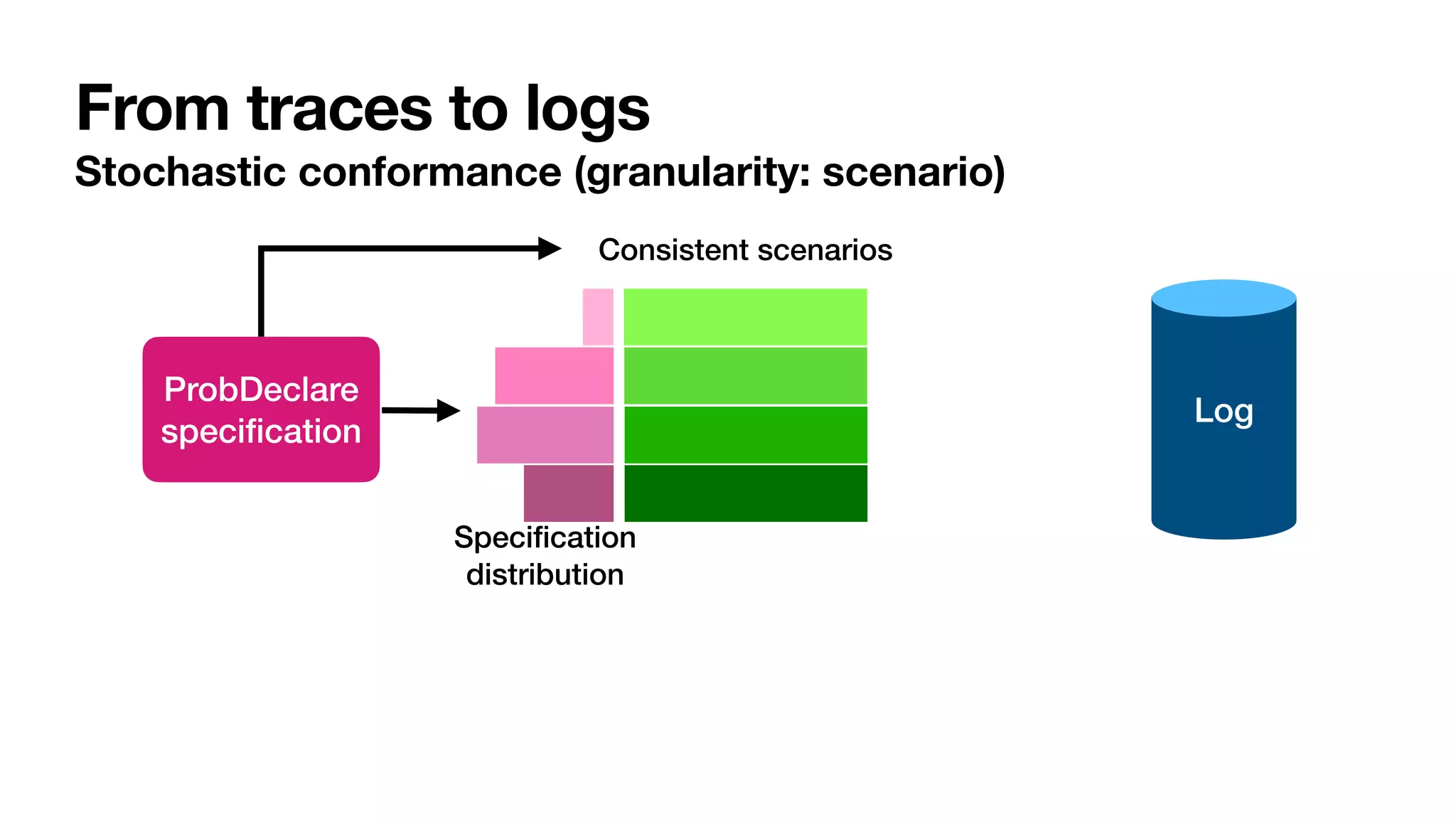
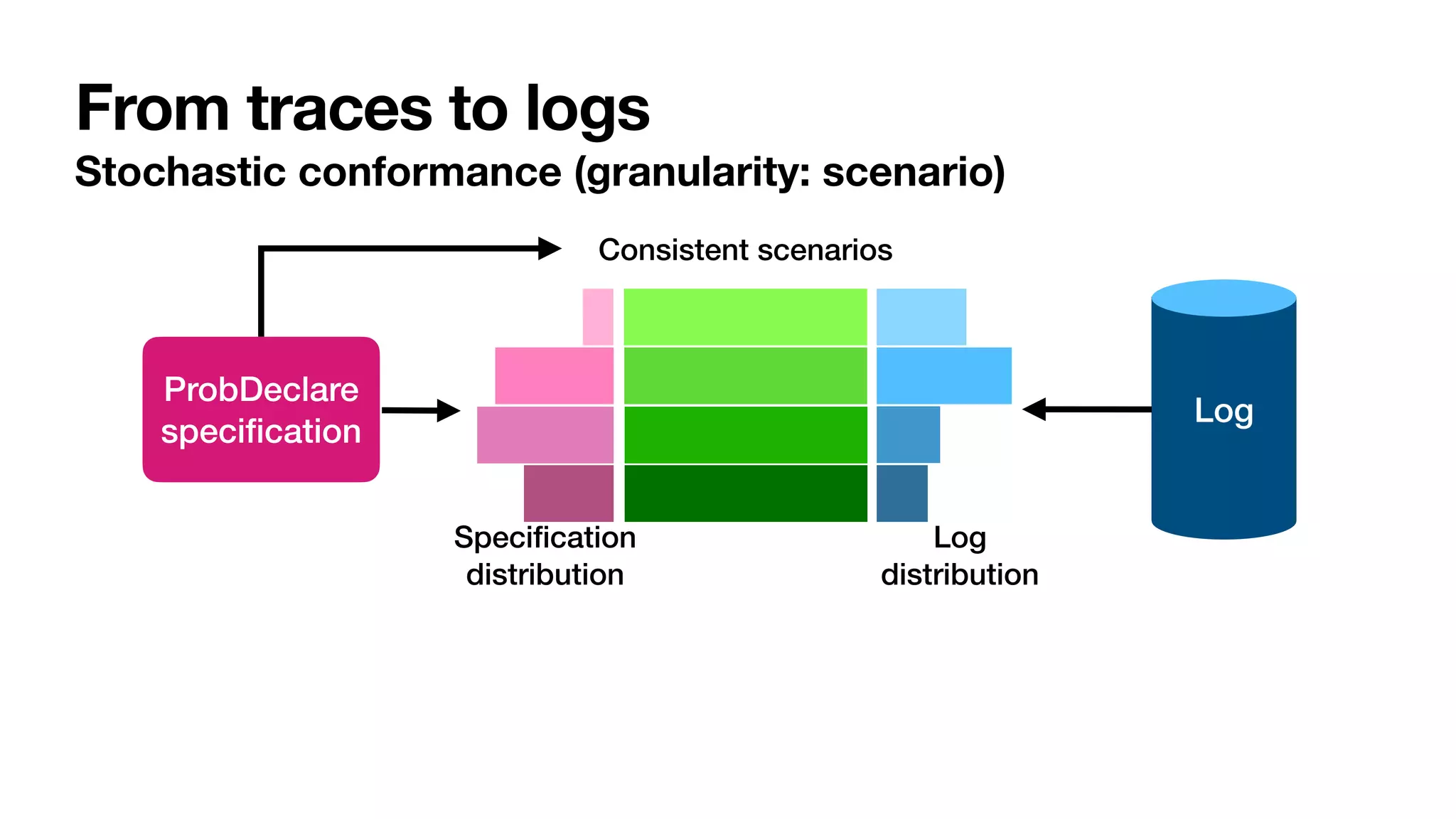
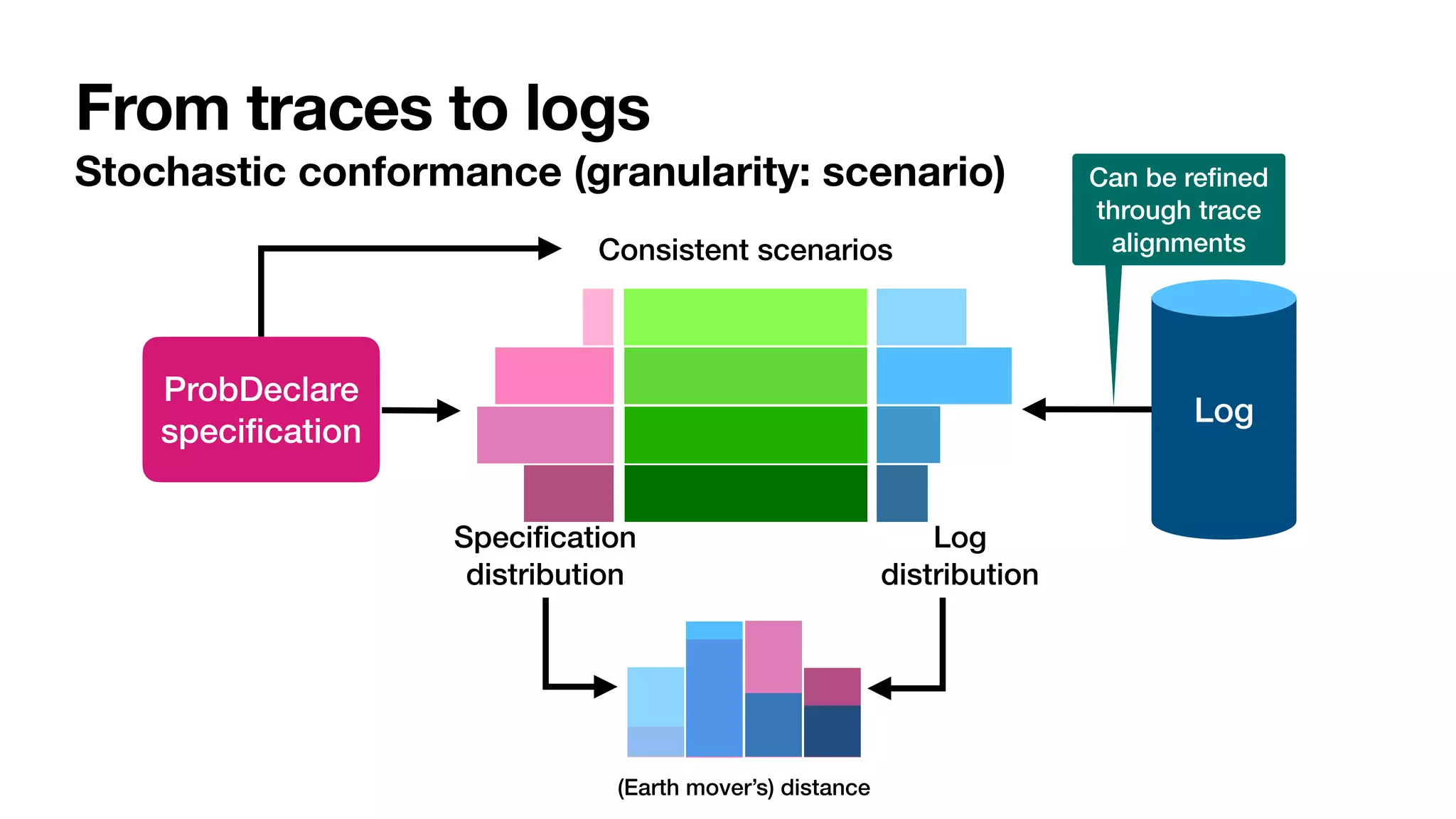
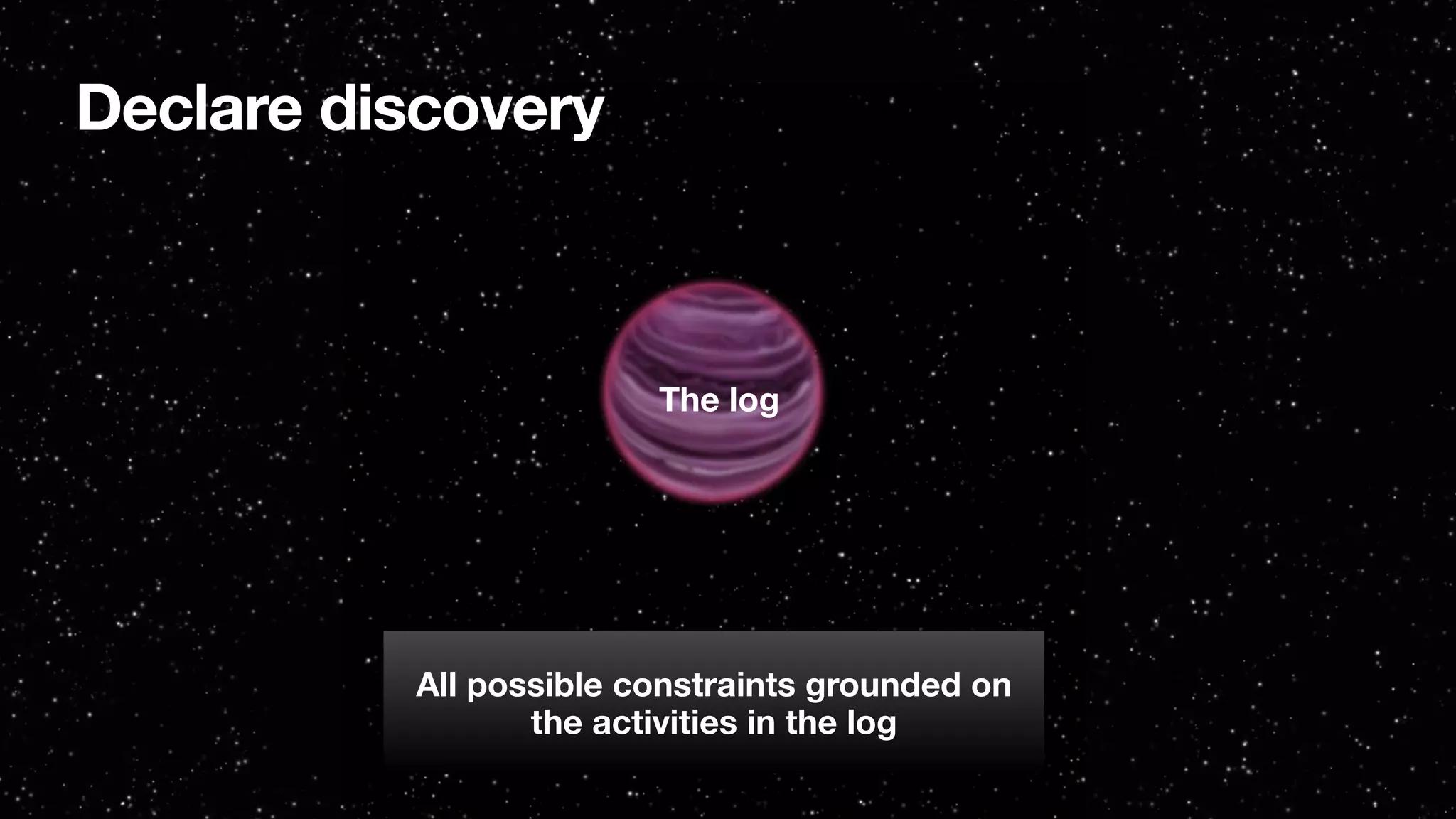
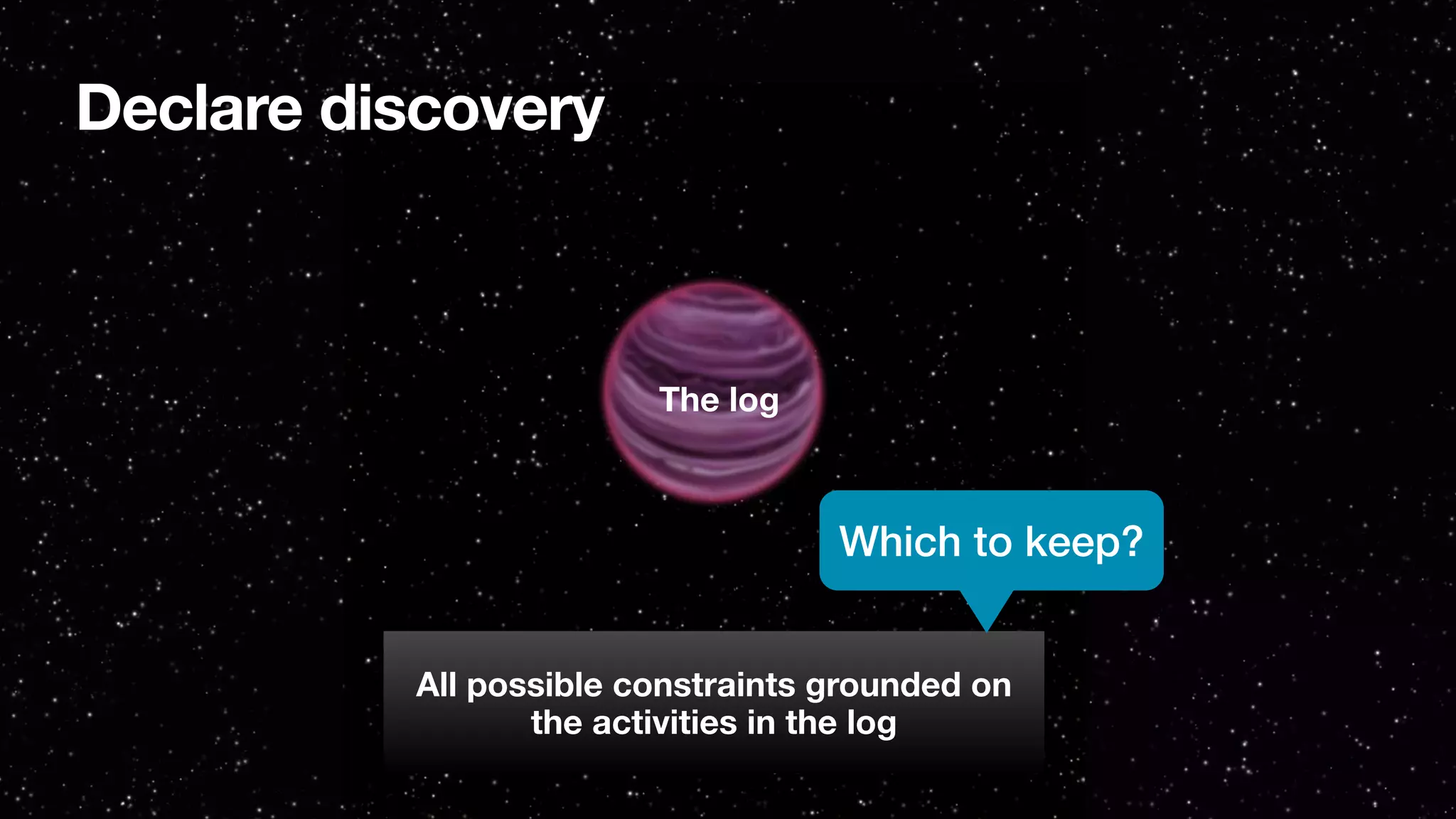
![Template algorithm for ProbDeclare discovery
[____,PMHandbook2022]
1. Select templates of interest
2. Compute metrics for corresponding constraints (grounded on log activities)
3. Filter based on minimum thresholds
4. Redundant constraints?
• Keep the most liberal if metrics are better for it
• Keep the most restrictive in case of equal metrics
5. Incompatible constraints?
• Keep only the one with better metrics
6. Further processing to ensure consistency, minimality, …
trace support:
# traces that "interestingly" satisfy the constraint
total # traces in the log
Consistency guaranteed only for
100% trace-based support](https://image.slidesharecdn.com/ai4bpm-framing-montali-220914143006-e7edf68e/75/Constraints-for-Process-Framing-in-Augmented-BPM-172-2048.jpg)
![Template algorithm for ProbDeclare discovery
[____,InfSys2022]
1. Select templates of interest
2. Compute metrics for corresponding constraints (grounded on log activities)
3. Filter based on minimum/maximum thresholds
4. Redundant constraints?
• Keep the most liberal if metrics are better for it
• Keep the most restrictive in case of equal metrics
5. Incompatible constraints?
• Keep only the one with better metrics
6. Further processing to ensure consistency, minimality, …
5. Use support as a basis for constraint probability
• Consistency guaranteed by construction
trace support:
# traces that "interestingly" satisfy the constraint
total # traces in the log](https://image.slidesharecdn.com/ai4bpm-framing-montali-220914143006-e7edf68e/75/Constraints-for-Process-Framing-in-Augmented-BPM-173-2048.jpg)
![Idea: conversating on log skeletons
Log
Discovery
[Verbeek, STTT2021]
Log skeleton [Verbeek, STTT2021]
Declare-like speci
fi
cation
with frequencies](https://image.slidesharecdn.com/ai4bpm-framing-montali-220914143006-e7edf68e/75/Constraints-for-Process-Framing-in-Augmented-BPM-174-2048.jpg)
![Idea: conversating on log skeletons
Log
Discovery
[Verbeek, STTT2021]
Reasoning on
constraints
and their frequencies
Log skeleton [Verbeek, STTT2021]
Declare-like speci
fi
cation
with frequencies](https://image.slidesharecdn.com/ai4bpm-framing-montali-220914143006-e7edf68e/75/Constraints-for-Process-Framing-in-Augmented-BPM-175-2048.jpg)

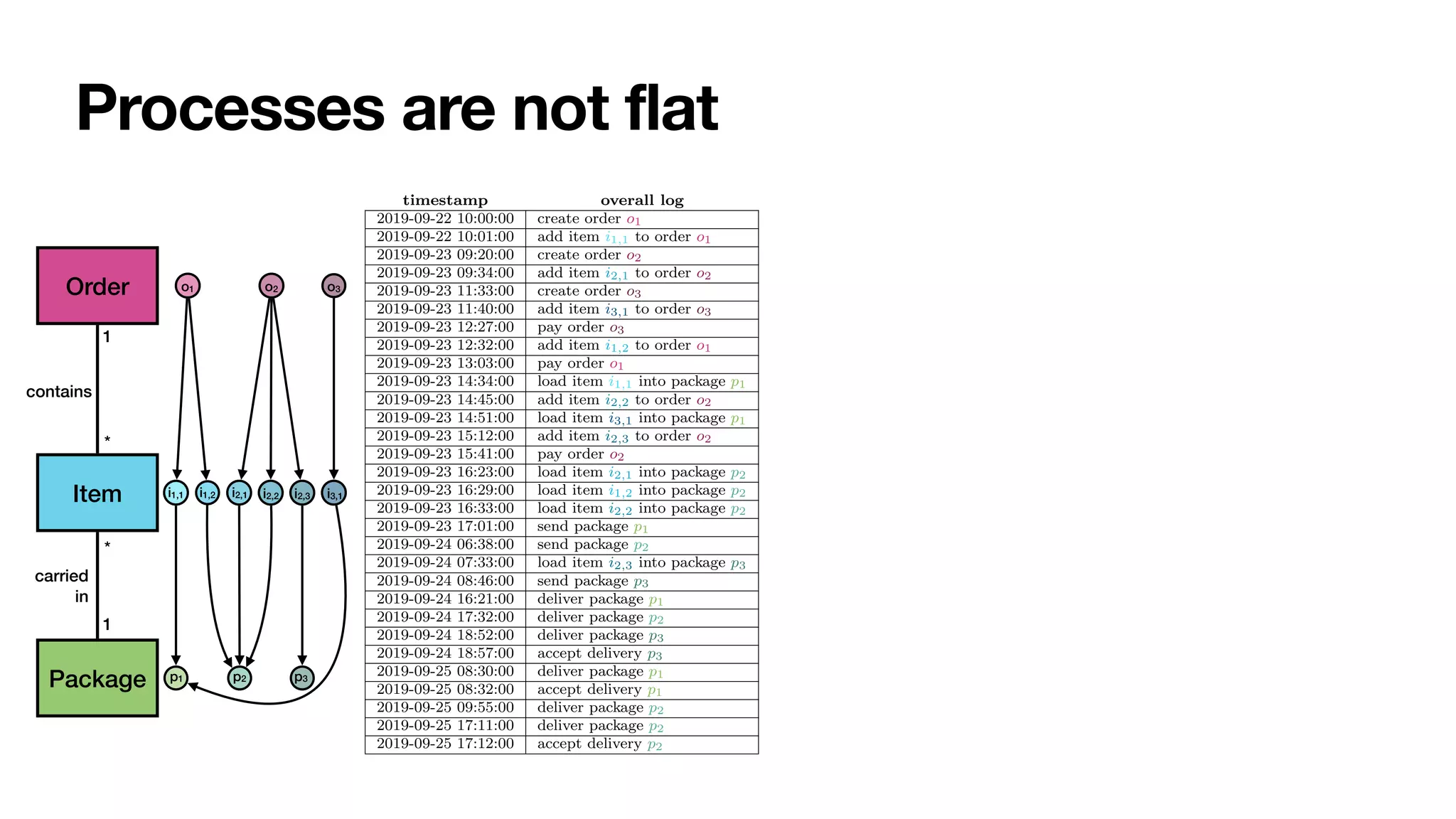

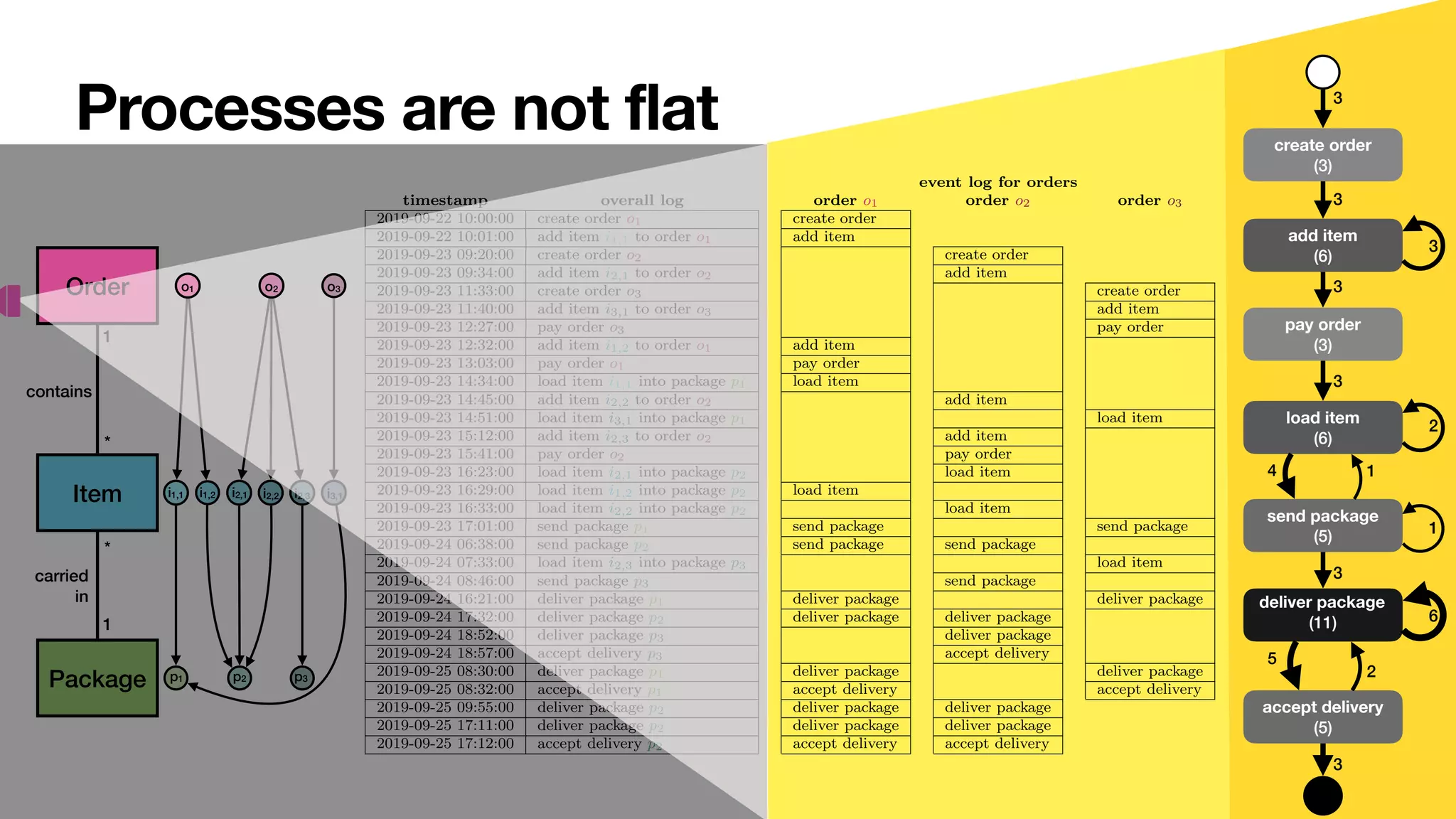

![Need of a 3D model
time
objects
activities
Object-centric behavioral
constraints
[____,DL2017] [____,BPM2019]](https://image.slidesharecdn.com/ai4bpm-framing-montali-220914143006-e7edf68e/75/Constraints-for-Process-Framing-in-Augmented-BPM-181-2048.jpg)
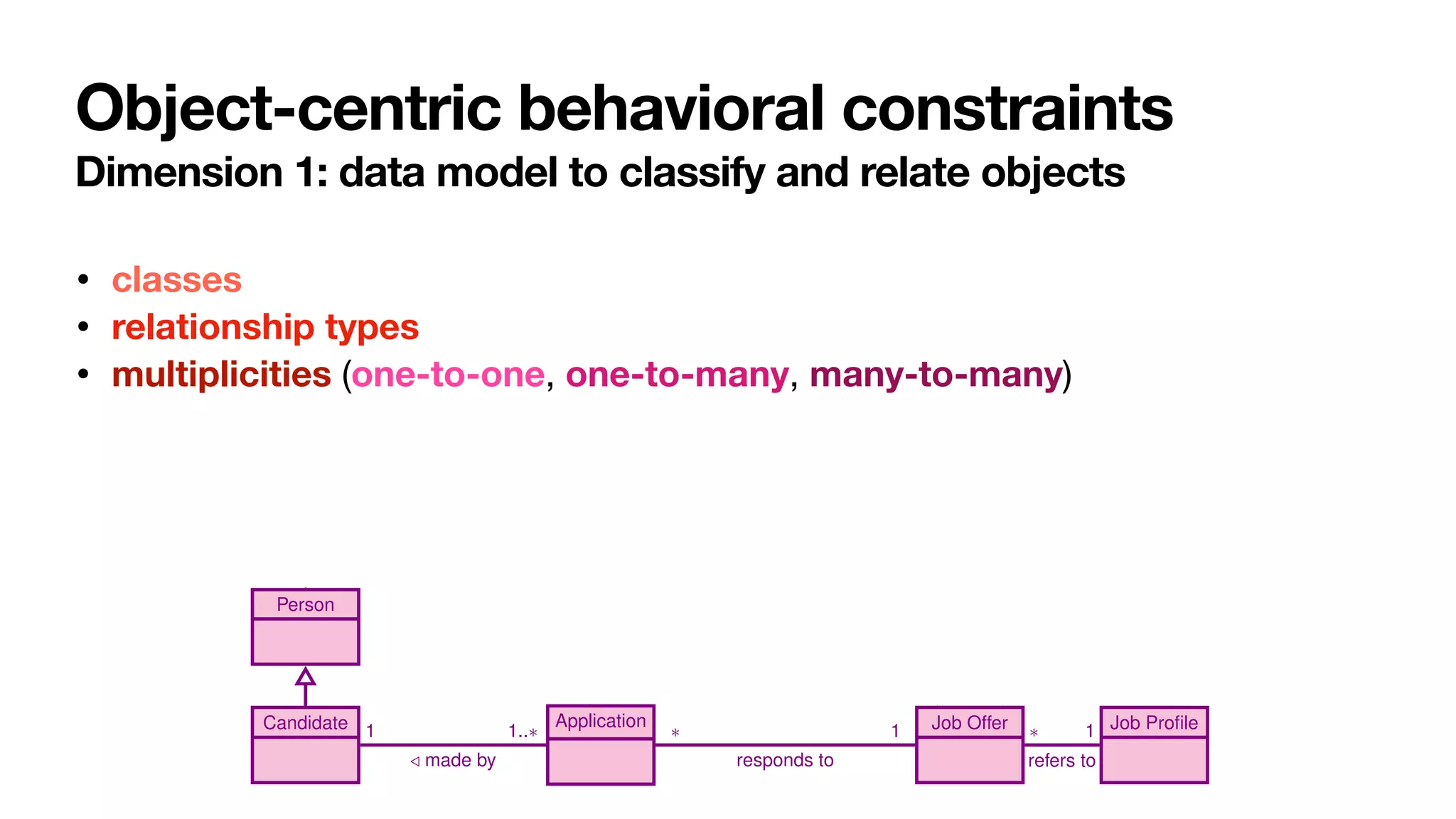
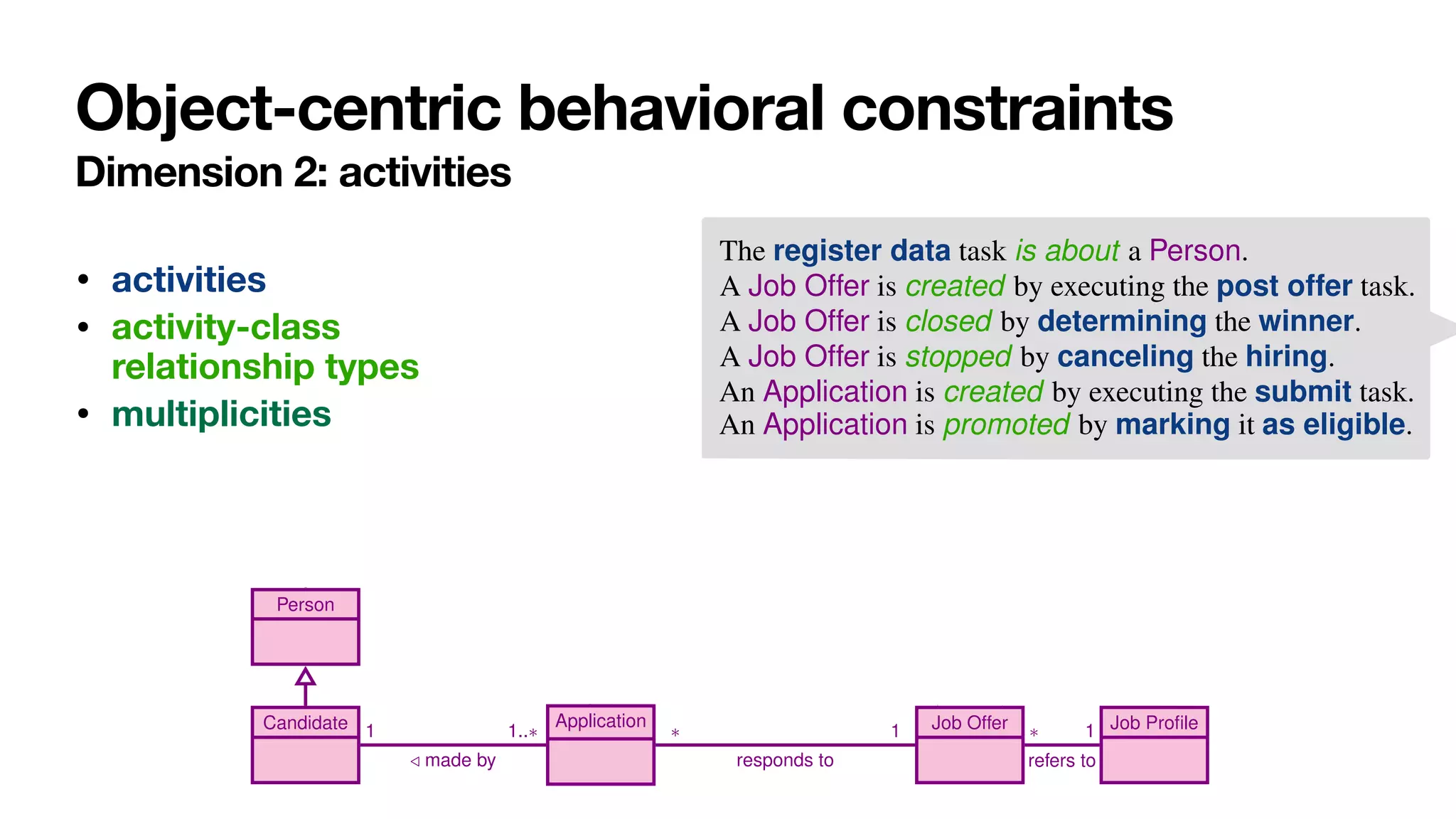



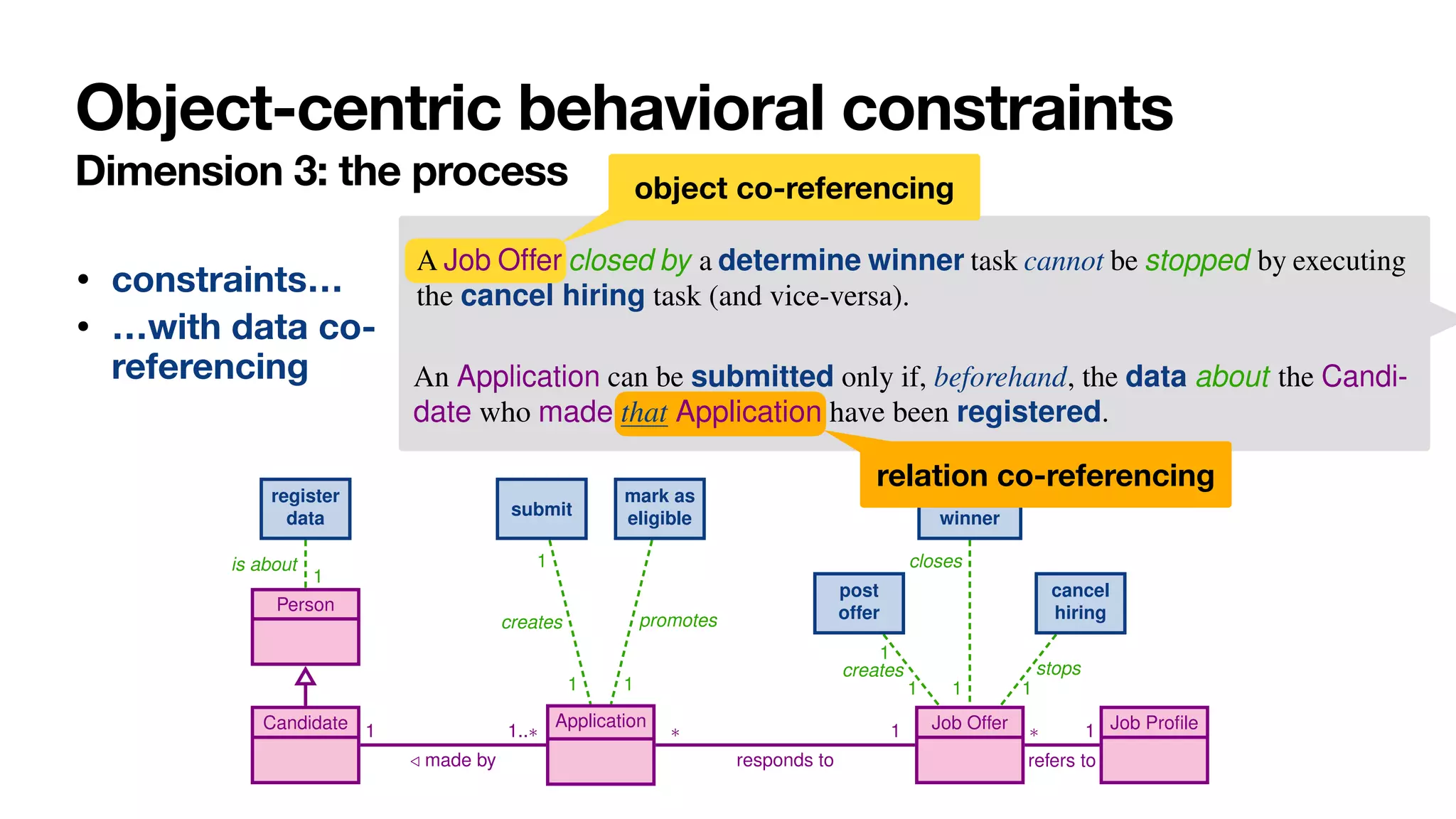
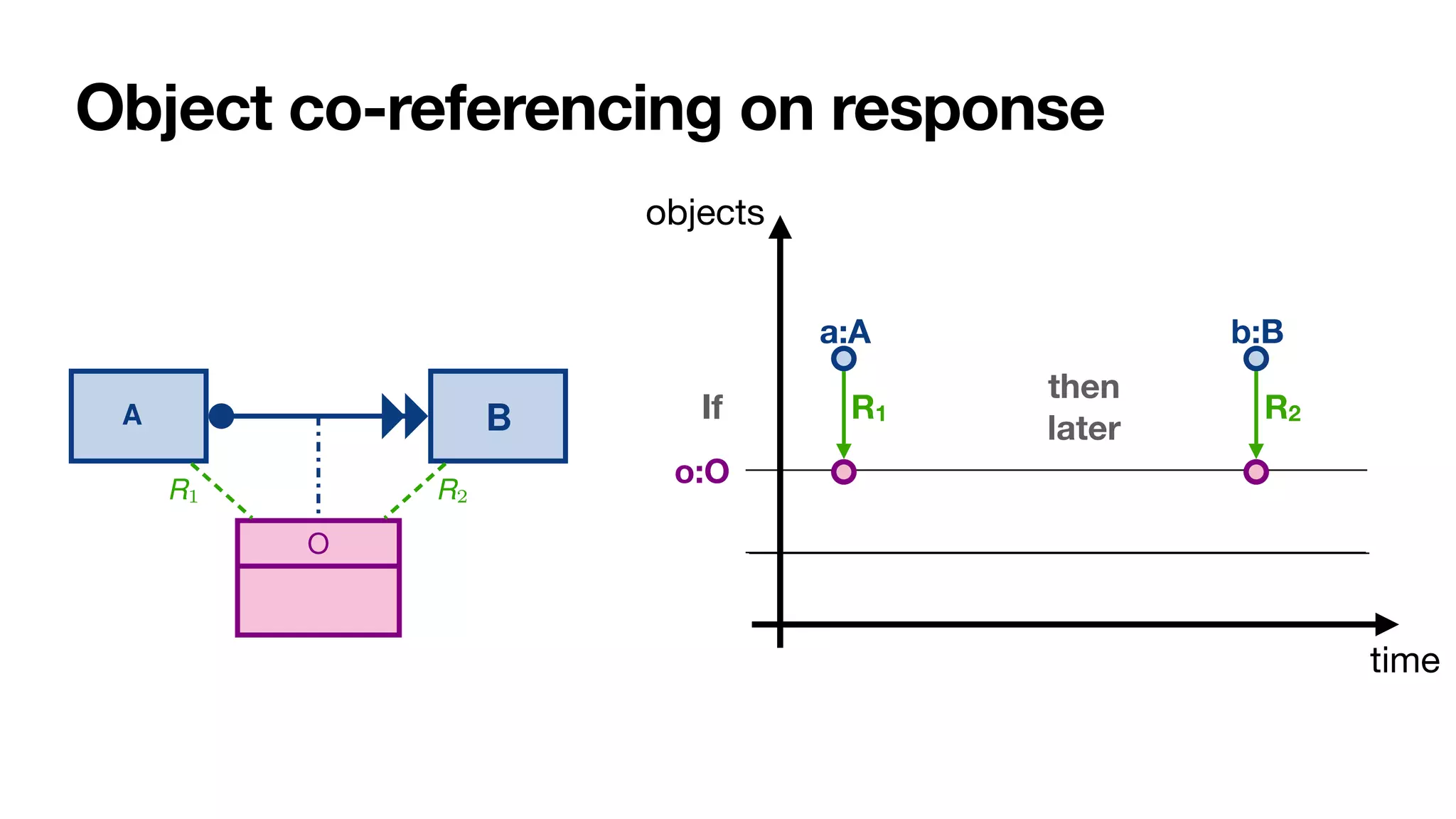
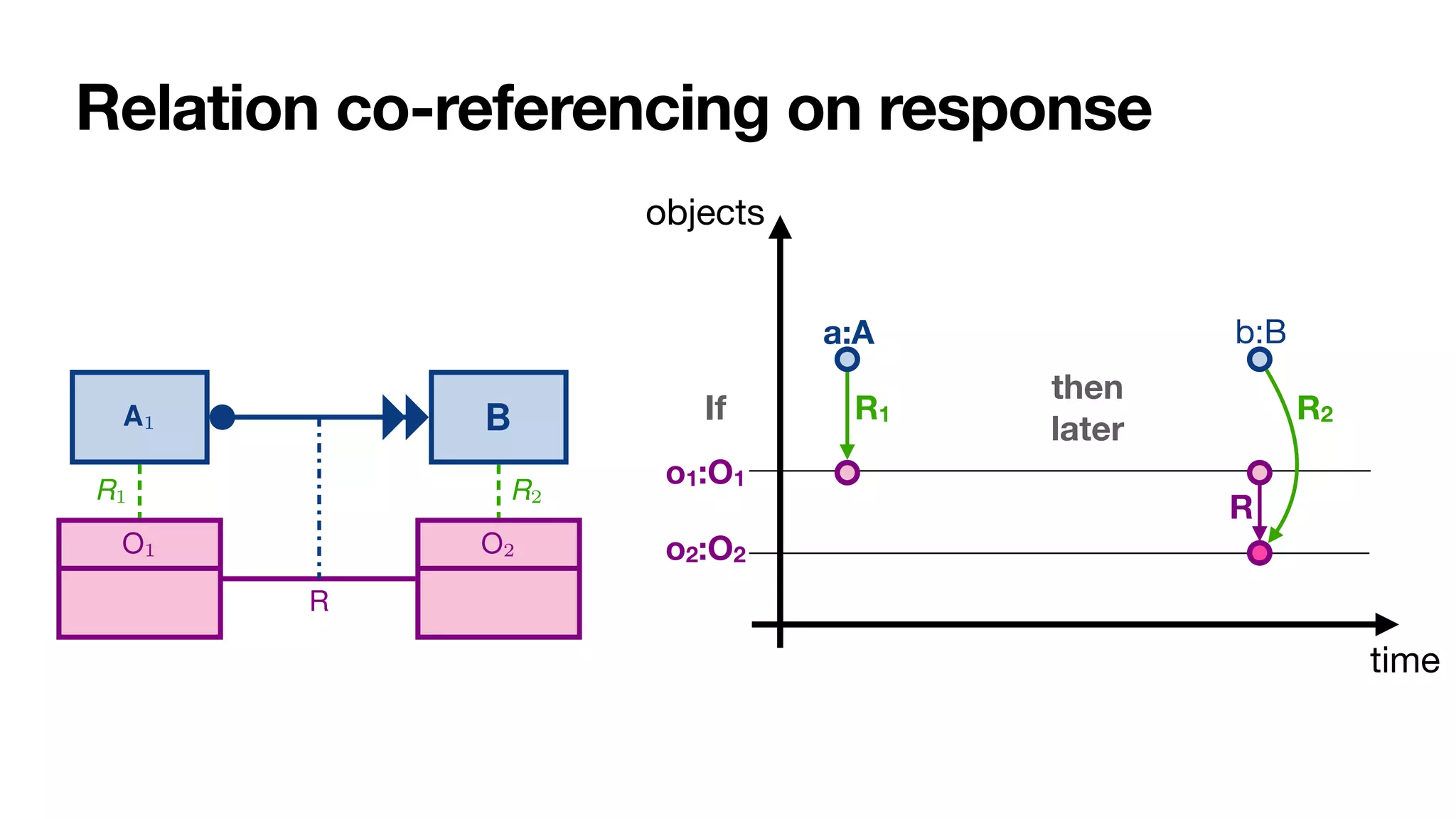
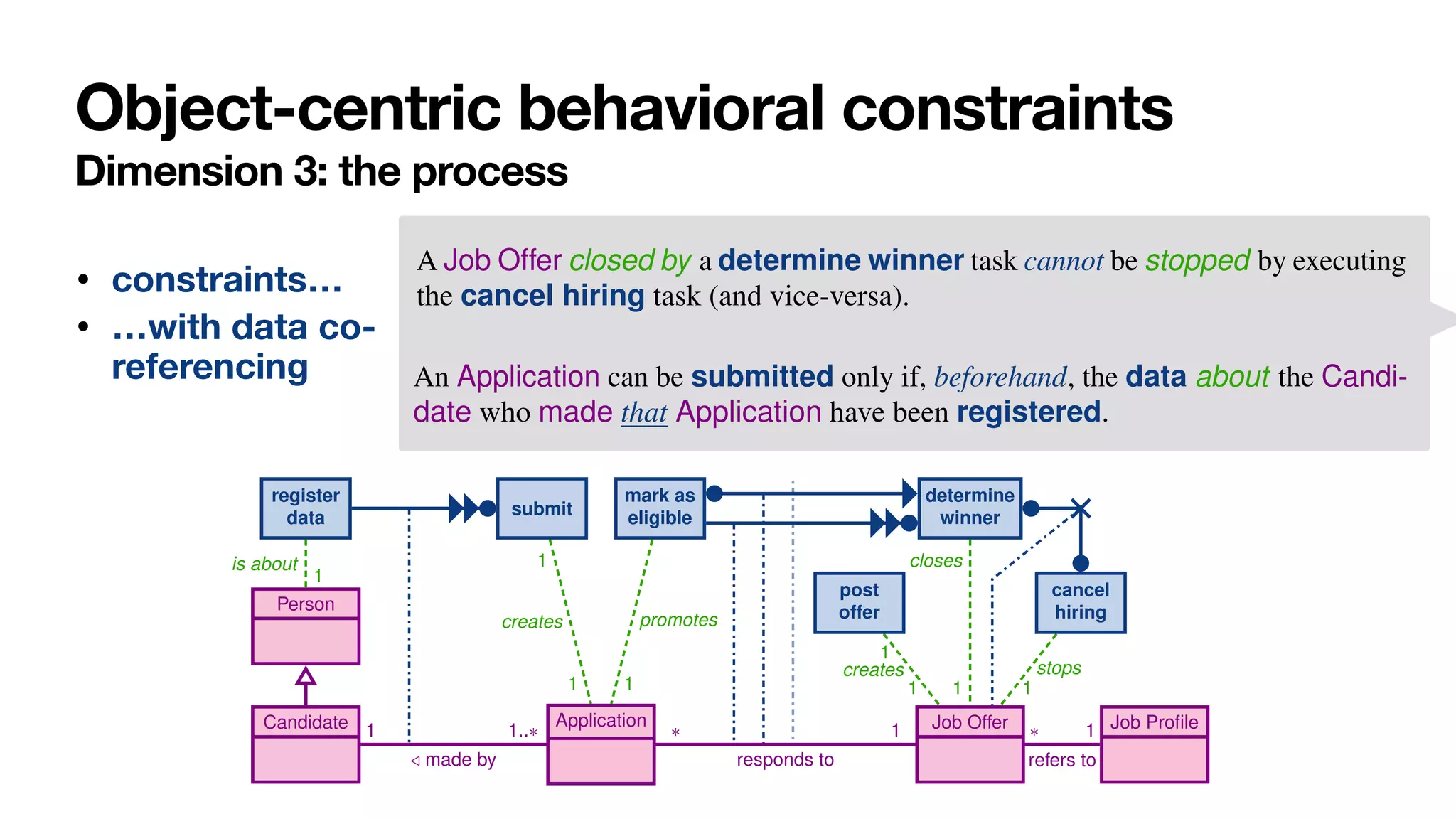
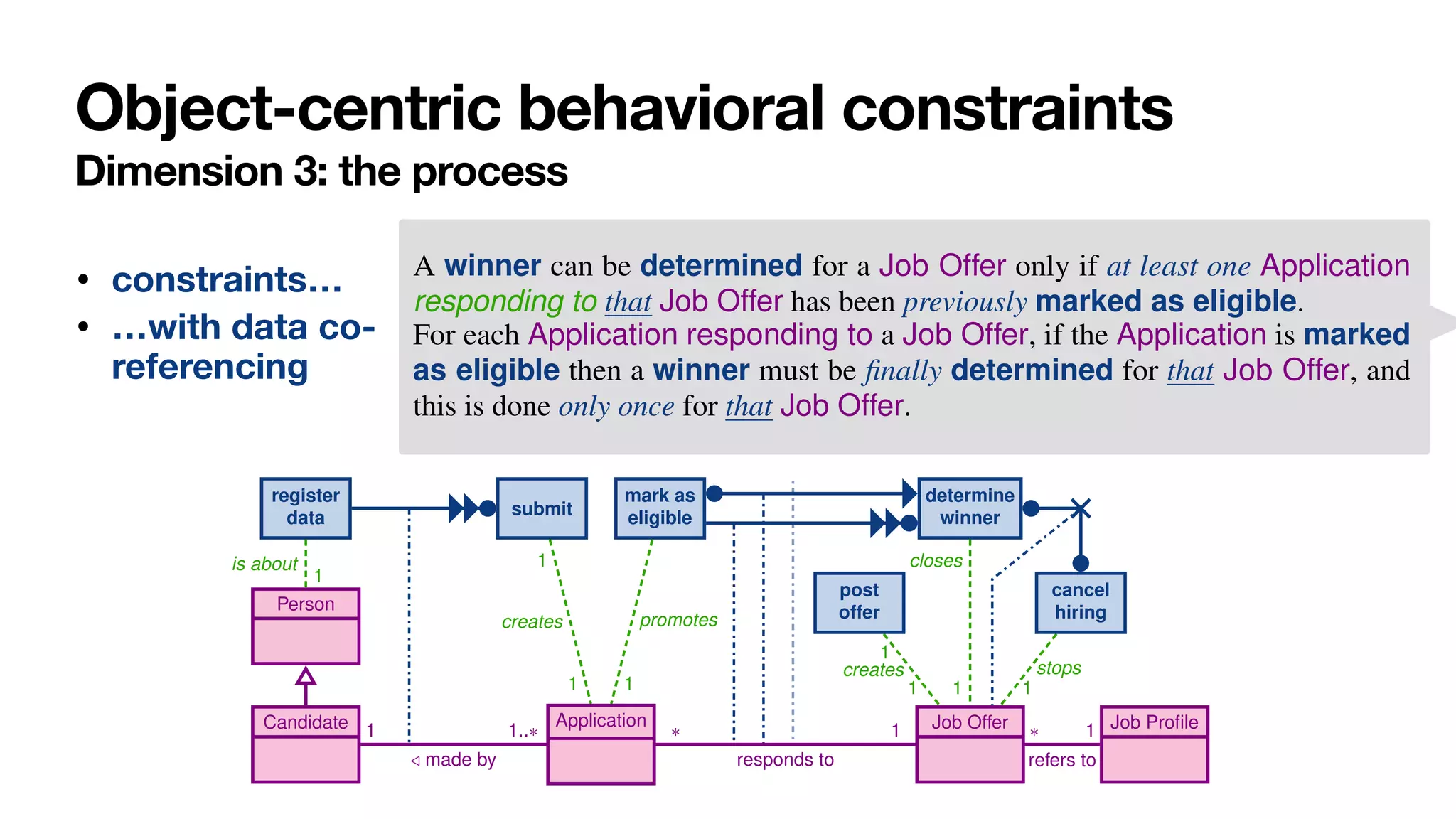
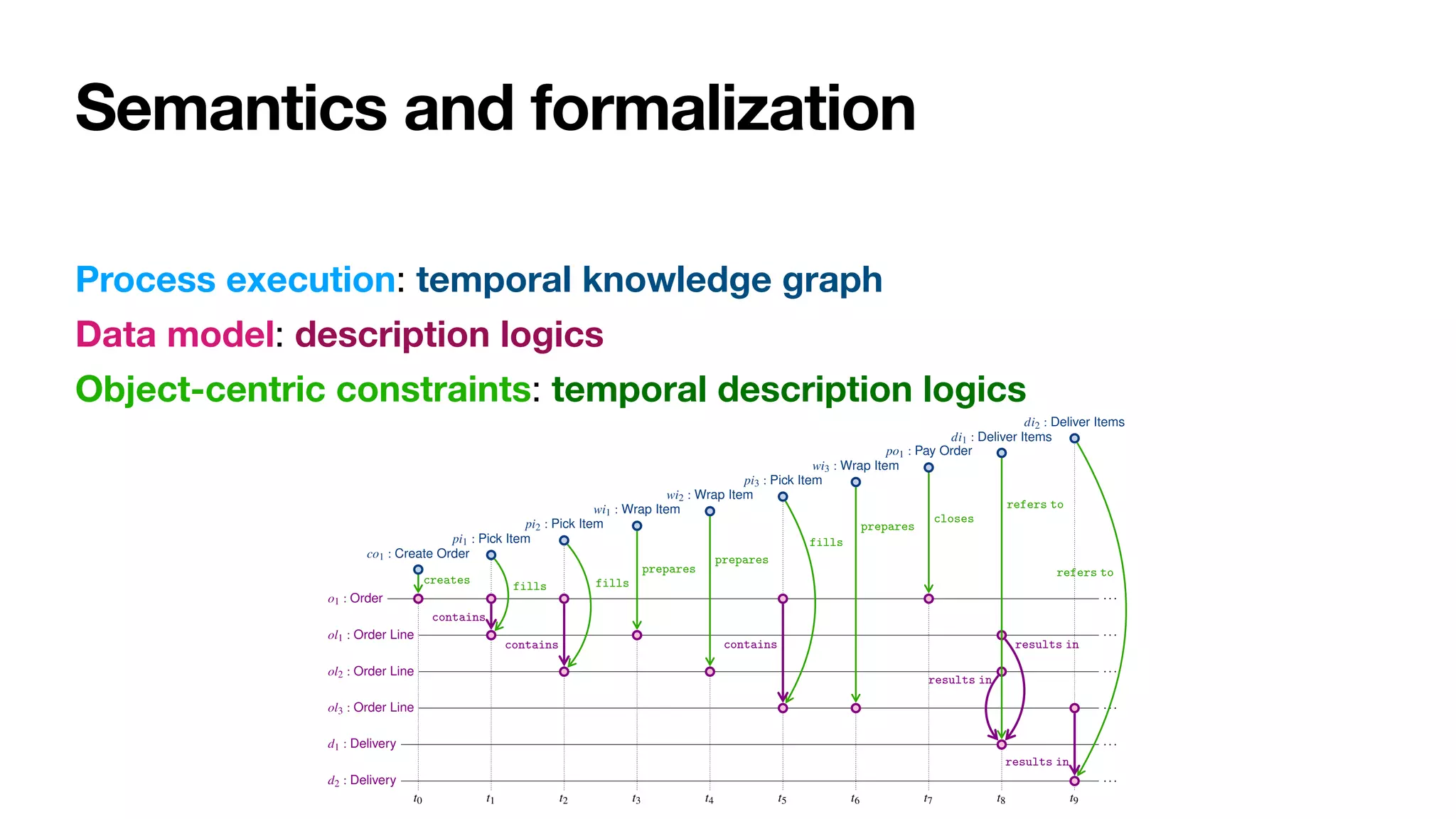
![Achieved and ongoing results
Reasoning [____,BPM2019]
• Direct approach -> undecidable
• Careful “object-centric” reformulation
-> decidable in EXPTIME (same as reasoning on UML diagrams)
Monitoring (ongoing)
• Hybrid reasoning (closed on the past, open on the future)
Discovery (ongoing)
• Construction of trace views
• Standard discovery on views
• Object-centric reconciliation](https://image.slidesharecdn.com/ai4bpm-framing-montali-220914143006-e7edf68e/75/Constraints-for-Process-Framing-in-Augmented-BPM-193-2048.jpg)
